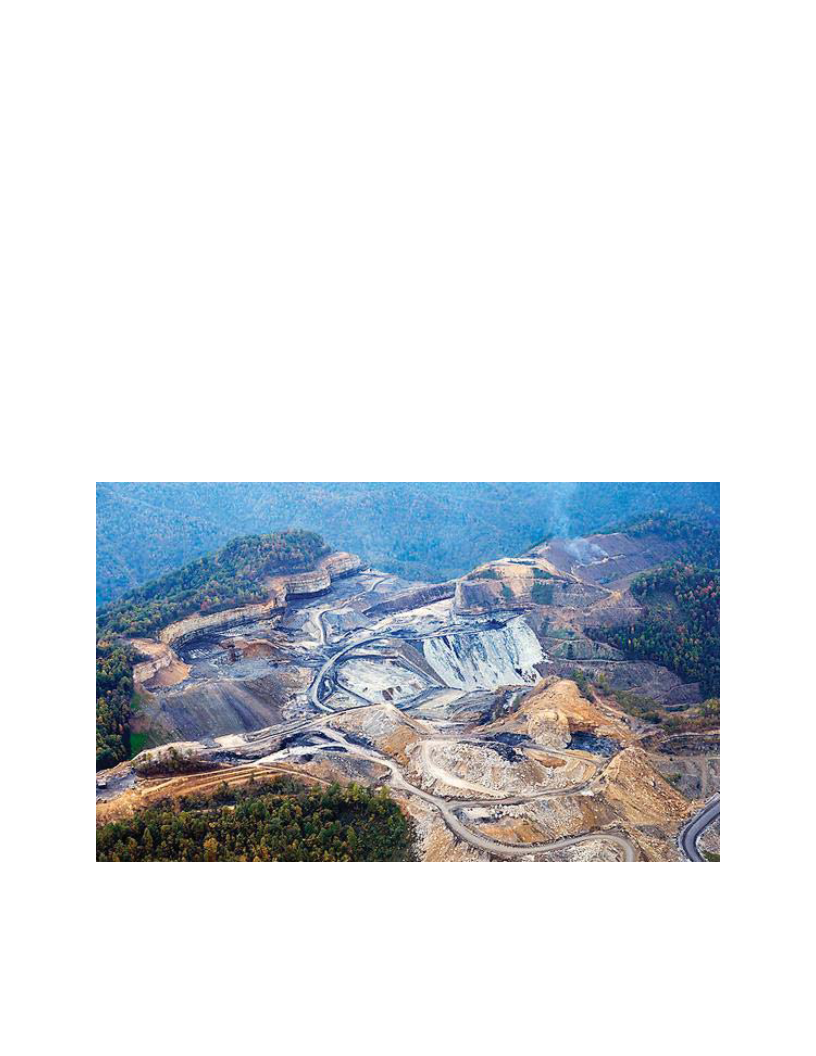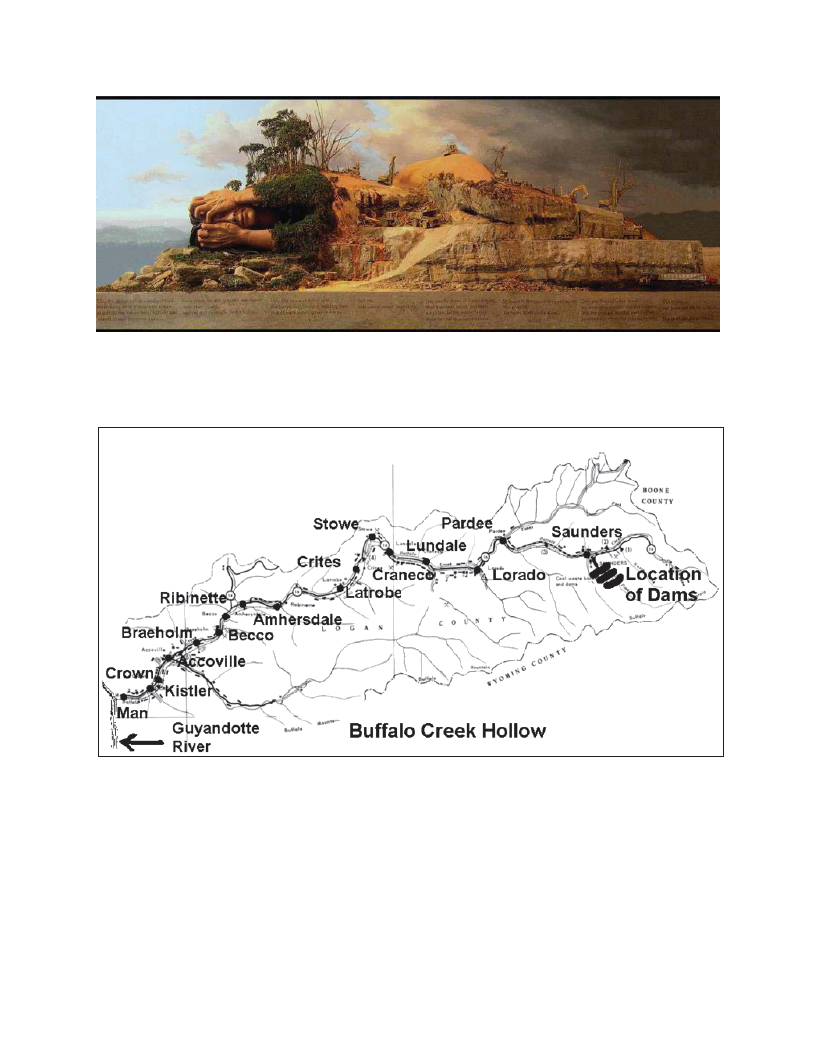
WITH THE EARTH IN MIND: ECOLOGICAL GRIEF
IN THE CONTEMPORARY AMERICAN NOVEL
Ashley E. Reis
Dissertation Prepared for the Degree of
DOCTOR OF PHILOSOPHY
UNIVERSITY OF NORTH TEXAS
May 2016
APPROVED:
Ian Finseth, Committee Chair
Priscilla Ybarra, Committee Member
Jacqueline Foertsch, Committee Member
Robert Upchurch, Chair of the Department
of English
Costas Tsatsoulis, Dean of the Toulouse Graduate
School

Reis, Ashley E. With the Earth in Mind: Ecological Grief in the Contemporary American
Novel. Doctor of Philosophy (English), May 2016, 233 pp., references, 260 titles.
With the Earth in Mind responds to some of the most cutting-edge research in the field of
ecocriticism, which centers on ecological loss and the grief that ensues. Ecocritics argue that
ecological objects of loss abound--for instance, species are disappearing and landscapes are
becoming increasingly compromised--and yet, such loss is often deemed "ungrievable." While
humans regularly grieve human losses, we understand very little about how to genuinely grieve
the loss of nonhuman being, natural environments, and ecological processes. My dissertation
calls attention to our society's tendency to participate in superficial nature-nostalgia, rather than
active and engaged environmental mourning, and ultimately activism. Herein, I investigate how
an array of postwar and contemporary American novels represent a complex relationship
between environmental degradation and mental illness. Literature, I suggest, is crucial to
investigations of this problem because it can reveal the human consequences of ecological loss in
a way that is unavailable to political, philosophical, scientific, and even psychological discourse.

Copyright 2016
by
Ashley E. Reis
Li

ACKNOWLEDGEMENTS
My acknowledgements must begin with Ann Pancake, whose Strange as This Weather
Has Been found me in a bookstore somewhere between Oregon, Wyoming, and Texas, and
revealed to me the palpable and very real nature of ecological grief at a most formative moment
in my academic life. I cannot thank Ann enough for forging a relationship with me; expressing
genuine interest in and offering earnest support for my project; and providing reminders through
her fiction and direct words to me of this project’s exigency.
Additionally, I am indebted to my generous and encouraging advisor, Dr. Ian Finseth, for
his unwavering support of my project from its earliest inception. Dr. Finseth’s enthusiasm for my
ideas and his confidence in my ability to bring them to fruition enabled me to make my way
through this process with as much finesse as one could ever hope. Dr. Priscilla Ybarra, too, gave
generously of her time, formally and informally, as a thoughtful critic and supportive mentor.
She was present for the early conference presentations of the ideas I advance in this dissertation,
and provided invaluable feedback, guidance, and, above all, inspiration. Dr. Jacqueline Foertsch,
who has been an influential presence since day one of my graduate career at UNT, has played an
immeasurable role in inciting me to be the best version of my academic self possible. I am
grateful to have spent three graduate seminars learning from her; for her first-rate direction and
guidance during my comprehensive exams; and for her unrelenting insistence that I step up to a
bar I didn’t know I could possibly reach. I would also like to thank Dr. Stephanie Hawkins, who
also dedicated her time and counsel as a member of my comprehensive exam super-committee.
And, of course, I am ever grateful to my canine sidekick Banjo, who, despite the long
hours writing and researching (typically at Banter Bistro—thank you to my Denton family
members Ellen and Kat), kept me tethered firmly and meaningfully to the earth all along.
iLi

TABLE OF CONTENTS
ACKNOWLEDGEMENTS ............................................................................................................LLL
INTRODUCTION: “WITH THE EARTH IN MIND: ECOLOGICAL GRIEF IN THE
CONTEMPORARY AMERICAN NOVEL”................................................................................ Y
CHAPTER : THE WOUNDS OF DISLOCATION: NATIVE AMERICAN
DISPLACEMENT AND ENVIRONMENTALLY-INDUCED MENTAL ILLNESS IN KEN
KESEY’S ONE FLEW OVER THE CUCKOO’S NEST................................................................. 1
CHAPTER : “UP AGAINST A MAD MACHINE”: THE PSYCHIATRIC REFUGE OF
WILDERNESS IN EDWARD ABBEY’S THE MONKEY WRENCH GANG ............................ 46
CHAPTER : THE CO-OPTED CONSCIOUSNESS: DON DELILLO’S WHITE NOISE AND
THE EVOLUTION OF ECOLOGICAL ANXIETY IN THE POST-NUCLEAR UNITED
STATES ...................................................................................................................................... 100
CHAPTER : MOURNING THE MOUNTAINS: SLOW VIOLENCE, CLASS, AND
ECOLOGICAL GRIEF IN ANN PANCAKE’S STRANGE AS THIS WEATHER HAS BEEN. 154
REFERENCES ........................................................................................................................... 217
iY

INTRODUCTION: “WITH THE EARTH IN MIND: ECOLOGICAL GRIEF IN THE
CONTEMPORARY AMERICAN NOVEL”
In a 2014 study titled “Beyond Storms & Droughts: The Psychological Impacts of
Climate Change,” the American Psychological Association (APA) attests to a phenomenon that
has been garnering critical and popular attention as of late: as humans, we have begun to grieve
for the ecological decline of the planet. The APA study contends that as a result of climate
change, individuals are experiencing more general trauma, stress, and anxiety, or more specific
conditions such as Post Traumatic Stress Disorder (PTSD) and Major Depressive Disorder
(MDD) and it anticipates an increase in mental health-related symptoms and conditions as the
effects of climate change continue to materialize (18-20). As they do, the psychological
symptoms of these conditions will gradually emerge. According to the APA, these symptoms
include substance abuse, depression, sense of loss, helplessness, fatalism, resignation, loss of
autonomy, and loss of personal identity and sense of control (22-24). While it is not inevitable
that climate change impacts individuals’ mental health and psychological functioning, the
likelihood of declining mental health in the face of ecological degradation is escalating.
Collectively, our growing awareness of ecosystems’ fragility and impending demise is causing
profound emotional turmoil.
With the Earth in Mind at once names the phenomenon whereby environmental
degradation provokes the decline of human mental health, and asserts literature’s capacity to
effectively address the nature of this phenomenon, reveal the destructive impacts of ecological
devastation, and encourage ecologically ethical behavior that can spare both human and
environmental deterioration. In this project, I will outline the emergence of what I call
“ecological grief” as an overlooked, yet critical phenomenon in the United States since 1945,
which post-World War II and contemporary American authors have explored since the war
v

ended. When Rachel Carson introduced the concept of environmental illness to popular
audiences in 1962, she did so by exposing the likelihood that the pesticide DDT entered the food
chain by accumulating in the tissue of animals and human beings, ultimately causing cancer and
other forms of genetic damage. In doing so, Carson alerted Americans to their own ecological
realities, and her work’s legacy attests to its immeasurable value. Since Silent Spring’s
publication in 1962, a variety of American authors have extended Carson’s essential arguments
that humans are not exempt from harm inflicted upon the ecosystems of which they are a part,
that human and nonhuman life is comprised of the same components, and that what affects,
mutates, or harms humans’ ecological surroundings stands to harm humans in the same way.
These critics and activists have, however, typically done so by imagining how damage to the
ecosystem manifests itself within the human body. The fictional works this dissertation features,
on the other hand, advance an essential element of environmental illness as they position the
human mind as a key component of the system of ecological vulnerability. Environmental
illnesses, these works suggest, are not contained within the human body, as it is traditionally
conceived. These works instead insist that environmental harm comes to bear on humans’ mental
health in critical and poignant ways.
In his 2001 Los Angeles Times article, “The World is Dying—and So Are You,” Richard
B. Anderson suggests that late twentieth- and early twenty-first century Americans are becoming
attuned to a “core of grief” which lies at “the heart” of the modern age. Anderson speaks to this
melancholia associated with the planet’s deterioration specifically as it evolved throughout the
twentieth century. “A great sorrow arises,” Anderson writes, “as we witness the changes in the
atmosphere, the waste of resources and the consequent pollution, the ongoing deforestation and
destruction of fisheries, the rapidly spreading deserts and the mass extinction of species.” It is
vi

generally accepted that the fin de siècle ushered in an era of irreparable change, which was
accompanied by anxiety and a sense of loss that plagued the modern era. However, I argue that
the particular “core of grief” Anderson highlights, which is fundamentally rooted in ecological
degradation, lies instead at the heart of the mid-twentieth-century. In particular, it originated as a
post-World War II phenomenon. WWII brought on a surge in industrialization, and ushered in
what scientists call The Great Acceleration, which represents a key phase within the current
epoch of the Anthropocene. According to Will Steffen et al., in the study, “The Anthropocene:
Are Humans Now Overwhelming the Great Forces of Nature?,” the Anthropocene began with
the industrial revolution and extends to include our own contemporary moment. This epoch
signals humans’ recognizable geophysical influence on all ecosystemic components at a
planetary scale. Since 1950, which roughly marks the onset of the Great Acceleration, scientists
have recorded the greatest exponential rise in atmospheric carbon dioxide in the planet’s history.
Nearly three quarters of carbon dioxide emitted has occurred since 1950, and half has occurred in
the last 30 years (Steffen et al. 618). As a result of this rise in carbon dioxide emissions, among a
multitude of other effects, ice sheets and glaciers are melting worldwide; sea levels are rising;
precipitation is increasing; and floods and droughts are occurring.
Despite the profound reality of ecological damage, it is difficult for humans—both
societally and individually—to acknowledge and cope with the grief they experience as a result
of the environment’s degradation. As Cate Sandilands explains in her 2010 essay, “Melancholy
Natures, Queer Ecologies,” “there is lots of evidence of environmental loss, but few places in
which to experience it as loss, to even begin to consider the diminishment of life that surrounds
us on a daily basis [as] something to be really sad about, and on a personal level” (338). While
the loss of human life is marked by rituals and performative events such as funerals, various
vii

forms of burial, and, in many cultures, periods of prolonged mourning, the loss of nonhuman life
in American culture, and a multitude of other Western and/or industrial cultures, is not. As
Sandilands explains, these “object[s] of loss [are] very real but physically ‘ungrievable’ within
the confines of a society that cannot acknowledge nonhuman beings, natural environments, and
ecological processes as appropriate objects for genuine grief” (333). It is time, however, that we
begin to recognize the “grievability” of nonhuman beings, and thus to recognize these beings’
inherent value. Turning to literature, I argue, enables this recognition.
Civilization and its Ecological Discontents
A grieving process that is both psychological and performative becomes a necessary tool
for psychological healing in the face of the planet’s deteriorating ecosystems. To be denied the
appropriate avenues of grief for these objects of loss can result in melancholia, notes Sandilands.
Freud, in “Mourning and Melancholia,” initiated a long modern tradition of exploring both
human psychological responses to both loss, and human-world interconnections. For Sandilands,
the critical tension between mourning and melancholia sheds light on humans’ melancholy
natures or, the experience of ecological grief. Whereas mourning has a finite timeline,
melancholia entails a suspended state of mourning. That is, mourning, like melancholia,
“involves grave departures from the normal attitude to life,” but is “overcome after a certain
lapse of time” (“Mourning and Melancholia” 243-44). However, with mourning, “the bereaved
ego becomes able to transfer attachment to new objects” (Sandilands 334). In the case of
melancholia, however, the ego will not and cannot let go. “Instead of transferring attachment
outward to a new [object]…the melancholic internalizes the lost object as a way of preserving
it.” This disallowance of grief at once “denies the loss,” and traps the melancholic individual
viii

within an unhealthy cycle of mental illness. As Sandilands so insightfully demonstrates, Freud’s
psychological theories are applicable in the case of ecological loss, as they elucidate the
psychological effects of such loss, the psychological ramifications of impeded grieving
processes, and the presumed “ungrievability” of ecological objects of loss. Freud’s work thus
lays a foundation for this dissertation’s contention that ecological grief manifests in humans who
have been denied the appropriate venues to mourn ecological loss, but nonetheless harbor an
inherent need to lament the loss(es) they have experienced.
Beyond substantiating the premises of ecological grief, Freud’s theories attest to the
foundational psychological inclinations that drive humans’ inherent connections to the natural
world. In Civilization and Its Discontents (1930), Freud discusses the “indissoluble bond,” or the
feeling of “being one with the external world as a whole” (12). In his opening chapter, Freud
recounts a letter sent to him by an unnamed friend, wherein this friend at once agrees with
Freud’s treatment of religion as an illusion,1 and yet laments Freud’s inability to recognize “the
true source of religious sentiments” (10). Freud explains,
This, he says, consists in a peculiar feeling, which he himself is never without,
which he finds confirmed by many others, and which he may suppose is present
in millions of people. It is a feeling which he would like to call a sensation of
‘eternity,’ a feeling as of something limitless, unbounded—as it were, ‘oceanic.’
(10-11)
While Freud admits that he cannot recognize this “oceanic” feeling in himself, and while he
cannot convince himself of “the primary nature of such a feeling,” he maintains that his own
1 See The Future of an Illusion, 1927.
ix

inability to perceive an indissoluble bond with the world outside of himself gives him “no right
to deny that it does in fact occur in other people” (12). In other words, whether or not Freud can
perceive his placement within an “oceanic” system of life is irrelevant. Despite the ego’s
maintenance of “clear and sharp lines of demarcation” between our selves and that which exists
outside of our selves, and despite our ability to perceive this demarcation, he acknowledges that
the boundary between ego and object can and does at times melt away (13). In fact, notes Freud,
our infant beginnings suggest such a state: “An infant at the breast does not yet distinguish his
ego from the external world…He gradually learns to do so” (13). The ego’s earliest state in fact
incorporates the external world, and it is only later that it detaches itself. This means that “[o]ur
present ego-feeling is, therefor, only a shrunken residue of a much more inclusive—indeed, an
all-embracing—feeling which corresponded to a more intimate bond between ego and the world
about it” (15). The assumption that certain individuals experience the persistence of this feeling,
the sense of “limitlessness and of a bond with the universe,” or the “oceanic” feeling to which
Freud’s friend alludes, lays the groundwork for a major premise of my argument in this
dissertation: that humans maintain an “ecological unconscious.”2 In such cases, a primordial state
of mind has persisted, rather than having been overlaid. Humans experience “discontent” in a
Freudian sense, then, when the must repress their ecological unconscious desires, instead
maintaining a superficial connection with the vast system of life to which they belong.
Echoing Freud’s notion of humans’ limitless bond with the universe, ecopsychologist
Theodore Roszak introduces the concept of “the ecological unconscious” in The Voice of the
2 In 2007’s Mind in Life: Biology, Phenomenology, and the Sciences of Mind, Evan Thompson
refers to a similar kind of “feeling of self and world” as sentience, or the ability to feel the
presence of one’s body—mind included—in the world (221).
x

Earth (1992) (301). Roszak coins the term to describe humans’ inherent connection to their
natural environment. The ecological unconscious, according to Roszak, drives a primordial
human need, that dates back to our distant human conditions. Of course, we must historically
distinguish Roszak’s concept from Freud’s, for Roszak points to the rise of symptoms related to
the repression of the ecological unconscious as specific to the postwar moment, one that I assert,
additionally, results from the material ecological degradation associated with the Great
Acceleration. The exponential growth of technological and industrial “progress” within the
postwar moment, and, accordingly, the ecological harm engendered by the spread of technology
and industry, alienated humans from their natural environments and/or impeded human
connection to healthy ecosystems by degrading the environment (Voice of the Earth 320). Since
the beginnings of the Great Acceleration, humans have struggled to fulfill the needs of the
ecological unconscious. Because there is an “interplay between planetary and personal well-
being,” as Roszak contends—meaning that the health of the psyche depends on the health of the
natural environment—humans’ ability to integrate ourselves with healthy ecosystems is critical.
And yet, contemporary advancements in unsustainable industrialization, capitalism, and even
basic ways of life have interfered with humans’ ability to do so. As a result, humans are
experiencing ecological grief.
But coping with this ecological grief is nearly impossible, given the widespread inability
to draw adequate connections between environmental degradation and mental illness. For one,
drawing such a correlation is tricky due to the difficulty of assembling quantifiable, scientific
data to prove that the degradation of one’s environs corresponds with the decline of her or his
mental health. Patients typically self-diagnose and self-report their symptoms, often drawing
their own conclusions as to the cause of their suffering. For example, in the case of afflicted
xi

individuals living in close proximity to mountaintop removal (MTR) sites in West Virginia, a
state which has one of the highest depression and suicide rates in the United States, scientists
have struggled to find a distinct correlation between the ecological devastation that results from
MTR and the elevated depression and suicide rates.3 Moreover, studies often attribute mental
health disorders in West Virginia to social, economic, and cultural factors such as lack of access
to education and mental health services, as well as high rates of unemployment (Keefe 1).
Even more problematic, however, for the endeavor of correlating environmental
degradation and mental illness is the American historical and cultural propensity for
misrecognizing or misconstruing instances of environmentally-induced mental illness as
nostalgia. As Jennifer K. Ladino notes in Reclaiming Nostalgia: Longing for Nature in American
Literature (2012), “a nostalgic infatuation with nature remains a powerful force in popular
culture” (xiii). Ladino seeks to “reclaim nostalgia” for more progressive means, and argues that
nostalgia has the potential to aid environmental movements. Nostalgia often stimulates
sympathy, she explains, and ultimately might inspire individuals to advocate for environmental
preservation. However, Ladino also interrogates the general skepticism towards nostalgia, and in
doing so, reinforces it at times. Ladino explains,
Notsalgia’s scapegoat status stems from a range of admittedly problematic traits:
its easy cooptation by capitalism, which critics like Fredric Jameson say generates
a postmodern cultural paralysis in which old styles are recycled and marketed
without critical effect (or affect); its ubiquity in the media and the arts, which
3 The nonprofit, nonpartisan group, State of the USA, conducted a state by state analysis, which
placed West Virginia just behind the state with the highest rates of depression, Mississippi, by
only .5 percentage points.
xii

signifies a lack of creativity, alienation from the present, and complicity in
consumer culture; its tendency to romanticize the past through imagining an
origin that is too simplistic; and its reactionary bent—the use of nostalgia by
right-wing forces to gloss over past wrongs and to glorify tradition as justification
for the present. (5-6)
When we wax nostalgic about “lost” environments, it is typically in reference to conceptions of a
people-less nature or wilderness that existed prior to the European colonization of North
America. But “wilderness” was never “untrammeled by man,” as The Wilderness Act would
have us believe. It has always been a site of human-ecological correspondence and kinship.
Nostalgia can perpetuate such understandings of socially constructed nature, rather than as an
amalgamation of material elements. Accordingly, nostalgia is often referred to as a “social
disease” that references a “felt lack” (Stewart 23), rather than the psychological impacts of a
distinct material site’s demise or loss.
Nonetheless, nostalgia can offer an effective starting point for advancing conversations
about the relationship between individuals and the sites for which they long, and which they
yearn to effectively grieve, in the case of localized ecological destruction of decline. In fact,
nostalgia is one of the only words in English that describes the links between the human mental
state and the environment. Literally, nostalgia means homesickness, with “nostos” meaning a
return to native home or land and “algia” meaning pain or sickness. Attending to nostalgia as
early as 1678, medical doctors once diagnosed nostalgia as a medical conditionand thus a bodily,
material one.4 However, they were ultimately unable to locate the disease in the body, or to
4 See Ritivoi 20 and Boym 9-10.
xiii

determine a unified taxonomy of causes (Ladino 7). Ultimately, nostalgia was de-medicalized at
the turn of the twentieth-century. Accordingly, it was stripped of its material, spatial, and
environmental connotations, and came to be best understood as we widely regard it currently: in
relation to time rather then material reality.
While Ladino’s attempt to “re-place” nostalgia by redeploying it for effective activist
means is a worthwhile scholarly endeavor, the phenomenon carries too great a cultural weight to
be practical. Widespread cultural assumptions have defined—and continue to define—nostalgia
as a romanticized relationship to the past. In the case of utilizing nostalgia to promote an
effective environmental ethic, as Ladino hopes, it is simply too difficult to destabilize the
overarching narrative surrounding it, as this narrative is indelibly rooted in our own American
ethos, which harkens back to Americanization and manifest destiny. American narratives,
especially nature narratives written since the “close” of the western the frontier in 1890, exhibit
nostalgia for the lost frontier and an uninhabited wilderness, as well as pastoral and pre-industrial
societies (Ladino 10), while continuing to dominate the American historical imagination.5 The
overbearing presence of nostalgia in these narratives and others is in many ways dangerous, as it
overlooks American histories of violence and oppression—oftentimes including the very
instances of environmental degradation and dispossession that likely precipitated early,
unrecorded instances of ecological grief—in favor of an idealized mythology that neatly ties
settler-colonial Euro-Americans to the landscape that comprises the nation.
Reinterpreting oft-misconstrued instances of nostalgia as potential instances of ecological
grief makes room for a pathology that recognizes the complex interrelationship between human
5 See Frederick Jackson Turner’s “The Significance of the Frontier in American History” (1894).
xiv

mental health and environmental health, and makes rooms for a necessary discourse in the social
and psychological sciences that attends to this phenomenon. Australian environmental
philosopher Glenn Albrecht’s concept of “solastalgia” is a more useful concept for the purposes
of this project, which, like Ladino’s, seeks to advance a productive discourse that can facilitate
environmental ethics and justice. The relationship between ecosystem stress and human distress
has driven Albrecht’s research over the past 25 years. By bringing to bear the work of Elyne
Mitchell, which suggests that when humans are “divorced from [their] roots [they lose] psychic
stability” (4), on David Rapport’s concept of “ecosystem distress syndrome” (628), Albrecht
began to conceive of “psychoterratic illness,” or environmentally-induced mental illness.6
Whereas theorists had previously interrogated contemporary “place pathology” and the resulting
symptoms of disorientation, depression, and various modes of estrangement (Casey 38) amongst
displaced peoples such as Native Americans, Albrecht is interested in places that are not
“completely lost,” but places that are “being transformed” (“Solastalgia: A New Concept” 44). In
Albrecht’s study, the people of particular concern are not always forcibly removed from their
homeplaces. However, their “place-based distress [is] also connected to powerlessness and a
sense that environmental injustice [is] being perpetrated on them.” In other words, as Albrecht
explains, though still “at home,” the individuals in question “[feel] a similar melancholia as that
caused by nostalgia connected to the breakdown of the normal relationship between their psychic
identity and their home” (“Solastalgia: A New Concept” 44). Albrecht’s “solastalgia,” then,
describes the “specific form of melancholia connected to lack of solace and intense desolation”
6 Albrecht argues that Mitchell “should properly be seen as Australia’s Also Leopold” (41).
xv

with which I am concerned in this dissertation, and from which I derive my concept of ecological
grief.
The Novel and Ecological Consciousness
American society’s tendency to participate in superficial nature-nostalgia, rather than
active and engaged environmental mourning, perpetuates ecological grief. But by calling upon
literature, which constitutes its own imaginative domain for addressing this phenomenon, we can
begin to identify ecological grief as a result of environmental degradation, and thus to address
this phenomenon and its causes. Given the difficulty that conventional scientific and political
discourse has traditionally faced in identifying and substantiating a correlation between
ecological and human psychic stability, literature becomes an essential ally and a rich source for
investigating the phenomenon of environmentally induced mental illness. Whereas other
disciplines require particular data sets that arise from controlled environments, literature attends
to humans’ ecological realities in more imaginative and enterprising ways. If literature, as David
Lodge asserts, is “a record of human consciousness, the richest and most comprehensive we
have” (10), and if it “constitutes a kind of knowledge about consciousness which is
complementary to scientific knowledge” (16), then literature stands to reveal the human
consequences of ecological loss in a way that is unavailable to political, philosophical, scientific,
and even psychological discourse.
Novels in particular can effectively address the nature of the ecological unconscious and
the ecological grief individuals endure because of a lack of sustaining ecological implacement,
for the genre’s narrative form allows for a sustained appraisal of human psychological processes,
and stands to affect social reform. The emergence of the novel as a form corresponds with
xvi

western philosophy’s preoccupation with human consciousness within the last three and half
centuries (Demasio 231), and thus it is no coincidence that the same period that saw the rise of
the concept of consciousness also saw the rise of a new narrative literary form in the novel
(Lodge 39). Whereas earlier narrative forms—the epic, for example—recycled stories and tropes,
the novel attempted new and unique stories that spoke to the individuality of human experience,
and human consciousness. Moreover, unlike the forms that preceded it, the novel emphasized
“interiority of experience” (Lodge 39). In accordance with Descartes’s paradigm-shifting
philosophy that consciousness determined humanity, the grandiose form of the novel burgeoned,
giving prominence to “phenomena such as memory, the association of ideas in the mind, the
causes of emotions and the individual’s sense of self” (Lodge 40). Meanwhile, the novel allowed
for dramatic arcs and tensions, and lent itself to a sustained, nuanced narrative; a well-developed
plot; and strong characterization. Combined, these elements contributed to complex literary
representations of the human psyche.
The novel’s techniques for representing human consciousness have been widely critiqued
and theorized. For instance, in Transparent Minds: Narrative Modes for Presenting
Consciousness in Fiction (1978), Dorrit Cohn highlights the extent to which the novel allows for
extraordinary access to a fictional character’s interiority. “Fictional consciousness,” she writes,
“is the special preserve of narrative fiction” (vi). The novelist finds her or himself in a
particularly powerful position: she or he is a “creator of beings whose inner lives [she or he] can
reveal at will” (4). Cohn asserts, moreover, that the novel’s creative resources position it to tell
the audience “how another mind thinks, another body feels” (5-6). It does so by way of an
authoritative narrator, or by generating what Dorothy Hale calls “the illusion of quoted mind
content” (273). Even as she or he “draws on psychological theory and on introspection,” the
xvii

novelist, says Cohn, “creates what [José] Ortega called ‘imaginary psychology…the psychology
of possible human minds’—a field of knowledge the Spanish critic also believed to be ‘the
material proper to the novel’” (6). For these reasons, the novel as form positions us to effectually
question the nature of the ecological unconscious.
Additionally, the novel’s social, historical, and political value positions it as a form of
social discourse that stands to enact social change. Or, in the case of the novels I examine here,
to enact environmentally ethical behavior. By at once “[depicting the] particular experience of
fictional characters in their social worlds,” and “[positioning its] readers as witnesses to and
interpreters of those fictional worlds” (Hale 437), the novel performs a social function. In
Sensational Designs: The Cultural Work of American Fiction 1760-1860 (1985), Jane Tompkins
equates the novel’s social power with all other forms of social discourse. For Tompkins, the
novel performs the same kind of ideological work as both nonfiction writing, and other forms of
nonliterary writing (539). In fact, for Tompkins it is the literary form best suited to persuasion
and thus to social reform. By “emotionally acting upon” the reader (Hale 447) and positively
soliciting the reader’s affective engagement, the novel stands to persuade readers, who may
come to a novel from a social position that contends with the ideals of the novel, or at least
render them willing to change their views. Novelistic discourse, as Tompkins argues, is
particularly well-suited to expressing the need for social change, and even for envisioning and
ultimately enacting such change.
While Tompkins is interested in the sentimental rather than the realist novel, this project
focuses almost entirely on realist novels. Traditionally speaking, the realist novel effectively
emphasizes the need and serve as a tool for social change by enacting the “powers of realism”
that Hale attributes to the novel in compelling representations of “real” material environments.
xviii

Lilian Furst offers a compelling interpretation of the realist novel in its contemporary moment in
All is True: The Claims and Strategies of Realist Fiction (1995), which points out that despite the
difficulty of realistic representation, the importance of the realist novel is that these novels
relentlessly grapple with the task. One way of confronting the obstacles of realistic
representation, notes Furst, is via one of the “cardinal conventions of the realist novel”:
particularity of place (24). She writes,
Place can be taken either literally, as a way to endow the fiction with the stamp of
truth, or more obliquely, as a part of a complex scenario in which it still plays a
vital role—not as a direct replica but rather as a prop in the animation of a
pretense. In both cases, place is central to the plausibility of the fiction. (24-25)
The suggestion that the places these novels imagine are real lends plausibility to the fictional
representation of the real. For instance, Ken Kesey’s One Flew Over the Cuckoo’s Nest (1962)
depicts Celilo Falls on the Columbia River in Oregon, Edward Abbey’s The Monkey Wrench
Gang (1975) portrays (what once was) Glen Canyon in the desert Southwest, and Ann Pancake’s
Strange as This Weather Has Been (2007) sketches Buffalo Creek in West Virginia. Such
incorporation of these “semblances of reference” into the process of representing material
realities is a distinctive hallmark of the realist novel, explains Furst, as is it advances the closest
thing it can to reality: a pretense of truth (25). Don DeLillo’s White Noise (1982) is, of course,
the exception to this rule. A prototypically postmodern novel, White Noise may seem an
unorthodox choice. However, it is the novel’s social context that interests me, and by conducting
the necessary historical research and positioning the novel effectively within this context, I am
able to attend to its realist elements. That is, although the text’s symbolic technique is highly
refractory, these symbols stand in for very real material environments and conditions, which lend
xix

themselves to a reading of toxic materiality as it comes to bear on the human mind. While
Blacksmith isn’t a “real” town, that is, we associate its realities with towns we know. It could—
and may as well—be Niagara Falls, New York, where the Love Canal Tragedy Occurred, or St.
George, Utah, which lies downwind of the Nevada Test Site. Both locations, like Blacksmith
itself, house populations typically protected from environmental injustice. The realist novel—and
sometimes, it turns out, the postmodern novel—by utilizing place, or material ecological sites to
develop realistic plausibility, does important work then as it gives its readers a sense of the
everyday realities of ecological grief.
Of course, imagining interiority and psychology in completely realistic ways is
essentially impossible. The realist novel nonetheless attempts to do so by representing both
environments and psychologies in tandem, engaging in a balancing act commonly enacted in the
novel, which Cohn aptly refers to as “the mutual dependence of realistic intent and imaginary
psychology” (6). Although novelists can only “imagine” these psychologies, their characters’
interiority takes on the next best thing: what Henry James in “The Art of Fiction” calls “one of
the supreme virtues of the novel…the air of reality” (my italics). The novel, the most distinctive
feature of which, according to Hale, is its “capacity for sustained psychological realism” (272), is
also the most suitable site for “the mimesis of consciousness” (Cohn 7). Because consciousness
is, by Freud’s definition “that which can never be known by consciousness but which expresses
itself indirectly through its effects on consciousness” (Hale 274), like the air of reality, a mimesis
of consciousness also serves realist purposes, especially if this mimesis can position readers to
“establish an affective relation that rivals our real-life social relations” (Hale 273). It is in this
way that the realist novels this dissertation highlights (and the postmodern novel it includes)
xx

conscientiously enact the work of plausible representation, and encourage ecologically-ethical
behaviors.
Material Ecocriticism and the Embodied Mind
While ecocriticism has begun to focus on the transcorporeality of human bodies and
environments on a material level, by investigating how the aforementioned novels associate
psychological affliction with environmental degradation, this dissertation challenges the critical
tendency to emphasize bodily over psychological harm, and advances the theoretical position
that environment, body, and mind are interlinked and mutually determined. Environmental
historian Linda Nash’s Inescapable Ecologies: A History of Environment, Disease, and
Knowledge (2007) is a revealing example of recent criticism that advances the study of human-
environmental material relationships in vital ways, and yet which nonetheless disregards the
human mind, or brain, in its analysis of humans’ bodily reactions to environmental stressors.
Silent Spring propels Nash’s argument, as Nash points to the publication of Carson’s seminal
work as perhaps the moment that Americans came to experience and understand their own health
as connected to the health of the land. Carson blew a whistle that resounded from coast to coast,
revealing to Americans that the indiscriminate dissemination of the pesticide DDT posed
extensive harm not only to its intended target, but to entire ecosystems as well, including the
human inhabitants of these ecosystems. Silent Spring still garners praise today for highlighting
the dangers that these newly introduced and widely disseminated chemicals posed to human
bodies. And yet, recent scientific research suggests that the dissemination of DDT also affected
exposed humans psychologically. Scientific studies not only reveal that “the relation between
farming, pesticide exposure or poisoning, depression, injury and suicide is an area of increasing
xxi

concern” (Freire and Koifman 445). They go so far as assert that “exposure to high levels of
pesticides, including poisoning, experienced by agriculture workers and rural residents may
result in an elevated risk of neuropsychiatric sequelae (mood disorders, depression and anxiety)
and suicide attempts and mortality.”7
While Nash and others overlook what Evan Thompson calls “the deep continuity of life
and mind,” theorists from other disciplines, such as Gregory Bateson and Christopher J. Preston,
do in fact address the embodied mind. These theorists’ work has vast implications for this
literary project, as they provide a theoretical framework for understanding the “hard problem of
consciousness” that comes to bear on ecocritical work, and is likely at the core of many
ecocritics’ emphasis on traditionally conceived bodies—mind not included—as the objects of
environmental harm. Thompson describes this problem thusly:
Many philosophers of mind today believe that a profound difference exists
between consciousness and mere biological life. On the one hand, consciousness,
or more precisely, so-called phenomenal consciousness, is thought to be an
internal, subjective, qualitative, and intrinsic property of certain mental states.
Life, on the other hand, is thought to be an external, objective, structural, and
functional property of certain physical systems. Given this way of thinking, the
attempt to understand consciousness and its place in nature generates a special
problem, the so-called problem of hard consciousness. (222)
In other words, Thompson explains, “there seems to be an explanatory gap between physical
structures and functions and consciousness” (223). And yet, “mental life is also bodily life and is
7 See also London et al., 2005 and 2012, Meyer et al., and Pearce et al.
xxii

situated in the world” (ix). “The roots of mental life lie not simply in the brain,” he asserts.
Rather, they “ramify through the body and environment.” “Our mental lives involve our body
and the world beyond the surface membrane of our organism, and therefor cannot be reduced
simply to brain processes inside the head,” adds Thompson (ix). What we call interiority then, in
his words, “comprises the self-production of an inside that specifies and outside to which that
inside is constitutively and normatively related” (225). I echo Thompson’s sentiment that we
must dismiss these dualisms that pit consciousness and life—or mind and environment—against
one another, and “go beyond the idea that life is simply an ‘external’ phenomenon in the usual
materialistic sense” (224).
Reconceiving of the mind as situated in the material world positions us to remedy
ecological destruction. In Gregory Bateson’s opinion, we must come to some understanding
about how to motivate individuals to act in ways conducive to achieving this goal. We can’t
change our actions, that is, without first changing how we think. In his Steps to an Ecology of
Mind (1972), Bateson calls for an interdisciplinary approach to investigating how consciousness
changes and influences individual and social patterns. Thinking of the mind as an ecosystem of
sorts is crucial to this endeavor, he suggests (xxiii). His interest in systems theory (xxxii) leads
him to consider the mind as part of a broader network. Bateson revisits his central thesis in Mind
and Nature: A Necessary Unity (1979), in an attempt to “give the ecology of mind a more
explicit, coherent, and articulated form than the one elaborated in Steps” (Manghi xi). Here, he
delivers what Sergio Manghi calls a “precious lesson” for the twenty-first century: “After the
rapid globalization of the liberal economy and the overwhelming progress of technologies of life,
weapons, and communications, for good as well as for evil, there is an increasing necessity for
an awareness of being part of relational contexts, both great and mysterious…” (xii). Bateson’s
xxiii

interests in the ways that the world shapes human consciousness and understanding, and
humanity’s systematic relationship to the living world—or what he calls the “unity of biosphere
and humanity” (Mind 16)—lay the foundations for this project.8
Despite the existence of the kind of anthropological and philosophical work conducted by
Bateson and Preston, and sociological and psychological research that suggests that ecological
stressors can alter the human mind, ecocriticism stands to account for these interdisciplinary
advancements more fully. For instance, in her 2010 work Bodily Natures: Science, Environment,
and the Material Self (2010), Stacy Alaimo re-conceives of human corporeality and materiality
via the concept of “transcorporeality.” Alaimo focuses almost entirely on the human body as it is
traditionally understood: as an entity separate from the human mind. 9 Alaimo does so by
highlighting the extent to which the human body is “‘intermeshed’ with the more-than-human-
world” (2). Humans and nonhumans are materially interconnected, Alaimo argues. Human
“selves” are not sealed off entities, but are rather beings undergoing constant change in relation
8 Preston’s work, which the philosopher professes takes as its central interest “the connections
between place and mind” (xi), builds on the tradition of research Bateson initiated. Preston’s
main argument is that our physical environment comes to play an important role in structuring
the way we think,” for humans—like all other “organisms that know things about the world”—
are “situated beings, beings cognitively grounded in the worlds from which they speak” (xi). The
material realities of place shape mental activity, Preston argues, and constitute some of the most
important factors relevant to the study of “how we know.”
9 Alaimo does, however, note that some dismiss Multiple Chemical Sensitivity as a
psychosomatic or hysterical condition (114), and “[fix] the blame” for MCS on an afflicted
individual’s psyche (119), which of course sheds a great deal of light on how we as a culture
view mental disorders, generally. Additionally, she echoes this dissertations claims to the
materiality of the mind, explaining, “the debate over whether MCS is a psychological or medical
condition is, of course, an argument about whether or not this illness is ‘real.’ Those who argue
that MCS is psychosomatic not only conceive of the mind as strangely immaterial, but they sever
the psyche, as well as the rest of the person, from the broader environment” (128). However, on
a whole, her work focuses on the materiality of the “body,” and thus she leaves room for the
work I enact in this dissertation.
xxiv

to our interactions with other human and nonhuman life. Neither the human body nor the
nonhuman world are self-referential, Alaimo insists. Instead, both are simultaneously made at all
times. The material world, then, as she explains, is actually the very substance of our human
selves. Additionally, this means that, like humans, nonhuman environments, which are “too often
imagined as inert, empty space or as a resource for human use,” constitute material entities with
their own needs and requirements for survival (2). Although Alaimo has developed the
invaluable premise that underlies this dissertation, her work nonetheless invites the kind of
complication this dissertation will undertake.
Like Alaimo’s material ecocritical study, Heather Houser’s Ecosickness in Contemporary
U.S. Fiction: Environment and Affect (2014) calls for complication as well. Houser’s work
theorizes the emerging literary tradition of “ecosickness fiction,” or post-1970—and post Silent
Spring—American fiction and memoir that interweaves the human material self and its material
environs by way of environmental illnesses. However, despite its professed interest in
transcorporeal ecological harm to both environment and human, Houser’s work, too, overlooks
an opportunity to incorporate the human mind into her analysis. While affect, she argues,
“designates body-based feelings that arise in response to elicitors as varied as interpersonal and
institutional relations, aesthetic experience, ideas, sensations, and material conditions in one’s
environment” (3, my italics), she underplays the psychological and neurological aspects of affect
and perpetuates the dualism that separates human body and mind. Nonetheless, Houser’s work,
like Alaimo’s, is invaluable to my own, for she introduces an analytic framework for
investigating the trope of sickness in literary works, using particular affects that determine
degrees of ecological investment or disengagement, and situating affect as a narrative mode that
advances environmental consciousness amongst its readership.
xxv

While Nash, Alaimo, Houser, and others have complicated our understanding of human
materiality by exploring the interconnectedness of human bodies and nonhuman environments as
codeterminative, these critical analyses need to be pushed even further.10 Discussions of
environmental illness abound in this tradition of material ecocriticism, but these critics and
theorists have yet to consider environmentally induced mental illness and trauma. With the Earth
in Mind broadens the concept of transcorporeality by situating the human mind as part of this
material network. Although, as David Chalmers notes in his well-known essay, “Facing Up to
the Problem of Consciousness,” we must consider the mind to be more than mere matter, it is a
material facet of the human body, nonetheless. In other words, the mind functions as both mind
and brain, a mass of tissue, neurons, and other material components that are susceptible to the
same environmental stressors impacting the material ecosystem of which it is a part.
Understanding the mind thusly allows us to expand our conception of the full complexity of
humanity’s relationship to environment.
Reconditioning the ways in which we conceive of our selves materially in relation to the
environment is often regarded as a posthumanist endeavor but ecocriticism stands to gain a great
deal from advancing this ethic as well. It is my hope that this project will aid the ethical
advancement of the field of ecocriticism by extending the work of material ecocriticim to effect
ecocritical theories, methodologies, and activisms. The material ecocritics whose work I draw on
herein—Nash, Alaimo, Houser, et al.—account in numerous, conscientious and inspiring ways
for how the material world acts upon and affects human bodies, behaviors, and knowledges.
10 See also Priscilla Wald’s Contagious (2008), which informs these critical approaches via its
invaluable contributions to twentieth-century medical literature. Herein, Wald outlines a tradition
of twentieth-century “outbreak narratives” that utilize public health discourse and methods of
infection and treatment.
xxvi

Furthermore, these critics propose environmental ethics that deny the human subject a
centralized, privileged position, instead repositioning it as part of a larger and equally agential
material network. In other words, these theorists show how the human material self effects and is
affected by the material environment in such a way that primes us to begin conceptually
reconfiguring the human-environment relationship in light of a new sense of responsibility and
morality. Reimagining human corporeality and materiality by highlighting the extent to which
the human body is “‘intermeshed’ with the more-than-human-world” (Alaimo 2) is an inherently
ecological endeavor. While many see this as a posthumanist ethic, I establish its suitability as an
ecocritical one as well. If ecocriticism is to effectively enact a spirit of activism, as it has
expressed interest in doing, it is only “natural” that it actively promotes transcorporeal
understandings of the human self holistically in relation to the material environment.
Beyond these contributions to the practice of ecocriticism, the argument this dissertation
poses—that a tradition of postwar and contemporary American novels support philosophical and
epistemological claims that the human mind is a part of a larger ecological and material network,
and indicates that environmental degradation can, accordingly, impact the human mind—
represents a key intervention into the study of contemporary American literature. It does so by
showing how, in light of postwar writings that revealed to Americans the effects on the human
body of environmental pollution, toxins, and fallout, various authors have highlighted a critical
element of the relationship between human beings and their environments. By reimagining a
network of mutuality between earth, body, and mind, these authors suggest that humans and their
environments not only interact with but also co-constitute one another. Through their fictional
treatments of ecological grief, these authors help their readership to understand the need for
alternative modes of ecologically ethical conduct.
xxvii

This dissertation’s close readings present an overall picture of a literary tradition that
contends with dominant ideologies that insist upon separating the human and the environment,
and thus has the potential to advance a suitable ideology and/or environmental ethic. This
ideology/ethic a) recognizes that the environment is the substance of the human, and vice versa,
and b) reconsiders the material world as neither an inactive resource for human consumption,
nor, in Alaimo’s words, “a deterministic force of biological reductionism” (2). Specifically, the
literary representations of psychoterratic illness that this dissertation features collectively
exemplify the extent to which human health relies on environmental health. These readings
ultimately suggest that contemporary American literature’s recognition and treatment of trans-
corporeality and environmentally induced mental illness demonstrates the crucial nature of
material beings’ interconnectedness to material environments and calls for the appropriate,
ecologically ethical behavior from its readership.
Chapter Outline
The postwar and contemporary American novels I examine in the following chapters
represent the complex nature of ecological grief by creatively representing the psychological
consequences of a systematic denial of humans’ evolutionary need to connect with a healthy
natural environment. That is, they portray instances of environmental degradation that negatively
impact not only the bodies of the humans who are intertwined with threatened ecological
communities, but these individuals’ minds as well. These novels position acts of environmental
degradation and injustice—from damming to logging, and from nuclear contamination to
mountaintop removal—as harmful to the human mind. Moreover, they not only supplement
emerging scientific, neurocognitive, and ecopsychological studies that suggest the reality of
xxviii

pyschoterratic illness, but stand to give prominence to the exigency of this phenomenon.
Furthermore, these novels reimagine earth, body, and mind as interwoven components of an
ecological tapestry, and make clear that humans and their environments not only interact with
but also affect and shape one another. While these novels cannot, in themselves, suggest a
distinct chain of causality, nor enact a therapeutic response to psychoterratic illness, they
nonetheless vividly represent environmental harm, and stand as a call to action against the
damage done to both environments and humans simultaneously. The novels I examine in the
following chapters are Ken Kesey’s One Flew Over the Cuckoo’s Nest (1962), Edward Abbey’s
The Monkey Wrench Gang (1975), Leslie Marmon Silko’s Ceremony (1977), Don DeLillo’s
White Noise (1985), and Ann Pancake’s Strange as This Weather Has Been (2007). Additionally,
I incorporate into these readings the work of nonfiction writers, who cannot utilize fictional, and
more specifically, novelistic methods as they take issue with the same instances of environmental
degradation that their fictional counterparts critique. Nonetheless, pairing the novels in this study
with nonfiction works like Rachel Carson’s Silent Spring (1962), Katie Lee’s All My Rivers Are
Gone: A Journey of Discovery Through Glen Canyon (1998), Terry Tempest Williams’s Refuge:
And Unnatural History of Place (1992), and Eric Reece’s Lost Mountain: A Year in the
Vanishing Wilderness (2007) at once allows me to outline the extra-literary context of these
instances of environmental degradation, and to illuminate the phenomenon of ecological grief
more broadly.
With the Earth in Mind interweaves a narrative history of twentieth-century American
environmental thought with a more detailed account of a distinct literary tradition that speaks to
the nature of human-environment interaction, and that emerged in complex relation to dominant
environmental attitudes. Throughout these chapters, I trace the ways in which literary treatment
xxix

of ecological grief has developed since 1962, when Ken Kesey’s One Flew Over the Cuckoo’s
Nest and Rachel Carson’s Silent Spring were both published. In chapter , I examine how
Cuckoo’s Nest situates the embodied human mind as vulnerable to various forms of
environmental degradation and displacement by illustrating the emergence of environmental
grief in its narrator, Chief Bromden, as a result of his tribe’s ecological dispossession. I also
argue that Kesey anticipates and presents in narrative terms a core insight of ecopsychology that
is critical to this project’s overall argument: that humans possess an “ecological unconscious,” or
an evolutionary need to stay connected to their natural environments, and that a repression of this
need has damaging psychological effects.
Chapter interrogates Edward Abbey’s intervention into the twentieth-century
American wilderness debate with his 1975 novel, The Monkey Wrench Gang. Abbey’s novel
further develops a psychoterratic literary tradition by exploring the ecological grief his characters
suffer in the face of their exile from the wilderness spaces that sustain them. In a postwar
moment that sent American flocking to wilderness areas and national parks in numbers greater
than ever before—a moment wherein the parks came under threat of “being loved to death”
(Nash 316) as a result of littering, overcrowding, and pollution—Abbey’s novel attributes his
characters’ psychological damage to the destruction of wilderness associated with this boom.
That is, as Abbey declares unadulterated wilderness a “psychiatric refuge,” or a requirement for
human beings’ mental health, he concurrently indicates the psychological effects of denying
humans access to such sites (whether by physically banning them from wilderness, or by
despoiling the ecological integrity of it).
Chapter turns to Don DeLillo’s White Noise (1982), which presents the aftermath
of the industrialization that Kesey and Abbey sought to preempt, and thus provides a new angle
xxx

from which to interpret the environmentally embodied mind. DeLillo’s novel contends with a
subtler, more insidious form of environmental degradation, which has already eradicated any
possibility for unmediated ecological interaction between humans and the environment, let alone
reciprocity: toxic contamination. White Noise suggests that the conditions of a “risk society”—
with its emphasis on perpetuated ecological threat—can be understood in themselves as
contributing to psychoterratic illness, as they in fact awaken ecological awareness, and thus
contribute not to ecological grief, per se, but rather to ecological anxiety. This chapter argues that
DeLillo’s novel calls upon the U.S.’s history of nuclear anxiety and fear of contamination—
which led Americans to perceive their own entanglement with material ecological networks, and
generated ecological awareness—to advance a new form of psychoterratic illness that emerged
during the Cold War: ecological anxiety.
Chapter shows how Ann Pancake’s Strange as This Weather Has Been (2007)
conceives of the slow violence (Nixon 2) associated with mountaintop removal as a contributor
to both ecological grief and anxiety. Pancake’s novel then suggests that psychoterratic illness can
be a multifaceted condition. As Pancake deliberately identifies the human mind as one of the
many casualties of prolonged ecological destruction, she calls for an overhaul in common
conceptions of what constitutes violence. Ecological destruction, that is, and other forms of
environmental injustice, ought to be regarded as violence, her novel suggests, with devastating
psychological consequences. It provides an apt point of closure for my project, for it asserts that
despite loss, there is hope for not only ecological restoration, but for psychic restoration as well.
If we continue to tell the stories of ecological loss, the novel and this project as a whole suggest,
we afford this kind of loss the urgency it deserves. In so doing, we also render ecological objects
of loss as grievable, and thus inherently valuable.
xxxi

These novels illuminate the profound connections between humans and their
environments and reveal the tremendous stakes, for both humans and their environments, of
developing an environmental ethic wherein individuals might conceive of themselves as entities
that affect and are affected by the places they inhabit. In hopes of providing an answer of sorts to
the damage that the dualism between humans and environments advances even still, this
dissertation will question and deconstruct the human/environment dualism, which still plagues
much contemporary American environmental thought. The sort of environmental ideology that
delineates human from environment is evident as early as the Old Testament, wherein which
God grants man dominion over nature. American environmental thought has been dominated by
a conception of human and nature as separate entities since the U.S.’s imperialist, colonial
beginnings. For early Americans settling the frontier, “wilderness” was distinctly separate from
civilization. These early Americans did not consider themselves a part the natural world but
rather as what Roderick Nash calls “masters and not members of the life community” (xii). This
“ecological superiority complex” led to the conception of wilderness as adversary, target, or
object ripe for exploitation, rather than an entity of which humans were a part (Roderick Nash
xiii). Aldo Leopold’s 1949 commentary on the overarching, national understanding of the human
relationship to the environment in A Sand County Almanac points to this dualism’s persisitence
over time. He notes that Americans regarded nature “as a commodity belonging to us” (vii)
rather than as a community to which we belonged. However, when Carson illuminated the way
that environments can affect human prosperity, Americans began to conceive of their
relationship to the environment in new ways. Suddenly, Americans began to understand the
environment as more than a resource, playground, or a space in need of taming. Rather, they
began to see themselves as connected to it in some way and understand their own well-being as
xxxii

reliant on its welfare. This dissertation will show how contemporary American literature
deepened this conception of the material and psychological connections between human and
environment.
With the Earth in Mind ultimately underscores literature’s ability to precipitate a
decentering of the human, or a removal of the human from the privileged yet self-destructive
position humanism has afforded our species. An engagement with the literary tradition I trace
herein asks that humans interrogate their practices of thinking and being in the world, which
elevate them above other nonhuman animals and living organisms. Engagement with this
literature can prompt its readership to recognize the interdependent relationship between humans
and the ecosystems they inhabit, and thus stands to aid in the eradication of what remains of the
dangerous dualism that pits human against environment, and stands in the way of a sustainable
environmental ethic. This dualism allows humans to skirt environmental responsibilities—most
notably the responsibility to sustain the material environments of which we are a part. This
tradition of postwar and contemporary American novels enables a greater understanding of earth
and self as interconnected, and promotes alternative epistemologies. Moreover, it positions the
humanities, and literature in particular, as a critical mode of ecological inquiry that is crucial to
the advancement of alternative modes of sustainable and ethical ecological conduct.
xxxiii

CHAPTER
THE WOUNDS OF DISLOCATION: NATIVE AMERICAN DISPLACEMENT AND
ENVIRONMENTALLY-INDUCED MENTAL ILLNESS IN KEN KESEY’S ONE FLEW
OVER THE CUCKOO’S NEST
I can see all that and be hurt by it, the way I was
hurt by seeing things in the Army, in the war. The
way I was hurt by seeing what happened to papa
and the tribe. I thought I’d get over seeing those
things and fretting over them. There’s no sense in
it. There’s nothing to be done.
One Flew Over the Cuckoo’s Nest
In 1962, Rachel Carson published Silent Spring, a narrative that emphasizes the
interconnectedness of human and environment as it sheds light on the slow and continuous
poisoning of both entities by the pesticide DDT, among other toxins and chemicals. Since its
release, Silent Spring has been lauded as one of the most influential environmental works of the
twentieth century, and is often credited with prompting the environmental movement in the
United States. Carson’s illumination of the horrifying processes by which human bodies
ultimately ingest toxins introduced into the environment gave way to the concept of ecological
health and ultimately engendered a new way of understanding the human relationship to the
environment as reciprocal and interdependent.
Published the same year as Carson’s invaluable work, Ken Kesey’s One Flew Over the
Cuckoo’s Nest similarly posits a human interconnectedness to place and suggests that the
devastating effects of damage to one entity—either environment or human—wreak havoc on the
other. And yet Kesey’s novel nuances and even augments Carson’s thesis as it illuminates
environmental degradation’s potential to adversely affect not only the human body, but the
human mind as well. While Carson conceives of environmental contaminants permeating the
material human body, she makes no mention of the effects of such environmental assaults on
1

mind, which we can at once interpret as matter and at the same time must recognize as something
more complicated. Furthermore, she overlooks how the damage done to one’s environment
might affect one’s psychological health, perpetuating the mind/body binary that drives a majority
of Western master narratives. Cuckoo’s Nest deconstructs this binary as it suggests that
environmental degradation perpetuates mental degradation. The novel extends traditional
concept of environmental illness as impacting more than just the corporeal body as it presents
characters that experience the degradation of their homeplace, as well as ultimate displacement
from it, and as a result suffer from significant psychological harm.
Specifically, the novel evidences the experience of environmentally-induced trauma
through the mental breakdown and eventual death of narrator Chief Bromden’s father, Tee Ah
Millatoona, or “The-Pine-That-Stands-Tallest-on-the-Mountain” (Kesey, Cuckoo’s Nest 188)—I
will refer to him henceforth as “the elder Chief”—as well as the traumatic flashbacks of
homeplace degradation and environmental exploitation that Chief Bromden himself experiences
while on the Ward. The elder Chief’s demise coincides with the damming of Celilo Falls on the
Columbia River, an historical American event that occurred in 1957. The novel depicts the
environmental and cultural degradation that results as traumatic for the elder Chief, and
presumably the other members of the tribe.
The Chief, too, experiences the damaging psychological impacts of his homeplace’s
degradation and his displacement from it. He at once witnesses his father’s breakdown, and is
moreover disassociated from his homeplace by way of his time serving in the war and living on
the ward. The amalgamation of these experiences, the novel suggests, lead to his mental decline.
In fact, the Chief’s flashbacks mirror the kind of episodes a veteran might experience as a result
of Post Traumatic Stress Disorder, yet these moments force the Chief to re-live not his wartime
2

exposures but the incidents surrounding he and his tribe’s dispossession and displacement.
During one of these episodes he explains, “It—everything I see—looks like it sounded, like the
inside of a tremendous dam. Huge brass tubes disappear upward in the dark. Wires run to
transformers out of sight. Grease and cinders catch on everything, staining the couplings and
motors and dynamos red and coal black” (77). “There’s a rhythm to it,” says the Chief, “like a
thundering pulse” (78). The thundering, pulsing rhythm of the machine the Chief recalls in this
flashback suggests the overpowering and routine reality of postwar industrialism, which is
endemic and inescapable, and has the power to destroy both the natural world and its inhabitants.
As the novel presents the concurrent breakdown of environmental and human mental health
among these prominent Native figures in Cuckoo’s Nest, it ultimately positions the state of one’s
homeplace and environmental surroundings as fundamental to human well-being, and suggests
more broadly that the effects of environmental degradation on the human are more extensive
than we have traditionally imagined.
Chapter Overview
This chapter will position Cuckoo’s Nest historically as complicating Carson’s invaluable
argument and thus as a text that deserves examination alongside the environmental luminary
Silent Spring as it complicates and contributes to conceptions of ecological health and material
connections between humans and their environments. First, this chapter will provide an overview
of Silent Spring and the ways in which this text reconstituted Americans’ understandings of
environmental degradation as extending consequentially beyond the material environment to
affect the material self. By historicizing the state of environmental affairs in the postwar United
States, an understanding of the moment into which Kesey introduced his Native figures becomes
clear, as do the stakes of his textual argument, which I will suggest lends to a similar project to
3

that of Carson. Kesey’s novel, I will furthermore assert, has the potential to advance Carson’s
project. Following the overview of Carson’s celebrated work, this chapter will postulate the state
of affairs among Native, Columbia River Gorge inhabitants whose home and sacred fishing
grounds were submerged when the U.S. Army Corps of Engineers constructed the Dalles Dam
on the Columbia River. In doing so, this chapter will illustrate the events Kesey witnessed
firsthand as child growing up in Oregon, which influenced Cuckoo’s Nest as they laid the
foundation for the novel’s underlying conflicts. In order to explain how and why an event like
the damming of Celilo Falls occurred, this chapter will advance an explanation of the state of
federal land management at the time the U.S. Department of the Interior proposed and undertook
the project. A reading of the text will follow, which will demonstrate how the novel deals with
Native American displacement and dispossession, along with the subsequent traumas that result,
all which come to bear on the novel’s larger argument that humans are connected to their
environments by way of not only their bodies, but moreover, by way of their minds. Finally, a
discussion of the field of Ecopsychology’s emergence in the late 1960’s will follow, as the field
specifically addresses the connections between the human mind and the natural environment.
Moreover, it provides a call to action that addresses the likelihood to repress and failure to attend
to what ecopsychologist Theodore Roszak calls a “defining feature of human nature”:
“[humans’] sympathetic bond with the natural world—the ecological unconscious’” (Voice of the
Earth 328).
Rachel Carson’s Ecology of Health
Rachel Carson’s Silent Spring brought the truth about DDT to the attention of
uninformed Americans. An insecticide first used to treat malaria and typhus at the end of WWII,
4

the U.S. government later used DDT as a contact poison to combat the defilement of agriculture
by insects and arthropods. The U.S. government’s interest in preserving agricultural production
following the war’s end led to indiscriminate dissemination of the chemical, and it is this practice
with which Carson takes issue in Silent Spring. Carson’s concern for DDT’s potential harm to
not only the targeted environment but the entire biota inspired her to alert the public to the
presence of this environmental pollutant and its potential effects on the ecosystem. Of course, as
an integral part of any ecosystem, human beings were at risk. Carson’s text illuminates the
dangers that these newly introduced and widely disseminated chemicals posed to human bodies,
situating humans as not only agents, but also objects of change (Nash 7).
Carson’s argument situates her as an early progenitor of the environmental movement. In
the introduction to Silent Spring’s fortieth anniversary edition, Carson’s biographer Linda Lear
notes that Carson’s background in biology and ecology prepared her to describe to a more
general public what had up until the text’s publication had only been talked about in scientific
circles. For instance, Carson makes accessible such biological processes as “how chlorinated
hydrocarbons and organic phosphorous insecticides altered the cellular process of plants,
animals, and, by implication, humans” (Lear xv). Carson furthermore explains how “DDT
applied to a lake in northern California (to control gnats) was taken up by plankton, passed from
plankton to plant-eating fish, from plant-eating fish to carnivorous fish, from carnivorous fish to
grebes and gulls” (Nash 157). Ultimately, the chemicals that effected these grebes and gulls
affect humans who inhabit this landscape, Carson suggests. She thus argues that human bodies
are permeable and as a result are just as vulnerable to toxins as the rest of the targeted
environment’s non-human inhabitants are.
5

As she enlightened her audience, Carson situated the interrelationship between human
and environment as an exigent issue that required immediate action. She writes,
The central problem of our age has become the contamination of man’s total
environment with such substances of incredible potential for harm—substances
that accumulate in the tissues of plants and animals and even penetrate the germ
cells to shatter or alter the very material of heredity upon which the shape of the
future depends. (Carson 8)
At a time when the environment was excluded from the political agenda in the United States,
what famed Biologist E.O. Wilson calls “the Carson Ethic” became a worldwide political force
(361). Despite voicing her apprehensions at a moment when few wanted to hear them, Carson
sounded an audible alarm and positioned the conservation of natural environments as a serious
national—and even international—concern. Carson sought to remedy the “limited awareness of
the nature of the threat” during an “era dominated by industry, in which the right to make a
dollar at whatever cost is seldom challenged” (Carson 13). Of course, the government spent a
great deal of money to discredit Carson’s research and her character, but it was too late. She
effected an environmental movement that not only led to concrete ends such as the first Earth
Day and the establishment of the Environmental Protection Agency in 1970, as well as the
passage of the Endangered Species Act in 1973. Furthermore, Carson also ushered in a new
national, ecological consciousness.
Carson’s conception of ecological health led to major innovations in thinking about
humans as part of the ecosystem. Lear highlights the enormous consequences of this departure in
thinking about the relationship between humans and the environment (xvi). As a result of Silent
Spring, she explains, Americans began to understand the “endless cyclic transfer of materials
6

from life to life,” (Carson 46) and to thus think of the health of humans and the environment as
reciprocal and tenuous. Carson alerted her readership to the ways in which contaminants cycled
through ecosystems as she demonstrated that these chemicals not only affect their directed
targets; “[they] [enter] both animal and human bodies, through air, water, soil, and complicated
food chains” (Nash 157). In other words, she made clear that once pesticides enter the
environment, they eventually infiltrate the material bodies of animals and humans alike. In
Inescapable Ecologies: A History of Environment, Disease, and Knowledge (2006),
Environmental historian Linda Nash explains that in doing so, Carson “portrayed human bodies
as infinitely permeable and therefor as products of the landscapes that they inhabited” (158).
Carson asked humans to reconsider their environments and to recognize the interdependence of
ecological parts, which meant that degradation of the landscape would result in the degradation
of human health within these ecosystems.
Carson moreover raised important questions about the ethics of a government that failed
to take accountability for the widespread use of DDT given the effects of the chemical and other
toxins on both the environment and human beings. She asked her readership to consider the
moral status of a government that would leave its citizens unprotected to deal with both the
immediate fallout and the long-term effects of contact with these substances, which had yet to be
determined (Lear xv). While Carson conceded that sometimes we have no choice but to disturb
specific environmental sites—and thus, as is likely, ecosystem—she noted that nonetheless, “we
should do so thoughtfully, with full awareness that what we do may have consequences remote
in time and place” (64). However, a government driven by industry typically fails to exhibit any
indication of humility or awareness as it tampers with what Carson called “the closely knit fabric
of life” (67). Carson raised the question of whether or not “civilization can rage relentless war on
7

life without destroying itself, and without losing the right to be called civilized” (99). That is, as
we acquiesce to acts of destruction that cause suffering, Carson suggested, we become
dehumanized and thus it is imperative to question the responsible authorities and ourselves.
Carson’s research and rhetorical methods had as much to do with empowering Americans
to question their relationship to their environment and their government as did the historical
moment into which she launched her ecological polemic. The postwar moment brought with it a
growing awareness of environmental problems, specifically regarding nuclear fallout.
Environmental Historian Ralph H. Lutts notes that early atomic testing in the 1950’s—mostly in
Nevada and other seemingly uninhabited sites throughout the Southwest—led to widespread
public anxiety, despite the U.S. Atomic Energy Commission’s determination that the testing
posed no danger to American cities (Lutts 213).11 Anxiety about fallout from these atomic tests
showed itself under multiple circumstances. For instance, in 1953, Utah stockmen lost thousands
of ewes and lambs, while neighboring farmers experienced strange symptoms like hair and
fingernail loss, peeling skin, and nausea (Lutts 213); in 1954, the “Bravo” tests in the Pacific
Ocean exposed the nearby Marshall Islands, their inhabitants, nearby fisherman, and the fish that
would later be sold at market to a “four hour snow of strange whitish dust” (Lutts 213); and in
1959, the “Cranberry Scandal” kept Americans from consuming the potentially contaminated
fruit during the Thanksgiving holiday (Lutts 212). These are, of course, only a few instances of
many that left Americans anxious and fearful of the ways harm done to their environment might
in fact affect their personal health.
11 Of course, these sites often served as the homelands and ancestral sites of Native peoples.
8

Americans had been cultivating fears of nuclear fallout for nearly a decade when Carson
introduced Silent Spring, and thus the public was primed to listen intently to her claims.12
Carson’s illumination of such silent threats as air pollution and pesticides resonated at this
particular historical moment for it played on postwar atomic anxieties regarding radioactive
fallout, as well as more recent fears about food contamination. Lutts explains,
[Carson] was sounding an alarm about a kind of pollution that was invisible to the
senses; could be transported great distances, perhaps globally; could accumulate
over time in body tissues; could produce chronic as well as acute poisoning; and
could result in cancer, birth defects and genetic mutations that may not become
evident until years or decades after exposure. (212)
Laypeople had been voicing similar concerns about fallout, contamination, and toxins for nearly
a decade, and yet public health professionals and governmental representatives had typically
dismissed their personal accounts. Despite an overwhelming sense that exposure to chemicals
and fallout posed serious health risks, officials overwhelmingly disregarded public concerns.
Public anxieties escalated, however, despite reassurance from the government. Thus, when
Carson confirmed these fears in Silent Spring, American readers were primed to understand its
underlying concepts and ready to reconsider definitions of health and illness as these terms
related to bodies and the environment. Furthermore, Americans were beginning to understand
12 It should be noted that Carson’s ideas were not necessarily revolutionary, for as Nash notes,
ecological understandings of the human body have a long history; Carson had merely articulated
existing concepts in new ways (1). Nash notes that “strange and familiar” health concerns date
back centuries (5). Early colonizers feared particular climates for the effects these climates might
have on their corporeal selves, for instance. The industrial revolution cultivated similar fears in
nineteenth century Americans who feared miasma as producing fever and other illness (Nash 5).
While this history is certainly significant, for the purposes of this chapter I will focus on this
phenomenon’s development in and around the postwar moment in the United States.
9

environmental illness itself, as well as the role of human behavior in perpetuating this kind of
illness.
Silent Spring, Cuckoo’s Nest, and Environmental Illness
One Flew Over the Cuckoo’s Nest mirrors Silent Spring’s in various ways, one of which
is through its fictionalization of the cultural conditions that Silent Spring condemns: postwar
governmentality and industrialization. The “Guardians of Abundance” (Vail) who controlled
postwar American agricultural systems were in fact inciting illness in and even death amongst
American consumers, for poisonous toxins, chemicals, and pesticides were transmitted
transcorporeally between the material of the environment and the human, Carson made clear. 13
Cuckoo’s Nest too indicts the forces that governed American behavior in the mid-twentieth
century as it deconstructs the displacement and dispossession of Native figures, and investigates
the human dimensions of hyper-industrialization during WWII. Additionally, Cuckoo’s Nest
parallels Silent Spring’s concern for the disruption of natural sites and resources and how they
resonate materially within humans who inhabit these sites. Like Silent Spring, Cukoo’s Nest
comments on environmental illness and thus deserves illumination and attention in this regard.
Kesey’s novel, however, stands to advance the ways in which we have heretofore
understood Carson’s argument. First, Kesey augments Carson’s critique, as his focuses on Native
13 Alaimo uses this term to argue that the body and the environment are inseparable, physically
and conceptually. This means that the human is always intertwined with the nonhuman world, a
concept that has grand implications for understandings of ecology, and, more broadly, has the
potential to enact a recognition that the environment, just like our bodies, is a material entity with
its own needs and requirements for survival. It also asks us to understand our “selves” not as
sealed off entities but as beings undergoing constant change in relation to our interactions with
other life.
10

people’s displacement and dispossession, as well as their resulting cultural, social, and
physical/mental decline. Within his account, he thus incorporates a brazen and unavoidable
critique of the environmental injustice being enacted in light of wartime efforts, including
heretofore overlooked disenfranchised populations. Secondly, Kesey amplifies Carson’s claims
in regards to the material nature of environmental illness. For Carson, the effects of
environmental illness come to bear on the human body, as it is conventionally conceived of—as
separate from the human mind. Kesey’s novel, on the other hand, envisions how harm done to
one’s homeplace might impact the human mind. Considering these contemporaneous works in
conjunction with one another indicates Cuckoo’s Nest’s similar, yet nuanced, project.
Cuckoo’s Nest’s indigenous characters provide insights into the effects of
environmentally-induced mental illness on one’s consciousness at once through the elder Chief’s
fate, and the Chief’s status as narrator, his illuminating flashbacks, and the lifting and resettling
of a fog that represents the overbearing power of a postwar industrial society on his mental well-
being. Other illuminating characters and motifs include the Big Nurse, whose character most
certainly serves as an extension of the combine, while she moreover provides a means by which
the novel asks its audience to consider the detrimental effects of postwar governmentality and
industrialization. The United States Department of the Interior (DOI) fulfills a similar role as it
wreaks havoc on both the land, and the interiority of native individuals who inhabit it, all in the
name of “developing” access to the area’s natural resources in order to bolster postwar industrial
productivity (Ware 98). While the Big Nurse is the source of the patients’ struggles, as she harms
rather than heals, the DOI is responsible for the disintegration of native identity, sense of place,
and connection to environment. Ultimately, then, the DOI is additionally liable for a decline in
Native Americans’ mental health, or their interiority.
11

Cuckoo’s Nest’s Critical Reception
Although Kesey’s personal experiences—which I will outline later in the chapter—
suggest an interest in environmental and regional concerns, critics typically read Cuckoo’s Nest
(1962) for its social critique of the institutionalized reason, order, and conformity cultivated in
the years following World War II; its representations of gender issues; its religious connotations;
and its narrative thematics.14 Of prominent critical concern is of course the novel’s treatment of
the postwar American experience, which was governed by an unstoppable and indestructible
machine, or what Chief Bromden calls “the Combine,” as well as its critique of the machine’s
effects on Americans who allowed a relentless and elusive force to dictate their identities,
behaviors, and beliefs.15 Furthermore, critics highlight Kesey’s treatment of the Big Nurse, on
one hand, as misogynistic,16 and on the other, as a rare instance of a multi-dimensional character
who is at once both victimizer and victim, machine and woman.17 They also suggest that the
Chief embarks on a symbolic search for his own masculinity given his father’s status as minority
and his mother’s contribution to an oppressive matriarchal structure,18 as well as McMurphy’s
own emasculation on the Ward, which serves as a microcosm for a postwar society that
14 Additionally, Stephen L. Tanner very succinctly sums up the variety of critical treatments—
within early criticism of the novel—with a “partial list of phrases and topics that show up in
treatments of Cuckoo’s Nest” (20). He includes in this list: “the patterns of romance, the patterns
of comedy, the patterns of tragedy, black humor, the absurd, the hero in modern dress, the Grail
Knight, attitudes toward sex, abdication of masculinity, the politics of laughter, mechanistic and
totemistic symbolization, the comic strip, ritualistic father-figure, the psychopathic savior” (20).
15 See Vitkus and Pepper.
16 See Vitkus.
17 See Géfin.
18 See Waxler.
12

feminizes men by psychologically castrating them.19 Moreover, scholars read religious
connotations in Cuckoo’s Nest, suggesting that the novel’s structure leaves hope for redemption
and transformation, while some argue for McMurphy as a Christ figure who provides a message
of salvation to readers repressed by a conformist society.20 Additionally, they interpret formal
elements such as the unreliable narrator—the Chief—as a part of Kesey’s experimentation with
narrative perspective.21
Very few scholars, however, call attention to critical matters in the text such as
environmental degradation, regional postindustrial evolution in the Pacific Northwest, and
Native American sociocultural denigration, among the novel’s other prominent environmental
concerns. And any critical attention to these concerns is dated—the most recent, environmentally
concerned article was published twenty years ago. At best, scholars have called McMurphy a
frontiersman without a frontier who is thus left to cultivate disruption in an attempt to go
“further” without the space to do so22; have labeled the Chief a “natural man” in search of his
natural essence, which he regains over the course of the novel23; and have designated the novel
itself as contributing to the pastoral tradition for it offers its characters a pastoral space to
occupy, removed from the corrupting world of the city, where the Machine runs rampant.24
These few environmentally focused readings, however, only begin to unpack the novel’s
environmental, regional, and sociocultural context and content, and thus they raise more
questions than they answer in regards to this novel’s environmental concerns. In order to rectify
19 See Meloy.
20 See Wallace, Larson.
21 See Zubizarreta.
22 See Fick.
23 See Robinson.
24 See Witke.
13

this oversight, this chapter will excavate Cuckoo’s Nest for the poignant environmental message
it has to offer: that humans and their environments are inextricably connected, and that harm
done to one manifests in harm done to the other. And, of course, conversely, this chapter will
furthermore advance the implication that in order to ensure human well-being—both physical
and psychological—recognizing this interrelationship and acting accordingly, with reverence for
our environments, is imperative.
Kesey’s Oregon Experience
Ken Kesey grew up in Oregon’s Willamette Valley, where he saw firsthand the
mistreatment of Native Americans who had lived there for centuries. As a young man, Kesey’s
father would drive him 300 odd miles northeast along the Columbia River Gorge to the
Pendleton Roundup, which meant Kesey often passed by The Dalles, Oregon and Celilo Falls, an
ancient native fishing site on the Columbia River, just west of the Dalles. During Kesey’s early
trips to the Roundup he saw native Celilo villagers wielding long tridents and stabbing at Salmon
that swam upstream to spawn (Faggan and Kesey 37). As time passed, however, these sightings
became less frequent; “[the] government had bought out [Celilo] village, moved [its native
inhabitants] across the road where they built new shacks for them” (Faggan and Kesey 37).25
25 Although Celilo Village was an ancient fishing village that had been inhabited by Native
American tribes for thousands of years, continually, in the mid-twentieth century it consisted of
federally and privately owned property that was adjacent to the off-reservation fishing site that
was protected by a treaty (Barber 129). Because the U.S. Government did not officially
recognize Celilo Village as a reservation, native residents eventually were left out of the decision
making process surrounding the Falls’ and the Village’s future, and the Bureau of Indian Affairs
ultimately moved 36 families that were permanent residents onto reservations, to the Dalles and
Gresham, Oregon, and to newly constructed housing across the highway from the Falls (Barber
147).
14

Kesey was in fact a witness to the 1957 damming of Celilo Falls, along with the destruction and
degradation of native communities and environments that came with it, a series of environmental
acts that would later drive him to compose Cuckoo’s Nest.
The destruction of this major cultural site that native tribes such as the Yakama, Warm
Springs, Umatilla, Nez Perce, and others, revered, coupled with the annihilation of what poet
Elizabeth Woody of the Confederated Tribes of Warm Springs calls “a multi-millennial
relationship of people to a place,” was too much for many Celilo Villagers to bear (Barber 67).
Kesey explains a particularly formative incident that he witnessed while taking the bus home
from Pendleton. This incident illustrates the traumatic effects of displacement on native residents
of Celilo Village:
One time, as we got closer to this dam project, we were pulled over by the cops.
We were in a big line of traffic. The bus driver got out and walked up to see what
was happening. He came back and told us, ‘One of them crazy drunk Indians took
a knife between his teeth and ran out into the highway and into the grill of an
oncoming diesel truck, which was bringing conduit and piping to the dam
project.’ I though, ‘Boy that’s far out.’ Finally, he couldn’t take it anymore. He
just had to grab his knife, go out into a freeway and run into a truck. (Faggan and
Kesey 37-38)
Kesey himself interprets this event as “really the beginning of Cuckoo’s Nest” (Faggan and
Kesey 38). His own reasoning suggests that this moment made him aware of “the notion of what
you have to pay for a lifestyle” (Faggan and Kesey 38). According to Robert Faggan, in his
introduction to the 2010 Penguin Classics edition of Cuckoo’s Nest, this man was “willing to
15

make the greatest sacrifice in honor of a way of life, a way of life no developer could buy from
him” (xvi).
It is likely, however, that Kesey took something else from this incident. The effects of
environmentally induced trauma—such as feelings of hopelessness, powerlessness, and violation
in the face of the desecration of one’s homeplace—can lead to serious mental illness, according
to environmental philosophers and ecopsychologists. This scenario may have in fact
demonstrated to Kesey the extent to which individual health and well-being relies on the health
and well-being of one’s environment. As one’s homeplace is degraded, this scenario suggests,
feelings of hopelessness, powerlessness, and violation can occur, leading to a kind of
environmental illness that damages not only the material self as it is traditionally conceived of,
but an illness that disturbs the mind as well. Although Kesey’s experience with the effects this
environmental act had on the natives displaced by the flooding of their village was limited to one
individual’s suicide, the author nonetheless incorporates the general sense of distress inherent in
this suicide in his fictional account of native displacement and its effects.
Twentieth Century Federal Land Management and Environmental Perceptions
Kesey’s firsthand experience as a witness to the unjust treatment that native Americans in
the Pacific Northwest befell in the mid-twentieth century, incited Kesey to depict native
American issues, struggles, and grief. The dispossession and displacement of Native Americans
in Oregon and Washington, as Kesey understood them and treated them in Cuckoo’s Nest, were
the result of a very particular tradition of environmental understanding in the United States, with
roots in the nation’s colonization, westward expansion, and federal land management. Tracing
the creation and development of the Department of the Interior, as well as American attitudes
16

towards use and/or preservation of wilderness areas, the environment, and natural space by way
of the DOI’s notable agencies—such as the National Park Service (NPS) and the Bureau of
Indian Affairs (BIA)—is generally representative of federal land management in the mid-
twentieth century, and specifically as Kesey came to understand it while preparing to craft
Cuckoo’s Nest.
This chapter’s interest in the ecological grief that occurs amongst the novel’s Chinook
tribal members like the Chief, and its more general concern for native figures’ interiority in lieu
of environmental degradation, makes relevant an incorporation of the DOI’s treatment of internal
affairs taking place on U.S. soil.26 That the DOI was—and perhaps still is—at once attentive to
U.S. internal affairs and at the same time oblivious to the internal, or mental, effects of their
management policies and procedures points to capitalistic, economically-driven environmental
management, despite professed interest in preservation efforts during the mid-twentieth century.
An historicization of how the DOI was established and the ways in which it divided its efforts
and evolved as a result are necessary to any understanding of the utilitarian motivations that
resulted in the DOI’s damming of the falls, and how the text addresses the subsequent, requisite
displacement of the Chinook, as well as the environmentally-induced psychological traumas that
afflict the native figures in Cuckoo’s Nest.
The Department of the Interior was born out of the enlargement of the United States’
domain in the mid-nineteenth century. In 1849, the last session of the Thirtieth Congress met to
26 It should be noted that Katrine Barber’s extensive historical treatment of the damming of
Celilo Falls suggests that the presence of Chinook tribes in the area was a much earlier
phenomenon (Barber 21-22)—the Chinook did inhabit the area when Lewis and Clark undertook
their voyage to the Pacific—which suggests that Kesey either failed to properly attribute a tribal
affiliation in Cuckoo’s Nest, or that perhaps he sought to stress the longevity of tribal presence in
the area.
17

discuss the matter of civil government in California and debated on the side the federal matter of
the expansion of U.S. territory (Mackintosh and Utley, “Origins”). Although there was interest in
creating a Department of Domestic Affairs, and there already existed a General Land Office,
there was an interest in merging these agencies for efficiency’s sake and in order to
“[consolidate] internal responsibilities” (Mackintosh and Utley, “Origins”). The efforts to
consolidate yielded the Department of the Interior.
Originally, the DOI faced a wide array of responsibilities; however, the turn of the
twentieth century brought with it a progressive concern with management of the nation’s natural
resources and wild lands. The original, basic charges over education, pensions, patents, and more
gave way to an interest in land, timber, water and wildlife conservation (Mackintosh and Utley,
“Getting Organized”). Nineteenth century philosophies generally indicate perceptions of
inexhaustible natural resources and wild lands and this perception of limitless resources led to
skepticism and indignation in the face of governmental resource regulation (Mackintosh and
Utley, “The Conservation Movement”). Gifford Pinchot’s late nineteenth century conservation
ethic, which promoted planned use of seemingly renewable natural resources, reflects this
philosophy that drove land management efforts throughout the early decades of the twentieth
century. Conservationist policies and programs drove a complicated “conservation crusade” and
led the Department of the interior from its proto-form as a wide-reaching miscellany of interests
to a more natural resource centered agency as the twentieth century progressed.
The creation of the National Park Service, a subset of the DOI, in 1916 fell in line with
the preservationist desire to preserve natural areas in lieu of their inherent value and aesthetic
appeal, and was a cause of concern for conservationists advocating for utilitarian, multi-use
policies. Latter-day transcendentalists like John Muir advocated preservation so that wilderness
18

areas like his beloved Yosemite Valley would at once remain unaltered by humans and available
for human appreciation and enjoyment. For instance, John Muir, along with Stephen T.
Mather—the first director of the NPS—and other preservationists, had opposed the
conservationist plan to dam Hetch Hetchy Valley in Yosemite National Park in order to supply
water to San Francisco (Mackintosh and Utley, “Parks and the Park Service”). Muir famously
exclaimed, “Dam Hetch-Hetchy! As well dam for water tanks the people’s cathedrals and
churches; for no holier temple has ever been consecrated by the heart of man” (Ise 88). The
damming of Hetch Hetchy in 1913, which National Park historian John Ise calls, “the worst
disaster to ever come to any National Park” (85), became a catalyst for Woodrow Wilson’s
administration to sign the Organic Act three years later, thus establishing the NPS.
While the National Park Service was gaining its footing, conservationist, wide-use
policies regarding logging, mining, and reservoir development abounded on public lands
overlooked by National Park designation. For instance, the General Land Office (GLO) had
jurisdiction over lands that bore oil, gas, coal and other minerals, and controlled leases and
contracts with private producers who sought to utilize these resources (Mackintosh and Utley,
“Managing the Public Domain”), while the U.S. Geological Survey (USGS) was responsible for
oil and mining operations on public lands (Mackintosh and Utley, “Interior’s Land Laboratory:
The Geological Survey”). The government profited from this production, however these
elements of “monopolistic business enterprise [are] notably absent” from the traditional histories
of U.S. federal land management (Sellars 8). And yet they indicate a governmental interest in
profiting from rather than preserving the nation’s revered natural sites in the early decades of the
twentieth century.
19

The government’s maintenance of the parks over the course of the two World Wars—
particularly World War II—had tremendous consequences for the entire park system in the
postwar years. During WWII, the Park Service had three goals: maintaining an organization that
could be modified and expanded to meet postwar needs, protecting parks and monuments in
order to keep them “in tact,” and “preventing a breakdown of the National Park concept” (Sellars
151). Nonetheless, wartime demands meant that the parks were utilized for military camps and
defense stations, as well as sites for resource extraction. Death Valley was famously mined for
salt, and Yosemite for tungsten (Sellars 151). Ranchers pressured the NPS for grazing access,
claiming the need to provide beef for wartime efforts (Sellars 154). Furthermore, limited
extraction of Sitka Spruce in and around Olympic National Park was eventually authorized to aid
aircraft construction (Sellars 152). These allowances led to postwar campaigns calling for
reductions in park acreage and expanded access for mining, grazing, and timber cutting (Sellars
153). Postwar park directors and superintendents such as Newton Drury, who served from 1940-
51, and Fred Overly, who took the office in 1951, conceded traditional park management
operations in the name of democracy. Drury, for instance, submitted a “grazing formula” that
would allow in increase in grazing under “wartime emergency conditions” (Sellars 154). Overly
favored forestry initiatives and allowed salvage contracts with timber companies that permitted
not only the collection of windblown timber on park lands, but the logging of standing mature
trees, as well (Sellars 153).
The ways in which the NPS viewed and managed land at this historical moment is
indicative of the much wider-reaching, American conceptualization of national wildlands and
natural areas that allowed for such occurrences as the damming of Celilo Falls. U.S. wildlands
were treasures, no doubt, but they were nonetheless available for exploitation under the right
20

circumstances. Whether “wartime emergency” or some other scenario arose, the U.S.
government would make these lands available for use in the name of progress, efficiency, and/or
democracy. Deserts were open to mining, forests to cutting, rangelands to grazing, and rivers to
damming. Of course, Celilo Falls did not fall within National Park boundaries and thus is was
even more open to manipulation. Thus, when civic leaders began to install a system of
hydroelectric dams along the Columbia River in order to, among other things, address the
increased regional need for electricity following the war, the falls were a prime site for damming.
The postwar Department of Defense required electricity for aluminum production, shipbuilding,
and nuclear production at the nearby Hanford site in Washington state.27 The department
capitalized off of sites like Celilo Falls and Celilo Village, despite the falls’ incalculable value—
tangible and intangible—to the native tribes who resided along the Columbia River. As Michael
Hibbard notes, while inhabitants of Celilo Falls imbued the site with “a variety of tangible values
as a source of livelihood (hunting, fishing, and gathering)” they also subscribed to it intangible
values “of at least equal importance…belonging, attachment, beauty, and spirituality” (97). The
value of Celilo Falls and Village, however, was of little concern to a governmental agency whose
environmental dealings were rooted in a long tradition of conservation in the name of
democracy, as opposed to the preservation of inherently valued environments.
A Tradition of Native Displacement
27 The Hanford nuclear production complex was originally constructed to support plutonium
research for the Manhattan Project and was later expanded—the site originally hosted three
reactors, which soon became nine—during the Cold War to meet the threat of the Soviet nuclear
weapons program.
21

The U.S. government’s methods of dealing with natives in the case of Celilo Falls were
furthermore rooted in the serious challenges natives traditionally presented throughout American
history to Euro-American colonizers, and later the U.S. government, as they struggled to secure
native land and its resources, transform Native Americans by way of “civilizing” them, and
maintaining effective control over these groups (Hibbard 88). These challenges became
increasingly difficult to mitigate as the DOI expanded the NPS after the turn of the twentieth
century. That is, the development of national parks required the exclusion of Native Americans
in the name of a national vision of wilderness as uninhabited by humans. In fact, the Wilderness
Act of 1964 would come to define wilderness as existing “in contrast with those areas where man
and his own works dominate the landscape” and thus, “as an area where the earth and its
community of life are untrammeled by man, where man himself is a visitor who does not
remain” (qtd. in Nash 3). Thus, displacing Natives became crucial to the promotion of the U.S.’s
wilderness ideal.
While Yosemite was the only area that did not remove its native inhabitants prior to
achieving National Park status, Mark Spence, author of Dispossessing the Wilderness: Indian
Removal and the Making of the National Parks (2000), notes that American Indians at one point
inhabited and utilized virtually all areas that became National Parks, before settler-colonial Euro-
Americans forcibly removed and/or displaced them (27).28 For instance, Yellowstone stands as
an example of the federal government’s “prerogative” of Native American removal from
28 Only Yosemite National Park, in fact, ever harbored a native community (Spence,
“Dispossessing” 27). Yosemite, in fact, integrated Native Americans into the tourist economy at
first (Spence 32), evidencing the “monopolistic business enterprises” (Sellers 8) that marked
tourism as integral to the development of the American West. Native Americans “labored at
hotels, served as guides, drove sight-seeing wagons, and often provided large private parties with
fish and game” (Spence 32).
22

designated National Parks (Spence 38). Park administrators coordinated with the DOI, the BIA,
and the War Department to create treaties with native inhabitants that required natives to avoid
the area, for any “Indian troubles” would threaten tourism (Spence 38). Years after
Yellowstone’s establishment, however, with Bannock hunting parties frequenting the area,
officials’ concerns reflected a conception of Indians as “harmful to wilderness,” and furthermore
as “potentially assumable to American society” (Spence 40). In order to maintain “the
uninhibited wilderness ideal” (Spence 58), and with the overtly colonial potential of “civilizing”
and “uplifting” natives, new restrictions on trespassing and hunting, which adversely affected
natives, were enacted, more effectively displacing these inhabitants as a result (Spence 41).
Of course, Native Americans had already been displaced in light of the Dawes Act—or
the General Allotment Act—of 1887, under which the United States Government divided native
lands into 160-acre parcels to be allotted to native families, which the Secretary of the Interior
would hold in trust for 25 years (Mackintosh and Utley, “Indians and the BIA”). The allotment
resulted in a major loss of land at two points: during the initial period of allotment, as well as 25
years later, after the land had been held in trust for this designated amount of time, and thus
could be sold (“The Dawes Act”). Instead of going to the natives, much of the land was sold to
the public under a provision of the law that allowed sale to the public, requiring only that the
Secretary of the Interior hold these proceeds for the tribes (Mackintosh and Utley, “Indians and
the BIA”). The sale of these lands to white settlers thus even further perpetuated Native
American displacement. This long history of dispossession thus paved the way for the
divestment of native land at Celilo Falls, and thus lends to the ways in which can understand
Cuckoo’s Nest as responding in many ways to this tradition of Native American
disenfranchisement in the United States.
23

Psychoterratic Illness and the Ecological Unconscious
Environmental philosopher Glen Albrecht’s conception of pyschoterratic illness affords a
lens through which to examine interchanges between the threatened environment and the
declining mental states of native characters in Cuckoo’s Nest, who grapple with the U.S.
government’s encroachment and attempts to capitalize off of their homeland. Albrecht, an expert
in environmental illness, has introduced multiple forms of such illness but one is particularly
useful in this case: pyschoterratic illness (“psyche” = mental and “terratic” = earth related).
Furthermore, Albrecht’s differentiation between his own coined term, “solastalgia,” with
nostalgia, allows for a new reading of the environmental thematics in Cuckoo’s Nest. Of course,
most of us are familiar with nostalgia, one of the only words in English that describes the links
between the human mental state and environmental well-being. But nostalgia only encapsulates
the phenomenon of environmentally-induced distress occurring in displaced peoples. Literally,
nostalgia means homesickness (“nostos” = return to native home or land and “algia” = pain or
sickness). However, those who are not dispossessed and who seek solace in a homeplace that is
under assault suffer from distress, anguish or pain, as well. According to Albrecht, solastalgia
(“sola” = solace and “algia” = pain or sickness) refers to the distress caused by a lack of solace or
comfort derived from one’s relationship to a home environment (“Distress” 95). Albrecht
differentiates further between solastalgia and nostalgia, noting, “Solastalgia exists when there is
recognition that the beloved place in which one resides is under assault [and this] can be
contrasted to the spatial and temporal dislocation and dispossession experienced as nostalgia”
(“Solastalgia” 35). Albrecht’s terminology is helpful in that it suggests the limited nature of our
24

traditional conceptions of environmental illness and its boundaries and as a result begs a more
nuanced view of environmental illness.
The theories of late cultural critic, historian, and noted Ecopsychology scholar, Theodore
Roszak, furthermore lend to the conception of environmental illness as both bodily and mental
phenomenon, as Cuckoo’s Nest suggests. While Environmental and Ecological Psychology
continued to profess interest in utilizing ecological metaphor to study perception and action,
Roszak—who had no background in either field and generally positioned himself as skeptical of
scientific expertise—brought ecology to bear on psychology when he professed that “the needs
of the plant and the needs of the person have become one” (Person/Planet xiv).29 Roszak was a
seemingly unlikely harbinger of a methodology that brought human psychology and natural
ecology together, given that he had spent the last decade or so studying postwar
“counterculture,” a term he put into circulation in 1969 (Counterculture). Roszak reflects on
counterculture in the introduction to Person/Planet, further attributing the phenomenon to the
associated resistance of “the world-wide technocratic system which the governing elites of the
advanced industrial societies had been assiduously rigging up” (Person/Planet xix). In the face
of postwar “technocratic,” urban-industrial development, a desire for individual freedom and
thought emerged, argues Roszak. He describes the root of the countercultural movement:
A generation of peculiarly sensitive young people […] found themselves being
subtly maneuvered into careers and social roles, into tastes and values, into an all-
encompassing sense of reality which had been prefabricated for them by the
commanding powers of a high industrial economy. They discovered that they
29 In fact, the field currently continues to pursue an “ecological approach to perception and
action” (CESPA).
25

were being systematically processed and adapted—used by faceless forces,
insensitive institutions which did not know who they were and did not care to
know. Something was being stolen from them…what to call it? Their souls…their
selves…their right to do their own thing. And to this, despite the rewards for
compliance, they (or enough of them) said “No!” in a loud, public way….
(Person/Planet xxv)
The anarchy that could have resulted from such a scenario opened up “remarkable cultural
possibility,” however, notes Roszak (Person/Planet xxviii). These forces of dissent, as they
worked to uncover the roots of public ills and anxieties, began to look “well beyond the
immediate issues of war and social justice” (Person/Planet xx). The counterculture, in this
regard, used social dissent to probe beyond social and cultural issues as they brought forth
matters of psychological importance such as consciousness, madness, and repression for critical
examination.
Many critics latched on to Roszak’s term as a means to discuss “the agitational turmoil,
the fads and fashions that preoccupied the college-aged young of the later sixties,” but Roszak
clarifies his specific characterization of the counterculture as a “style of consciousness” in
Person/Planet (xxi). The counterculture is in fact “an episode in the history of consciousness that
unfolds in two stages,” he suggests (xxi). These stage involves both the “instinctive impulse to
disaffiliate from technocratic politics and from the scientific style of consciousness on which the
technocracy draws to legitimate its power,” and the “search…for a new reality principle to
replace the waning authority of science and industrial necessity” (Person/Planet xxi). This anti-
technocratic, anti-authoritarian stance develops as individuals position themselves against what
countercultural scholars Ken Guffman and Dan Joy call an “obligation to endlessly increase
26

production and consumption without regard for quality of experience or environmental distress”
(12). This stance, coupled with the ensuing search for authentic identity in the face of a postwar
unsettling of America is driven, Roszak later argues in The Voice of the Earth (1992), by an
unconscious ecological connection between humans and the environment. That is, the
counterculture’s motivation, stance, and methodology gave way to the exceptionally urgent
matter of searching for individual well-being and self-discovery, which was inherently linked to
the well-being of the environment.
In Voice of the Earth, Roszak calls ecopsychology, a field that grapples with what began
as a countercultural move, an attempt to reconnect the individual with his or her “ecological
unconscious” (Voice of the Earth 13). This ecological unconscious is a primordial human need,
he argues, dating back to our distant human conditions. Ecological reciprocity is necessary, as
opposed to the alienation between humans and their natural environments that results from the
spread of technological progress and scientific ethos (Voice of the Earth 320). Roszak notes that
there is an “interplay between planetary and personal well-being” and that the planet’s needs
match the person’s needs, while the person’s rights extend to the planet (Voice of the Earth 320).
In other words, Roszak asserts that the health of the psyche depends on the health of the natural
environment.
It is of little coincidence that Cuckoo’s Nest, a novel written by “the father of the
counterculture” (Dodgson xi), exhibits a similar agenda to that of ecopsychology. That is, the
novel both critiques the technocratic politics of which Roszak speaks—and the scientific style of
consciousness on which the technocracy relies—and seeks a new kind of authority outside of
science and industry. While Kesey grew up in the 1950’s and thus “did not create the wave of
cultural change that broke upon America in the mid-1960s,” notes Dodgson, “he was prescient
27

enough to sense it coming and smart enough to realize that he was in a privileged position—
thanks to the success of Cuckoo’s Nest—to catch it early” (8). With Cuckoo’s Nest, Kesey turned
the mental ward into “a symbol of the tricks of control afoot in postwar American society”
(Faggan xi). He uses the forces of the DOI as an example of governmental and institutional
coercion, which professed to have the common good in mind but in actuality served the
management of these systems in charge of implementing the “technocracy” (Person/Planet xxi).
Kesey furthermore utilized the obvious—and thus the often critically highlighted—space of the
ward, along with the practices of the Therapeutic Community as a means by which to
deconstruct the technocracy and its potential for enacting psychological harm by way of
environmental destruction. Kesey undermined the ward’s practices, taking particular issue with
the requirement that patients participate in confessions within the Therapeutic Community. In the
name of creating a microcosmic version of the democratic and free society beyond the walls of
the Ward, Kesey suggests, the Ward perpetuated a system of control at play in postwar America.
Roszak’s conception of the counterculture as a style of consciousness rooted in human’s
estrangement from their deep-seated need for ecological connection lends even further to the
ways in which Cuckoo’s Nest can be read as a countercultural novel. The novel positions the
Native American characters in the text who suffer psychologically as a result of their
dispossession and displacement as examples of the potentially devastating outcome of an
inability to fulfill a primordial need for ecological reciprocity. In other words, in the case of
Celilo Falls’ damming, these individuals became unable to satisfy an inherent need for
interaction and communion with a healthy ecosystem. The results of the unfulfilled ecological
unconscious, the novel suggests, include ecological grief. The novel furthermore critiques the
system that enforces this divide and suggests that the forced repression of one’s ecological
28

unconscious, or simply the failure to engage it adequately, results in illness, anxiety, and even
forms of madness. Confronting such ailments associated with ecological grief thus requires the
proper reconciliation of ecological being and environment.
Reading Cuckoo’s Nest
In Cuckoo’s Nest, the demise of Chief Bromden’s father in particular serves as a
compelling example of the ways in which the destruction of a particular environment can induce
trauma in individuals who call the environment in question “home.” The significance of Tee Ah
Millatoona’s psychological demise cannot be understated, for when the Chief finally breaks his
outward silence nearly 200 pages into the novel, it is to explain to McMurphy how the U.S.
government pressured his father to sign over the tribe’s land, the falls, and the surrounding area
so that the DOI could construct a hydroelectric dam (Kesey 188). The elder Chief experiences
both physical and mental duress as a result of the government’s attempts to acquire his tribe’s
land. The Chief explains, “the Combine worked on him for years” until it “whipped him” (Kesey
188-89). Not only is the elder Chief physically assaulted in an alley, his hair cut short by his
assailants in an act symbolizing the stripping away of native culture, he is metaphysically beaten
as well (Kesey 188). The historical moment, with its surge in hyper-industrial practices and the
according evolution of U.S. lifeways has left the elder Chief displaced not only from his literal,
physical homeplace, but dispossessed culturally as well.
The elder Chief grows weary in the face of both these adaptations, and the government’s
intimidation, and he finally succumbs to the pressure. These textual instances signal his defeat,
which is undoubtedly rooted in the loss of the native tribal lands to the U.S. government. As
critic Elaine Ware notes, it is at this point in his own narrative that the Chief sees his father as “a
29

changed man” (96). The elder Chief becomes fearful, insecure, and submissive. And then, “He
finally just drank,” the Chief explains (Kesey 189). He continues, describing his father’s demise:
And the last I see him he’s blind in the cedars from drinking and every time I see
him put the bottle to his mouth he don’t suck out of it, it sucks out of him until
he’s shrunk so wrinkled and yellow even the dogs don’t know him, and we had to
cart him out of the cedars, in a pickup, to a place in Portland, to die. I’m not
saying they kill. They didn’t kill him. They did something else. (189)
Governmental interests have led to severe degradation of the tribe’s home environment, and of
his father’s welfare, in turn. As a result, the Chief, who throughout the novel references his
father’s great size in reference to his capability and strength, sees his father’s size decreasing. He
no longer lives up to his name, “the Pine that Stands Tallest on the Mountain.” Instead, as his
homeland and his mental stability degenerates, so too does his physicality. While there is little
doubt that a loss of traditional ways of life contributes to the elder Chief’s downfall, more than
tradition and cultural identity are at stake. As a larger, predominantly white culture encroaches,
impeding native ways of life, this culture furthermore exploits the land’s resources, degrades
native homeplace, and inflicts associated traumas, which serve as a major factor in the elder
Chief’s disintegration.
The Chief too shows signs of environmentally induced trauma. The novel juxtaposes the
Chief’s initial childhood fearlessness and carefree willingness to interact with his home
environment with anxiety brought on by his displacement. “I used to be real brave around water
when I was a kid on the Columbia,” he explains (146). He even recalls obliviously standing up to
the government officials who came to scout the village for development, defending his tradition
“dobe” house. He remembers exclaiming, “Our sod house is likely to be cooler than any of the
30

houses in town, lots cooler!” (181). As a young child, the Chief could not fully comprehend what
drove these agents’ visits to the village, but he internalized his father’s fears. He notes, “When I
saw Papa start getting scared of things, I got scared too” (146). Eventually, he recalls, his bravery
dwindled. Instead of “[walking] the scaffolding around the falls with the other men, scrambling
around with water roaring green and white all around [him] and the mist making rainbows,” the
Chief “got to [he] couldn’t even stand a shallow pool” (146). The trauma that accompanies the
tribe’s displacement is evident in the Chief’s anxiety. Recounting his own breakdown, the Chief
mourns his lost connection to place and positions his own mental break in relation to the trauma
he incurred as a witness to the defilement of his homeplace.
While critically, the Chief’s psychological state is most often attributed to schizophrenia
or war trauma, the desecration of his homeplace figures more prominently in his flashbacks and
nightmares than war imagery and thus his tribe’s and his own dispossession must figure into any
comprehensive reading of his mental state.30 While the Chief spent a portion of his childhood
playfully interacting with his home environs, while on the Ward the Chief is confined in what
Ware calls “a chamber of tortures” (99) where he recalls not the idyllic falls, nor the traditionally
lives of his fellow tribes people, but instead “the men in the tribe who’d left the village in the last
days to do work on the gravel crusher for the dam” in a “frenzied pattern, the faces hypnotized
by routine” (35); he remembers how the U.S. Department of the Interior bore down on the
village “like a gravel-crushing machine” (119); and he recollects his father’s connection to
homeplace and traditional ways dwindling: his father cannot “take down” a buck on a hunt, a
feat that would usually take but one shot (119). The Chief’s experiences with his homeplace’s
30 See Lupack.
31

foundering, as well as the associated decline of his fellow tribesmen and women—and his own
father in particular—all likely contribute to his own psychological trauma.
The fog the Chief describes in various accounts throughout the novel perpetuates this
psychological trauma. The fog represents the industrial-scientific system’s control and thus it,
like the dam and the ward, extends the breach between human and ecological system with which
Roszak argues humans yearn and need to engage. The fog disrupts the Chief’s senses, preventing
any phenomenological perception of his environment. The first time the Chief recounts for his
audience his experience with the fog, he has been hiding in a broom closet, where he recollects
his home environment. “[I] try to get my thoughts off somewhere else—try to think back and
remember things about the village and the big Columbia River, think about ah one time Papa and
I were hunting birds in a stand of cedar trees near the Dalles…But like always when I try to
place my thoughts in the past and hide there, the fear close at hand seeps in through the memory”
(6). Like the bird the Chief recalls hunting, which he notes remained “safe as long as he [kept]
still,” the Chief springs from the closet in fear and is intercepted by the orderlies who drag him
away screaming so that they can enact their Monday ritual of shaving his stubble. This is when
the fog emerges and “turns [the Chief] on so loud it’s like no sound, everybody yelling at me
hands over their ears from behind a glass wall, faces working around in talk circles but no sound
from the mouths. My sound soaks up all other sound” (7). “I can’t see six inches in front of me
through the fog,” he adds. The Chief screams and “hollers” until they gag him. It is only after he
wakes from this episode that the fog has cleared and he can see again (8). The fog maintains the
schism between the Chief and his attempts at ecological reconnection.
Of course, the Chief has experienced the fog for years. The humming, clicking, rattling,
jerking sounds of the ward are like those of a cotton mill the Chief recalls, which he visited while
32

he was in California to play in a high school football game (34). This mill also reminds him of
the gravel crusher for the dam that displaced his people. Just as the industrial routine hypnotizes
these men (35), the mill puts the Chief “in kind of a dream” (34). There is a connection between
the ward, the mill, the dam, and the technocratic, industrial system more generally. All are one in
the same in that they induce this fog that keeps the Chief from being able to act on the ecological
unconscious that drives him, and thus they perpetuate his repression and even further, his mental
instability.
The fog’s appearance is, however, not limited to moments in which the Chief is on the
verge of ecological reconnection. Within other instances in which the Chief’s encounters the fog,
he suggests that the Big Nurse and the Combine are in fact employing a fog machine in order to
control the patients on the ward. In other words, the Chief positions the fog as an arm of the
technocratic, industrial system that reinforce hopelessness in moments that suggest their might
be potential to “whip” the Big Nurse or “beat” the Combine, thus enabling the Chief and the
other patients on the ward to break free of a system of control and constraint. In one instance that
demonstrates the patients’ potential for self-determination, which the Big Nurse thwarts, the
doctor on the ward endorses McMurphy’s idea of opening up a second day room (98).
McMurphy seems to command the doctor as the doctor relays suggestions to the Big Nurse;
McMurphy “gives a modest wave of his hand, and the doctor nods at him and goes on” (97).
Although the Chief thinks “for a minute there I saw her whipped,” he realizes “it don’t make any
difference” because “she’s lost a little battle here today, but it’s a minor battle in a big war that
she’s been winning and that she’ll go on winning” (100). In her momentary defeat, suggests the
Chief, she switches on the fog machine. He begins to feel “hopeless and dead” because “nothing
can be helped” (100).
33

McMurphy serves as the antithesis to the fog for, as the Chief indicates, McMurphy
“keeps trying to drag [he and the other patients] out of the fog, out in the open” (112). Eventually
McMurphy does drag the Chief out into the open when the Chief raises his hand to vote for
McMurphy’s TV campaign (123). While he at first suspects that McMurphy has put a hex on his
hand “so it won’t act like [he orders] it,” the Chief finally admits, “Not. That’s not the truth. I
lifted it myself” (123). Even though the Chief knows that he will expose himself after having
tricked the entire ward into believing he is deaf all these years, that he will be unable to retreat
back into the safety of the fog now that everyone knows he is an agential force with a voice, he
raises his hand. Only later does “the full force of the dangers [he] let [himself] in for when [he]
let McMurphy lure [him] out of the fog” come to light for the Chief (130). Mainly, he
understands that he cannot retreat back into the fog—“out in the open” he must now
acknowledge his own agency, his potential to reconnect with the environment that balances and
sustains him, which he has been denied, and his inherent drive to do so.
The next time the Chief encounters mentions the fog, it is in reference to its absence,
which frees the Chief to initiate a new relationship with the surrounding environment. “I was
seeing lots of things different,” he notes, adding, “I figured the fog machine had broken down in
the walls when they turned it up high for that meeting on Friday, so now they weren’t able to
circulate fog and gas and foul up the way things looked. For the first time in years I was seeing
people with none of that black outline they used to have, and one night I was even able to see out
the windows” (140). Later that night, the Chief awakes and sensing the fall coming on, he yearns
to “do something” (141). He walks to an open window and here, with his eyes closed out of fear,
he smells the breeze: “I can smell that sour-molasses smell of silage, clanging the air like a
bell—smell somebody’s been burning oak leaves, left them to smolder overnight because they’re
34

too green” (141). While he is initially too scared to look outside, he nonetheless knows things
about the state of the environment (which is less than a hundred miles from his home): the
season, the particular species of tree the leaves from which someone is burning, that these leaves
have only begun to turn. His ecological unconscious is awakening. The Chief seems to see
something of himself in a “mongrel dog” out in the yard, a dog that has “slipped off…to find out
about things went on after dark” (142). The Chief, too, has an interest in finding out such things:
with the rest of the ward sleeping, he can watch, listen, and reconnect to the world beyond the
ward as he prepares to literally break through its walls (142). The dog in this scene runs towards
the road as a car approaches, and we do not learn whether the two collide, for the nurses find the
Chief and return him to bed.
In order to escape and reconnect with the environment from which he has been
disconnected and of which he is now keenly aware, the Chief must literally uproot a control
panel, which over the course of the novel has represented the unmovable force of the system.
“[W]ith dials and buttons on it, [that the Big Nurse sets on] some kind of automatic pilot to run
things while she’s away,” (38) the panel taunts the patients who dream of one day exerting their
own powerful force upon it. It is of little surprise that McMurphy is the only one who dares to
try, for his role in the novel is to oppose the system in any way he can. Despite the enormous
amount of force McMurphy exerts, however, he cannot lift the panel; in fact, it leaves him
maimed and bleeding. The Chief explains that when he begins to lift, McMurphy’s “arms
commence to swell, and the veins squeeze up to the surface,” while his “head leans back, and
tendons stand out like coiled ropes running from his heaving neck down both arms to his hands,”
and “his whole body shakes with the strain as he trues to lift something he knows he can’t lift,
something everybody knows he can’t lift” (110). No, McMurphy cannot uproot the panel and
35

defeat the system, but the Chief can. And he does, in the end, figuratively taking control of the
machine, the Combine, the dam, the mill, and all other manifestations of the power that have
displaced and dispossessed him. Then, in the novel’s famous climactic scene, the Chief propels
the panel through the window in an act that suggests the system has lost its grip on him, and that
he is finally prepared to do whatever is necessary work to restore his ecological unconscious, and
thus his own psychology, to a healthy state.
Nonetheless, when the Chief breaks out of the ward at the novel’s end, we cannot know
whether a fated collision is in store, just as we cannot know what happened to the dog, whose
behavior and actions parallel those of the Chief, and thus whose situation foreshadows his own
(280). The dog likely has a place to which he may return; the Chief, however, does not. His
homeplace has been submerged by the dam, his people dispossessed by governmental systems of
power. All we know is that he will likely “stop along the Columbia on the way” to see “of there’s
any of the guys [he] used to know…who haven’t drunk themselves goofy” out of hopelessness,
fear, or madness (280). Whether he finds a place for himself there is anyone’s guess. He seems to
acknowledge the unlikelihood of the return’s permanence. The Chief’s hope, he tells us in the
novel’s final lines, is merely to—after a long time away—“look over the country around the
gorge again, just to bring some of it clear in my mind again” (281). That the Chief’s ultimate
desire is to bring his homeland “clear in [his] mind” leaves little doubt that his disconnection
from not only place but ecosystem has been the source of his ecological grief, and that
restoration in some form of his own ecological being will provide him with relief and, we hope,
rehabilitation.
A Geneology of Ecopsychology
36

Theodore Roszak’s interest in “the point at which human psychology and natural ecology
meet,” which he asserts in Person/Planet (xix), positions both Roszak and the field of
ecopsychology more generally as integral to this reading of Cuckoo’s Nest, as well as to the texts
examined in the forthcoming chapters. Roszak was a professor of History at California State
University Hayward—even holding the title of Professor Emeritus in History until his death in
2011—and thus brought interdisciplinary perspectives to the field of psychology, in which he
seems to only have expressed tangential interest in his career-forming stages. In his earliest
work, for which he gained a great deal of notoriety, The Making of a Counter Culture:
Reflections on the Technocratic Society and Its Youthful Opposition (1969), Roszak argues that
the urban-industrial “technocracy” is intimidating and coercive, and that it “destroys [human’s]
souls as it despoils their landscape, and despite its façade of democracy and freedom it savagely
manipulates its citizens” (Keniston 8). At issue for Roszak in Counter Culture—and later in
Person/Planet and The Voice of the Earth (1992)—is Freud’s limited treatment of the
environment and its influence over psychology more generally (Roszak Interview). Roszak
applauds Freud’s questioning of the human relationship to nature in general and to the universe
more broadly, and yet he admonishes Freud’s “negative assessment” of the human psyche’s
connection to the material environment (Roszak Interview). Roszak explains that “Freud himself
thought he was a good solid materialistic scientist studying quite objectively a material called the
psyche,” and yet his estimation of how the psyche connects to nature “haunts the practice of
psychiatry and psychotherapy down to the present day” (Roszak Interview). Roszak continues:
“[Freud] was convinced the human mind, the psyche, and life in general was a freakish
development in the universe,” and this evaluation thus led to the “assumption that you can treat
the psyche in isolation from the natural environment because there’s no significant, meaningful,
37

human connection” (Roszak Interview). Freud thus left in his wake a widely accepted conception
of the human mind as an entity that lacks a connection to its material environment (Roszak
Interview). Although Jung “tried to find his way around this position…and tried to find a more
religious, a more spiritual interpretation of the psyche,” Roszak notes, Freud’s take on the
connection between the psyche and the natural environment influenced a majority of psychiatric
study.31
Pyschology’s overall disinterest in conceiving of the psyche and the material
environment as connected is evident in the history of Environmental and Ecological Psychology,
both of which acknowledge the material environment, yet do so briefly and scarcely.32 While a
fully developed overview of these fields’ development is outside of this dissertation’s scope, a
brief discussion of the field’s history, its progression over the course of the twentieth century, its
specific evolution since the genesis of the environmental movement, and its current state are
important to the proper historicization of this project. The Enlightenment is an apt place to begin
an overview of this history, as this was the historical moment in which a radical shift in beliefs
about humans and their relationship to the natural world occurred. The hierarchical placement of
humans over nature, and thus the introduction of a division between the two, is evident within
31 Rinda West deals extensively with Jung and the ways in which his theories might help us
deconstruct Freud’s in Out of the Shadow: Ecopsychology, Story, and Encounters with the Land
(2007). Herein, she supports Ecopsychology’s premise that humans have been alienated from
nature and yet cannot confront this alienation, as it is repressed, or in shadow. She furthermore
furthers ecopsychology’s claim that that which is “’natural’ about humans” tends to occupy what
Jung calls “the shadow”—or the “repressed, often frightening and shameful elements of the
psyche” (3). West uses Jung to suggest that by acknowledging the shadow and then coming to
terms with the human alienation from the material environment—what Jung calls
“individuation”—humans can reach a state of holistic, ecological fulfillment.
32 Bell and Sundstrom acknowledge that environmental stresses such as environmental disaster
can result in psychological stress worthy of cognitive appraisal (376).
38

narratives dating as far back as Genesis, wherein God gives man dominion over the earth.
However, the Enlightenment stands out as a moment in which a new belief system arose, which
perpetuated this ideology. Enlightenment thinkers introduced scientific methods that perpetuated
the dualism between humans and the natural world, elevating humans by virtue of rational
thought. Of course, despite this dualism, the nineteenth century gave way to both the English
Romantics and the American Transcendentalists, who saw nature as valuable, inspiring, and
pure. Nonetheless, at the turn of the twentieth century Romanticism and Transcendentalism gave
way to Realism, which required unimpeded demonstration and presentation of the natural world.
Thus, humans became observers of an environment of which they were not a part.
Environmental Psychology, as it was known at the time, gained its footing primarily at
this turn of the century moment in which Realism reigned and thus it perpetuated a disconnect
between the human—and thus the psyche—and the material environment. As Enric Pol notes in
his two-part, comprehensive historical account of the field, “Blueprints for a History of
Environmental Psychology,” German Psychologist Willy Hellpach first utilized the term
“Environmental Psychology” in his 1911 work, Geopsyche (Pol 96). Herein, Hellpach analyzes
climate, geography, astronomy on individual’s activities and behaviors. He defined
environmental psychology as a study of the psyche as it depends on its “factual environment,” or
the combination of natural and artificial elements that entail a specific environment, or one’s
specific surroundings (Pol 97). 1924 brought with it the introduction of Gestalt Psychology by
Czech Psychologist Max Wertheimer, who emphasizes understanding an individual’s
environment holistically to account for behavior (Pol 98). Although Gestalt Psychologists like
Wertheimer seemed to adopt an ecologically holist view of perception, memory, and experience,
they in fact conceived of the environment as the surrounding physical, social, and cultural
39

conditions rather than the natural world or the ecosystem. Across the Atlantic Ocean,
Sociology’s Chicago School simultaneously expressed interest in how social and cultural
environments determined human behavior (Pol 100). In the 1920’s and 1930’s, the Chicago
School expressed interest in urban sociology and human geography, studying the simultaneous
growth of cities and deviant behavior. From 1927-1932, Chicago’s Hawthorne Power Plant was
the site of studies that examined how environmental design —again, environment in this case did
not entail a natural environment—effected workers’ behavior and, more specifically,
productivity. Again, this environment was a constructed and manipulated one, indicating further
the focus on social and cultural environment rather than natural environments.
Environmental Psychology showed signs of a looming shift in terminology that would
lead to shifts in methodology, as well, although a terminological shift from Environmental to
Ecological psychology would not be enough to allow for an actual incorporation of ecology as it
is scientifically conceived. Pol reveals that the field made its transition from Germany to the
United States following the close of WWII. Although it lacked “communication channels” like
journals and institutionalization, modern Environmental Psychology established its presence at
this time by employing terms like “psychological ecology,” “ecological psychology,” and
“environmental perception,” and ultimately laid the groundwork from which the discipline would
reemerge as Ecological Psychology (104). Despite the terminological shift in the 1960’s, wherein
which the field took on the name, “Ecological Psychology,” the field’s prominent thinkers
nonetheless showed very little, if any, interest in ecology. Roger Barker—who with Herbert
Wright established the Midwest Psychological Field Station in 1947—expressed noted interest in
studying “human behavior and its environment in situ” both by way of human’s psychological
environment,” or the world in which one perceives oneself, and “ecological environment,” which
40

in this case still meant “the real-life settings within which people behave” rather than one’s
material ecological surroundings (Barker 1).33 Barker’s colleague, James J. Gibson, introduced
the underlying research that paved the way for Ecological Psychology in the 1950’s, as well as
the term “Ecological Psychology” itself in 1979, yet Gibson’s work in perception merely
perpetuated the loose usage of the term “ecology” as referring to one’s surroundings. Instead,
Ecological Psychologists focused mostly on what practitioner Allan Wicker calls “behavior
setting,” or a microcosmic social setting (“Ecological Psychology” 755). Ecological psychology
at this time still focused mainly on institutional and residential design, along with work
environment layouts and how these designs and layouts might maximize human functioning and
productivity (Bell and Sundstrom 374).
Roszak’s intervention spans three decades and is highly interdisciplinary, calling upon
history, cultural studies, indigenous/ethnic studies, psychology, ecology, and more in order to
reinscribe our culture’s notions of how the psyche and the natural world are connected. Roszak
points to psychology’s lack of awareness and failure to treat the non-human world in relation to
the psyche as being perpetuated post-Freud, and at its height as a postwar, Western phenomenon
(Roszak Interview). For example, existential therapy following WWII was indeed based upon the
premise that humans “exist in the condition of alienation from nature” (Roszak Interview).
Roszak however draws upon pre-modern, non-western, traditional schools of psychiatry and
determines that traditional societies have always understood and defined sanity and madness
33 The Midwest Psychological Field Station in Oskaloosa, Kansas was supported by the
University of Kansas and served as a facility wherein which researches could study the links
between behavioral changes and changes in place or setting (Gump 437). Although there were
originally two different facilities. Technically, activities at the central station commenced in
1949 (Gump 436).
41

“always in relationship to the natural habitat” (Roszak Interview). In fact, madness is
traditionally understood as “an imbalance between the individual and the natural environment or
between an entire tribe or a people and its natural environment” (Roszak Interview). Traditional
forms of healing rely on an embedding in nature and a “condition of reciprocity with nature,” he
explains, while maintaining nonetheless that our culture cannot simply adopt another culture’s
conception of how to confront the ecological underpinnings of psychological breaks within our
own. This is why, Roszak suggests, psychology and ecology need one another.
Ecopsychology as we now know it addresses the deterioration of the planet on which we
live, and this deterioration’s relationship to the simultaneous psychological traumas afflicting
those who inhabit it (Brown xiv). As Lester Brown notes in his forward to Roszak’s co-edited
collection Ecopsychology: Restoring the Earth, Healing the Mind (1995), Ecopsychology’s goals
are to provide both psychologists and environmentalists with a means of understanding and
reconstituting the human connection to the planet that our species has endangered; the
breakdown of this condition, they suggest, has led to the simultaneous endangerment of the
human psyche (Brown xvi). Practitioners within the field, notes Brown, generally subscribe to
the same argument: “seeking to heal the soul without reference to the ecological systems of
which we are an integral part is a form of self-destructive blindness” (xvi). As such,
Ecopsychologists draw upon ecology to “reexamine the human psyche as an integral part of the
web of nature” (Brown xvi).
Of course, Ecopsychology raises many questions regarding the psyche, its boundaries,
and what exactly it entails. Consciousness studies have led to the conclusion, as Archetypal
Psychologist and Jungian James Hillman notes, that when we make claims to our “selves,” a
portion of the self as we understand it is rooted, at least partially, beyond our individual agency,
42

awareness, and physicality (xviii). Furthermore, he argues that the ways in which we distinguish
ourselves from our environment are arbitrary: “we can make [the cut] at the skin or we can take
it as far out as you like—to the deep oceans and the distant stars” (xix). The cut and where we
make it “is far less important than the recognition of uncertainty about making the cut at all”
(Hillman xix). Jung’s “psychoid” archetype—partly material and partly psychic, existing as a
“merging of psyche and matter” (xix)—proves a useful concept for Hillman as he questions the
borders of human identity and consciousness, of psyche and matter, and implicates the human
subject in a wide-reaching ecology. Hillman’s interpretation of Ecopsychology is useful to this
reading of Cuckoo’s Nest and will furthermore provide a fruitful lens through which to interpret
the later works of twentieth-century American literature in this dissertation’s later chapters.
Conclusions: Kesey’s Eco-Material Contributions
The ways in which Cuckoo’s Nest represents the decline of environments as affecting
those who inhabit them positions Ken Kesey as a forerunner who quite early on recognized the
extent to which human wellbeing relates to the prosperity of ecological conditions. Kesey and his
novel deserve a place within the larger discussion of how human’s factor into ecology and
ecosystems. Cuckoo’s Nest at once fictionally addresses certain concepts that ecocritics have
only as of late come to theorize, such as ecological bodies, trans-corporeality, and
environmentally induced mental illness, to name a few; positions the crucial nature of material
beings’ interconnectedness to material environments; and suggests that understanding
psychoterratic illness and the ecological unconscious can even further develop understandings of
the full range of humanity’s material relationship to environment.
43

The evidence of associated environmental and mental degradation in Cuckoo’s Nest
furthermore positions the text as deserving of renewed attention and credit within the critical
discussions of environmental materiality and agency. The novel illuminates the dire
consequences of subscribing to what Jane Bennett calls “the fantasy that ‘we’ really are in charge
of all of those ‘its’—its that…reveal themselves to be potentially forceful agents” (x). Bennett,
along with Stacy Alaimo and other material ecocritics, deconstruct the all-too-prevalent
assumption that material world is passive and inert (Bennett vii). She asserts a project that seeks
to encourage humans to ascribe their material surroundings with a vitality and agency, or in her
own words, “giving force of things more due,” in order to alter political responses to public
problems (vii). She asks us to consider a series of rhetorical possibilities in a series of weighty
questions:
How…[might] patterns of consumption change if we faced not litter, rubbish,
trash, or ‘recycling,’ but an accumulating pile of lively and potentially dangerous
matter? What difference would it make to public health if eating was understood
as an encounter between various and variegated bodies, some of them mine, most
of them not, and none of which always gets the upper hand? What issues would
surround stem cell research in the absence of the assumption that the only source
of vitality in matter is a soul or spirit? What difference would it make to the
course of energy policy were electricity to be figured not simply as a resource,
commodity, or instrumentality but also and more radically as an ‘actant’?
(Bennett viii)
44

Reading the relationships between the Native American figures in Cuckoo’s Nest as able to both
affect and be affected by their environments positions the novel to raise similar and equally
important questions.
In order to position these characters’ transcorporeally, however, the concept itself must
be expanded. Alaimo’s conception of transcorporeality asks only that we understand the material
environment as acting on human bodies. Cuckoo’s Nest, however, suggests otherwise and is thus
central to the rearticulation of transcorporeality this dissertation advocates. The material
environment acts on not only these Native American characters’ bodies, but furthermore on their
minds, and thus their behaviors, conducts, and epistemologies.34 This text enacts Alaimo’s
transcorporeal vision and yet it pushes the concept’s boundaries even father. Ultimately, then,
the novel stands to advance the environmental ethic that material ecocritics and posthumanists
alike promote, which asks us to resist the ideologies that unrelentingly disconnect us from the
natural world, and to reposition the human-environment relationship as co-constitutive and thus
as requiring respect, reverence, and responsibility.
34 By no means would I suggest that the Native American characters in the text are the sole,
transcorporeal figures. However, the scope of this chapter limits me to a discussion of these
figures, alone.
45

CHAPTER
“UP AGAINST A MAD MACHINE”35: THE PSYCHIATRIC REFUGE OF WILDERNESS IN
EDWARD ABBEY’S THE MONKEY WRENCH GANG
Though much was lost, much remained—
though much was lost.
– The Monkey Wrench Gang
In chapter , I introduced the phenomenon of ecological grief as a postwar U.S.
phenomenon that has a distinct set of implications for Native Americans. Ecological grief, as
Kesey positions us to interpret it, is rooted in both the immediate postwar historical moment, and
in a longstanding history of Native American exploitation and displacement by federal land
management agencies in the U.S, I asserted. Cuckoo’s Nest provided an apt starting point for
conceiving of ecological grief, for it situates the embodied human mind as vulnerable to various
forms of environmental degradation, and displacement by illustrating the emergence of
environmental grief in Chief Bromden as a result of his tribe’s ecological dispossession. In
chapter 1, I also argued that Kesey anticipates and illustrates a core insight of ecopsychology that
is critical to this project’s overall argument: humans possession of an “ecological unconscious,”
or an evolutionary need to stay connected to their natural environments, and that a repression of
this need has damaging psychological effects.
In chapter , I will utilize Edward Abbey’s Monkey Wrench Gang (1975) to trace the
development of the psychoterratic literary tradition that I argue begins with Kesey—in
conjunction with Rachel Carson. In this chapter, I will explore the ecological grief Abbey’s
characters suffer in the face of their exile from the wilderness spaces that sustain them. Abbey’s
novel, I will assert, attributes psychological damage to the destruction of wilderness. As Abbey
35 See Monkey Wrench 216.
46

declares wilderness a “psychiatric refuge,” or a requirement for human beings’ mental health, he
concurrently indicates the psychological effects of denying humans access to such sites (whether
by physically banning them from wilderness, or by despoiling the ecological integrity of it), and
thus advances to the tradition of literature to which this dissertation calls attention by allowing us
to fold into the discussion the vast discourse surrounding wilderness in the U.S.
*****
In the first few pages of Down the River (1981), Edward Abbey’s collection of essays
that conjure his decades of experience as a boatman, the author quotes Henry David Thoreau,
who, in A Week on the Concord and Merrimack Rivers (1849), writes, “He who hears the
rippling of rivers in these degenerate days will not utterly despair” (272). Abbey evokes Thoreau
as he navigates the aftermath of the Colorado River’s damming at Glen Canyon, which occurred
in 1966. The Glen Canyon Dam has been widely regarded as one of the greatest travesties of
environmental policy to date and “the most egregious example of bureaucratic power at its
worst” (Bishop, Jr. 122). With the construction of the Dam and the ensuing rise of Lake Powell,
the Bureau of Reclamation not only inundated a desert canyon, but an ecosystem, a heritage site,
and a native shrine of unimaginable value, in the name of supplying power to Los Angeles, Las
Vegas, and Phoenix (Bishop, Jr. 122). Moreover, the Bureau submerged a space that facilitated
Abbey’s own therapeutic response to the forces of postwar industrialization, preventing him
from interacting with a healthy ecosystem he cherished. In other words, the Glen’s flooding
made it impossible for Abbey to fulfill the needs of his ecological unconscious. The dam,
moreover, silenced the Colorado River’s rippling. While Thoreau associates this rippling, and the
vitality of living water more generally to optimism and hope, when the once-flowing waters were
forced to pool at the site of Lake Powell, the silence that ensued brought with it the onset of
47

despair. Abbey meant his writings to serve, he tells us, as an “antidote” to this despair (Down the
River 3). Of course, while Abbey never explicitly confesses to experiencing depression, the need
for this antidote in and of itself suggests that the degradation of his self-determined homeplace in
the Desert Southwest led to a decline of his mental wellbeing. In order to combat his anguish, as
well as that of others, the outcome of environmental degradation in the Western American
interior, Abbey undertook a literary project that confronted not only the ecological devastation he
witnessed firsthand, but the physical and psychological repercussions of this destruction as well.
His writing thus further demonstrates the complex relationship between environmental
deterioration and mental illness. The interrelationship between the health of the human mind and
the health of the environment is in fact unavoidable within Abbey’s works that investigate
American conceptions of and dealings with wilderness.
Like Kesey before him, Abbey contributes to the critical yet largely overlooked aspect of
the relationship between humans and their environments that this dissertation explores. In
particular, while his nonfiction lays the foundation for his argument, it is in his novel The
Monkey Wrench Gang (1975) that he most effectively imagines the parallels between wilderness
access and mental health. In the face of what Monkey Wrench gang member Doc Sarvis calls “a
mad machine…which mangles mountains and devours men,” (216) Abbey’s characters seek
psychological refuge within the wilderness of the American Southwest. The postwar industrial
surge that Kesey too examines in Cuckoo’s Nest, which imposes a prefabricated, mechanistic
order that disallowed for a meaningful ecological interrelationship between Americans and their
environments threatens Abbey’s characters’ conscious realities. For the Monkey Wrench Gang,
as for Abbey, wilderness is a sanctuary that should stand beyond the reach of industrial,
capitalist, and governmental forces if it is to contribute to the preservation of humans’ physical
48

and mental health. However, the rise of what Abbey calls industrial tourism—tourism conducted
mostly from the confines of the automobile—after World War II necessitated an expansion of
wilderness access and the development of visitor services. In turn, Abbey’s wilderness sanctuary
often saw more bulldozers than backpackers, and more concrete mixers than campers. Monkey
Wrench, which imagines a means by which individuals might retaliate against the forces that
threaten the wilderness, and thus their mental wellbeing, is Abbey’s narrative response to this
catastrophe, and it is his “antidote” to the anguish it inflicts.
Abbey is certainly not the first or only American wilderness advocate to suggest a
relationship between wilderness and mental health. In “The Problem With Wilderness” (1930),
for instance, Wilderness Society co-founder Robert Marshall argues that wilderness’s most
significant value(s) are mental (Nash 202). Marshall was able to utilize turn-of-the-century
psychological advancements by Freud and others as he considered the idea that repressive
civilization might be responsible for tension, unrest, and dejection. According to Marshall,
wilderness is a “psychic necessity” (89), and “[it] is only the possibility of convalescing in the
wilderness which saves [humans] from being destroyed by the terrible neural tension of modern
existence.” Marshall nods to Freud as he continues, noting, “One of the most profound
discoveries of psychology has been the demonstration of the terrific harm caused by suppressed
desires.” While it is humans’ suppression of their “appetite for adventure” to which Marshall
points as the cause of their psychological woes, he nonetheless anticipates Abbey’s perspective
that access to wilderness is a critical factor in humans’ mental health. Wallace Stegner,
moreover, in “The Wilderness Letter” (1960), penned at the request of David Brower during the
fight to save Dinosaur National Monument from the Echo Park Dam in the 1950s (Stegner, “The
Geography of Hope”), writes of this inherent need for humans to connect to their material
49

environments: “We simply need wild country available to us, even if we never do more than
drive to its edge and look in. For it can be a means of reassuring ourselves of our sanity as
creatures, as part of the geography of hope” (“The Wilderness Letter”).
While neither Marshall nor Stegner establish mental health as a central tenet of
wilderness conservation, they nonetheless point to a connection that Abbey more fully develops
in his wilderness writings, especially in Monkey Wrench. Abbey’s sustained and expansive
treatment of this relationship herein positions him as an important voice in wilderness discourse.
In his novel, Abbey asserts that life without wilderness can have particularly disastrous effects
on the psyche. Even if we never venture out into it, if it only exists for us as a possibility to
which we might escape, this mere possibility is crucial, for a lack of access to wilderness has the
potential to “drive all men [and women] into crime or drugs,” or, he adds, in a nod to Freud,
“psychoanalysis” (Desert 130). The “prehuman sanity” that wilderness spaces offer precipitates
psychological recovery from the detrimental effects of “excessive industrialism” (Desert 130),
via the opportunity to fulfill the ecological unconscious’s drive that requires humans experience
healthy, unadulterated ecosystems. In Monkey Wrench, Abbey associates the destruction of
wilderness and his characters’ psychological damage, proclaiming wilderness a sanctuary that,
should it withstand the reach of industrial, capitalist, and governmental forces, could contribute
to physical- and mental-health preservation.
The fictional form of the novel allows Abbey to reflect on the psychological impact of a
repressed ecological unconscious. While the form of the essay, which Abbey employs
frequently, no doubt affords him a space in which to denounce industrialization, and in
particular, industrial tourism’s harmful effects, the novel allows Abbey to imagine his desire to
throw a monkeywrench into the cogs of the hyper-industrial machine that threatens humans’
50

mental health. While in reality Abbey could only roll a canvas down the face of Glen Canyon
dam to symbolize the crack he wished he could have actually inflicted upon it, in Monkey
Wrench he conceives of what it might look like to “oppose, resist, subvert, [and] delay” (Abbey,
qtd. in Philippon 166) the industrialization, urbanization, and militarization of the American
West, and envisions a means of ecological rebirth via social, political, and ethical change that
would in turn support human psychological health. The novel’s comprehensive form affords
Abbey the space to enact a sustained appraisal of human psychological processes, by envisioning
how the denial of human access to healthy ecosystems impairs human mental health.
Chapter Overview
This chapter will position Monkey Wrench as an extension of the literary tradition of
ecological grief novels that this dissertation examines. A response to the material environmental
degradation inflicted upon Glen Canyon in light of Glen Canyon Dam’s construction, Monkey
Wrench, this chapter will argue, asserts the psychological benefits of wilderness sites and the
stakes of their devastation. In doing so, Abbey’s novel, like Kesey’s before it, complicates and
contributes to conceptions of ecological health and material connections between humans and
their environments. Abbey’s novel is best understood as a response to Glen Canyon’s
environmental history. Therefore, this chapter will first provide an overview of the Glen’s
evolution from a host to both a thriving, flowing portion of the Colorado River to a site of
devastating ecological, cultural, and psychological devastation. Following this overview of Glen
Canyon’s history, this chapter will position Abbey’s novel as serving in many ways as an elegy
to a lost wilderness site. Although elegy is typically reserved for poetic forms, understanding this
novel accordingly, this chapter will assert, illuminates the psychological consequences of
51

grieving not only the profound cultural shift of the postwar moment, but the ecological damage
that ensued as a result. Subsequently, this chapter will argue for Abbey’s inclusion in J. Baird
Callicott and Michael P. Nelson’s “Great New Wilderness Debate.” As it stands, the authors of
this seminal work overlook Abbey, despite his valuable assessment of wilderness as crucial to
humans’ mental wellbeing, and thus his broader assertion that people and place are connected by
way of not only the body, but moreover, by way of the mind. A reading of the text will follow,
which will demonstrate how the novel positions wilderness as a “psychiatric refuge,” and
illuminates the psychological affects of humans’ exile from wilderness spaces. Finally, a
discussion of Abbey’s influence on eco-defense initiatives and environmental activism will
follow. These conclusions will position Abbey’s work as a response to ecological and
psychological devastation, and thus as an act of writer-activism that supports the defense of
wilderness for its own sake, and for the sake of human health, as well.
Glen Canyon: The Place No One Knew
Monkey Wrench provided Abbey with a sweeping space in which to address a complex
history of environmental degradation in the name of industrialization to which he is responding.
Within his fictional polemic, Abbey summons the “the heartland of his heart” (Monkey Wrench
28), an actual place that was destroyed by the forces of industrialization he condemns, and the
loss of which affected him deeply: Glen Canyon. Beneath the surface of Lake Powell, the second
largest reservoir in the United States and the focal point of Glen Canyon National Recreation
Area, which sees nearly three million visitors per year, lies 170 mile-long Glen Canyon (Farmer
xii), submerged on March 13, 1963, upon the completion of the Glen Canyon Dam (Farmer 111).
In 1956, Congress authorized the Colorado River Storage Project (CRSP), a system of projects
52

and storage dams along the Colorado River, under the jurisdiction of the Bureau of Reclamation
(Farmer xiii). While the reclamation projects would supply water to ranchers in arid regions of
Wyoming, Colorado, New Mexico, and Utah (Harvey 43), the storage dams would trap excess
water that would later be released and redirected downstream towards California, Nevada, and
Arizona (Harvey 43). Because Glen Canyon was a rarely-visited and consequently little-
understood site at the time the CRSP was proposed, conservationists did little to fight the dam’s
implementation (Harvey 47). Of course, the dam’s authorization brought floods of river-runners
to the canyon. These recreationists, along with members of conservation groups like the Sierra
Club and Wilderness Society, and even congressional representatives who had voted in favor of
the CRSP, were overcome with regret as they discovered too late the grandeur of this doomed
site (Farmer 44).
While Glen Canyon was not well-known, it was, nonetheless, a site beloved by many.
Over the course of nearly a century, explorers and recreationists alike took to their canoes, rafts,
and other non-motorized watercraft to explore this spectacular section of the Colorado River, and
many were inspired not only to narrate their experiences, but to illustrate the grandeur of Glen
Canyon itself. John Wesley Powell, the first recorded individual to float the Colorado River
through Glen Canyon in 1869, recorded what historian Jared Farmer calls “an inventory of
wonders” (xvii). As Powell described it:
The features of this canyon are greatly diversified. Still vertical walls at times.
These are usually found to stand above great curves. The river, sweeping around
these bends, undermines the cliffs in places. Sometimes the rocks are
overhanging; in other curves, curious, narrow glens are found…Other wonderful
features are the many side canyons or gorges that we pass…So we have a curious
53

ensemble of wonderful features—carved walls, royal arches, glens, alcove
gulches, mounds, and monuments…Past these towering monuments, past these
mounded billows of orange sandstone, past these oak-set glens, past these fern-
decked alcoves, past these mural curves, we glide hour after hour, stopping now
and then, as our attention is arrested by some new wonder….(233)
Famed nature photographer Eliot Porter’s eloquent account supplements Powell’s. The opening
lines of his extensive and ornate enargeia hint at the site’s incredible magnificence:
The eye is numbed by vastness and magnificence…The big features, the massive
walls and towers, the shimmering vistas, the enveloping light, are all
hypnotizing…Then you see for the first time the velvety lawns of young
tamarisks sprouting on the wet sandbars just vacated by the retreating flood, or
notice how the swirling surface of the green, opaque river converts light reflected
from rocks and trees and sky into a moire of interlacing lines and coils of color, or
observe the festooned, evocative designs etched into the walls by water and
lichens. (9)
Of course, Powell and Porter’s portraits of “the Glen” are in good company. Many narratives
exist, nearly all of which paint the canyon in a magnificent, Edenic light, and suggest its
psychological power, even if these accounts are not explicitly psychological. But while a
majority of these narratives focus on Glen Canyon’s aesthetic value, they furthermore point to
the Canyon’s ecological and cultural significance.
Because of this site’s significance, the flooding of Glen Canyon was devastating on
multiple levels. Before the dam was built, Glen Canyon was a thriving site, or what the Glen
Canyon Institute calls “a wonderland of gorges, spires, cliffs, and grottoes; the biological heart of
54

the Colorado River, with more than 79 species of plants, 189 species of birds, and 34 species of
mammals; and a cultural treasure, with more than 3,000 ancient ruins.” The dam’s creation
effectively annihilated the Glen and Grand Canyon ecosystems (Glen Canyon Institute), and the
consequences have exhibited a sustained ripple effect that reaches as far as the Colorado Delta
and the Sea of Cortez (DamNation). Ecologically speaking, the intricate system that had thrived
for thousands of years was dismantled. When the Bureau of Reclamation closed the gates of
Glen Canyon Dam, “[h]undreds of miles of desert streams, biological life-lines, died by
drowning. Native fish populations perished or critically declined. An entire riverine ecosystem
transformed due to the up- and down-stream effects of dams” (Farmer xiii). Furthermore, when
the chasm was inundated, the water starved plant and animal species of sediment necessary to
their survival (James Powell). According to the Glen Canyon Institute, the Colorado River
“historically carried an average of 275,000 tons of sediment through the Grand Canyon every
day.” The dam at Glen Canyon now keeps 95% of this sediment, which is rich with nutrients and
critical to replenishing beaches and sandbars, among other natural habitats that sustain fish and
wildlife, from flowing downstream (Glen Canyon Institute). The dam thwarted the river’s natural
inclination to flow, setting off a chain reaction of ecological disintegration.
The regulation of water flow out of Glen Canyon dam at the Powell Reservoir has had
further negative effects on the ecosystem. For instance, prior to the dam’s implementation, river
temperatures fluctuated between 35-85 degrees annually (Glen Canyon Institute). However,
because water is released from the bottom of the dam, water temperatures below that dam hold
steady at 46 degrees. Native fish species have difficultly spawning in cold water, and this has
lead to a drastic reduction in fish populations. In order to compensate, non-native fish were
introduced to the Canyon. These fish thrive in cold water and increase competition and predation
55

of native species (Glen Canyon Institute). In fact, the native Colorado Pikeminnow and the
Bonytail Chub have been completely eradicated, while the native Humpback Chub and the
Razorback Sucker are listed as Endangered Species and face the threat of annihilation unless
natural river flows are restored (Glen Canyon Institute). These life systems in the canyon
struggle to sustain themselves today under unnatural conditions.
The ecological effects extend far beyond the site of Glen Canyon proper, however. In his
National Geographic story, “The American Nile,” Jonathan Waterman notes that the effects of
Glen Canyon Dam on the Colorado River System and the watersheds that depend on its health
and flow are frightening. While the Colorado River and its dozens of tributaries have run
unimpaired for six million years, Waterman explains that, today, “the second largest tributary,
the Gila, is mostly bone dry in its lower reaches through Arizona; the Salt River—supplying
Phoenix—no longer makes it to a confluence with the Gila; the Santa Cruz is seen beneath
Tucson bridges only during rare floods; and the Colorado River itself, almost unbelievably,
stopped running to the sea in most years after the completion of Glen Canyon Dam in 1966. The
River hasn’t flowed to the sea of Cortez in Mexico since 1998.” Of course, the dam is not solely
responsible for the dire state of ecosystemic health downstream. Extensive agricultural practices
in an arid region such as the Southwest, coupled with climate change, population growth, and
other such factors have worsened the situation. Nonetheless, the ecological chain that extends its
reaches beyond the Sea of Cortez, highlights the extensive span of the dam’s ecological effects.
Glen Canyon’s flooding has impacted more than just the ecosystem, however;
immeasurable cultural devastation occurred when the Colorado River’s waters overcame the
canyon. Glen Canyon enjoyed a rich cultural and material history rooted in its continual
occupation for the last nine thousand years (Farmer 213). While various salvaging operations
56

were enacted before the dam’s completion, what remained of this history was submerged
(DamNation). Most notably, the Fremont and Anasazi people occupied the region (National Park
Service). The Anaszi used it as a “transition zone” between Mesa Verde region in present day
Colorado, and the Kayetna region in present day Arizona (Farmer 213). The cultural and
anthropological artifacts that disappeared under the rising waters include evidence of an
extensive, Anaszai trail system, including a network of hand- and footholds that allowed them to
scale the Canyon walls; small-scale farming operations within areas of marginal size; a small
dam in a steep section of the canyon, complete with catch basin; a canal; and even a system of
irrigation ditches (Farmer 214). Of course, the canyon boasted signs of its less archaic histories,
as well. Among the other evidence of the canyon’s past that was eradicated were the popular
ford, know as “El Vado de los Padres,” or, “The Crossing of the Fathers” marked the arrival of
the Spanish in 1776; various Mormon settlements; the escape routes of outlaws and criminals;
dredged cliff bands and gold mines that recalled the late-nineteenth century Glen Canyon gold
rush; and even an old uranium mill from the 1950’s (Farmer 216-221). When the dam was
completed and inundation of the canyon began, these invaluable relics were lost.
Despite its likely negative impacts, Glen Canyon Dam was raised in light of, in the words
of Western American scholar and writer, William Kittredge, two colonizations: first, the end of
nomadic land use by Native Americans driven by colonization of the Western “Frontier,” and
secondly, the physical expansion of industrialization that emerged in the wake of World War II.
The idea of the interior American West as “a faraway land” was on its way out, notes Kittredge
(159), and as the” great emptiness” filled with people, “a time of profound transition” arose
(Kittredge 159). Dams themselves played a major role in allowing for this second colonization of
the West. They allowed the settling of lands once perceived to be infertile. The water they
57

provided made farming possible, and habitation of the area became viable. A half-century later,
Glen Canyon dam is considered to be one of the most visible reminders of the region’s second
colonization, along with its ecological, cultural, and historical degradation. It is furthermore a
reminder of the historical moment that welcomed dams like Glen Canyon Dam; of the role of the
federal government—in particular, the Bureau of Reclamation, or what those who opposed the
dam called “wreck-the-nation” (Lee 45)—in natural resource management at that time; and of
the ways in which land use and water rights conflicts have dictated the history, present, and
future of the American West.
Federal participation in natural resource management was fortified in light of the postwar
moment, for after the war came the revival of the Department of the Interior (DOI) by way of the
National Park Service (NPS). According to National Park historian Richard Sellars, during the
war, the NPS’s role had been reduced to that of basic protection and maintenance (151). The
agency’s wartime duties under director Newton Drury (1940-51) entailed only “maintaining a
‘reasonably well-rounded’ organization that could be expanded to meet post-war needs, keeping
the parks and monuments ‘intact,’ and preventing a ‘breakdown of the national park concept’”
(Sellars 151). Conrad Wirth succeeded Drury (1951-64), and in doing so, began promoting the
already growing pastime of recreational tourism (Sellars 173). Since the war’s end, in fact, the
number of visitor’s to the parks jumped from 11.7 million in 1945 to 25.5 million in 1947
(Sellars 173). Of course, park facilities were in need of renovations if the parks were to host the
influx of tourists, which the interstate highway system would also enable. Hence, in 1956, Wirth
introduced “Mission 66.” Named for its intended date of completion ten years later, this billion-
dollar program would renovate park facilities, supplement staffing, and enable future expansions
of the National Park system (Sellars 149). The next year, as the NPS prepared to house more
58

visitors than ever before, Edward Abbey signed on as a seasonal Park Ranger in then Arches
National Monument (Arches would be designated a National Park in 1971). In 1968’s Desert
Solitaire, Abbey recalls years earlier noticing “a cloud on [his] horizon” (Desert 42). “Its name is
Progress,” he explains. “I’d been warned. On the very first day Merle and Floyd had mentioned
something about developments, improvements, a sinister Master Plan” (Desert 42). Abbey’s
conversation with a few engineers from the Bureau of Public Roads confirmed “the worst of
[his] fears” (Desert 43). This was in fact a survey crew that had come to build a series of new
roads throughout Arches National Monument, or Abbey’s “temple.” “Progress has come at last
to the Arches, after millions of years of neglect,” he writes, adding, “Industrial Tourism has
arrived” (Desert 45). The development of Arches denoted a widespread phenomenon throughout
the Nation’s parks and wildlands.
As the NPS developed their system of parks, the Bureau of Reclamation (BOR) was
underway with a project that called for the designation of a series of reservoir sites in the river
basins of the interior West, including the Colorado River (Sellars 174). The BOR proposed these
reservoirs at a tumultuous time in their history. The close of WWII had brought with it an
opportunity for the BOR to re-solidify its might after decades of criticism. Donald Pisani
attributes the bureau’s reputation in the pre-war years to “chronic and intractable problems on
most of its irrigation projects” (400). Pisani explains, “The long agricultural depression, criticism
from government farmers and western politicians in the 1920s, and the need for jobs during the
1930s persuaded the bureau to look for a new constituency in the West’s cities. World War II
finished the process by creating a defense economy that further contributed to urban growth”
(Pisani 399). Accordingly, the BOR began to focus on the sale of water and power to private
utilities and urban centers as their major source of revenue. The construction of the Hoover Dam
59

in 1935 marked the bureau’s status as a coalition of elite engineers and bureaucrats who could
conquer the desert and pump new life into western agricultural operations. After the war,
however, utilizing the Colorado River “to the very last drop” (U.S. Department of the Interior)
via Hoover Dam, which “only partly [harnessed] the wild Colorado River” at that time, became a
priority for the BOR as it worked to rebuild its image. The bureau spent the next few years
identifying 134 potential project sites, narrowing them down, and packaging them as the CRSP
(Farmer 134). Echo Park in Dinosaur National Monument, and Glen Canyon were among the
sites selected for damming and development.
The NPS saw the reservoirs created by the CRSP as useful sites of recreation that would
bolster tourism initiatives, while assisting the NPS in the creation of recreational opportunities
for Americans would aid the BOR in reasserting a positive image (Pisani 399), and therefor, the
NPS and the BOR joined forces as they sought to expand their services. Of course, this
expansion entailed significant ecological and cultural degradation. In a series of actions that
many consider the symbolic birth of the contemporary environmental movement, activists from
the newly formed Wilderness Society and Sierra Club succeeded in preventing the damming of
Echo Park (Farmer 138). However, in 1956, when Congress ratified the final CRSP plans, a dam
at Glen Canyon was included in the legislation. If the Echo Park Dam proposal gave birth to the
environmental movement, the construction of Glen Canyon Dam ushered it into its adolescence.
Glen Canyon Dam became a symbol for the negative impacts of large-scale dams on riparian
ecosystems, and throughout the 1960s and 70s, the environmental movement focused a great
deal of their attentions opposing the institution of more dams in the West.
Eventually, public perceptions of dam initiatives shifted. Even Barry Goldwater,
longtime Arizona senator and champion of Glen Canyon Dam, came to understand the disastrous
60

effects of the dam. Looking back in 1976, Goldwater, who was at one time a vocal believer “in
the transformative powers of impounded water,” and “the Bureau of Reclamation’s best friend in
Congress whenever the agency proposed mind-boggling water projects such as the Glen Canyon
Dam,” repudiated his previous stance (VanDevelder). Jim Stiles explains Goldwater’s change of
heart: “By 1986, as Goldwater prepared to retire from the Senate, his feelings had changed. If he
could re-cast one vote in his entire senate career, it would have been the vote that doomed Glen
Canyon. In twelve years, apparently, the memory of that place had come back to him in ways he
hadn’t expected.” In fact, according to Sierra Club founder David Brower, months before
Goldwater’s death, the former senator had agreed with Brower that his plan to “take out Glen
Canyon Dam,” was a “grand idea” that he supported (VanDevelder). Goldwater explained his
stance, noting, “While Glen Canyon [Dam] has created the most beautiful lake in the world and
has brought millions of dollars into my state and the state of Utah, nevertheless, I think of that
river as it was when I was a boy. And that is the way I would like to see it again” (“Goldwater”).
As Stiles notes, even those who did not know Glen Canyon before the dam regret its submersion.
“Simply, no one…nobody who ever takes the time to ask: ‘What’s under [Lake Powell] and then
sees the pictures and hears the stories, ever feels quite the same again [or] ever escapes the
melancholy sadness and the sense of personal loss” (Stiles).
Abbey’s sense of personal loss in light of the dam’s construction, and the inundation of
Glen Canyon, means that while he casts his net wide in Monkey Wrench, denouncing more than
just the Glen Canyon Dam, the dam is no doubt the gang’s ultimate target and Abbey’s
centerpiece. M. Jimmie Killingsworth calls the dam “the offspring of a technological imagination
that challenges the natural landscape with its size and power. Beyond unnatural, it is anti-
natural” (26). In Abbey’s own words, the “gravity dam, eight hundred thousand tons of
61

solidarity, counter-sunk in the sandstone Navajo formation, fifty million years emplaced, of the
bedrock and canyon walls” acts as a “plug, a block, a fat wedge…[that] diverts though penstocks
and turbines the force of the puzzled river” (Monkey Wrench 2). The dam, which annihilated
Glen Canyon, remains, mediating and managing the Colorado River—“formerly a golden-red, as
the name implies…now cold, clear and green, the color of glacier water” (Monkey Wrench 2). In
the process, Glen Canyon Dam divests the river and its tributaries of their organic, ecological
inclinations, and ultimately impedes the kind of access that is essential to human psychological
health.
A Wilderness Refuge Lost
This sense of loss experienced by many in the wake of Glen Canyon’s flooding is born of
an inability to fulfill a subconscious desire for connection to a place, for this place no longer
exists. Various accounts detail the great love of Glen Canyon felt by so many, but Katie Lee’s
All My Rivers Are Gone: A Journey of Discovery Through Glen Canyon (1998) serves as a
visceral reminder to its readership of Glen Canyon’s splendor. Lee, a spirited, gritty, outspoken
activist who still defends the desert Southwest today at age 96, began developing a career as a
stage and screen actress in 1948. Multiple trips down Glen Canyon cultivated in Lee a deep
reverence for the canyon. To “eddy out”—a boatperson’s term for pulling away from the current
into a still pocket of water near the rivers’ bank—during a trip down the Colorado River through
Glen Canyon allowed Lee a break from “the rat race” and afforded peace and clarity of thought
unavailable to her in her daily life (43). The Glen made possible “a quiet healing,” or “therapy, if
you will” (78) as it offered Lee ecological “communion” and “intimacy” (113). On numerous
occasions, Lee and her companions were brought to tears as they explored the Glen, its banks
62

and side canyons, flora, and ancient pathways. In one instance, she recalls asking herself,
“[W]hat’s here that triggers an emotion so overwhelming it brings tears?” She also recalls her
answer:
Our tears have come unexpectedly because we’re thankful to the point of
overflowing. We’ve just been handed a spectacular gift—rare, flawless, stunning
to the senses—and the privileged has touched our hearts in a wash humility and
reverence. I am humbled and bow my head before these generous Canyon Gods,
glad to be one who can shed tears. (161)
Lee’s narrative communicates her kinship with the canyon, or what she calls a love “not of
someone but of someplace” (180). A sense of having been “utterly, completely free” (219) in the
Glen breeds in her “an empathy with rock and river that’s forever mine” (222). But Lee also
wanted to belong to the canyon. She explains, “[I] wanted it to breathe me in, suck me through
its sandstone pores, let me course through its veins, be part of the canyon’s circulatory system, so
to speak” (79). Her desire to be immersed wholly in the Glen’s physical landscape reflects Lee’s
sense that she possesses a not only a material but a personally psychological, and even
ontological, connection between the site and her self.
Of course, for Lee and countless others, the canyon’s inundation brought on
overwhelming despair. Some “[find] the memory [of Glen Canyon] too hurtful to recall, let alone
write about” (35), Lee explains. And yet she fights through the grief that would keep her from
contributing her voice in order to preserve, in some small way, the Glen Canyon that was. But
her story is one of sorrow. In the early pages of her narrative, she recounts a morning ritual that
includes revisiting an old photograph she took of Glen Canyon, now framed and mounted on her
63

wall. Some mornings, the photo only reminds her of what she has lost, so “the tears well and
spill” (3). She explains,
…[s]uch mornings portent a very bad day, a day when I’ll be oversensitive to
everything and everyone. My anger will resurface, tension in my neck and
shoulders will badger me into short-temperedness no one around me deserves,
least of all myself. Because only this photograph—this photograph and my
indelible sense memory—remain.
Everything else is dead. Buried. Drowned. (2-3)
The event of Glen Canyon Dam’s construction, and Glen Canyon’s consequent demise, remain
for Lee a series of traumatic events with which she still contends on a daily basis.
Abbey, too, knew firsthand the feeling of despair associated with Glen Canyon’s
submersion and the associated entrapment of the Colorado River’s waters at Lake Powell. Glen
Canyon, which as Farmer notes is “the centerpiece of the most rugged, remote country in the
Lower Forty-Eight” (xiii), was the heart of the Canyonland country and the wilderness that
Abbey called home (“Damnation of a Canyon” 95). As he recalls the loss of the canyon, along
with the wilderness of the desert southwest more broadly, to industrial tourism, Abbey’s writing
takes the form of elegy. As he notes in the introduction to Desert Solitaire, “[mo]st of what I
write about in this book is already gone or going under fast. This is not a travel guide but an
elegy. A memorial. You are holding a tombstone in your hands” (xiv). Like Lee, Abbey grieved
deeply for “The Place No One Knew” after it was overtaken.
Monkey Wrench as Elegy
64

While elegy is typically considered to be a poetic form, Monkey Wrench mirrors the
poetic elegy in that confronts grief and sorrow in the wake of a great loss. The novel, moreover,
like the elegy, does the work of mourning, or what Max Cavitch calls the “psychic labor” that
comes along with the “struggle to fix ineffable loss” (1). Although Cavitch’s study is interested
in the traditional, poetic elegy, his conception of elegy sheds light on Abbey’s project. If, as
Cavitch notes, elegy is “a genre that enables fantasies about worlds we cannot yet reach,” that
“frames questions of inheritance and continuity,” and lends itself to imitation by unconventional
authors, (2) then Abbey-as-unconventional-author creates his own elegy for Glen Canyon with
Monkey Wrench. Elegy, according to Cavitch, is moreover
…part of the story of Americans’ periodic frustrations with both the
oppressiveness and the inefficacy of routes and mechanisms of transmission.
From Creole resistance to imperial consolidation, to puritan cried of declension;
from opposition to primogeniture and to the matrilineal inheritance of slave status,
to the poor traction of utopian and millenarian movements; from fitful linguistic
standardization, to geographical instability; from uneven technological
advancement, to the invention of a national literature—in relation to all of these
conditions, elegy continued to be a highly adaptive discursive resource, not just
for mourning the dead but for communicating and managing anxieties in contexts
of survival. (3)
Abbey no doubt tells a story of his frustrations with and anxieties surrounding his own
ecologically-rooted survival in the face of pronounced cultural changes associated with hyper-
industrialization. Reading Monkey Wrench as elegy provides readers with a way to evaluate the
consequences of mourning profound social and psychological shifts, and to trace the resulting
65

reconfigurations of interior life (Cavitch 5) that individuals like Abbey contended with. By
utilizing the form of novel, moreover, to enact the elegy, Abbey is able to comprehensively
imagine modes of resistance to ecological degradation, and to thoroughly recount for his
readership the extensive psychological damage that environmental harm can precipitate.
Although the novel only allows Abbey to present his perspective in symbolic terms, this
symbolic endeavor nonetheless opens up a space to imagine new forms of environmentalism.
Moreover, it renders unavoidable the psychological consequences of allowing environmental
degradation to proliferate.
Within his elegy, Abbey expresses a great need for Glen Canyon and sites like it, and a
potent sense of anger that the hyper-industrial complex has robbed him of access to this site. He
asserts throughout his oeuvre that life without “intact and undiminished” wilderness—in this
case, the desert, and Glen Canyon more specifically—can have disastrous effects on the human
psyche. Abbey refers to the “prehuman sanity” that Wilderness offers as it simultaneously lends
itself to psychological recovery from the detrimental effects of “excessive industrialism” (Desert
130). Lee too contends, in a voice that echoes Abbey’s that “the point is to have the place; to
know it’s here when I need it; to regroup and take a fresh outlook to the other reality—the one
where I make the bucks to get here so I can forget the place where I make the bucks” (209). The
knowledge that withdrawal from the industrial world and immersion in a wilderness setting is
possible keeps these individuals calm, sound, and grounded in the instances when direct access is
impossible. Actual physical immersion in such sites provides the opportunity for these
individuals to indulge their ecological unconscious as they seek to fulfill the primordial human
need for engagement with a healthy physical environment.
66

The kind of ecological reciprocity that Abbey and Lee sought became particularly
necessary given the growing sense of alienation between humans and their natural environments
in light of mid-twentieth century hyper-industrialization, and ensuing technological
advancements (Roszak Voice of the Earth 320). Mission 66 made the wilderness more accessible
to Americans, who predictably ventured out en masse, perhaps in an attempt to reconcile their
own ecological instincts with the land from which they had been severed over the course of two
world wars, and the surge in technological and industrial innovation and implementation that
followed. A great deal of Americans’ interaction with the landscape at that time occurred within
the National Parks, thanks to the promotion of the park system. Unfortunately, a majority of
Americans visited the parks from the comfort of air-conditioned vehicles. Abbey bemoaned
these adulterated interactions with landscape via these sealed off “metallic shells, like mollusks
on wheels” or “tin can[s]” (Desert 233). In Desert Solitaire, he famously implores Americans to
meet the land on shared, natural terms.
Look here, I want to say, for godsake folks get out of them there machines, take
off those fucking sunglasses and unpeel both eyeballs, look around; throw away
those goddamned idiotic cameras. For chrissake folks what is this life if full of
care we have no time to stand and stare? eh? Take off your shoes a while, unzip
your fly, piss hearty, dig your toes in the hot sand, feel that raw rugged earth, split
a couple of big toenails, draw blood! (290)
Of course, Abbey continues his polemic for pages, and its undertones run throughout the entirety
of his seminal work. The stakes of Abbey’s argument are oftentimes lost amidst its tragically
humorous—and at times scathing—tone. Abbey was not merely a frustrated, cocky park ranger
who hoped Americans might come to revere the land and their potential to forge a meaningful
67

relationship with it in the ways he prescribed. Nor was he merely waging a war on industrialism
in the name of Americans’ souls. He fought his war in the name of Americans’ minds as well;
that is, he stood to save their sanity, their stability, and their sensibility.
Abbey was a champion of wilderness access for he, like Lee, understood what a natural
retreat from the everyday madness of industrial civilization could do for the psyche. Lee
communicates this shared understanding as she recalls instances in which she retracted from
society in favor of the sanctuary of the river:
My senses undergo a changing of the guard when I return to nature—to the river.
Freed from smoke, smog, and city gases, I’m able to separate and identify animal
scents, the meaning of a shift in the wind by its whisper in my ear, its brush on my
skin after twilight, after dark. Such things matter here. (50-1)
Along the river, Lee’s spirit recovered. With her thoughts “no longer in a tumbler,” she hadn’t
“one minute of anxiety of trepidation” (102). And Lee’s retreats served her well, even after the
fact. She recollects, “My wilderness high would last for weeks, and even after it began to fade, in
quiet moments I could call it up and make it last long enough to regenerate my spirit” (61). Like
Marshall, Stegner, and Abbey, Lee professed awareness that access to wilderness was critical to
her mental health.
The damming of Glen Canyon destroyed a sanctuary as it brought into the wilderness the
very thing that these individuals—along with so many others—sought to escape, divesting them
of an opportunity for mental rejuvenation. Lee foresaw that the dam would “[tear] away the
footings of tradition and [replace] them with a landscape strange and busy—an instant city built
on a wilderness waterway. The old, warm, silt road paved an icy, gunmetal blue; big floating
condos, leased through a term we’d never imagined…New rules, restrictions, traffic, clutter,
68

crowds, noise…” (91). She recalls asking her companion on a final river trip, “when every
hidden pocket’s been flooded, bulldozed, oil slicked, strip mined or made radioactive, where do
we flee the techno-bureaucratic monster?” (117). For this question, her companion had no
answer. Thus, she and Abbey denounced the spread of industrialization into the wilderness of the
American Southwest, drawing a parallel between the despoliation of Wilderness and the
degradation of ourselves.
More specifically, Lee and her compatriots’ reactions to the Glen’s eventual inundation
renders undeniable the reality that there exists a relationship between ecosystem health and the
health of the human mind. The canyon’s demise paralyzes Lee with a grief that leaves her
moving slowly, “under emotional molasses” (212). In a series of letters, Lee’s friends attempt to
console her as she mourns. “I understand the loss of the Glen is a real bereavement for you
because I realize that it is far more than the loss of those magnificent canyons and all the scenic
wonder that will be so foolishly buried…You really are losing the great love of your life,” writes
one (235). Another warns her not to visit Lake Powell: “It has been decided that you would be in
misery were you to go there now…” (237). Of course, she does. Arriving late at night, Lee
describes the discomfort of sleeping in a sandblasted trailer, rather than on the rolling river that
once cradled her. She awokes to the unnatural commotion of frenzied voices, grinding gears, and
idling bulldozers. Stepping from the trailer at first light, Lee is overcome by the absurdity of a
tenement having replaced such a revered site. “I couldn’t see the river canyon,” she writes, “so
with pounding heart, I walked to where the cliff dropped off to the river, across from the heron
rookery…and fell to my knees” (236). Lee is unable to process her distress. “After my first look
at it,” she notes, “the impact of the tragedy took effect slowly—a good thing, or I’d have gone
raving mad” (237). Her grief for the canyon is like a brand on her soul, Lee explains (238). The
69

extent to which the canyon’s loss took a toll on her mental health is clear, as she explains that she
often finds herself in disbelief that she even made a trip to the reservoir in 1967. “The memories
are so bad I’ve blocked most of them out” (240).
In some sense, Monkey Wrench’s elegy remedied the despondency that overcame those
who knew and loved the wilderness of Glen Canyon. As Lee notes, the novel presents “a vivid
fantasy: the dream of a wild river flowing once again around the crumbled hulk of the most hated
blob of cement and steel ever constructed” (Lee 243). While the dam stands fast even today,
Abbey’s novel imagines a time and place in which individuals might challenge the hyper-
industrial forces that devastated sites like Glen Canyon, to the extent that the dam’s removal
becomes plausible. While the novel reflects the psychological damage inflicted by the dam, it
stands as a testament to the viability of untainted wilderness as ecologically-worthwhile.
Moreover, it establishes wilderness sites as human biological and psychological necessities, and
moreover calls for environmentally ethical action that protects other wilderness spaces from
destruction in the case of continued threats.
Abbey Joins the Wilderness Debate
As Abbey unabashedly professes in his novel, the dam symbolizes the widespread
phenomenon of the encroachment of industrial forces on natural environments, or what Abbey
refers to in a sweeping, sometimes careless fashion as “wilderness.” Of wilderness, Abbey writes
in Desert Solitaire, “The word itself is music. Wilderness, wilderness” (166). Yet he also
acknowledges the ambiguity of the term: “We scarcely know what we mean by [it], though the
sound of it draws all whose nerves and emotions have not yet been irreparably stunned,
deadened, numbed by the caterwauling of commerce, the sweating scramble for profit and
70

domination.” Yes, he acknowledges, the definition granted by “government officialdom as
simply ‘A minimum of not less than 5000 continuous acres of roadless area’…[may] be essential
in attempting a definition but it is not sufficient; something more is involved.” He continues:
Suppose we say that wilderness invokes nostalgia, a justified not merely
sentimental nostalgia for the lost America our forefathers knew. The word
suggests the past and the unknown, the womb of the earth from which we all
emerged. It means something lost and something still present, something remote
and at the same time intimate, something buried in our blood and nerves,
something beyond us and without limit…But the love of wilderness is more than
a hunger for what is always beyond reach; it is also an expression of loyalty to the
earth, the earth which bore us and sustains us…(Desert 166-67)
Abbey is cognizant of the difficulty of defining wilderness, nonetheless, wilderness remains for
him a site of psycho-somatic regeneration. Abbey identifies in wilderness the material elements
of our own human physical makeup, and the transcorporeal nature of the ecological elements that
fuse humans and their environments.
And yet, according to J. Baird Callicott and Michael P. Nelson’s The Great New
Wilderness Debate (1998), Abbey’s writing plays only a peripheral role in the the discourse of
U.S. wilderness. This debate was born out of the early-twentieth-century ideological clash
between conservationists and preservationists who’s work advanced the generally accepted
definition of “wilderness” that informed the langue of the Wilderness Act of 1964. The
Wilderness act defines wilderness as existing “in contrast with those areas where man and his
own works dominate the landscape” and recognizes it “as an area where the earth and its
community of life are untrammeled by man, where man himself is a visitor who does not
71

remain” (“The Wilderness Act of 1964”). The early twentieth-century voices that developed this
concept of wilderness, as Callicott and Nelson note, are essentially colonial and postcolonial
male writers like Jonathan Edwards, Ralph Waldo Emerson, Thoreau, John Muir, Theodore
Roosevelt, Aldo Leopold, Robert Marshall, and Sigurd Olson. These authors’ writings on
wilderness, Callicott and Nelson explain, have most influenced the widely-accepted definition of
wilderness, or the “received wilderness idea” (3). The received wilderness idea that these authors
perpetuated is, however, “currently the subject of intense attack and impassioned defense on
several fronts at once,” and Callicott and Nelson’s anthology “documents the current debate
about the received wilderness ideas” (Callicott and Nelson 2). Chief Luther Standing Bear’s
1933 “Indian Wisdom,” claim the editors, signals the beginnings of the wilderness debate, as
Standing Bear was the first (on record) to directly challenge the wilderness idea, and to call
attention to competing modes of interpreting the value of wilderness (5). Since Standing Bear, an
ongoing debate has been and continues to be conducted within “previously published work by
many authors, who approach the concept of wilderness from many different points of departure,
and who write in a wide variety of styles, addressed to a wide variety of primary audiences. The
theme that binds these otherwise disparate writings into a coherent whole is the concept of
wilderness” (Callicott and Nelson 1).
Abbey’s absence within this seminal anthology is surprising then, given that his treatment
of wilderness management and degradation came at a time when the received wilderness idea
was at the forefront of the national consciousness. That is, Abbey made his debut on the heels of
both the Wilderness Act and Roderick Nash’s comprehensive study of American attitudes
towards wilderness, Wilderness and the American Mind (1967). And yet, Abbey gets only brief
72

mention herein.36 The received wilderness idea relies on the notion of wilderness with which
early American, settler-colonial figures endowed the nation (2).37 While Abbey’s work is not
chronicled within Callicott’s anthology, nor paid sufficient attention by Nash, as the great new
wilderness debate “rages on,” Abbey’s deep, booming voice nonetheless resounds.38 To be sure,
Abbey is not a likely candidate for inclusion within this generally thoughtful, nuanced, and
theoretical discussion. Abbey, a middle-class, white male with the income and mobility to travel
across the country in the summer to live in the desert, in the words of Daniel J. Philippon, often
“simplifies the complex forces at work in Western land conflicts” (162). Moreover, Abbey’s
harsh invectives, in which he displays his signature sarcasm and cynicism, seem to preclude him
from a place within this refined debate. However, his scathing critiques of land management
initiatives in the southwest, and his related indictment of the National Park Service for their role
in the perpetuation of industrial tourism, coupled with his fictional investigation into the effects
36 Michael P. Nelson, in “An Amalgamation of Wilderness Preservation Arguments” in a section
on “the Ontogeny Argument” (173). Abbey, he argues, situates humans as entrenched in nature’s
processes, and accordingly forwards an argument for wilderness preservation in the name of
protecting the source of human evolution (174). Nelson furthermore attributes “the Salvation of
Freedom Argument” to Abbey, who suggested wilderness might serve as a sanctuary from
oppressive governmental forces (181). Carl Talbot, in “The Wilderness Narrative and the
Cultural Logic of Capitalism,” moreover makes only scant mention of the “ecological
significance” of “human psychological rehabilitation and development” by way of humans’
“identification with a unified, harmonious natural order” (331). He calls this “search for
biological personhood” (333) “the journey home”; the terminology originates from Abbey’s The
Journey Home: Some Words in Defense of the American West (1977).
37 While this tradition arguably dates back to the beginnings of Western civilization, for the
purposes of Callicott’s anthology, and for the purposes of this chapter, it is most efficient to
focus on the debate as it emerged from and evolved in the decades and centuries that followed
the colonization of North America. This chapter’s references to wilderness then allude to a
loaded term, with connotations that depend entirely on the particular context in which it is used.
38 It should be noted, although his mentions of Abbey are brief, Nash does associate Abbey with
the “ecologically-oriented environmentalism” of the mid-twentieth century (255), and points out
Abbey’s understanding of wilderness as “the antidote to civilization and all its myths” (270).
73

of industrialization’s inundation of the American wilderness, position Abbey as an important
early contributor to the wilderness debate.
Of course, the term “wilderness” is a loaded one. In order to discuss the concept as
Abbey encountered it and intervened into it, it is important to first trace its shifts over time.
Abbey’s treatment of wilderness is deeply rooted in what J. Baird Callicott calls “the great new
wilderness debate.” Moreover, his novel serves as an important intervention into this debate.
Abbey affords wilderness a value only briefly touched on by Marshall and Stegner in the debate.
As Callicott and Nelson note, the debate surrounding the “received wilderness idea” spans the
earliest moments of the national commitment to environmental protection in the U.S. While the
variety of contributors to this debate share an intense and passionate desire to understand the
concept of wilderness, they approach this debate from many different contexts and perspectives.
The wilderness debate is accordingly vast, and is, moreover, contentious enough to warrant
multiple volumes of work that trace its emergence. Besides Callicott’s treatment of it in two
volumes—The Great New Wilderness Debate (1998) and The Wilderness Debate Rages On
(2008)—Annette Kolodny, Max Oelschlaeger, William Cronon, Wallace Stegner, Joni Adamson,
and many others have taken up the work of chronicling and/or deconstructing the idea that
“wilderness” idea as a profoundly post-colonial, patriarchal, hegemonic, Western concept that
has influenced environmental behavior that predates the European colonization of North
America (Great New 2).
In particular, no comprehensive exploration of the wilderness debate would be complete
without attending to the work of Patricia Nelson Limerick. In A Legacy of Conquest (1987),
Limerick dismantles the often racist, anthropocentric conceptions of the Western American
wilderness by chronicling the all-too-often overlooked legacy of the frontier in the American
74

West, with its record of environmental degradation, racism, violent displacement of natives, and
subjugation of women, among other things.39 In the name of asserting that Americans’ unique
character is a consequence of westward expansion and thus, individualism, mobility, and more,
the frontier myth employs an “inflexible point of view”—that of only “English-speaking white
people”—and consequently fails to consider and ultimately accurately represent the less than
pleasant history of the West (Grossman 72).40 The voices that gave rise to the definition of
wilderness, solidified by the Wilderness act of 1964, are unavoidably rooted in this tradition.
As Roderick Nash explains in Wilderness and the American Mind (1965), American
understanding of wilderness dates back to the European invasion of North America and the
settlement of New England by Puritans.41 That is, for the earliest settlers, “the wilderness
condition” was a negative one, and they feared and sought to eradicate it. Therefor, the Puritans
built towns and cities in attempts to separate themselves from the evils of the wild, which they
were nonetheless willing to confront in the name of advancing their religious cause (Nash 34).
Captivity narratives from the seventeenth century, such as Mary Rowlandson’s, besides detailing
the trauma of incarceration by native peoples, relate typical notions of wilderness as
inhospitable, rugged, and dangerous. Nathaniel Hawthorne’s writings suggest that the Puritan
conception of wilderness endured well into the nineteenth century. “Young Goodman Brown”
(1835), for instance, presents the wilderness as a disturbing space wherein humans’ sinister
39 Other notable critiques of American colonization and the wilderness idea include Joni
Adamson’s The Middle Place (2001), and Annette Kolodny’s In Search of First Contact (2012).
40 Moreover, these voices are typically male.
41 Due to his interest in tracing the extensive history of the shifts in the wilderness concept since
the colonization of North America by Europeans, Wilderness inadequately accounts for this
legacy of conquest. Despite the text’s lack of nuance, however, herein Nash provides an
extensive overview of the treatment of wilderness in America.
75

nature comes to light. Meanwhile, wilderness in The Scarlet Letter (1850) is an indecent realm to
which immoral individuals are banished.
Pioneers who ventured out into the frontier as they sought to achieve manifest destiny,
developed new biases against both wilderness and those who inhabited it. As they set out for the
frontier, exposure to the elements, as well as the efforts required to survive and succeed on the
frontier, instilled in them fear and hatred of wilderness. Moreover, Native Americans posed a
challenge to pioneers and (Callicott, Great New 5). Their presence was a hindrance to westward
expansion. Of course, to Native Americans, there was no such thing as wilderness. As Lakota
Chief Luther Standing Bear notes in his 1933 piece, “Indian Wisdom,” “The ‘great outdoors’
was a reality and not something to be talked about in dim consciousness” (201). Furthermore,
“Kinship with all creatures of the earth, sky, and water,” writes Standing Bear, “was a real and
active principle” (202). He continues, “for the Lakota there was no wilderness[…]since nature
was not dangerous but hospitable[,] not forbidding but friendly” (205).42 Despite Native
Americans’ claims to land, as well as the evidence of their sustainable management of it over
time, and their view of it as kindred and sacred, pioneers interpreted the land and its inhabitants
as entities that necessitated conquering and civilizing.
While pioneers developed the conception of wilderness as hostile and threatening, the
Enlightenment ushered in a paradigm shift. In response to the Enlightenment, Americans began
42 Herein, Standing Bear anticipates the line of thinking that contemporary Native American
cultural critic Daniel Wildcat employs to coin the term “indigenous realism” (9). That is, as
Wildcat notes, the known and lived-in “reality” of indigenous peoples requires “respect for the
relationships and relatives that constitute the complex web of life” (9). Moreover, it entails, “a
symbiotic relationship that recognizes the fundamental connectedness and relatedness of human
communities and societies to the natural environment and the other-then-human relatives they
interact with daily” (20).
76

to interpret wilderness romantically, as a place in which individuals could associate with God
and could seek sublime transcendence. James Fenimore Cooper’s Leatherstocking tales (1823-
1841) exemplify the evolution of the wilderness idea. For Cooper’s Natty Bumpo, the wilderness
was not an abhorrent obstacle to be surmounted, but was instead provided “innate goodness and
moral sense” (Nash 76). Settlers and settlements were evil in comparison to the wilderness, in
which one could encounter God. Cooper denounced those who abused wilderness and its
inhabitants, and presented Natty Bumpo as an “ideal pioneer” for he “honored the wilderness and
used it respectfully” (Nash 77). In doing so, he portrayed the national idea of wilderness at the
time as a space that engendered mindful, reverent individuals who utilized their might for moral
good.
This romantic view of wilderness eventually developed into Transcendentalism, which
advanced the belief that a higher realm of spiritual truth was attainable by way of material
reality. For transcendentalists like Ralph Waldo Emerson and Thoreau, Nash explains, “Nature
mirrored the currents of higher law emanating from God” (85). While humans’ physical
existence tethers us to the material realm, transcendentalists believed that there existed the
potential to transcend this condition. Transcendentalism moreover assumed a divine presence in
the natural world. In other words, nature became “the proper source of religion” (Nash 86).
Therein, spiritual truth was most accessible. “Reversing Puritan assumptions,” notes Nash, the
transcendentalists argued that one’s chances of attaining moral perfection and knowing God were
maximized by entering wilderness” (86). On the other hand, civilization and “the commercial
spirit” (Cook 99) were seen as sources of disturbance and insecurity (Nash 86).
The sentiment that wilderness was a dark, unruly place began to subside thanks to the
transcendentalists’ appreciation for wilderness, which brought attention to wilderness’s favorable
77

qualities. Moreover, wilderness endowed Americans, who sought to distinguish the nation from
Europe, with a number of coveted resources. As Nash notes, “[the] [c]reation of a distinctive
culture was thought to be the mark of true nationhood” (67). Americans thereby looked to
wilderness, which had no European counterpart, as a uniquely American resource (Nash 67).
“Nature” itself was perhaps not enough to do the job, but the wildness of American nature set
America apart from Europe. The paintings of both Albert Bierstadt and Thomas Moran
communicate late-nineteenth-century perceptions the American West’s aesthetic grandeur.
Moran’s work, in particular, with its soft palette and golden light, was sent back to Washington,
D.C., where it would hang in the Senate as a reminder of the nation’s treasured wilderness
landscapes.
National pride, coupled with the acceleration of westward expansion, soon led to
increased concerns over wilderness’s ability to sustain itself. Moreover, questions about the
government’s role in preserving it arose. In response to this new aesthetic and preservationist
appreciation for wilderness, individuals like John Muir began to advocate for the preservation of
the wild—not the conservation of it, which entailed use—so that it would remain unaltered by
humans, and yet would still exist for human’s enjoyment.43 In Our National Parks (1901), Muir
argues for the National Parks as not only spaces from which we can draw natural resources such
as timber and water, but as “fountains of life” (2). To Muir, who, as Nash notes, owes an
intellectual debt to the transcendentalists (127), wilderness was unspoiled, untouched by
civilization, divine, peaceful, and even sublime. Visits to wilderness sites offered up an “escape
from care and dust and early death” (Our National Parks 3). Muir echoes Emerson and Thoreau
43 Of course, this entailed a very specific type of enjoyment, afforded to only Euro-Americans.
78

in his notions of wilderness. For Muir, like his transcendentalist forbearers, wilderness boasted
life-giving principles, and acted as a space in which one could commune with the divine and/or
transcend daily life. Muir began “exploring the wilderness and extolling its values” (Nash 122)
in the 1870’s, and over the next few decades, as national concern over conservation and the
governmental creation of public lands intensified, Muir’s voice found a platform, which he lent
to the fight for Yosemite Park. Wilderness required protection, Muir argued (Nash 130). In
particular, the great Yosemite Valley and its backdrop, California’s High Sierra mountain range,
became the focus of Muir’s fight to preserve the nation’s notable natural sites with a system of
National Parks.
Muir’s insufficient account of the displacement of native peoples of course highlights the
extent to which Americans’ notions of wilderness entail a people-less “no man’s land,” where
human beings merely act as visitors. Of native populations in and around Yosemite Valley, Muir
writes, “The Indians are dead now, and so are most of the hardly less striking free trappers of the
early romantic Rocky Mountain times. Arrows, bullets, scalping-knives, need no longer-be
feared; and all the wilderness is peacefully open” (Our National Parks 7). Muir’s disregard for
native populations reflects Americans’ general understanding of wilderness in America at the
turn of the century, which contributed, of course, to the kind of displacement Kesey highlights in
Cuckoo’s Nest. Americans, on a whole, overlooked the reality that indigenous peoples had
inhabited the area for centuries, and were displaced—and that they were subjected to the
physical and mental traumas that ensue as an outcome of dispossession—in order to bring to
fruition Western ideologies about unspoiled nature.
As urban centers grew at the turn of the century, so too did “discontent” amongst
Americans. The “unspoiled” wilderness became a place of refuge and recreation, where man
79

could reconnect with what Jack London, in 1903’s Call of the Wild, called “the dominant
primordial beast.” Nash explains, “At the end of the nineteenth century, cities were regarded
with a hostility once reserved for wild forests” (143). He adds, “Too much civilization, not too
little, seemed at the root of the nation’s difficulties.” Upton Sinclair’s The Jungle (1906)
exemplifies the archetypal, turn-of-the-century view of urban centers, as it describes the horrors
of Chicago’s stockyards and meat packing industry. In response to urban life, the national
optimism that had emerged during the antebellum era began to fade to uncertainty.
In the early decades of the twentieth century, Americans continued to view wilderness as
a symbol for hope in the face of the general discontent with civilization that figured so
prominently in Freud’s writings. The stakes of wilderness preservation were then amplified when
utilitarian urges from figures like Muir’s adversary, conservationist Gifford Pinchot, called for
economically efficient use of wilderness resources like lumber, water, and land. Conversely,
Muir, a preservationist, advocated for these resources’ protection, and fought, likewise, against
the commodification of nature. Muir’s take on governmental regulation was that the government
ought to protect national wildlands and parks, whereas Pinchot argued that the government’s role
was to sanction the commodification of natural resources.
The turn of the century moment ushered in the disappearance of wilderness conditions,
and Americans consequently became interested in wilderness preservation, exhibiting a “belated
recognition of wilderness values” (Nash 149). In his 1890 “Frontier Thesis,” Frederick Jackson
Turner made it known that along with the conclusion of westward expansion, wilderness had
been conquered (Nash 147). To many Americans, Turner’s tone “suggested pessimism and
contributed to a general sense of nostalgic regret over the disappearance of wilderness
conditions” (Nash 147). Limerick, of course, calls attention to Turner’s oversights as she
80

questions the elitism of land management, the arbitrary nature of borders, and the negligence of
land grabs that undermined Native American and Mexican sovereignty. Turner’s thesis is a
distinctly American myth, she asserts, which conveniently and strategically “forgets” to mention
what this kind of expansion meant for those living on the periphery, within the frontier that
pioneers went west to settle.
As Americans responded to the preservationist impulses that Muir advocated, an
“outdoor movement” soon began. This movement signaled a surge in American’s recreational
interests, which were born of a desire to escape the confinement of the city in favor of an
“elemental” experience only available in wilderness (Nash 153). Moreover, the aesthetics of the
untouched American landscape, in Nash’s words, “enthralled the American mind” (157).
Frederick Law Olmsted echoed this sentiment, noting that “the contemplation of beauty in
natural scenery” countered “excessive materialism…loss of faith and lowness of spirit” (19-20).
Americans generally accepted Muir’s own understanding of wilderness at this time, and
acknowledged that their own well-being depended on access to it (Nash 159).
Widespread public acceptance of the relationship between access to wilderness and
human well-being made it possible for Muir to rally the public against the damming of Hetch
Hetchy Valley in 1913. Muir’s campaign against Hetch Hetchy resembles Abbey’s own crusade
against Glen Canyon Dam. Hetch Hetchy Valley, situated inside of what is now Yosemite
National Park, was considered to be one of the most diverse ecosystems in the world (Restore
Hetch Hetchy). Moreover, Hetch Hetchy appealed to wilderness advocates due to its romantic
and aesthetic values, which John Muir explains in his 1908 Outlook magazine article. Muir
writes, “everybody needs beauty as well as bread, places to play in and pray in where Nature
may heal and cheer and give strength to body and soul alike” (489). But the valley, and
81

specifically, the Tuolumne River that flowed through it, also boasted undeniable use value for
the city of San Francisco, 150 miles to the west (Righter 4). San Francisco’s location on a dry
peninsula meant that it faced chronic water shortages. Interest in damming the Tuolumne River
to provide water and hydroelectric power escalated in 1906, after a devastating earthquake shook
the city. The earthquake and its aftermath—fires burned for days following the event—bolstered
public sympathy, as well as interest in delegating a source for the water San Francisco so
desperately needed.
The debate between preservationists and conservationists was born out of Hetch Hetchy,
and raged for nearly seven years before President Woodrow Wilson approved the construction of
the O’Shaughnessy dam. Preservationists like Muir faced off against conservationists like
Gifford Pinchot in a historic dispute over the use of wilderness. Should wilderness remain
relatively unimpeded, and accessible to visitors who valued wilderness experience? Or, should
Americans benefit from the water, lumber, and other natural resources abundant in wilderness
areas? What Nash calls a “wilderness cult” emerged to fight the damming of Hetch Hetchy
valley, which these preservationists argued had value beyond quantification (141). However, the
utilitarian conservationist stance articulated by Pinchot won the day. Pinchot sums up his
philosophy, writing that “the fundamental principle of the whole conservation policy is that of
use, to take every part of the land and its resources and put it to that use in which it will serve the
most people” (U.S. Congress). The preservation of wilderness sites for recreational, aesthetic,
spiritual, ecological, and even psychological purposes, it was decided, did not take precedence
over Americans’ needs (Nash 178).44 Ultimately, the Tuolumne River was impounded at the base
44 Frederick Law Olmsted anticipated Robert Marshall’s assertion years later that wilderness had
psychological value. He notes that in light of “the intensifying strain of civilization,” an
82

of Hetch Hetchy Valley, submerging the site that Muir called the holiest mountain temple to be
“consecrated by the heart of man” in 1923 (“The Hetch Hetchy Valley”).
While the fight for Hetch Hetchy Valley was underway, Aldo Leopold’s field experience
in New Mexico’s Gila Wilderness was shaping his strong environmental ethic, which defended
the wilderness as intrinsically valuable in its own right, and asked Americans to conduct
themselves as members of larger, ecological communities. Leopold’s career in forestry primed
him for the position of Forest Assistant in New Mexico’s Gila National Forest (Nash 185). In
“Thinking Like a Mountain,” Leopold recalls his early inclination to rid the Gila of predators. In
one of the most notable passages in Sand County, he recounts shooting into a pack of wolves
(129). Leopold later came to understand not only the dignity of wolves, but their inherent value
as well. He realizes that killing wolves and other predators is wrong, according to the land ethic,
which holds that, “[a] thing is right when it tends to preserve the integrity, stability, and beauty
of a biotic community. It is wrong when it tends otherwise” (224-25). As Leopold watched the
green fire dying in the wolf’s eyes, he finally understood wolves as integral parts of natural
systems, or “biotic communities” (130).
Aside from the significant contributions of Leopold’s A Sand County Almanac (1949),
Leopold eventually assisted in drafting the definition of wilderness, in the Wilderness Act of
1964. Based on wording from 1963’s “The Leopold Report,” the Wilderness act defines
wilderness as existing “in contrast with those areas where man and his own works dominate the
landscape” and thus, recognizes it “as an area where the earth and its community of life are
appreciation for wilderness grew, as did the “resort to the wilder and less man-handled scenery
[of wilderness]” (qtd. in Nash 177). Olmsted here demonstrates his own understanding of
wilderness as a retreat from the detrimental effects of growing industrialization on the human
mind.
83

untrammeled by man, where man himself is a visitor who does not remain” (“The Wilderness
Act of 1964”). This has become the standard definition of wilderness. Of course, as Callicott
points out, colonial and postcolonial, white, male writers most influenced the wilderness idea.
Aside from Leopold, Callicott points to Jonathan Edwards, Ralph Waldo Emerson, Henry David
Thoreau, John Muir, Theodore Roosevelt, Robert Marshall, and Sigurd Olson (3). With these
influential writers’ sentiments in mind, Marshall and Olson, in conjunction with Leopold,
Howard Zahniser, Harvey Broome, Wallace Stegner, Olaus Murie, and a sole female, Mardie
Murie (Olaus’s wife, yet a major force for conservation in the mid-late twentieth century, in her
own right), drafted the Wilderness Act (“Wilderness Act”). Nonetheless, the act did grant “wild”
land unprecedented national recognition and protection. The definition of wilderness within the
Wilderness Act points to a significant shift in the American understanding of wilderness. At this
point in time, wilderness was seen as at once separate from civilization, but in need of human
protection in light of its valuable properties for humans and other species.
Abbey developed his own conception of wilderness on the heels of the Wilderness Act’s
passage, and the National Parks’ growing popularity in the wake of both the Wilderness Act and
Mission 66. When Abbey took to his typewriter to rally against the inadequacy of federal land
management, wilderness, specifically within the national parks, was in danger of “being loved to
death” (Nash xi). Americans had developed what Nash calls a dangerous “ecological superiority
complex” (xii) in the years after World War II, as evidenced by the postwar automobile
manufacturing boom, the expansion of the interstate system, and Mission 66. This “destructive
development” proliferated in the National Parks. Abbey’s beloved Arches National Park, where
he worked as a seasonal park ranger, became the focal point of the collection of essays that from
Desert Solitaire. Abbey is well known for his critique of the National Park Service herein, and
84

moreover for his disdain for the management of human-environmental interactions within the
National Parks with which he was most familiar: Arches, Grand Canyon, Canyonlands, Zion,
and Capital Reef. These southwestern parks provide the structure for his critical treatment of the
widespread problems that arose in light of federal land management and the ensuing proliferation
of industrial tourism.
A “struggle for mere survival and sanity” (Desert 52) was underway in light of
urbanized, industrialized, and over-crowded living conditions in cities and suburbs alike, and the
automobile provided a way out.45 Ironically, the automobile kept Americans from experiencing
wilderness in the way that Abbey—and Roszak, only six years before him—advocated. Rather
than experience the wilderness “out in the open, on their own feet, following the quiet trail
through forest and mountains, [and] bedding down at evening under the stars, when and where
they feel like it,” industrial tourists
…roll up incredible mileages on their odometers, rack up state after state in two-
week transcontinental motor marathons, knock off one national park after another,
take millions of square yards of photographs, and endure patiently the most
prolonged discomforts: the tedious traffic jams, the awful food of park cafeterias
and roadside eateries, the nocturnal search for a place to sleep or camp, the dreary
routine of One-Stop Service, the endless lines of creeping traffic, the smell of
45 This struggle for survival and sanity was not merely figurative; Abbey’s literal survival and
sanity were on the line, and, by his account, the threat was widespread. The dire circumstances in
the U.S. as industrialization came to bear on tourism, recreation, and wilderness experiences put
Americans at risk of great psychological harm. Abbey may have felt as though the hyper-
industrial complex was driving him “insane” in many ways. However, by employing this kind of
figurative language, Abbey points to the dire stakes of hyper-industrialization and its effect on
individuals’ material psychology.
85

exhaust fumes, the ever-proliferating Rules & Regulations, the fees and the bills
and the service charges, the boiling radiator and the flat tire and the vapor lock,
the surly retorts of room clerks and traffic cops, the incessant jostling of the
anxious crowds, the irritation and restlessness of their children, the worry of their
wives, and the long drive home at night in a stream of racing cares against the
lights of another stream racing in the opposite direction, passing now and then the
obscure tangle, the shattered glass, the patrolman’s lurid blinker light, of one
more wreck. (51)
In his infamous polemic, which has been reproduced extensively in American literary and nature
writing anthologies, Abbey rails against the typical, highly mediated American wilderness
experience, which is extensively mediated. “[W]heelchair explorers” (49) who visit the parks
stay at campsites that resemble “suburban village[s],” race about in motorized vehicles, rely on
“comfort stations” equipped with electricity, and pay regular visits to the Coke machine, Abbey
laments (45). Moreover, he presciently foresaw the proliferation of this kind of wilderness
experience to the remainder of the national parks, beyond his beloved Arches.
Abbey echoes Kesey’s mid-century critique of the state of industrialization in Cuckoo’s
Nest, as he points to the oppressive nature of “the automotive combine” and its effects on the
human psyche in Desert Solitaire (52). In particular, Abbey points to the wedge that
industrialization has driven between humans and the ecological systems to which they belong,
with the American wilderness experience serving as the most poignant site of this disconnect.
The “chief victims” of industrial tourism, explains Abbey, are the tourists themselves. That is, in
an attempt to make parks and other wildlands available to the public, the Park Service made the
parks accessible to “people-in-automobiles” (Desert Solitaire 50). Industrial tourism impairs
86

visitors, who are, in Abbey’s words, “being robbed and robbing themselves” (Desert Solitaire
51). “So long as they are unwilling to crawl out of their cars,” he continues, “they will not
discover the treasures of the national parks and will never escape the stress and turmoil of those
urban-suburban complexes which they had hoped, presumable, to leave behind for a while”
(Desert Solitaire 51). Industrialization, according to Abbey, has ironically made wilderness less
accessible.
Abbey’s own argument for human-environment interchange, on the other hand, rejects
industrial mediation, in favor of a wilderness experience that gratifies the ecological
unconscious. Furthermore, he advocates a material wilderness experience that interweaves
human body, and mind with the environment. Abbey’s suggestions for promoting the kind of
meaningful, restorative wilderness interaction that will benefit park visitors “in health and
happiness” (57) call for the prohibition of the automobile within national parks (52); the
cessation of road-building initiatives (54); and the relocation of park rangers from entrance
booths and visitor centers to the actual trail (55). Abbey notes the challenges ahead:
Critics of my program will argue that it is too late for such a radical reformation
of a people’s approach to the out-of-doors, that the pattern is too deeply set, and
that the majority of Americans would not be willing to emerge from the familiar
luxury of their automobiles, even briefly, to try the little-known and problematic
advantages of the bicycle, the saddle horse, and the footpath. (56)
Abbey, however, suspects that citizens yearn for adventure and difficulty, and that they will
respond enthusiastically and welcome the opportunity to regenerate their ecological
relationships. And it is in Monkey Wrench that Abbey enables them to envision this opportunity,
87

as he imagines a means by which unmediated wilderness experience might become possible
despite the era’s industrial overdetermination.
Wilderness Refuge in The Monkey Wrench Gang
While Abbey grapples with his definition of wilderness in his nonfiction works like
Desert Solitaire, within his novel, Monkey Wrench, he advances his own conception of
wilderness as an antidote to madness. Abbey’s understanding of wilderness’s psychological
benefits is evident in an early scene in the novel, in which Doc Sarvis reflects on wilderness with
Bonnie Abzug. The wilderness once offered a “plausible way of life,” Doc explains (63).
However, it now serves only as “a psychiatric refuge” (63). “Soon there will be no wilderness,”
Doc continues. “Soon there will be no place to go. Then the madness becomes universal.”
Moments later, Doc adds, in a gesture to the reciprocal nature of human-environment relations,
“And the universe goes mad.” Here, Doc not only implicates the spread of industrial tourism in
the demise of wilderness, but he also blames restricted access to wilderness for a decline in
mental health. His use of figurative language—such as his use of the term “madness”—in this
instance, that is, speaks to a literal phenomenon to which Abbey draws attention throughout the
novel. Mid-century hyper-industrialization and the ways in which it was transforming
American’s access to wilderness in fact posed a very real threat to Americans’ psychological
health.
As the novel traces the parallel devastation of the “defenseless interior,” or the wilderness
of the American West, and the psyches of those who fight to save it from devastation, it
moreover promotes an understanding of the material ecological connection between the human
body and mind, and the environment, or wilderness. Of course, Abbey’s own privileged
88

perspective enables his conception of wilderness as a sanctuary not only from industrial,
capitalist, and governmental forces, but from the historical reality of colonization, displacement,
and genocide. Nonetheless, Abbey’s understanding of wilderness resembles what deep ecologist
Arne Naess calls “free nature” (Callicott and Nelson 20).46 An admittedly utopian vision
according to Callicott and Nelson, free nature entails an ecosystem—although Naess himself is
put off by the term “ecosystem,” which he argues is too abstract (Angus 19)—wherein biotic
diversity proliferates, new and ecologically valuable life forms are able to evolve, and the impact
of environmental damage and harm is minimal.
Abbey’s protagonist, George Washington Hayduke, demonstrates the psychological
benefits of a wilderness sanctuary as he recalls his wartime experiences in Vietnam. When the
novel opens, Hayduke has just returned from “two years in the jungle delivering Montagnard
babies and dodging helicopters…and another year as a prisoner of the Vietcong” (Monkey
Wrench 16). In order to cope with his experiences as they unfolded, Hayduke fantasized about
the “clear and classical desert” and the “pellucid sky” of the Arizona desert (Monkey Wrench
16). Remembering the wilderness eased Hayduke’s anxieties and traumas while he was away at
war, and when he returns home to Tucson, he is deeply troubled to find his home transformed.
The “pellucid sky” he remembers is no more; in its place, “a smudge of poisoned air” (Monkey
Wrench 17). Hayduke exhibits a cynical response: “[he] smelled something foul in all this. A
smoldering bitterness warmed his heart and nerves; the slow fires of anger kept his cockles
warm, his hackles rising. Hayduke burned” (Monkey Wrench 17). Hayduke’s anger in the face of
46 While Callicott and Nelson call this “sustainability,” Gray Snyder calls it “reinhabitation,”
(Callicott and Nelson 20), and Val Plumwood calls “the presence of nature” (682). Like that of
wilderness, this concept takes a different name depending on its context.
89

Tucson’s development, and his subsequent loss of this site in a more pristine state, advances
Abbey’s elegiac initiatives. According to Cavitch, elegiac conventions manage and direct anger
derived from injustice, as well as the injustice of ungrieved and unacknowledged losses (190).
But a trip beyond the city and through the desert, on his way to Lee’s Ferry—a prominent put-in
for a Grand Canyon raft excursion—“[eases] his vague anger” (Monkey Wrench 17). Once again,
a wilderness encounter—this time a physical rather than imagined one—mitigates the anxiety
brought on by the expansion of industry in Tucson.
While unadulterated wilderness serves as an asylum for the characters in Monkey
Wrench, because the human mind and its environs are interrelated, desecrated lands induce a
“mute agony” within the members of the gang (Monkey Wrench 69). Perched at an overlook of
the Rio Grande, Doc examines the waters, which reflect the light pollution from nearby
Albuquerque. The unavoidable encroachment of industry and urban development superimposed
upon a once ecologically healthy estuary “aggravates [Doc’s] melancholia” (Monkey Wrench
12). In the darkness, the reflection of the electrified city imposes itself on the great river, and
leaves “its dark and complicated waters shining with cloud reflected city light,” in a scene that
illustrates the inescapable nature of the Anthropocene. In a textual moment that participates in
the tradition of philosophies of grief, Doc realizes this, and his realization not only aggravates his
melancholy, but exacerbates his “Weltscmerz” (Monkey Wrench 12). Weltschmerz, a term that
connotes “world grief,” was first coined by the German Romantic poet Jean Paul in his 1827
novel Selina. Weltschmerz resembles ennui, but differs in that it refers not to the listlessness
brought on by world weariness, but rather to the grief and psychological pain. In Aesthetic
Theory (1970), Theodore Adorno asserts humans’ need to reconcile with nature by stepping
outside of oneself, “as if in need of a breath of fresh air” (87). He continues, “The extent to
90

which this taking a breath depends on what is mediated…is unmistakable. Over long periods the
feeling of natural beauty intensified with the suffering of the subject thrown back on himself in a
mangled and administered world…bears the mark of Weltschmerz.” Doc experiences
Weltschmerz, then, because he understands that his material reality will never be able to satisfy
the needs of his mind.
Doc’s companion, Bonnie Abbzug, also exhibits the effects of psychological
deterioration that stems from the repression of her ecological unconscious. While she wastes
away in an office job, her mind grows “restless and irritable” (Monkey Wrench 42). She
recognizes that she is “fulfilling no function more demanding than that of office flunky and
lonely widower’s part-time mistress.” In an attempt to establish a connection with her ecological
surroundings, she constructs a dome in which to live. She lives
[a]lone with her cat, tending her potted plants, her tomato patch in the backyard,
playing her recorder, dusting her unread and readable books, brushing her
marvelous hair, meditating, exercising, lifting her lovely and longing face towards
the inaudible chant of the sun, [drifting] through her time, through space, through
all of the concatenate cells of her unfolding self. (Monkey Wrench 43)
Nonetheless, she asks herself, “Where to now, Abbzug?” Of course, the answer to her question
is: to the wilderness. Bonnie represses her biological needs, and accordingly feels unfulfilled. As
Doc will soon explain to her, without wilderness, madness is developing universally.
Abbey demonstrates ecological destruction’s likelihood of inciting psychological harm
through these characters, but by focusing on Glen Canyon Dam. In particular, it is through
Seldom Seen Smith’s experience with the dam that Abbey investigates a very specific
91

psychological affliction. In a revealing scene, Seldom Seen arrives at the Glen Canyon Dam,
which he recalls in its original state:
[He remembers] the golden river flowing to the sea. He [remembers] canyons
called Hidden Passage and Salvation and Last Chance and Forbidden and
Twilight and many, many more, some that never had a name. He [remembers] the
strange great amphitheater called Music Temple and Cathedral in the Desert. All
these things now lay beneath the dead water of the reservoir, slowly disappearing
under layers of descending silt. How could he forget? He had seen too much.
(Monkey Wrench 32)
In this moment, Seldom’s internal repression mirrors the external, material repression of the
river’s flow because of the dam. Seldom continues to recount the original state of Glen Canyon,
remarking at the close of his musings, “God, it’s enough to make a man sick” (Monkey Wrench
34). And, in fact, the dam does make Seldom Seen sick. His mental faculties suffer and while
home in bed, he is afflicted by traumatic nightmares. In peaceful dreams, he recalls the
unimpeded Green River, which flows into the Colorado River. “That river. That river, that
golden Green,” greets Seldom Seen as he sleeps (Monkey Wrench 255). He follows the river
from its headwaters in Wyoming’s Wind River Range, through Flaming Gorge and Echo Park
(in what is now Dinosaur National Monument) and the Gates of Lodore, down Desolation
Canyon, where it emerges “from the portal of the Book Cliffs—which John Wesley Powell
thought ‘one of the most wonderful facades in the world,’” then across the Green River Desert
and into a second set of canyons, where the river eventually finds its confluence with the
Colorado (Monkey Wrench 255). Seldom Seen’s dreams turn to nightmares, however, wherein he
“[flees] down endless corridors of sweating concrete. Under the Dam. Trapped again in a
92

recurring nightmare of That Dam” (Monkey Wrench 255). Seldom Seen desires a fluid system,
and yet he is plagued by the rigidity of the dam and the forces that have given birth to it.
Seldom Seen’s trauma is reminiscent of the Chief’s affliction in Cuckoo’s Nest; both men
experience night terrors that reflect a disturbance brought on by a dam. They moreover resemble
the Chief’s in that they too force him to confront the terrifying inner-workings of a monstrous
machine. Seldom Seen finds himself at “the center of an array of metric dials, scintilometers,
temblor screens, Vispgraphs and sensor-scopes. Tape reels [spin], their circuits humming, before
the quiet buzz of electric thought at work” (Monkey Wrench 255). Seldom Seen’s nightmare
recalls the Chief’s nightmare on the ward, wherein, as the chief sleeps,
a whole wall slides up, [revealing] a huge room of endless machines stretching
clear out of sight…It—everything I see—looks like it [sounds], like the inside of
a tremendous dam. Huge brass tubes disappear upward in the dark. Wires run to
transformers out of sight. Grease and cinders catch on everything, staining the
couplings and motors and dynamos red and coal black…The furnace whoops a
ball of fire and I hear the popping of a million tubes like walking through a field
of seed pods. This sounds mixes with the whirr and clang of the rest of the
machines.” (Kesey 77-78)
The two characters exhibit similar symptoms, presumably a repercussion of trauma incurred in
light of devastation—ecological and otherwise—brought on by the Dalles and Glen Canyon
dams. These dams become the agents of repression for not only the natural processes of the river
and its ecological components, but for these two characters’ innate mental needs as well.
Of course, it should be noted that despite the similarities between the bridges’
construction, the context of the traumas that afflict the Chief and Seldom Seen, which manifest
93

in similar ways, are nonetheless quite different. Construction of both dams began within four
years of one another, so when the Army Corps of Engineers and the Bureau of Reclamation
began work on the dams in 1952 and 1956, respectively, American environmental perceptions
typically reflected the utilitarian, conservationist desire to harness the Earth’s resources for
human use and benefit. Moreover, the flooding of Celilo Falls to make way for the dam was
rooted in a long colonial history of native displacement, as was the construction of Glen Canyon
Dam, caused by the need for water and hydropower in arid settlements in the American West,
from which pioneers had displaced indigenous populations. However, in the case of the Dalles
Dam, native tribes had held fast to a settlement they had occupied for generations, and thus the
construction of the dam forced their immediate dispossession. In the case of the Glen Canyon
Dam, native peoples had been eradicated from the area centuries ago, and those who remained at
the time of the dam’s construction lived on reservations, or, as Abbey notes in Desert Solitaire,
had already been forced off of the reservations and into slums (Monkey Wrench 103). “Here we
find them today,” he continues, “doing the best they can…Unequipped to hold their own in a
ferociously competitive world of White America.” Of course, Abbey notes that these Native
Americans suffer from “all of the usual and well-known symptoms.” Among these, Abbey notes,
is mental illness (Monkey Wrench 103). In return, the government named a power plant—the
Navajo power Plant in Page, Arizona—after the “Indians whose lungs the plant was treating with
sulfur dioxide, hydrogen sulfide, nitrous oxide, carbon monoxide, sulfuric acid, fly ash and other
forms of particulate matter” (Monkey Wrench 35). In contrast to Kesey’s account of Native-
centric traumas, the displacement that Abbey evidences in the case of Glen Canyon Dam burdens
mostly Euro-Americans, whose relationships to Glen Canyon were only possible in light of the
West’s colonization, which precedes the narrative as opposed to serving as a focal point for it.
94

The dam-related trauma that plagues both the Chief and Seldom Seen is furthermore
dissimilar in that each man’s agony reflects the nation’s distinct wartime involvement. While
Kesey’s novel is a decidedly a text born out of the immediate moments following World War II,
Abbey’s novel is invested in the U.S.’s wartime efforts in the decades that succeeded World War
II. In particular, the characters in Abbey’s novel reflect the kind of McCarthy-era anxieties that
fueled the U.S.’s intervention in Vietnam. Seldom Seen’s nightmares, in particular, reflect this
anxiety. In a particular nightmare, a representative of the Bureau of Reclamation chases Seldom
Seen through the underbelly of the dam. Seldom Seen knows that the “Director” has already
captured Doc, Bonnie, and Hayduke, and is holding them somewhere within the dam,
somewhere within “the heart of the Enemy” (Monkey Wrench 255). Seldom Seen also knows he
is next. Once “magnetic webs [pull] him toward the Inner Office,” he fears for his life. The
Director interrogates Seldom Seen with his “unlidded Cyclops eye,” which scans Seldom Seen’s
brain, nerves, and soul like a malignant super-ego. The eye even emits a red beam, which
paralyzes Seldom Seen. As the Director interrogates Seldom Seen, tape reels spin, recording the
encounter, while transistors relay coded messages. The Director commands,
Come closer, Joseph Fielding Smith, known informally as “Seldom Seen,” born in
Salt Lake City, Utah, Shithead Capital of the Inter-Mountain West, for behold art
though not he who was foretold in 1 Nephi 2:1-4, The Book of Mormon, wherein
it is written, “The Lord commanded him, even in a dream that he should take his
family and depart into the wilderness? With ample provision, such as organic
peanut butter, and with his family know as one Doc Sarvis, one George W.
Hayduke, and one Miz B. Abbzug? (Monkey Wrench 256)
95

The Director, with its red eye, invokes the interrogation tactics typically associated with the
McCarthy hearings. Moreover, this interaction points to the government’s ability to regulate
ecological interaction. Rather than allowing Seldom Seen to escape to the wilderness, the
Director next connects him—in a horrifying fashion—to a machine, which of course recalls the
Chief’s experiences with electroshock therapy in Cuckoo’s Nest (Monkey Wrench 257). While
the Chief is overcome by the fog as a result, however, Seldom Seen will be “programmed.” If the
Chief’s experience is any indication of the outcomes of this “programming,” Seldom Seen’s
ecological unconscious will be rendered inaccessible, breaching the connection he so desires, and
which his psyche requires. Luckily, as the programming begins, Seldom Seen emerges violently
from his sleep “like a drowning man” (Monkey Wrench 258) gasping for breath. While he is
spared the reality of psychological manipulation—unlike the Chief—he nonetheless contends
with the psychological distress brought on by the degradation of the Colorado River.
Ecological Aftermath and Action
While Hayduke, Doc, Bonnie, and Seldom Seen are driven to act in defense of the
wilderness, that the prologue to Monkey Wrench is entitled “The Aftermath” highlights the
nature of Abbey’s novel too as a response to acts of environmental degradation associated with
the rise of industrialization. The prologue opens the novel with a bang, so to speak, as it depicts
the detonation of a bomb that destroys a fictional bridge connecting Utah and Arizona. This
bridge would have guaranteed, in the words of the opening ceremony’s officiate, “continued
growth and economic [prosperity]” (Monkey Wrench 2). Of course, Abbey interprets “growth”
and “prosperity” to mean “destruction” and “devastation.” The bridge’s demolition, on the other
hand, signifies ecological, and, by extension, psychological hope. In this opening moment,
96

Abbey highlights the buzzards and vultures circling in the sky, which foreshadow the fictional
dismantling to come. The Monkey Wrench Gang has as their target Glen Canyon Dam itself
(Monkey Wrench 7).
In a moment the foreshadows the symbolic “cracking of Glen Canyon Dam” on March
21, 1981, the bridge rises up at its center “as if punched from beneath,” and a “jagged zigzag
line” forces its way through the concrete, splitting the bridge in two (Monkey Wrench 5). At the
“cracking,” Abbey simulated such an event when he and about 75 protestors gathered at the Glen
Canyon Dam visitor’s center six years after his novel’s publication. Before Abbey spoke, “four
men and one woman—ecological activist group Earthfirst! founder Dave Foreman, Howie
Wolke, Tony Moore, Bart Ooehler, and Louisa Wilcox—unfurled a three-hundred-foot wedge of
black plastic sheeting over the edge of the dam to simulate a long, narrow “crack” in the dam’s
face (Philippon 162). The prospect of ecological rebirth propelled Abbey not only in his writing,
but in his personal life, as he fought to undermine the systemic devastation of ecologically intact
wilderness in not only material ways, but symbolic ones as well.
In Monkey Wrench, Abbey, a writer-activist, presents an alternative to passive
consumption of environmental governmentality, and to mere symbolic action:
monkeywrenching, or, what Dave Foreman would later call “ecodefense.” Like the characters in
the novel, monkeywrenchers engage in the “unlawful sabotage of industrial extraction and
development equipment as a means of striking at the Earth’s destroyers where they commit their
crimes” (“Monkeywrenching”). Monkeywrenching is, according to Earthfirst!, “a step beyond
civil disobedience. It is nonviolent, aimed only at inanimate objects. It is one of the last steps in
defense of the wild, a deliberate action taken by an Earth defender when almost all other
measures have failed” (“Monkeywrenching”).
97

The characters in Monkey Wrench engage in various methods of ecodefense for they are
fighting for their sanity. Without the wilderness, they have no place to gratify their basic
biological need for ecological correspondence. They see it as not only their job, but their
biological calling to safeguard the “defenseless interior” from the “blazing cities” that feed on it
(Monkey Wrench 26). Doc, for instance, sets out on “neighborhood beautification project[s],” i.e.
burning billboards along route 66, which the text notes precedes “the superstate’s interstate
autobahn,” or the interstate highway system (Monkey Wrench 9). Hayduke, disrupts the
construction taking place along the cliffs above Lake Powell—that “storage pond, silt trap,
evaporation tank and garbage dispose-all, a 180-mile long incipient sewage lagoon” he despises
so much—by starting up the bulldozers at the site and sending them over the edge, into the
reservoir (Monkey Wrench 127). Seldom Seen destroys boundaries erected on Federal Lands,
which have become wastelands in the face of overgrazing and the other effects of cattle
ranching, coupled with ineffective efforts on behalf of the DOI to protect the land from
ecological devastation. “You can’t never go wrong cuttin’ fence,” Seldom Seen says (Monkey
Wrench 155). Bonnie’s drive to escape her inadequate existence leads her to join Doc as he
teams up with the gang, and she soon begins to assist in the operation of their endeavors by
“borrowing” license plates from other cars (Monkey Wrench 166), serving as a lookout (Monkey
Wrench 176), and eventually is charged with detonating the blast that will blow up a bridge the
gang has designated as a target (Monkey Wrench 195), a task which she fails to execute (Monkey
Wrench 201). Nonetheless, this instance only furthers her desire to participate in ecodefense. The
groups’ efforts, which might now be considered acts of ecoterrorism, serve them psychologically
in that these endeavors provide a localized means of opposition against the widespread system
that threatens their access to the necessity of wilderness. These individualized acts, moreover
98

prepare Abbey’s characters for their ideal act of ecodefense: the destruction of Glen Canyon
Dam.
Conclusions: The Wild in Service of the Mind
With Monkey Wrench, Abbey goes further than merely depicting the ecological damage
inflicted upon wilderness by industrial development. Additionally, he advances a discourse of
mental health and disease, which we would do well to include within the “Great New Wilderness
Debate.” The novel enhances the discourse surrounding the material realities that continue to
threaten both the inhabitants and landscape of the American West, despite Abbey’s efforts and
his steadfast following, and it suggests that wild places and humans serve one another in
numerous ways that we have only begun to imagine. Abbey moreover evidences a complex
argument that outlines the need for ecodefense to begin with. In the routine canyon country
landscape, “[a]mong those faraway buttes and pinnacles, rosy red against the sky,” Abbey tells
us by way of Hayduke, that in this wilderness that is at once “grandiose, desolate, and
shamelessly spectacular,” lies “the promise of something intimate…a secret and a revelation”
(Monkey Wrench 118). But Hayduke demurs rather than offering up to the audience any
inclination of what this intimate secret or revelation might be, thinking to himself, “Later…we’ll
get into all that.” Of course, Abbey has “gotten into all that,” and he has done so over the course
of his oeuvre, and in particular within his (in)famous novel. This intimacy between human body
and mind, and free nature, or wilderness, in inherent, biological, and psychological. And this is
why, in the words of Hayduke, the wilderness is worth saving.
99

CHAPTER
THE CO-OPTED CONSCIOUSNESS: DON DELILLO’S WHITE NOISE AND THE
EVOLUTION OF ECOLOGICAL ANXIETY IN THE POST-NUCLEAR UNITED STATES
Each step was the exercise of some anxiety not
provided for by instinct. Fire and explosions were
not the inherent dangers here. This death would
penetrate, seep into the genes, show
itself in bodies not yet born.
–White Noise
In chapter , I traced the development of the psychoterratic literary tradition through the
work of Edward Abbey, who asserts the importance of wilderness to the healthy human psyche
in Monkey Wrench. By declaring wilderness a “psychiatric refuge,” Abbey’s novel, I argued,
admonishes the forces of industrialization that destroy these revered wilderness sites. Moreover,
Monkey Wrench condemns the U.S. government for denying human access to ecological
material that Abbey asserts is essential to human psychological wellbeing. Chapter 2's focus on
Abbey further illustrated this dissertation’s major claim that literature stands to advance our
understanding of the interrelationship between human and ecological health. For as Abbey
imagines the parallels between wilderness access and mental health and calls for healthy
ecosystems—and stresses how imperative it is that humans have access to such organic
environments—he complicates and contributes to conceptions of ecological health and material
connections between humans and their environments, as well as to our understanding of how
ecological grief arises and is acted out when wilderness access is denied.
I now turn to Don DeLillo’s White Noise (1982), which presents the aftermath of the
industrialization that Kesey and Abbey sought to preempt, and complicates this dissertation’s
interpretation of the environmentally embodied mind. DeLillo’s novel, I will argue, contends
with a subtler, more insidious form of environmental degradation: toxic contamination. As I
continue this examination of the psychoterratic literary tradition at the core of this dissertation,
100

DeLillo’s novel will provide a new angle from which to interpret the literary treatment of
ecological grief. When we encounter DeLillo’s characters, that is, they have already been denied
possibility for unmediated ecological interaction between humans and the environment, let alone
reciprocity, thanks to their historical situation in the aftermath of postwar nuclear advancements
and the Cold War. In this chapter, I will argue that White Noise asserts ecological threat’s
contribution to psychoterratic illness, as this threat awakens ecological awareness, and thus leads
not to ecological grief, per se, but rather to a nuanced form of psychoterratic illness particular to
this historical moment: ecological anxiety. Moreover, I will argue that DeLillo’s novel calls upon
the U.S.’s history of nuclear anxiety and fear of contamination and points to another form of
psychoterratic illness, the emergence of which the novel positions during the Cold War and the
years that follow.
*****
Towards the end of Don DeLillo’s White Noise (1985), Jack Gladney and his colleague
Murray Siskin take a routine, contemplative walk. As they amble down they main street of
Blacksmith, the middle-American college town that houses the equally indeterminate College-
On-The-Hill where the two men teach, Jack and Murray deconstruct the town’s design. They
survey the diagonal parking spaces and the two-storied structure of the architecture along the
prototypical Main Street. As Jack narrates the towns’ blueprint, he adds, “Murray says it is
possible to be homesick for a place even when you are there” (245). Murray interjects into the
narrative before Jack can elaborate, chalking this feeling of homesickness up to nostalgia (246).
“Nostalgia is a product of dissatisfaction and rage,” he explains, soon continuing, “It’s a settling
of grievances between past and present.” This moment highlights a prominent tension upon
which White Noise hinges: DeLillo’s characters are haunted by a way of life that precedes them,
101

that they in fact never experienced, but that they desire nonetheless because it stands to appease
their unconscious drive to occupy and interact with robust natural systems.
Jack, his family, and his neighbors find themselves at an historical and cultural
crossroads, as a generation firmly rooted in the Anthropocene.47 The forces of industrialization,
which have been intensifying exponentially since the dawn of the twentieth century, and at a
particularly accelerated rate since the culmination of World War II, have given rise to late
capitalism and with it what Richard Powers, calling to mind the novel’s title, deems a “wall of
death-defying noise” (xv). Although an epochal shift has occurred, the characters in the novel,
like the town of Blacksmith itself, nonetheless retain the cultural memory of “an unhurried way,
a prewar way” (245). The main street environment that Jack and Murray amble along brings this
prewar way to mind; Murray explains that these structures resemble the structures the Third
Reich built, much like Greek and Roman structures, to “astonish posterity” (246). “The ruin [of
these structures] is built into the creation,” (246) and thus what remains serves as a constant
reminder of what was and will never be again. Jack’s daily life offers similar reminders of the
extent to which his own existence is rooted not in these prewar, preindustrial conditions, but
rather in the conditions of postmodernity. This reality induces in him anxiety, frustration, and
fear.
The novel thus exposes a condition that is equal parts nostalgic and solastalgic as it
presents its characters’ “homesickness,” which they experience from within the homeplace. In
the aforementioned moment, the two men on one hand exhibit what Ursula Heise has aptly
termed “pastoral residue,” which manifests as a “longing for a return to premodern [and
47 See Steffen et al.
102

preindustrial] ways of life, ‘detoxified’ bodies, and holistic, small-scale communities” (122).
However, the sense of longing that Murray calls “nostalgia” very closely resembles the ache that
Glen Albrecht associates with solastalgia. That is, the rapidly changing condition of their
homeplace denies the characters in White Noise the possibility of solace. In particular,
industrialization and the U.S. nuclear agenda perpetuate a specific form of elusive ecosystemic
degeneration that engenders in Jack and the others a particular form of ecological estrangement
unique to the novel’s historical moment. As this chapter will argue, the hyper-industrialized, late
capitalist moment in which DeLillo sets the novel is at the root of the ecologically-induced
mental illness that ails these characters, as well as how it ails them. From this perspective, this
chapter will also argue that White Noise speaks to the historically-specific psychological
ramifications of the repressed ecological unconscious in the post-nuclear age, the conditions of
which have essentially eradicated any possibility for unmediated ecological interaction, let alone
reciprocity.
White Noise utilizes “the airborne toxic event” to signal the harmful nature of industrial,
post-nuclear society’s tightening and advancing grip over once-healthy ecosystems. The airborne
toxic event entails an accident wherein a train loaded with toxins derails just outside of
Blacksmith, the aftermath of which includes a chemical spill that releases a toxic cloud that
permeates the atmosphere. The novel uses the airborne toxic event to dismantle the imaginary
boundaries that Jack assumes will protect him from ecological harm. The event’s primary cause
is the derailing of a train—the archetypal symbol of industrialization as evoked by Henry David
Thoreau, Washington Irving, Frank Norris, and others—at a rail yard just beyond town.48 This
48 Also, see Leo Marx’s foundational ecocritical work, Machine in the Garden (1964).
103

accident points to industrialization’s prominent role in perpetuating the risk society in which
DeLillo’s characters are deeply rooted, and by which their behavior is determined.49 Moreover, it
directly situates acts of toxic contamination as stemming from industrialization. From its position
on the horizon, the derailed car emits a thick, shapeless mass of dark smoke (108). As a
testament to the indeterminate and indefinite nature of the threat, which may be toxic, or
explosive, or both, as the community attempts to make sense of the mass, the media names and
re-names it: it is first a “feathery plume” (109), then a “black billowing cloud” (111), and finally
“the airborne toxic event” (114, my emphasis). Additionally, as the terminology the community
and the media employ to define the mass evolves. First, a reporter on the radio reports that
encounters with the mass will cause skin irritation and sweaty palms (109); next, “nausea,
vomiting, and shortness of breath (109); then heart palpitations and déjà vu (114). Despite the
unpredictability of the direction in which the mass will head, as well as of its impacts—as these
relate to both the environment and the citizens of Blacksmith and the surrounding areas, of
49 See Beck’s Risk Society (1992) and Heise’s Sense of Place, Sense of Planet (2008). Beck, for
instance, argues, within the postmodern, late capitalist moment, a shift away from traditionally
conceived industrial society forged a risk society. As opposed to early- and mid-century risk, risk
in the late capitalist moment is differentiated by new qualities: “In the afflictions they produce
they are no longer tied to their place of origin—the industrial plant. By their nature they
endanger all forms of life on this planet” (Beck 22). Thinking about risk in this case instead as
chance opens up an alternative line of inquiry here. In particular, Jason Puskar’s argument in
Accident Society: Fiction, Collectivity, and the Production of Chance (2012) stands to illuminate
White Noise’s capacity to enact a politically productive agenda. Puskar asserts that by writing
about accidents, fin de siècle writers narrated “new and specifically modern forms” of “chance,”
and then applied this concept of chance “to definite political ends” that “[advanced] some of the
early twentieth century’s most meaningful social democratic reforms” (4). Puskar’s argument
allows us to consider how DeLillo’s imagining of the airborne toxic event as a chance event
might generate a productive social response to toxic instances of environmental degradation.
104

course—one thing remains certain: industrialization is its root, and at the root of toxic threats to
environments and humans alike.
As it delves into its characters’ psychological development within the aftermath of the
airborne toxic event, itself an instance of environmental degradation, White Noise aligns itself
with the literary tradition of psychoterratic novels that precede it. Specifically, the novel
incorporates the human mind into its rendering of human-ecological intermateriality by
suggesting that the contaminants that seep from the derailed train influence its protagonist’s
psychology. That is, the novel depicts not only traditionally conceived physical ailments
associated with the airborne toxic event; it also portrays the psychological ailments that exposure
to Nyodene D. engenders in humans. In doing so, the novel accounts for the human brain within
its account of transcorporeality. For example, not only might Nyodene D. cause skin irritation,
sweaty palms, nausea, and shortness of breath (109), and not only will it likely “penetrate, seep
into the genes, show itself in bodies not yet born” (114), it also causes déjà vu, or, as Heinrich so
eloquently says, “[i]t affects the false part of the human memory or whatever” (114). While
comprehending the brain as matter is atypical because the brain simultaneously performs the role
of cerebral matter and that of the mind, White Noise considers the human mind to be a part of the
human ecological self in its most holistic sense, which is in turn materially integrated with its
environs. While early humanistic thinkers and even contemporary texts persist in representing
body and mind as a dichotomy, in White Noise, DeLillo refutes this dichotomy and in doing so
boldly asserts humans’ holistic ecological essence.
White Noise points to the progression of this literary tradition given its precise historical
and environmental moment, however. In particular, DeLillo’s characters do not initially
comprehend their own ecological estrangement, as Ken Kesey and Edward Abbey’s characters
105

do in One Flew Over the Cuckoo’s Nest and The Monkey Wrench Gang, respectively. This is
because DeLillo’s characters find themselves firmly situated within the aftermath—or at least in
the midst of—the industrialization that Kesey and Abbey sought to preempt. They have nostalgic
notions of the ecologically sound past, but no direct experience with it. In this case, it is only
once Jack and his friends and family are confronted with their own ecological materialities in the
wake of the airborne toxic event that these characters begin exhibit symptoms associated with
psychoterratic illness broadly conceived: anxiety, fear, and hopelessness, among others. In this
way, White Noise approaches the complex relationship between embodied mind, ecological
body, and material environment from an angle that contrasts with the approach of those authors
who precede DeLillo in their contributions to this contemporary literary tradition. Jack and the
members of his nuclear family initially illustrate the nature of an ecologically-deficient material
existence that contradicts the ecological realities exhibited by the Chief, Hayduke, and others.
Moreover, whereas Kesey and Abbey indict industrialization directly by highlighting distinctly
industrial methods and acts of environmental harm—dams, specifically—DeLillo condemns
indeterminate forms of industrial ecosystemic threat. As White Noise exposes its characters to
not only the dire ecological conditions perpetuated by industrialization, but also nebulous and
shape-shifting, impending ecological assaults, the novel furthermore advances the claims that
both Kesey’s and Abbey’s novels express regarding the extent to which environmental
degradation can influence psychology. That is, this novel suggests, we ought to consider that the
threat of this kind of damage to the environment may contribute to ecological grief and, in this
case, an extension of this grief: ecological anxiety. Beyond the actual airborne toxic event, the
uncertainty that such a threat engenders is anxiety-inducing in and of itself.
106

The novel imagines the psychological ramifications of a unique form of psychoterratic
illness that I will call ecological anxiety, which stems from post-nuclear anxiety. That is, White
Noise gestures towards the ways in which the U.S.’s nuclear entanglements armed Americans
with the tools to comprehend environmental threat, and thus to understand their own
transcorporeal natures. In the wake of the atomic bomb and in the face of the ongoing Cold War,
Americans began to recognize the danger nuclear threats to the nation posed to individual
citizens, and to the planet they inhabited. While nuclear weapons threatened specific sites, their
radioactive fallout was uncontainable, unpredictable, and uncontrollable. It was, moreover,
inhalable, ingestible, and absorbable, and endangered Americans’ health and wellbeing. White
Noise—“an ecological novel at the dawn of ecological consciousness” (Lenttricchia 7)—
suggests that this new awareness allows for the ecological unconscious to surface. Jack has
heretofore repressed his ecological unconscious due to the hyper-industrialized conditions of the
cultural moment. The airborne toxic event forces him to confront the reality that he is materially
enmeshed with his environs, and that his wellbeing is associated with the wellbeing of the biotic
community. Jack’s ecological anxiety takes shape as he develops an awareness of his ecological
makeup. As Jack himself explains to neurochemist Winnie Richards, “Fear is self-awareness
raised to a higher level” (218). In Jack’s case, ecological self-awareness moreover engenders
fear, along with formidable ecological anxiety.
White Noise thus introduces a variant of psychoterratic illness, ecological anxiety,
through the development of Jack’s character in the wake of the airborne toxic event, an at once
industrial and nuclear instance of environmental degradation. Ecological anxiety, of course,
deviates from ecological grief, this project’s prominent conceptual focus, and thus allows for a
nuanced examination of psychoterratic illness as a multi-faceted, complex phenomenon. On the
107

one hand, the concept of ecological grief allows us to conceive of the ways human mental health
declines in the face of environmental degradation, typically in individuals who are particularly
attuned to and driven by the ecological unconscious. Ecological grief then ensues in the face of
ecological loss, and the internalization of the object of loss—in this case, ecosystemic
components—as a means of preserving this object. Ecological anxiety, on the other hand, is
distinguishable from ecological grief in that it emerges once a repressed ecological unconscious
surfaces, most likely in the face of instances of environmental degradation that assert the
material relationship between this individual and his or her environment. In Jack’s case, the
airborne toxic event positions him to interpret himself as materially intertwined with his
environs, and thus as under threat of contamination and untimely death.
Freud’s theory of anxiety from Inhibitions, Symptoms, and Anxiety (1926), as relayed by
Ruth Leys in Trauma: A Genealogy (2000), provides the foundations for this theory of
ecological anxiety, which Jack’s character exemplifies. As Leys explains, Freud at once asserts a
“signal” theory of anxiety, wherein the ego signals the approach of a recognizable danger (27).
In this sense, “anxiety serves the purpose of protecting the psyche’s coherence by allowing the
ego to represent and master a danger situation.” In other words, anxiety serves to warn the
individual of harm, risk, or threat. However, Leys adds that Freud also characterizes anxiety as
not only the ego’s guard against future shocks, but also as “what plunges it into disarray owing to
a breach of [its] protective shield” (28). This element of anxiety’s characterization provides a
foundation for this conception of ecological anxiety. To breach the ego’s protective shield, says
Freud, is to consequently release energy or affect—in this case, in the form of anxiety—
associated with the traumatic situation (Leys 29). This element of Frued’s theory of anxiety
supports the material union between human psyche and ecosystem that this project asserts, for
108

this “binding” “furnishes the general concept of union, that is, the formation of coherent,
homogeneous, and massive unities” (Leys 29). This concept of the breach, or what both Freud
and Leys both call an “unbinding,” lends itself to the development of a theory of ecological
anxiety, particularly as DeLillo presents in in White Noise. Jack experiences this breach of his
protective shield, both physically and psychologically, in light of the airborne toxic event. This
traumatic breach that results from this act prompts his ecological anxiety.
Beyond attesting to an additional incarnation of psychoterratic illness, DeLillo’s novel
furthermore develops the psychoterratic literary tradition as it complicates traditional notions of
both ecological devastation and the harm it inflicts on the humans who inhabit it. It muddles
conceptions of what constitutes a given act of environmental degradation, as well as the range of
such an act’s effects. It is not only the actual event that torments the characters; the anticipation
of the ecological harm the event will likely cause torments these characters psychologically as
well. From its temporal positioning, at once within the ecological aftermath of industrialization,
and at the same time on the brink of further environmental collapse, White Noise conjures a
subtler, more insidious form of environmental degradation than its literary harbingers imagined.
That is, in White Noise, ecological incursion has both arrived and it threatens to intensify.
Chapter Overview
This chapter will position White Noise within the tradition of psychoterratic novels that
precede it—most notably Cuckoo’s Nest and Monkey Wrench—as well as historically within a
post-nuclear moment in the U.S., and thus as advancing the psychological conditions of
industrialization’s aftermath, wherein environmental degradation takes indefinite forms.
Moreover, this chapter will argue that White Noise’s historical moment allows it to advance this
109

tradition in original ways by signaling the emergence of an alternative form of psychoterratic
illness: ecological anxiety. First, this chapter will provide an overview of contemporary critical
readings of the novel as both a postmodern exemplar, and as nonetheless a text fit for ecocritical
interpretation. Following this critical overview, this chapter will recount the U.S.’s nuclear
history while simultaneously conveying the ways in which the nation’s nuclear involvement
impacted the collective American psyche and induced a pervasive sense of anxiety. This form of
anxiety was specific to the nuclear age, and a result of widespread fear of contamination and
death for nuclear harm was ecological in nature. That is, it was uncontainable and indiscriminate,
and thus posed a threat to not only environments, but to humans as well. This chapter will argue
that nuclear anxiety forced Americans to accept their ecological materiality and thus gave way to
ecological anxiety. This chapter will then call attention to the ways the novel incorporates its
protagonist into a longstanding history of environmental injustice in the U.S. by conducting an
overview and analysis of U.S. environmental justice literature, and an assessment of the ways
this kind of literature can illuminate DeLillo’s novel as complicating traditional notions of
environmental privilege. A reading of the text will follow, which will demonstrate how the novel
advances the concept of ecological anxiety by imagining the emergence of Jack’s initially
repressed ecological unconscious in the face of the airborne toxic event, which forces him to
confront his own transcorporeality and thus his susceptibility to toxic threat, and induces his
ecological anxiety. Finally, a discussion of how DeLillo advances not only a discourse of
ecological anxiety but also of slow violence as he provides insights into the psychological
development of individuals who at one time occupied privileged spaces that allowed for
ecological ignorance, and who are propelled into ecological uncertainty and anxiety in light of
the novel’s historical moment.
110

Critical Perspectives on White Noise
White Noise pays homage to the lost epoch of the pre-modern and prewar moment as it
critiques a postwar culture coopted by widespread, escalated consumption of commodities,
information, and media. Despite its rudimentary postmodern nature, it relies on a somewhat
traditional plotline to drive its critique. Jack, Professor of Hitler Studies at the College-on-the-
Hill, has been married five times and lives in the literary present with his current wife, Babette,
and an assembly of children and stepchildren.50 After an introductory section of the novel, called
“Waves and Radiation,” wherein DeLillo chronicles and satirizes postmodern family and
academia, the plotline begins in earnest. In this second section, entitled “The Airborne Toxic
Event,” a chemical spill from a nearby railyard prompts concern of toxic exposure, and a
subsequent evacuation of Blacksmith’s residents to a nearby temporary refuge. Part three of the
50 Timothy Snyder’s research on “Hitler’s ecology” in Black Earth: The Holocaust as History
and Warning (2015) renders Jack’s academic interests in Hitler particularly interesting. In his
historical analysis, Snyder interprets the zoological—or what I interpret to be Social Darwinist—
undercurrents of Hitler’s political worldview, and the thought process that led to the Final
Solution. For Hitler, World War I “demonstrated the ruin of the planet,” and “that something was
crooked in the whole structure of the world,” Snyder writes (7). Hitler thus positioned the Jews
as “an ecological flaw responsible for the disharmony of the planet,” and moreover, “channeled
and personalized the inevitable tensions of globalization” (321). A sense of ecological crisis, and
“[a] psychic resolve for relief from [this sense of crisis]” perpetuated Hitler’s plan to restore the
planet “by mass murder and a promise of better life for German families” (324). Hitler’s strategy
can serve as a warning in our contemporary moment, argues Snyder, because he demonstrates
that “humans are able to portray a looming crisis in such a way as to justify drastic measures in
the present…A global problem that seems otherwise insoluble can be blamed upon a specific
group of human beings” (326). The ways in which Snyder interprets how Hitler perpetuated a
sense of global, ecological threat to garner support for the Final Solution points to the politically,
sociologically, and psychologically productive nature of ecological anxiety. While Jack is
rendered somewhat powerless in lieu of his ecological anxiety, perhaps he is subconsciously
inclined towards Hitler studies, for Hitler demonstrates an instance of ecological anxiety
resulting in empowerment.
111

novel, “Dylarama,” focuses prominently on Jack and Babette’s shared, grave fear of death. In
this section, Jack learns of Babette’s extramarital affair, in which she has engaged in order to
obtain the trial drug “Dylar,” which is purported to treat and eradicate this overwhelming fear.
Jack moreover confronts Willie Mink, the creator of Dylar with whom his wife has been having
an affair. The novel concludes with an ineffectual series of events, after Jack foils his own plan
to murder Mink.
As Frank Lentricchia argues in his introduction to New Essays on White Noise (1991),
DeLillo provides “formal handles” for his readers to grab on to—most prominently the novel’s
(often hilarious) “inviting texture”—and yet, nonetheless, that the novel is “an original” (7).
“[L]ike all originals, [it] resists being taken in by conventional categories” and is “therefor hard
to talk about with justice done to the thing itself” (7-8). In other words, the postmodern elements
of irony and hyperrealism in White Noise, among others, render it “necessarily, and delightfully
elusive, but not beyond reach.” In particular, the elusive elements still within our reach include:
[A] first-person narrator, ironical and lyrical; the elcectronic media, particularly
television; futuristic drugs; the power of consumer culture to revolt and seduce;
popular culture in various guises; plots, novelistic and conspiratorial; [a]
dauntingly precocious child…; shadowy networks of power and control; the
poetic lure of modern jargons from science, sports, and Madison avenue.
(Lentricchia 11)
DeLillo interweaves these complex yet viable elements into the novel’s playful and often
comical plotline. Nonetheless, what Lentricchia calls “DeLillo’s against-the-grain style” (12)
invites a variety of critical interpretations.
112

Despite its intricacies, White Noise has enjoyed great critical and popular success.
Lentricchia attributes this success to DeLillo’s ability to make, sustain, and unmake canonical
reputations, specifically within the framework of the postmodern novel (6), and thus a majority
of literary criticism, and pedagogy, dealing with White Noise positions it as the exemplary
postmodern novel. DeLillo took over the slot previously occupied by Thomas Pynchon within
the academic canon. In particular, according to Lentricchia, another line of inquiry surrounding
White Noise emerges from the ways it maintains a postmodern sensibility, and yet deploys the
popular literary form of the private life (7). He writes, “DeLillo has pretty assiduously stayed
away from the domestic novel and the complacent realism regularly featured in the New Yorker
and the Atlantic…In an age of domestic realism, writers who do not comply must expect to pay
the price. But in White Noise, DeLillo finally writes his domestic novel (of sorts)” (7). Unlike
DeLillo, this vein of American fiction that precedes DeLillo—think Raymond Carver and John
Updike—reflects this era of American literature’s “soft humanist underbelly” (Lentricchia 5).
We typically see “a realism of domestic setting whose character play out their little dramas of
ordinary event and feeling in an American miraculously free from the environment and disasters
of contemporary technology, untouched by racial and gender tensions, and blissfully unaware of
political power…a fiction, to be sure…” (Lentricchia 5). In stark contrast, DeLillo “has his way”
with the conventions of the domestic, realist novel, Lentricchia adds, as the author “[shows] what
large and nearly invisible things invade our kitchens, the various coercive environments within
which the so-called private life is held.” Reading White Noise as a development of the late-
twentieth-century domestic novel highlights the ideological shift in the U.S. at this time. As
Americans began to realize the pervasive nature of toxic threat, this novelistic tradition too began
to abandon the notion that domestic interior spaces were protected, safe spaces for characters to
113

enact introspection and contend with personal affairs. Like American’s psychic interiority,
domestic space was no longer safe from threat.
The novel’s postmodern formal elements speak to the complicated nature of representing
through fiction the intangible experience of the toxic ecological crisis at both the communal and
individual level. As Richard Kerridge explains, “the novelist proposing to represent this crisis in
the form of the experience of realistic literary characters has only intangibles to work with:
unease, anxiety, the reception of scientific warnings, fears for children, impulses of repression
and denial” (68). Accordingly, DeLillo’s novel is then most effectively positioned to explore
“the absurdities, ambivalences and contradictions of this state of uncertain foreboding” (Kerridge
68). It is by way of his characteristically postmodern formal elements that DeLillo is able to
effectively address this state of being in White Noise. As Lentricchia surmises, DeLillo offers
“montages of tones, styles, and voices that have the effect of yoking together terror and wild
humor as the essential tone of contemporary America” (1). This essential tone is that of white
noise, which Jack describes in an early, pivotal scene in the supermarket. The supermarket is the
space in which he must confront this “terror and wild humor” intrinsic to the postmodern
American condition. Herein, Jack reveals, “I realized the place was awash in noise. The toneless
systems, the jangle and skid of carts, the loudspeaker and coffee-making machines, the cries of
children. And over it all, or under it all, a dull and unlocatable roar…” (36).
While contemporary critics of twentieth-century and postmodern American literature
have afforded White Noise a vast amount of critical attention since its publication, ecocritics
have also taken an interest in the novel. Notable ecocritical readings of White Noise include
evaluations of the novel as introducing a “striking new environmental vision,” that presents a
plausible literary parallel to contemporary, material environmental toxic events such as those that
114

occurred in the case of Bhopal, Chernobyl, and Three Mile Island (see Love); discussions of
DeLillo’s “masculine ecology,” which demarcate Jack’s crisis of masculinity as a symptom of
his longing to “return” to nature, the last bastion of authentic masculinity (see Hemming); and
interpretations of the novel as a parable about the wastefulness and shallowness of American
urban culture that is defined by “what is not,” what is thrown away, and what is lacking (see
Strickler).
Additionally, in Sense of Place, Sense of Planet: The Environmental Imagination of the
Global (2008), Ursula Heise enacts a prominent ecocritical interpretation of DeLillo’s novel as
an investigation into the risks facing contemporary individuals. Heise points out that DeLillo
situates White Noise within a postmodern moment that requires, in Ulrich Beck’s words, a
“systematic way of dealing with hazards and insecurities induced and introduced by
modernization itself” and in doing so, speaks to the conditions of American life in an era of
intensified threat due to hyperindustrialization and its by-products (21). Americans, she explains,
at this moment “live[d] with an awareness that certain limits in the exploitation of nature [had]
already been exceeded, that past warnings were not heeded, and that slowly evolving risk
scenarios surround[ed] them on a daily basis” (141-42). Indeed, the cultural conditions of the
postwar moment elevated Americans’ awareness of encroaching ecological threat.
Heise’s reading of White Noise as a fictional representation of the unpredictability of
contemporary risk scenarios emphasizes the novel as a literary work that has a great deal to tell
us about human-environmental relations in the postmodern moment. According to Heise,
although White Noise is not “specifically environmental” (161), the novel nonetheless explores
the dangers of contamination within a more general analysis of contemporary risk, and the ways
in which exposure to risk determines contemporary social structures. Heise adamantly defends
115

White Noise against Lawrence Buell’s description of the airborne toxic event in Writing for an
Endangered World: Literature, Culture, and Environment in the U.S. and Beyond (2001). Buell
calls the event a “postmodern symbol of inauthenticity” (51), and thus his reduction of it to “the
status of catalyst to the unfolding of the [protagonist’s] culturally symptomatic consciousness”
(Heise 163). From Heise’s perspective, for Buell, “any other disaster with no ecological
implications would have served the plot just as well” (163). She takes issue with this claim on
the grounds that the novel is specifically interested in “new [or contemporary] kinds of risk [that]
have invaded the lives of even those citizens who might earlier have had reason to believe
themselves safe from their most dire consequences” (166). Heise’s explanation of the airborne
toxic event’s significance as a plot device succinctly highlights the ways that risk scenarios
provoke individual evolution—physical and psychic—that accommodates risk-laden conditions
of the historical moment DeLillo depicts in White Noise.
The Development of the U.S. Post-Nuclear Psyche:
The unique form of ecological anxiety that Jack exhibits in White Noise could not exist
without post-nuclear anxiety, a precursor to ecological anxiety. That is, the onset of Jack’s
ecological anxiety is rooted firmly in an extensive history of post-nuclear psychology in the
United States, wherein the nation’s testing and use of nuclear devices prior to and in order to end
WWII transformed the U.S. psyche. The Trinity Test on July 16, 1945, in the desert outside of
Alamogordo, New Mexico, followed, of course, by the nuclear assault on Hiroshima and
Nagasaki on August 6th and 9th of the same year, respectively, determined the U.S. a nuclear
nation. Since the Trinity Test, humans have lived with nuclear weapons in our midst. The trinity
test and the subsequent bombings in Japan fundamentally altered Americans’ existence (Boyer
116

3), and in turn their psychologies. As Jacqueline Foertsch explains in Reckoning Day: Race,
Place and the Atom Bomb in Postwar America (2013), the blast caused a moment of paralysis
(1). The moment of recognition Americans experienced after hearing and registering the news,
notes Foertsch, “remains powerfully present—‘like it was yesterday’…we might say that the
recollectors themselves remain trapped in that particular past” (Foertsch 1). An image of the
bomb was burned into the minds of Americans on that day, remaining either at the forefront of
the American consciousness, or repressed within its depths. As an Air Force spokesman
recounted from his post on Okinawa, “[Hiroshima] seemed to have been ground into the dust by
a giant foot” (qtd. in Boyer 5). The smoke that hung over the city was impenetrable to
photographic observation planes, noted CBS radio broadcaster, Lowell Thomas (Boyer 5).
Others who reported witnessing the Trinity test, the test-run conducted in the U.S.’s own
territory in the Nevada desert, offered up similar images, which infiltrated Americans’
imaginations as well, likely altering impressions of the bombs dropped on the other side of the
Pacific. “All at once it seemed as if the sun suddenly appeared out of the darkness […] then all
was dark again” (qtd. in Boyer 6). Just as quickly, what President Truman called “an awful
responsibility” was bestowed upon Americans, and with it an awful fear and serious sense of
anxiety.
The metaphorical dark cloud cast by the bomb spread far and wide, and it hung heavy
over the U.S. In his momentous work, By the Bomb’s Early Light: American Thought and
Culture at the Dawn of the Atomic Age (1985), Paul Boyer explains the pervasive mood in
America following the military’s detonation of the bombs. Boyer calls the atomic-bomb
announcement “a psychic event of almost unprecedented proportions” (22). What resulted was a
sense of foreboding and apprehension overwhelmed the nation, leaving Americans bewildered
117

and disoriented (6). Americans did not necessarily feel victorious, but rather felt the unsettling of
their ideological foundations. Commenting on the national mood, Edward R. Murrow noted,
“Seldom, if ever, has a war ended leaving the victors with such a sense of uncertainty and fear,
with such a realization that the future is obscure and that survival is not assured” (Bliss and
Murrow 102). Norman Cousins wrote in a notable postwar editorial four days after Japan
surrendered,
Whatever elation there is in the world today is severely tempered by…a primitive
fear, the fear of the unknown, the fear of forces man can neither channel nor
comprehend. This fear is not new; in its classical form it is the fear of irrational
death. But overnight it has become intensified, magnified. It has burst out of the
subconscious and into the conscious, filling the mind with primordial
apprehensions. (5)
The Freudian undertones of Cousins’s editorial evidences the extent to which the nuclear
moment shook Americans’ unconscious foundations and to which it gave rise to ecological
anxiety—specifically, the kind we see in Jack when, for instance, he “[wakes] in the grip of a
death sweat. Defenseless against [his] own racking fears. A pause at the center of [his] being.
[He lacks] the will and physical strength to get out of bed and move through the dark house,
clutching walls and stair rails. To feel [his] way, reinhabit [his] body, re-enter the world” (47).
This kind of primordial apprehension primed Americans to interpret nuclear threat as ecological
in nature, as Jack does. Even if they weren’t in fact aware of the overt ecological configuration
of their own material makeup in relation to that of their environs, the ideological barriers that had
heretofore indicated a separation between humans and environments began to give way. Soon,
Americans became less preoccupied with sadness or regret over the damage the bomb had done
118

than they were with concerns for what damage might be done in the future (Boyer 15). What
could result if such a weapon was used against Americans? This new national mindset aligned
with the close of the modern moment, and the beginnings of a distinctly postwar and post-
nuclear state of affairs.
The national psyche was forever altered then as the atomic bomb projected Americans
into the post-nuclear moment. Studies have concluded that one of the main after-effects of the
sense of nuclear threat that arose after the U.S. dropped the bomb is mental and behavioral
disturbance (Chazov and Vartanian 156). As noted physicist and cultural historian Spencer
Weart explains, bombs were considered to be “less important as physical weapons than as mental
influences” (Nuclear Fear 137). President Truman himself spoke to the use of nuclear weapons’
effectiveness as “threat[s] during disputes,” and as “a diplomatic and political weapon[s],” rather
than as an actual instrument of war (Weart Nuclear Fear 139). Of course, the effective nature of
Cold War tactics speaks to the outcome of nuclear warfare on human psychology and behavior.
Rather than utilizing atomic weapons, the U.S.’s mere possession of them, coupled with its
potential to unleash them, sufficed as a means of suppressing an attack from the Soviets, and vice
versa.
After the initial shock of the bomb dissipated—to the extent that this was possible—
Americans’ fears were modified, for knowledge of nuclear testing on U.S. soil became
widespread. The Trinity Test had been kept secret up until this point. Once Americans learned of
it, however, the fear of a nuclear attack from a foreign adversary was supplemented by threats to
health and environment, which were associated with nuclear weapons development and testing
within the boundaries of the U.S. Americans soon became unable to ignore their concerns that
radioactive fallout from testing within the U.S. interior would affect them directly (“Nuclear
119

Frying Pan” 22). In the 1956 presidential election radioactive fallout from nuclear test sites in
fact became a decisive political issue (Weart, “Nuclear Frying Pan” 22), marking a notable shift
in the national consciousness, and moreover in Americans’ ecological perspectives. That is,
Americans were coming to terms with their own ecological, material makeup. At the least, they
were beginning to understand themselves as permeable entities, as they simultaneously began to
conceive of the world as a global network devoid of boundaries that might isolate them from
risk.
For the most part, Americans nonetheless believed the U.S. Atomic Energy Commission
when they denied that nuclear testing posed risks to human health. However, a 1954 BRAVO
fusion test at the Bikini Atoll—off the coast of the Marshall Islands, a major U.S. nuclear testing
site—proved that scientists had underestimate the size of the explosion, as well as the extent of
its fallout, which greatly exceeded predictions (Weart, Nuclear Fear 185). “Gritty dust” drifted
115 miles downwind, infecting native islanders and fisherman on nearby vessels. One vessel’s
crewmember died as a result of exposure. Japanese scientists tracked radioactivity from the
BRAVO test for thousands of miles through the currents of the Pacific Ocean. Because isotopes
often become concentrated as they work their way up the food chain, eating tuna—a major staple
of the Japanese diet—fished off of the Japan’s coast increased one’s risk of contracting cancer
(Weart, Nuclear Fear 186). American’s anxieties grew as they realized that the harmful material
effects of a nuclear act in one locality were likely to manifest across great distances, and
additionally, would likely increase over time.
While Americans were worried about the effects of radiation as they affected individuals
across the Pacific Ocean, they were moreover alarmed that nuclear fallout would harm them at
home. Could bomb tests alter weather patterns? Cause environmental disasters? Engender birth
120

defects in infants? The symbolic weight of the concept of contamination was heavy enough in
itself to engender social and psychological fears about nuclear testing (Weart, Nuclear Fear
190). In particular, fallout served as a material focal point for this anxiety. Fallout induced
anxiety, which, defined by psychologists hinges upon helplessness, uncertainty, and the sense of
incompressible and/or inescapable threat (Weart, Nuclear Fear 206). The uncertainty
surrounding fallout was not based merely in authorities’ disagreements over its dangers, or in its
invisibility and undetectability, but moreover in the stages that followed contamination. Anxiety
escalated in the fallout stage, when individuals feared they had been exposed to radiation but did
not yet know how the effects of their exposure might manifest. Moreover, even if an exposed
individual was diagnosed with cancer, physicians could not tell whether a particular case was in
fact a result of fallout, or from some other cause altogether. In a passage that speaks to the
illogical fear of fallout as first and foremost the most dangerous component of a nuclear blast,
which was likely driven by its indeterminate nature, Weart explains, “By 1962, Americans
believed that if a bomb dropped on their city, fallout would kill or injure them; barely half feared
the bomb’s blast; fewer still feared death by fire” (Nuclear Fear 257). Americans’ sense of
uncertainty was only rivaled by their concern that they were being used as “guinea pigs,” set up
to test the effects of a complex and obscure element of nuclear warfare. These conditions
naturally intensified their feelings of ignorance and helplessness, feeding their anxieties.
While individual survivors facing the aftermath of nuclear attack are the typical objects
of focus in studies surveying the psychological effects of nuclear events, resulting psychological
disturbances are far reaching, and are not limited to these individuals. There are psychological
consequences of living within a society responsible for enacting nuclear assaults, and thus
Americans suffered psychologically. In particular, as anthropologists Laura Nader and Hugh
121

Guterson explain, living in a nuclear society commonly results in “mass numbing” (302). They
explain,
Living under the shadow of perpetual mass extinction, living a life of pretending
normality in a society that is preparing to exterminate millions of people,
practicing routinized indifference to people whose bodies are wrecked by the
toxic production and testing of weapons, and trying not to look too closely at the
clumsy and shallow propaganda used to justify the whole endeavor—all this takes
a physical toll. In nuclearist societies, citizenship is often enacted in a context
marked by rationalized paranoia in public discourse, nationalist excess, and a dull
indifference to the humanity of others. (302)
The psychological and behavioral effects of mass numbing closely resemble the effects of living
with what Kai T. Erikson calls survivor guilt.51 Witnessing, experiencing, and yet escaping the
immediate effects of catastrophe often leaves individuals demoralized, profoundly apathetic,
forgetful, and disoriented, often to the extent that they are unable to locate themselves
meaningfully in space and time (Erikson 157). The aftermath of the bomb in fact saw Americans
stumbling around as if in a daze, exhibiting these very symptoms.
This “numbness” was also a reaction to the post-nuclear culture of fear and fear
mongering. While reporters, politicians, scientists, and everyday Americans alike engaged in
fear-inducing behaviors, notes Boyer, often in the name of shaping public policy (65), in many
instances the “ironic ultimate effect” was in fact the numbing of awareness (73). In 1946, Lewis
51 The following chapter will address this phenomenon in detail, as it examines the ways in
which Ann Pancake’s novel, Strange as This Weather Has Been, represents survivor’s guilt in
the wake of the Buffalo Creek Flood of 1972, which occurred in rural West Virginia.
122

Mumford explained, “The louder they shout to us, the more inaudible their voices become” (5).
The American psyche was in fact being conditioned to resist the urgent matters at the core of an
abundance of cautionary reminders and pleas. Moreover, this numbness could be enacted, notes
Boyer, by feelings of helplessness and futility, or debilitating atomic fear (73). But, as John W.
Campbell Jr. notes in The Atomic Story (1947), “Human psychology is such that it is completely
impossible to scare people collectively for any length of time” (250). Atomic Energy
Commission Chairman David E. Lilienthal echoed Campbell Jr.’s sentiments in a speech:
Scaring the daylights of out everyone so no one can think, inducing hysteria and
unreasoning fear…is not going to get us anywhere…fear is a brother to panic.
Fear in an unreliable ally; it can never be depended on to produce good…Public
thinking that is dominated by great fear…provides a sorry foundation for the
strains we may find it necessary to withstand. (5)
Eventually, the fear mongering subsided, but not before it overhauled the psychic state of the
American mind.
It was not just fallout, however, that concerned Americans; the U.S. was moreover
concerned with the ecological outcomes of nuclear blasts. This concern is reflected in the
military’s effort to comprehensively predict the outcomes of nuclear warfare. In order to do so,
they conducted above ground nuclear experiments, which focused in part on testing the
environmental effects associated with nuclear warfare. Masco outlines the details of 1953’s
“Operation Upshot-Knothole,” wherein the military constructed a forest of Ponderosa Pines,
which were cut in California and transported to Nevada, sunk into concrete at a test site in the
desert, loaded with sensors, and photographed from a series of angles during the process of a
nuclear blast (10). This series of 11 tests was “part of a larger US project to test the bomb against
123

machinery and a variety of animal and human populations, as well as elements of land, ocean,
and atmosphere” (Masco 10). These “tests” enabled real damage, nonetheless. Masco notes,
“each detonation [was an] event with large-scale environmental consequences” (11). The tests
immediately bent the synthetic forest, the most immediately recognizable environmental effect,
while fallout entered the atmosphere and travelled at the whim of the wind. “At its very most
basic,” writes Masco,” the lesson of ‘Project 3.19: Effects of Atomic Explosions of Trees in
Forest Stands’ was that a nuclear blast could profoundly damage a forest. The study did not
investigate other kinds of nuclear effects on the trees, from radiation levels to potential mutations
over time, as this forest was dead from the moment of its fabrication” (12). Nonetheless, this
series of tests is significant in that it highlights a stage in the development of the national
environmental consciousness. That is, Americans were aware that humans were not the only
entities at risk—nonhuman animals and other life forms were being threatened as well.
The escalation of the Cold War’s nuclear arms race in the years following World War II
perpetuated Americans’ growing sense of anxiety. Specifically, Americans began to understand
their place within what was in fact turning out to be a global and even planetary crisis. A
conceptual connection was developing that interwove threats to Americans and to the planet they
inhabited. What was bad for Americans was bad for their environments and, conversely, harm
done to their environments posed serious problems for their own survival. President John F.
Kennedy highlighted this connection in his 1961 speech to the United Nations by declaring,
“Every inhabitant of this planet must contemplate the day when this planet may no longer be
habitable…The weapons of war must be abolished before they abolish us” (Kennedy). The
premise underlying such a statement was, of course, that while a nuclear attack might not kill
124

Americans instantaneously, it most certainly would eventually by destroying our habitat and
ecosystem.
The Cold War thus arguably armed U.S. citizens with the psychological tools to begin
comprehending environmental threat, and fearing it. That is, as Joseph Masco argues, Cold
War nuclear science did not just produce bombs; it engendered a new understanding of the earth
as biosphere (7). The Cold War nuclear arms race contributed to Americans’ understanding of
the entire planet as an ecosystem (Masco 9). Specifically, “Radioactive fallout, as well as
intercontinental ballistic missiles, transformed specific kinds of threat into a global phenomenon”
(Masco 18). At the same time, however, a “basis of conflict” was being established in light of
evolving notions of planetary threat, which pitted “the national security logistics of the state
against a new, post-national view of security focused on a fragile biosphere” (Masco 18).
Americans accordingly began to understand themselves as integral parts of this fragile biosphere,
or the global ecosystem, and as transcorporeal entities susceptible to threats of contamination and
annihilation, in the same sense that their environs were susceptible. The immediacy of nuclear
threat paralleled the acute threat of rapid environmental change, which was increasing
exponentially due to the hyper-industrialization responsible for the Great Acceleration.
Accordingly, Americans’ fears began to arise less from concerns regarding international
politics, and more from questions surrounding the reliability of technology. That is, as Weart
explains, Americans had once imagined that a nuclear annihilation would likely result from the
breakdown of global diplomatic structures, rather than “electronic tubes going awry” (this is how
novels-turned-films like On the Beach (1957) and Fail-Safe (1962) depicted the cause of nuclear
125

war).52 And yet, as they began to comprehend the extent to which a healthy planetary system was
necessary for human survival, they began to express concern for their environs and themselves as
victims of technological and industrialization innovations. As the nuclear industry evolved, so
too did Americans’ skepticism and concern. Nuclear reactors, which were popping up across the
country, soon became “surrogates” for bombs (Nuclear Fear 320). While the nuclear industry
had sought desperately for years to dissociate their products from bombs, often encouraging
rhetoric that played up “nuclear” rather than “atomic” power (Weart, Nuclear Fear 177). This
move was ineffective, however, as the word “nuclear” was soon applied to bombs as well as
reactors, infecting the term with a frightening connotation. As America moved into the 1970s,
despite the government’s attempts to dissuade them, Americans directed their fears towards
reactors, which presented “[a]t least a vague danger of ‘nuclear explosion’” (Weart, Nuclear
Fear 321). Although they were regulated by a reactor safeguard committee that imposed
setbacks to keep reactors from being built too close to populated areas, these reactors were being
constructed on U.S. soil. These reactors bred even more fear: fear of nuclear meltdowns and
radiation, and their effects on humans and the environment. Moreover, so were uranium mines
and nuclear waste sites, which were especially prominent in the American West. Uranium mines
were dangerous in and of themselves in that they were poorly regulated, and teemed with
radioactive dust (Weart, Nuclear Fear 316). Additionally, waste-dumping sites emitted radon
and other radioactive substances, which infiltrated western air and rivers, and residue was used
in home construction, meaning houses were built on radioactive soil and sand.
52 In On the Beach, Fred Astaire, who plays a physicist, attributes the annihilation of the human
race to “a handful of vacuum tubes and transistors—probably faulty,” while Fail-Safe credits the
failure of an electronic device and the delivery of a faulty code to the U.S.’s invasion of Russia,
and the widespread carnage that ensues.
126

The emergence of the environmental movement in the 1960s stands as a testament to the
extent to which the post-nuclear moment engendered in Americans a sense of ecological
reciprocity. It is in part nuclear anxiety that fueled the environmental movement as it began to
emerge as a self-conscious endeavor in the decades following the end of World War II. As Weart
notes, “Organizations [and individuals] that first appeared in the movement against bomb tests
and fallout transformed themselves into the pioneer global and environmental groups” (“Nuclear
Frying Pan” 26). In fact, it was nuclear testing itself that first tipped Rachel Carson off to the
notion that human actions could pollute and endanger life broadly conceived, and on a global
scale (Weart, “Nuclear Frying Pan” 26). Weart explains,
[Carson] wrote privately that in earlier years, despite scientific evidence about
harmful chemicals, she had clung to the faith that ‘much of Nature was forever
beyond the tampering reach of man …the clouds and the rain and the winds were
God’s.’ It was radioactive fallout, she said, that killed this faith. (Weart, Nuclear
Fear 325)53
Industry—that is, the nuclear industry, and industry more generally—faced serious opposition,
for Americans were beginning to understand that technologies such as offshore drilling and strip-
mining were ecologically harmful (Weart, Nuclear Fear 324). The environmental movement—
which, as chapter 2 explains, emerged in part as a result of the proposed dam at Echo Park in
Dinosaur National Monument, and the damming of Glen Canyon—was concerned with holistic
ecological systems, and thus took issue with industrial pollutions that would no doubt enact
53 Of course, it should be noted that the evolution in Carson’s thought mirrors the evolution of
ecological paradigms. It was at this moment “the balance of nature” paradigm was in fact losing
traction (see Callicott 95).
127

widespread ecological harm.54 Additionally, the movement’s general dissatisfaction with
industrialization in a more general and widespread sense led to large-scale campaigns against
forms of industry that degraded the environment.
Although the environmental movement in the U.S. materialized in the 1960s, the 1970s
saw its development beyond the grass roots level, as policy and legislation began to reflect the
nation’s environmental concerns. At once, the 1970s saw the first Earth Day on April 22, 1970;
the establishment of the National Resource Defense Council (NRDC) and the Environmental
Protection Agency (EPA) (1970); the creation of the Clean Water Act (CWA) (1972); a ban on
DDT; the passing of the Endangered Species Act (1973); and more. Notably, the decade also
brought with it the Toxic Substances Control Act (1976) and the Resource Conservation and
Recovery Act (1976) (“Timeline”).55 The establishment of these legislative milestones highlights
changing national environmental perceptions. By and large, Americans were exhibiting increased
concern for environmental welfare, and policy makers were taking note and responding
accordingly.
A series of national environmental events at the close of the decade demonstrated the
need for these regulations, while it also contributed to heightened ecological awareness and
anxiety amongst Americans at the decade’s turn. The Love Canal tragedy (1978) brought to light
the long-term dioxin contamination in Niagara Falls (see footnote 10), New York, while the
meltdown of the Middletown, Pennsylvania’s Three Mile Island nuclear power plant released
unknown amounts of radioactive material into the ecosystem (“Timeline”). The latter part of the
54 These projects are notably “postwar” in that they sought to harness hydroelectric power to
supplement a growing postwar industrial system.
55 The RCRA gave the EPA complete control over hazardous waste and toxic waste
management.
128

decade would see more of these toxic events. Among these, the Bhopal disaster in India and the
nuclear accident at Chernobyl in the Ukraine (1986) brought increased attention to the dangers of
toxic contamination. As the new decade began, the American environmental imagination had
been shaped by the weight of nearly three decades of toxic events. In Cynthia Deitering’s words,
Americans at this moment exhibited a prominent “toxic consciousness” (196). Accordingly, as
Deitering explains in “The Postnatural Novel: Toxic Consciousness in the Fiction of the 1980s,”
“U.S novelists showed an increasing concern with the pervasive problem of toxic waste,”
exhibiting this “toxic consciousness” in their fiction. This tradition of fiction from the 1980s
offers “sustained and various representations of pollution” and “offers insight into a culture’s
shifting relation to nature and to the environment at a time when the imminence of ecological
collapse was, and is, part of the public mind and of individual imaginations” (196). White Noise
serves as a prominent example of this fiction of toxic consciousness, as it simultaneously
occupies a space within the tradition of psychoterratic novels.
The kind of intangible threat brought on by the airborne toxic event resonates with
DeLillo’s characters, particularly due to their temporal proximity to the atomic threats that
peaked in the years between the close of World War II and the end of the Cold War. Thus, the
elusive nature of the cloud that emanates from the derailed train on Blacksmith’s horizon is
cause for not only genuine but familiar concern amongst community members. The cloud not
only shape shifts, but takes on various names over the course of its emergence; its dangerous
chemical makeup is elusive; and its potential to harm both the environment and those who
inhabit that environment is uncertain. The cloud furthermore summons Cold War nuclear
anxieties because, like nuclear threats, the cloud is at once local and global. For DeLillo’s
characters, like Cold War Americans, local-containment of such threats is a thing of the past.
129

DeLillo positions Jack and his family within the U.S.’s longstanding nuclear history.
Accordingly, Jack understands his position as he considers his role in “some ancient destiny,
connected in doom and ruin to a whole history of people trekking across wasted landscapes”
(119). While these sentiments suggest that Jack may be overstating the greater context of his
predicament—the planet’s landscapes have yet to be “wasted” by nuclear weapons or other
environmental stressors—he indicates that he has internalized the “scope” of the threat, as it
extends to both environments, and to humans. He explains, “There was an epic quality about [the
throng of dispossessed] that made me wonder for the first time at the scope of this predicament”
(119). The mass, which is “packed with chlorides, benzines, phenols, hydrocarbons, or whatever
the precise toxic content,” (124) has the potential to inflict extensive, sweeping damage upon his
surroundings, and humans are by no means protected or exempt from its reaches. As he realizes
this, Jack begins to conceive of himself and those around him as components of an extensive
physical and historical system of dispossession in the face of environmental degradation. This
new realization leaves him in a tense mental state: he is “subdued, worried, and confused,” he
confesses (120).
While the airborne toxic event exemplifies the extent to which Jack’s ecological anxiety
evolves from a sense of collective post-nuclear anxiety, the textual moments prior to the airborne
toxic event in which he displays these anxieties are also telling. While Jack has little to no
immediate experience with nuclear “events,” he does sense that environmental threats jeopardize
human well-being. Jack’s childhood memories of the atomic bomb, or the cultural memory of the
bomb, coupled with the proliferation of post-nuclear anxiety at a societal level, shape his
anxieties. For instance, in the early pages of the novel, Jack notices that his son Heinrich’s
hairline is beginning to recede. “I wonder about this,” Jack explains (22). He continues, “Did
130

[Heinrich’s] mother consume some kind of gene piercing substance when she was pregnant? Am
I at fault somehow? Have I raised him, unwittingly, in the vicinity of a chemical dump site, in
the path of air currents that carry industrial wastes capable of producing scalp degeneration?”
Pages later he expresses concern over reports that the grade school was evacuated because
children were experiencing symptoms of environmental illness such as a headaches, eye
irritation, and metallic tastes (35). “Investigators said it could be the ventilating system, the paint
or varnish, the foam insulation, the electrical insulation, the cafeteria food, the rays emitted by
microcomputers, the fumes from the chlorinated pool” (35). Jack’s apprehensiveness prior to the
event suggests that he has some intuition that he occupies a position within an ecological system
that by no means privileges one component over another, and wherein humans do not warrant
special protection.
After the airborne toxic event occurs and its aftermath is set in motion, Jack’s psychology
and physical behaviors suggest that he, like a majority of Americans did in the years following
the U.S. bombing of Hiroshima and Nagasaki, begins to experience a surge in ecological
awareness. Once the state advances a terminology for this threat—what was once a feathery
plume and then a black billowing cloud is now “the airborne toxic event”—it is endowed with
rhetorical agency, and thus begins to induce greater anxiety. Humans ingest airborne elements,
so because the event is “airborne” becomes cause for individual, material concern. Moreover,
once the state begins to manage the event, testing its air-raid sirens (115), Jack and his family
begin to experience what he calls a “decorous hysteria” (116). The sirens, which a mere decade
earlier signaled a nuclear threat, trigger an adaptation or variant of a more contemporary form of
nuclear anxiety, which reflects the late capitalist moment: ecological anxiety. Whereas years
earlier Jack and his family may have boarded up the doors or retreated into the bomb shelter at
131

the first sound of the sirens, to do so now would be a useless endeavor. This new threat renders
their bodies and perceived refuges undeniably permeable. Instead, the Gladneys pile into their
car and venture out into the cloud’s path, joining a mass exodus of loaded-down vehicles
enacting the “absurd fact of evacuation” (117). This evacuation is absurd, of course, because it is
virtually impossible to evade the threat at hand. Its absurdity is only reinforced when the family’s
attempt at escape in fact leads to only Jack’s exposure to Nyodene D—in reality, it is unlikely
that the car would serve as an adequately protective space for the rest of Jack’s family.
Environmental Justice Literature
White Noise incorporates Jack and his environs into the longstanding narrative of
populations marginalized in the name of hyper-industry and/or nuclear agenda. As the novel
suggests, the blatant disregard for the health and safety of citizens inherent in the perpetuation of
ecological risk scenarios comes to bear on Jack and people like him, for in our post-nuclear age
there are no boundaries to keep ecological degradation, and thus threats to humans, at bay.
Additionally, the reality of ecological anxiety in our post-nuclear age suggests that individuals
who reside in communities like Blacksmith cannot delude themselves any longer: there is no
such thing a protective barrier that keeps such threats at bay. Everyone is susceptible to these
risks.
DeLillo’s novel in many ways, however, contrasts with the work of a growing number of
writers, who represent the ongoing struggles of communities and individuals contending with
environmental injustice, and sheds light on the resulting devastation of post-war hyper-
industrialization from which Jack has considered himself exempt due to his privileged position.
The work of fiction writers like Helen Maria Viramontez, Ana Castillo, Simon Ortiz, and many
132

more, has helped establish a literary tradition that illustrates the degradation of both natural and
human systems in the wake of, for example, hydroelectric projects that flood the land and despoil
the water, mining initiatives that pollute the air with poisonous and radioactive materials, and
agricultural practices that ravage the soil. These writers make known the interrelationships of
environmental problems and social concerns by exposing a pattern of environmentally
destructive and socially unjust industrial practices. They are able to do so effectively for they
typically position their works within the realm of the disenfranchised, a realm that Jack does not
and cannot occupy.
Among the works contributing to the tradition of American environmental injustice
literature is Leslie Marmon Silko’s novel Ceremony (1977), which sheds light on the
environmental injustices that lead to disproportionate exposure amongst underrepresented
populations from the perspective of the protagonist, Tayo. Tayo, a Native American who carries
the weight of a vast history of injustice, provides an invaluable contrasting perspective to that of
Jack Gladney. Ceremony, with its concern for social and ecological justice, tells the story of
Native Americans’ exposure to radiation that seeped from uranium mines in the American desert
southwest, and that accumulated as fallout from the Trinity Test in 1945. After joining the
military, Tayo leaves the Laguna Pueblo that has been the home of his people for centuries to go
fight alongside his brother Rocky in World War II. Tayo survives the Bataan Death March,
where he watches his brother die, and comes home to the reservation traumatized. As he works
to make sense of all he has seen and experienced, an anecdote from his Grandmother leads him
to an epiphany. “I have been thinking of something,” she tells him, “It happened while you were
gone” (245). She recalls waking in the middle of the night and witnessing “a flash of light
through the window.” She continues, “So big, so bright even my old clouded-up eyes could see
133

it. It must have filled the whole southeast sky. I thought I was seeing the sun rise again, but it
faded away.” Of course, Tayo soon realizes that his Grandmother witnessed, and was exposed to
the fallout from, the Trinity Test. His epiphany occurs as he comes to associate his people’s
disenfranchisement, and the illness—both physical and psychological—with the degradation of
their sacred homeplace.
While DeLillo portrays a community of white, upper-middle class individuals’ generally
naïve and insensitive reaction to their own chemical exposure, Silko exposes the extent to which
Tayo and the other members of his community have been marginalized by a cultural system that
considers the desert southwest—a region inhabited by many, and teeming with life—to be what
Winona LaDuke calls a “sacrifice zone.” Outsiders—in particular, government officials
(although laypeople too are also guilty of this)—subscribe to the notion that these geographical
sites are devoid of and cannot sustain life. Thus, these sacrifice zones typically serve as testing
grounds for nuclear developments, as bargaining chips traded between federal land managers and
ranchers, and as sites of unsightly industrial and corporate development. Those who inhabit these
sacrifice zones, or “shadow places,” carry a burden in that they at once are forced to contend
with disproportionate amounts of environmental degradation, which typically entail an
accumulation of contaminants that cause cancer, asthma, and reproductive problems in
inhabitants, as well as a variety of psychological ailments that accompany environmental
degradation. Despite their involuntary service as a sacrificial people, residents of sacrifice zones
remain virtually invisible within the national consciousness. Sacrifice zones are moreover
vulnerable to contamination, explains Donna Houston, because their status as already degraded
makes them desirable sites for continued hazardous land use (420). Because they are seen as
134

deserted, or already polluted or ruined, notes Valerie Kuletz (7), the public feels no responsibility
towards these places.
Silko’s novel points to the ruinous consequences of traditional settler-colonial discourse
that “sanctions the sacrifice of people and their surrounding environments” (Adamson xx) and
encourages environmental racism and injustice. It is through Tayo’s eventual enlightenment at
the novel’s close that Silko reveals the pervasive nature of this discourse. Standing on the edge
of a uranium mine, Tayo “[cries] the relief he [feels] at finally seeing the pattern, the way all of
the stories fit together” (246). That is, as Adamson so eloquently interprets the moment, “finally
he understands the connections between the historical oppression of his people, the mining of a
deadly, yellow mineral, the work of scientists in a top-secret laboratory deep in the Jemez
Mountains, the testing of a nuclear bomb at Trinity Site in New Mexico, and the incarceration of
twelve thousand Japanese people in two repulsively beautiful clouds of heat and light” (166). At
this moment in the novel, the narrator interprets Tayo’s epiphany:
[Tayo] had arrived at the point of convergence where the fate of all living things,
and even the earth, had been laid. From the jungles of his dreaming he recognized
why the Japanese voices had merged with the Laguna voices…converging in the
middle of witchery’s final ceremonial sand painting. From that time on, human
beings were one clan again, united by the fate the destroyers had planned for all of
them, for all living things; united by a circle of death that devoured people in
cities twelve thousand miles away, victims who had never known these mesas,
who had never seen the delicate colors of the rocks which boiled up their
slaughter. (228)
135

what Tayo comes to realize echoes the reality expressed by Winona LaDuke and Ward
Churchill: native tribes like Tayo’s “have been selected by the dynamics of radioactive
colonization to be the first 20th century national sacrifice peoples” (262). Moreover, his people’s
disenfranchisement mirrors that of various other disenfranchised peoples on a global scale. The
oppressive force of this disenfranchisement is enhanced first by expanding hyper-industrial
practices, and eventually by nuclear traditions. Moreover, it is blind to the value of life—not only
at a micro-ecological level, but to certain forms of human life as well—and has an immeasurable
reach.
Reading the novel alongside Silko’s becomes a productive endeavor in that a pairing
shows that Jack’s predicament, although dire in its own way, pales in comparison to the ongoing
plight of indigenous and other disenfranchised peoples whose homes and lives the government
has relinquished as expendable. Taken within the context of a wider-reaching tradition of
environmental injustice literature in the U.S., that is, DeLillo’s novel affords readers of works
like Silko’s with a new framework within which to imagine the ways that ecological threat
endangers traditionally privileged communities as well, given our post-nuclear moment, and our
globalized ecology. Reading Blacksmith as a site susceptible to ecological threat, especially of
the nuclear variety, requires an element of nuance. Citizens of communities like Blacksmith,
while susceptible to ecological risk scenarios, by no means contend with the same forms of
environmental injustice, nor do they experience injustice to the same extent, as individuals who
belong to and reside within traditionally disenfranchised communities.
Terry Tempest Williams’s memoir Refuge: An Unnatural History of Family and Place
(1991), with its acutely regionalist, feminist sensibilities, contrasts DeLillo’s narrative and thus
stands to augment this interpretation of its role within a broader literary tradition. Refuge
136

highlights the extent to which environmental injustices associated with nuclear testing have
historically affected the Western United States, and within this particular region, the ways in
which such testing has affected women. Williams’s work of nonfiction provides an account of
her family’s history as a “Clan of One-Breasted Women,” or “downwinders,” who have resided
in the Great Salt Lake Valley since 1847 (281). Notably, her family lived in the valley during the
above ground atomic testing that took place in Nevada from January 27, 1951 through July 11,
1962 (Williams 283). In Refuge, Williams interweaves the women in her family with their
environs, as she traces the corporeal and environmental co-contamination that resulted from
nuclear testing in the desert southwest, and the ecological grief that results. “[To] deny one’s
genealogy with the earth,” she writes, “[is] to commit treason against one’s soul” (288). This
textual moment captures her argument’s essence: that the health of humans and their environs are
inherently connected.
It is women in particular who recognize this inherent connection, Williams suggests in
her memoir, even if the neither the State, nor the collective cultural conscious outwardly
acknowledges it. The women of the American west, in particular, are materially rooted in place,
as is evident within Williams’s own family, whose female members exhibit corporeal symptoms
of harm done to the environment in and around her home in Utah. In her collection’s most
anthologized and final essay, “The Clan of One-Breasted Women,” Williams writes,
I belong to a Clan of One-Breasted Women. My mother, my
grandmothers, and six aunts have all had mastectomies. Seven are dead. The two
who survive have just completed rounds of chemotherapy and radiation.
I’ve had my own problems: two biopsies for breast cancer and a small
tumor between my ribs diagnosed as a ‘border-line malignancy.’
137

This is my family history.
Most statistics tell us breast cancer is genetic, hereditary, with rising
percentages attached to fatty diets, childlessness, or becoming pregnant after
thirty. What they don’t say is that living in Utah may be the greatest hazard of all.
(281)
That only one woman in her family faced breast cancer prior to 1960, Williams notes, indicates
that some phenomenon has occurred, which has increased the prevalence of cancer the Tempest
family women. Because these nuclear tests killed a countless amount of livestock within an
immediate time frame, to suggest it might kill off humans as well, given time, is not a farfetched
assumption. And yet, as Williams explains, “I cannot prove that my mother, Diane Dixon
Tempest, or my grandmothers, Lettie Romney Dixon and Kathryn Blackett Tempest, along with
my aunts developed cancer from nuclear fallout in Utah. But I can’t prove they didn’t” (286).
But for Williams, the women closest to her sense this connection, even if they cannot prove it
scientifically. These women exhibit particularly keen ecological unconsciouses, for they have
come into their environs in the same ways that they have come into themselves.
Like Silko’s fictional protagonist, Williams too comes to a point of convergence in her
text, wherein she recognizes the intermateriality of self and environment. This epiphany serves a
similar agenda as Tayo’s, as it integrates the elements of the material self with its environs. After
coping with her own health problems surrounding a cyst on her right breast, and grieving the loss
of her mother to breast cancer, a mere year later, Williams loses her grandmother to breast cancer
as well. When she hears from her cousin that her aunt has also been diagnosed and will have
surgery the next day. As she works to process this information, she begins to connect the dots:
138

‘This cannot be a coincidence, can it?’ I ask my cousin Lynne, over the telephone.
‘Three women in one family unrelated by blood, all contract cancer within
months of each other?’[…] ‘Is there a pattern here, Lynne, that we are not
seeing?’ (261)
The pattern, of course, is rooted in the environment’s nuclear past. Williams’s family, like
Tayo’s, is rooted in a global tradition of environmental sacrifice. And because humans and their
environments are indelibly connected, this sacrifice implicates human lives as well.
Williams feels the same commonly professed sense of deception that mid-century
Americans confronted when they realized that the U.S. government had neglected to consider
public health and safety when engaging in nuclear testing. Williams feels as though she has been
deluded, and professes her concern for herself and the others who have grown up alongside her
in the desert southwest. As children, her generation consumed contaminated milk from and ate
the meat of affected cattle, and tainted water; they played in sandboxes filled with a mix of sand
and ash; they took into their lungs not only the fresh desert air, but the toxins that made their way
north from the test sites, which the Atomic Energy Commission describe as “virtually
uninhabited desert terrain.”
Williams introduces gender-specific concerns into this tradition of environmental
injustice literature as she asks her readers to consider how women in particular confront the
aftermath of the U.S.’s nuclear agenda, and how environment and grief converge in lieu of
women’s specific experiences with post-nuclear ecological degradation, and the according
deterioration of the material self. On the other hand, Williams’s memoir reminds us that the post-
nuclear environmental decline manifests itself very differently in the female body and mind than
it does in the male body and mind. Most notably, while Jack develops ecological anxiety due to
139

his condition, and the emergence of his ecological unconscious, Williams indicates that women,
in her experience, develop ecological grief instead.
It is likely that Williams’s strong sense of her own place within a larger ecological
community has prepared her to accept her family’s illnesses and ill-fated, untimely deaths, as
well as the likelihood that she too will face a similar fate. Thus, rather than exhibiting the kind of
ecological anxiety that comes along with a sudden confrontation with this reality—as seems to
be true in Jack’s case—Williams, because she has always understood herself as an ecological
being, instead grieves these losses. As she recounts this grief and its gendered nature, Williams’s
memoir stands to supplement an ecocritical reading of DeLillo’s novel as one that confronts the
ecological reality of the post-nuclear moment in the U.S.
White Noise participates in complicated ways in this tradition of environmental justice
literature. Jack’s initial, veiled outlook emanates not only from a sense of detachment from his
material environs; it is moreover influenced by a tradition—both national and global—of certain
communities’ and groups’ disproportionate exposure to environmental degradation, and
environmental risk, as opposed to other segments of the population. Typically, the health and
well being of socioeconomically-disadvantaged groups, people of color, and indigenous groups
are imperiled by, for example, excessive instances of resource extraction, inordinate amounts of
pollution, and improper waste disposal.56 Jack exposes himself as a participant in a tradition of
environmental inequity as he discusses the potential threat of the mass hanging in the air:
These things happen to poor people who live in exposed areas. Society is set up in
such a way that it’s the poor and undereducated who suffer the main impact of
56 The improper disposal of industrial waste proliferated in the wake of WWII, when
industrialized nations began generating increasing volumes of hazardous waste.
140

natural and man-made disasters. People in low-lying areas get the floods, people
in shanties get the hurricanes and tornadoes. I’m a college professor. Did you ever
see a college professor rowing a boat down his own street in one of those TV
floods? We live in a neat and pleasant town near a college with a quaint name.
These things don’t happen in places like Blacksmith. (112)
Jack’s ironic sentiment calls to mind the commonly shared postwar view that “America’s cities
were the easiest and most likely of nuclear targets” (Foertsch 2). As opposed to the urban center,
a space of “verticality, congestion, and entrapment,” small towns like Blacksmith were perceived
as “far[ing] better and depend[ing] less on which way the wind blows during the fallout period”
(Foertsch 2). However, Blacksmith and its inhabitants are in fact at risk, the novel suggests, and
it is in the face of the airborne toxic event that they begin to develop an awareness of their new
reality. In fact, Jack’s repeated reassurances that the toxic plume “just won’t” infiltrate his
family’s physical environment and/or social domain evidences his building anxiety and
uncertainty about the safety of his own removed positioning. Moreover, Jack’s misguided sense
of ecological detachment surfaces as he continues to deny its threat capacity.
Jack’s disillusionment highlights the unjust disparity in ecological risk, and shows how
individuals perceive risk depends on proximity to and perception of it. Disadvantaged
communities, for example, often sense that the governing forces responsible for their protection
are in fact disinterested in their health and safety (Heise 126).57 The absurdity of Jack’s situation
57 Heise finds an apt example within a study by Sociologist Allan Mazur, who conducted a
detailed study on the Love Canal crisis. The Love Canal, notes famed suburban housewife and
citizen scientist Lois Marie Gibbs, is one of the worst environmental health disasters in North
American history (1). This environmental disaster entailed the duping of toxic waste into an
aborted canal project in Niagara Falls, New York by the Hooker Chemical Company between the
years of 1942 and 1953 (“Love Canal—A Brief History”). At the end of this period, Hooker
141

following the toxic plume’s release—that he can’t get any official information about the
chemical event from a government agent or representative—emphasizes the extent to which he
perceives his own privilege, despite the reality that it is inoperative in this case. Jack can’t even
find such an individual, nor can his fellow community members. Instead, “Small crowds
collected around certain men. Here were the sources of information and rumor. One worked at a
chemical plant, another had overheard a remark, a third was related to a clerk in a state agency.
True, false and other kinds of news radiated…from these dense clusters” (125). In this instance,
Jack finds himself in a predicament commonly experienced by many disadvantaged individuals,
who often feel invisible and insignificant in the wake of environmental disasters imposed upon
their communities by seemingly invisible outside forces.
Jack’s encounter with the only person of color in the novel calls attention to the first
intimations that the airborne toxic event has positioned Jack to reevaluate his privileged position
in a hierarchy of environmental injustice. That is, his atypical experience with risk affords him
the opportunity to expand his awareness of how ecological threats affect those who customarily
confront them. His ecological anxiety, in this sense, affords an opportunity for social and
political growth. His dialogue with an African American individual indicates Jack’s evolution,
and his newly acquired sense that the imaginary, protective boundaries he once entrusted blindly
Chemical “capped” sixteen acres of the chemical waste dump in clay and sold the site to the
Niagara Falls school board. The board then built a school on top of the site. Not surprisingly, in
the late 1970s, students began to show symptoms of inexplicable illnesses such as epilepsy,
asthma, migraines, and nephrosis, while parents began to report abnormally high rates of birth
defects and miscarriages. Gibbs, a whistleblower, exposed the history of the site and its eventual
evacuation and cleanup. In Hazardous Inquiry: The Rasomon Effect at Love Canal, Mazur
indicates “that the neighborhood residents’ perception of their own endangerment by the toxic
waste deposit under the local school was exacerbated by their growing sense that they were
being left in the lurch by the New York state health commissioner” (qtd. in Heise 126).
142

never existed to begin with. As he mills about the refuge, where the citizens of Blacksmith and
its outskirts have gathered, he encounters an African American Jehova’s Witness:
The black man with the tracts came over and squatted next to me. We engaged in
an earnest and prolonged handshake. He studied me openly, giving the impression
that he had traveled this rugged distance, uprooting his family, not to escape the
chemical event but to find the one person who would understand what he had to
say.
‘It’s happening everywhere, isn’t it?’
‘More or less,’ I said.
‘And what’s the government doing about it?’
‘Nothing.’
‘You said it, I didn’t. There’s only one word in the language to describe what’s
being done and you found it exactly. I’m not surprised at all. (131)
We are left to speculate where this individual has come from; all we know is that Jack is sure the
man has “traveled this rugged distance” (131). Of course, perhaps he hasn’t travelled far at all.
The possibility exists that Jack’s preconceptions have blinded him yet again—this time to
African Americans’ presence within Blacksmith. On the other hand, perhaps the man has
traveled, as Jack explains, in order to convene with Blacksmith’s citizens, who are experiencing
what do many other disenfranchised communities face regularly, in some expression of
collective anxiety or even empathy. Regardless, Jack’s encounter with the African American
man indicates a poignant moment wherein DeLillo’s once-oblivious protagonist begins to exhibit
a sense of his own environmental privilege.
143

This moment affords Jack the opportunity to interact with someone who can corroborate
what he has already begun to suspect: that despite ecological threat’s incommensurate impact on
disenfranchised communities, communities like Blacksmith and individuals like Jack himself are
not exempt from ecological hazard and harm. Jack does not challenge the African American
man’s position, but rather expresses similar frustrations. Although he is disappointed in the lack
of aid in light of the airborne toxic event, the man is not surprised. He explains, “[W]hen you
think about it, what can they do? Because what is coming is definitely coming. No government
in the world is big enough to stop it” (131). He adds, “It’s here, isn’t it. People feel it. We know
it in our bones.” Despite the likelihood that this man is referencing a biblical apocalypse of
sorts—he is a Jehovah’s Witness—the two men may as well be having a frank discussion about
environmental injustice. “He was forcing the next world to seep into my consciousness,” Jack
explains as he reacts, “stupendous events that seemed matter-of fact to him, self-evident,
reasonable, imminent, true” (132). Jack’s struggle to comprehend the conditions of his reality in
light of his newfound ecological awareness is evident in this moment, as he realizes that he too
occupies the same exposed space of existence.
Repression, Vulnerability, and Ecological Anxiety in the Face of Environmental Decline
White Noise contributes to alternate interpretations of psychoterratic illness within the
tradition of postwar and contemporary American novels that this project seeks to highlight by
insinuating that recognition of one’s ecological unconscious might in fact give rise to
psychoterratic illness. That is, while Kesey and Abbey suggest that the repression of the
ecological unconscious likely engenders psychoterratic illness, DeLillo complicates the matter.
Jack’s repression of his inherent need for a material connection to his environs has in a sense
144

prevented him from recognizing his own transcorporeality, and thus he has been oblivious to his
own material vulnerability to that which threatens his environs. In this case, ignorance has up
until now meant bliss. For instance, when we meet Jack early on in the novel, he is awestruck by
the line of station wagons winding through the college campus on the first day of school (3),
although he should be horrified. These vehicles no doubt spew toxic emissions, the reach and
impacts of which Blacksmith’s residents cannot—and do not seem to want to—know.
Additionally, each car is packed with stereo sets, radios, computers, refrigerators, and hairdryers
that will, all told, suck pulsing masses of energy through outlets across campus. Jack is not only
oblivious to these and other ecological threats that abound in Blacksmith, he perpetuates the
conditions that precipitate these threats. Jack’s television is one of a multitude of television sets
blaring and glaring from within Blacksmith’s living rooms at all hours. Additionally, he basks in
the collection of air-conditioning units that regularly pump frigid air into the towns’ coveted
supermarkets, and picks over produce illuminated by rows of halogen lights that cast ceaseless,
glaring light upon the aisles. Of course, these aisles are lined with “exotic” produce, grown out
of season, and then flown and shipped thousands of miles in vessels that discharge poisonous
exhaust, but Jack shirks concern. In these instances, DeLillo distinctly presents an aggregation of
ecological threats, and implicates Jack in their perpetuation. He and his family “plug in, turn on,
and cop out” in front of the television, and mill about the supermarket, where they purchase
produce that “seems to be in season, sprayed, burnished, bright,” (36, my emphasis) and, of
course, is not. In other words, Jack fails to comprehend his role as both an agent of destruction,
as well as an object of it.
Nonetheless, Jack longs for pre-modern conditions. He unconsciously recalls and desires
these ways of life that precede him. The ecological conditions of pre-industrialization were better
145

suited to appease the unconscious drive towards in-tact natural systems. We see this yearning as
Jack drives to the airport outside of Blacksmith’s neighboring town, Iron City, with one of his
ex-wives, Tweedy Browner. Unlike Blacksmith, Iron City is “a large town sunk in confusion, a
center of abandonment and broken glass rather than a place of fully realized urban decay” (88).
Jack tells us, “It is in the nature and pleasure of townspeople to distrust the city,” but that, while
at home in Blacksmith, townspeople “don’t feel threatened and aggrieved in quite the same way”
because “[they’re] not smack in the path of history and its contaminations” (88). But the city’s
condition highlights the toll that industrialization and capitalism have taken on American
communities in a more severe way than quaint Blacksmith possibly could because it is, while by
no means ecologically in-tact, nonetheless “serene,” “semi-detached,” and “more or less scenic”
(85). By way of their sharp contrast to pre-modern, natural conditions, cities like Iron City then
stand to exacerbate this condition. So as Jack passes through Iron City, he explains, “We drove
through a warehouse district, more deserted streets, a bleakness and anonymity that registered in
the mind as ghostly longing for something that was far beyond retrieval” (88).
Despite some subconscious awareness of his own ecological longings, from the novel’s
beginnings, Jack demonstrates his early ignorance of the ways in which he and the natural
environment are integrated—an ignorance perpetuated by his post-natural reality. During a
conversation with his colleagues, he admits that although he is a “decent, well-meaning and
responsible” person, he is intrigued by catastrophe when he sees it on television. He finds an
evening spent watching “lava, mud and raging water” on television to be “entertaining” even,
and admits to wanting “more, more” (65). Alfonse, the chair of Jack’s department at the College,
attributes this inclination to “brain fade.” “We need an occasional catastrophe to break up the
incessant bombardment of information,” Alfonse continues, noting, “As long as they happen
146

somewhere else.” Mudslides, brush fires, coastal erosion, and earthquakes in California, along
with famine and monsoons in India, fascinate Jack, and his lunch companions are of the same
opinion. Murray explains that the “brain fade” that contributes to the detachment that these men
feel, and the wonderment that results, are a result of the “wrong kind of attentiveness” (66).
Because individuals have forgotten to “listen and look as children,” Murray explains, their
“brains and nervous systems have grown weary” in a “simple case of misuse.” Murray’s
commentary speaks to the prototypically postmodern sense of disengagement from material
reality, and the effects of this disengagement on the mind. Indeed, Jack has “misused” his brain
and his nervous system, which dictate whether or not he is able to understand himself as a
member of a larger ecological community. Jack perceives himself as distant from these
“concrete” disasters both physically, as well as psychologically, for he only engages with them
virtually through a television screen. This sense of distance, coupled with Jack’s familiarity with
these disasters—due to the media’s propensity to recycle disaster images and storylines—results
in his ignorance of these threats’ severity. Jack maintains the sense that he is removed physically
and ecologically, and is thus protected from these threats, the brunt of which is borne by far-
away communities, comprised of individuals very different from him.
His subsequent realization that he has been exposed to the toxic cloud engenders in him a
sense not only of his own mortality, but of his own transcorporeality as well. Out of concern for
his “presumed exposure” and “contact with actual emissions” while pumping gas during the
evacuation, Jack seeks out a technician at the crisis center, who evaluates Jack and investigates
the circumstances of his presumed exposure to assess his personal threat level (133). While the
technician explains that there are “know degrees of exposure” that generate only “minimal risk,”
in Jack’s case, “It’s the two and a half minutes standing right in it that makes [the technician]
147

wince” (134). “This is Nyodene D.” he explains to Jack, “[a] whole new generation of toxic
waste.” And in his case, Jack has had “actual skin to orifice contact.” He thinks to himself,
“Death has entered. It is inside you” (137). Jack’s corporeal boundaries have only existed in his
imagination; he is in fact a permeable being, a member of a holistic ecosystem, in which no one
part is protected from that which threatens the whole. He begins to see himself as susceptible to
what Murray calls a kind of “modern death,” which a postwar and, in particular, a post-nuclear
form of ecological threat perpetuates, for it “has a sweep it never had before” (144). The post-
war, nuclear moment, that is, introduced a means of ecological harm with a global reach, while it
moreover forced Americans to confront their susceptibility to this kind of harm. Accordingly,
Jack’s encounter with the airborne toxic event revitalizes his ecological unconscious, along with
a new understanding of his own susceptibility to ecological risk.
Jack’s psychological evolution following his exposure suggests that awareness of
ecological harm impacts the psyche, specifically by engendering ecological anxiety. We
specifically see his anxiety when Jack muses on natural versus man-made disasters. Jack
explains that it is possible to “see [the thing that threatens your life] as a cosmic force, so much
larger than yourself, more powerful, created by elemental and willful rhythms,” and to think of
such a threat “in a simple and primitive way, as some seasonal perversity of the earth like a flood
or a tornado, something not subject to control” (124). The airborne toxic event, however, differs
from these kinds of threats. The airborne toxic event jars Jack from his state of repression
precisely because it is not primitive, or elemental; it is man-made. Upon realizing the
inseparability of people and place—and of himself and his place, moreover—Jack’s despair
begins to emerge: “I feel sad,” he explains, “for people and the queer part we play in our own
disasters” (124). The emergence of his ecological unconscious positions Jack within a helpless
148

predicament, wherein ecological threats serve as general threats to ecosystems in their holistic
entirety, individuals and societies included.
The ecological awareness that exposure to the airborne toxic event provokes in Jack, as
Kesey and Abbey suggested, provokes in individuals a need for access to a healthful natural
locale, which of course no longer exists in Jack’s case. DeLillo temporally situates White Noise
within the epoch of the Anthropocene, wherein humans have altered all aspects of the global
ecosystem, and specifically along the exponentially rising timeline of the Great Acceleration.
Thus, unlike Kesey and Abbey before him, DeLillo insinuates that new forms of amorphous
ecological threat can lead to the emergence of an ecological unconscious—as opposed to the
repression of it. In turn, DeLillo envisions the rise of the ecological unconscious as contributing
to psychoterratic illness. As Jack’s environmental unconscious emerges in light of his exposure,
his ecological anxiety emerges. He explains:
Ever since I was in my twenties, I’ve had the fear, the dread. Now it’s been
realized. I feel enmeshed, I feel deeply involved. It’s no wonder they call this
thing the airborne toxic event. It’s an event all right. It marks the end of
uneventful things. This is just the beginning. Wait and see. (145)
Jack’s fear, dread, and anxiety have been induced by his environment’s own infiltration, as has
his awareness of his position as a victim of environmental degradation. His sense of being
“enmeshed” in his surroundings suggests his own cognizance of himself as a transcorporeal
being who is subject to the same environmental stressors as his surroundings.
Jack exhibits a distinctly post-WWII, and post-nuclear, form of anxiety—ecological
anxiety—as he carries a psychological weight brought on by the awareness that humans are
constantly ingesting and expelling components of their ecosystems. DeLillo introduces a variety
149

of ecological threats that loom on Blacksmith’s horizon, which, of course, vary greatly in form
from the ecological damage we see in Kesey and Abbey’s work. Whereas the flooding of Celilo
falls and the inundation of Glen Canyon in these earlier novels are tangible events that exhibit
concrete instances of degradation, DeLillo’s novel speaks to a new, post-war form of ecological
degradation. As I discuss in the early pages of chapter 1, the development of the Atomic Bomb,
DDT, and other elusive ecological threats signify the new reality of ecological harm: it is no
longer always definite and recognizable, but may take on elusive, abstract, and even
unrecognizable or indeterminable forms. Moreover, these threats are uncontainable and Jack’s
awareness of their haphazard nature agitates and unnerves him as it stirs his ecological anxiety.
In White Noise’s final moments, the novel’s Freudian underpinnings rise to the surface as
DeLillo offers an exploration of the role repression plays in Jack’s ecological anxiety. A visit
with his doctor to discuss the results of a series of tests he has undergone reveals to Jack that his
exposure to Nyodene D. will likely result in the type of obscure illness commonly seen as a
result of fallout. Jack will likely develop “a nebulous mass,” the doctor reports (266). The doctor
refers to the mass as “nebulous” not because it cannot be clearly detected, but rather because,
like the airborne toxic event itself, the mass “has no definite shape, form, or limits.” Despite his
attempts to avoid illness and ultimately death by pursuing a life and a career wherein, as Murray
notes, he would be “helped and sheltered” (274), Jack’s overwhelming fear of death, not
surprisingly, catches up with him. The airborne toxic event has given shape—although an
indefinite shape, at that—to Jack’s fears. The airborne toxic event has stripped Jack of what
Murray calls “the unconscious tools to perform the necessary disguising operations.” That is, as
Murray explains, Jack’s particular anxieties are a result of his inability to repress his fear: “Its
obvious. You don’t know how to repress. We’re all aware there’s no escape from death. How do
150

we deal with this crushing knowledge? We repress, we disguise, we bury, we exclude.” With his
newfound ecological awareness, however, Jack can no longer repress the reality of his
impending end.
For Jack, it turns out, repression is a necessity for combatting ecological anxiety in the
post-nuclear, late capitalist moment. Babette expresses confusion when Jack confronts her,
explaining to her that his anxious condition is likely the result of his inability to repress his
emotions. “I thought repression was outdated,” she responds, continuing,
They’ve been telling us for years now not to repress our fears and desires.
Repression causes tension, anxiety, unhappiness, a hundred diseases and
conditions. I thought the last thing we were supposed to do was repress
something. They’ve been telling us to talk about our fears, get in touch with our
feelings. (282)
However, repression is the only means of survival in the face of mental illness like his. Prior to
the airborne toxic event, Jack simply went about his life oblivious to ecological risk, and,
accordingly, to the hazards he too might encounter in light of this ecological risk. Ignorant to his
own place as a material component of his ecosystem, that is, Jack was able to repress his fear of
death, and his “[awareness] that there’s no escape from death” alongside his ecological
unconscious. But once his ecological sensibilities are ignited by the airborne toxic event, Jack
can no longer repress his fears, just as he can no longer repress his sense of himself as a
microcosmic component of a much larger material system. Thus, Jack is ultimately left
vulnerable to suffer from the ecological anxiety induced by anticipation, for he now understands
himself as an ecological self.
151

Conclusions: An Inequity of Ecological Grief
Although, in the U.S. in particular, postwar nuclear anxiety and post-Silent Spring toxic
consciousness primed individuals to anticipate and experience risk as manifesting within a
singular event, DeLillo’s novel illustrates that the collective fear of disaster evolved into a
scenario in which individuals, to use Frederick Buell’s terminology, began to “dwell in crisis”
(Apocalypse 322). As the novel critiques the rampant nature of environmental threat in the post-
nuclear U.S., White Noise moreover anticipates Rob Nixon’s notion of slow violence, which I
will discuss further—and at length—in the following chapter.58 The airborne toxic event is in
and of itself a form of slow violence, or what Nixon describes as “a violence that occurs
gradually and out of sight, a violence delayed by destruction that is dispersed across time and
space, and attritional violence that is typically not viewed as violence at all” (Nixon 2). Thus,
although the airborne toxic event is in and of itself a spectacle, the damage it stands to inflict is
both instantaneous, and delayed. The environmental injustices associated with slow violence,
however, disproportionately affect impoverished communities, moreover placing an excessive
burden on nonwhite communities. Jack’s conviction that the airborne toxic event “just won’t”
(108) come his way because he does not live in an “exposed area” (112), indicates the extent to
which Cold War-era white, middle-class, suburban Americans believed themselves to be situated
beyond the reach of contamination. This naiveté was a result of the frightening truth that
minority populations—Native Americans, African Americans, and rurally located Americans,
among others—were at the time (and still are) exposed to fallout, radiation, chemical waste,
58 See Slow Violence and the Environmentalism of the Poor.
152

pollution, resource extraction, and more, at rates far greater than white, socioeconomically-
privileged populations.
White Noise thus not only introduces an alternate form of psychoterratic illness by
demonstrating how atypical exposure to ecological harm perpetuated the emergence of
ecological anxiety in post-nuclear America. The novel moreover exposes a tradition of
environmental inequity that proliferated in the U.S. under post-nuclear conditions by eradicating
the boundaries of environmental degradation’s reach to include sites like Blacksmith, and by
illustrating Jack and the others’ psychological responses to this new sense of vulnerability to
risk. In doing so, the novel provides valuable insights into the psychology of those individuals
who only began to experience their own exposure to risk under the specific cultural conditions
DeLillo masterfully imagines.
153

CHAPTER
MOURNING THE MOUNTAINS: SLOW VIOLENCE, CLASS, AND ECOLOGICAL GRIEF
IN ANN PANCAKE’S STRANGE AS THIS WEATHER HAS BEEN
…my mind and my heart were working hard as my
body, and this is why, mind was thinking, heart was
knowing, this is why we feel for it like we do—the
long, long loss of it. This is why. Its gradual being
taken away for the past hundred years, by timber,
by coal, and now, outright killed, and the little you
have left, mind thinking, heart knowing, a constant
reminder of what you’ve lost and are about to lose.
So you never get a chance to heal.
—Strange as This Weather Has Been
In chapter , I argued that DeLillo’s White Noise points to the progression of the
psychoterratic literary tradition given its precise historical and environmental moment. I
articulated how DeLillo’s novel introduces a nuanced form of psychoterratic illness—ecological
anxiety—into the psychoterratic literary tradition and that it thus aids in the development of the
concept of ecological grief. What is more, DeLillo’s novel, I asserted, productively complicates
this concept due to its historical placement within the aftermath of industrial devastation and in
the midst of nuclear threat. Additionally, I suggested that the novel diversifies this dissertation’s
conceptualization of the ecological unconscious as not only causing psychological harm as a
result of repression, but also as a result of its emergence. In this way, in chapter 3 I utilized
White Noise and its varied approach to the complex relationship between embodied mind,
ecological body, and material environment to enact a nuanced examination of psychoterratic
illness as a complex phenomenon.
Here in chapter , I turn to Ann Pancake’s Strange as This Weather Has Been (2007)
to illuminate the multifarious nature of psychoterratic illness, as herein Pancake imagines the
ways in which both ecological grief and ecological anxiety affect her characters. By putting
154

Pancake’s novel in conversation with Rob Nixon’s concept of slow violence, I will argue in this
chapter that her novel effectively illustrates the prolonged psychic repercussions of the slow
violence associated with environmental degradation—in this case Mountaintop Removal—and
ultimately calls for an overhaul in common conceptions of what constitutes violence.
Additionally, Strange positions me to conclude this dissertation in light of the novel’s assertion
that that despite profound loss, there is hope for ecological and psychic restoration. By advancing
a narrative of of ecological loss, Strange, suggests, we endow ecological loss with the urgency it
deserves. In so doing, we render ecological objects of loss as grievable, and thus inherently
valuable.
*****
Before readers fold back that cover of Ann Pancake’s novel, Strange as This Weather
Has Been, and begin their emersion into the lifeways of rural West Virginians navigating the
devastation of their natural surroundings by Mountaintop Removal (MTR) practices (see Figure
1) that decimate the landscape, the novel’s cover image announces the text’s investment in
representing the profound nature of the literal contact zone between humans and the
environment. This image quite literally illustrates the agonizing nature of environmental
degradation, which inflicts fundamental harm on both the material environment and the physical
and psychological material self. The cover, designed by artist Gerilyn Attebery, includes an
image of Kentucky artist Jeff Chapman-Crane’s sculpture, “The Agony of Gaia” (see Figure 2).
Chapman-Crane’s sculpture represents the persona of the female Gaia—or Mother Earth—and
appeals to viewers’ humanistic tendencies as it anthropomorphizes the material environment in
the name of positioning MTR as a force that ravages Gaia, stripping away her flesh, crushing her
bones, and devouring her essence. Furthermore, the sculptor has engraved a poem at the
155

sculpture’s base, in which he refers to the Mother-Mountain amalgamation as a “noble queen”
who has been “stripped to the bone and ripped apart…left to die alone.” While Chapman-Crane
directs his audience’s reading of his sculpture by way of naming, promoting, and discussing it,
Attebery’s rendering of the sculpture on Strange’s cover removes it from the context Chapman-
Crane dictates, eradicating the sculpture’s humanized and gendered elements and thus allowing
the figure to function independently of the sculptor’s intentions as a prelude to the novel.
Pancake’s readership thus first encounters the text by way of an image boasting a cloud-
filled sky, below which lies the figure of a strip-mined mountaintop physically integrated with a
human figure in repose on its side. The two blend together seamlessly, the color of the dirt
matching the color of the human’s skin. A bulldozer to the left, at the frame’s base, hollows out
the inside of the mountain-human hybrid, while another machine demolishes trees atop what
constitutes both the ridge and the curvature of the human’s body. What greenery remains creeps
from the mountain on the left and stretches itself to cover the upper torso of the human in repose,
who fills the bottom right of the cover. Below the trees that will soon be annihilated, the human’s
face emerges. The individual’s hands cover his or her eyes, straining as they simultaneously
clench his or her forehead and scalp, as his or her tendons protrude and veins—we imagine—
pulse. This posturing, coupled with the look of distress on the individual’s face and his or her
tightly closed eyes emphasizes this individual’s anguish, grief, and torment. The image then, like
the body of the novel itself, develops the notion of a transcorporeal material connection between
environment and human by implicating the human mind within the material network that
environmental degradation impacts and impairs, and illustrates the profound anguish and distress
associated with ecological grief and anxiety.
156

The novel itself tells the story of the Ricker family, a rural West Virginia family whose
members have inhabited the same area in the Appalachian Mountains for generations. However,
within the literary present, the American coal-mining industry’s MTR practices decimate their
home terrain, made up of Yellowroot Hollow, Yellowroot Mountain, and neighboring Cherryboy
Mountain. Pancake employs a variety of narrative voices to recount the Rickers’s story—a story
that is equal parts Yellowroot Hollow’s, as the individuals and the place are seemingly
indistinguishable from one another. Each voice establishes the Rickers’s physical and
psychological interconnections to their surrounding landscape, as well as the resulting,
multifaceted, personal debilitation they face in light of their homeplace’s decline as MTR
operations exploit the landscape. The novel first introduces the reader to co-protagonist Lace
Ricker and her eventual husband, Jimmy Makepeace Turrell, or “Jimmy Make,” when they are
barely 18 years old. Lace and Jimmy Make eventually welcome—although her conception is
accidental—daughter and co-protagonist, Bant. Due to Jimmy Make’s absence during Bant’s
first year, Bant retains her mother’s maiden name, a prominent name also given to local
landmarks in the hollow, like the local stream “Ricker Run” and the associated “Ricker Run
Road.” Bant’s three younger brothers—Dane, Corey, and Tommy—conversely, take Jimmy
Make’s last name: Turrell. The novel thus fashions a familial divide that ultimately positions the
Ricker women as first person narrators who relate their own physical and psychological struggles
in light of Yellowroot Hollow’s environmental degradation, while brother Dane and Corey
struggle to articulate their own accounts, and thus a third-person narrator speaks for them. It is
likely that secondary afflictions associated with MTR, such as neurodevelopmental disabilities
and socioeconomic anxieties, respectively, restrict Dane and Corey’s narrative abilities.
Meanwhile, Jimmy Make and Tommy, the youngest son, do not narrate or have their accounts
157

narrated. Co-narrators “Uncle” Mogey Ricker, who is actually Lace’s cousin, and Avery
“Bucky” Taylor, a neighbor who survived despite nearly drowning in the Buffalo Creek Flood—
an actual flood that occurred on February 26, 1972, and is known as the most destructive flood in
West Virginia’s history, which predates the novel’s opening—supplement the novel with
singular, first-person accounts of their own environmental grief and anxiety. These expositions
evidence the extent to which ecosystemic destruction affects not only the traditionally conceived
environmental components of the ecosystem, but the material well-being—physical and
psychological alike—of the rural, disenfranchised individuals who call Yellowroot Hollow, and
Appalachia more generally, home.
The novel reveals and textualizes the ecological anxiety and grief that individuals who in
rural, poverty-stricken, exploited regions grapple with, often sustained and exponential ways.
That is, Strange asserts the universality of ecological grief as a regional experience that
disproportionately afflicts residents of Appalachia, and identifies the class-based nature of MTR
and its consequences. This demographic is more susceptible to economic and environmental
exploitation—or both, in this case—than other communities, because individuals who live in
Appalachian coal-mining sites contend with higher rates of poverty than other regions where
mining occurs (and regions were mining does not occur) (Hendryx, “Poverty” 48). In other
words, in Appalachia, economic desperation leads to exploitation. Of course, this
disproportionate exploitation means that residents of Appalachia are predisposed to the
psychological affects of these forms of exploitation as well.
Accordingly, Strange contends that living in a state of suspended apprehension and
hopelessness wreaks havoc on the psyche of individuals who are particularly cognizant of their
ecological unconscious, engendering forms of psychoterratic illness like ecological grief and
158

grief and anxiety. The effects of this kind of violence are not limited to the human body or the
environment alone, the novel asserts. That is, it is not limited to the decimation of the dense, lush
canopy blanketing Cherryboy or to the gouging of the rich, ancient earth on its hillsides; nor is it
restricted to the Emphysema and various forms of cancer Yellowroot’s inhabitants develop from
inhaling thick coal dust in the mines, and drinking contaminated water. Rather, as Pancake
forcefully, yet eloquently, declares the transcorporeal nature of her characters, MTR and its
fallout take a significant toll on these individuals’ psyches, and it does so in multifarious ways.
While environmental degradation remains plagued by a representational bias that determines
what “counts” as violence, through Strange’s eloquent testimony to the psychological
ramifications of MTR, Pancake brings to life often imperceptible threats that only rarely erupt in
spectacular, explosive scenes, but instead take time to materialize, and tend to do so internally,
quietly, and subtly when they do.
As it exposes the shared affliction of environment and psyche in Appalachian coal-
mining country, Strange participates in the psychoterratic literary tradition this dissertation
investigates, and allows for a more developed interpretation of the phenomena of ecological grief
and anxiety. Pancake is instrumental in developing the psychoterratic literary tradition that this
dissertation highlights for various reasons. First, whereas Kesey and Abbey prioritize ecological
grief in their novels, and whereas DeLillo emphasizes ecological anxiety in his, Pancake
suggests that characters can at once experience ecological grief and ecological anxiety. These
two manifestations of environmentally induced mental illness are not exclusive, she asserts, as
her characters at once grieve environmental losses associated with past and in-process acts of
environmental exploitation and harm, and dread the likelihood of future environmental
catastrophes. Additionally, Kesey and Abbey each feature scenarios of dispossession and
159

displacement with which their ecologically-incline characters must contend, and which lend to
the provocation of ecological grief. Like DeLillo’s, Pancake’s characters remain rooted in their
places of origin, and they testify to how psychoterratic illness develops in individuals who
continue to occupy the ecological communities that are under siege. While a few of Pancake’s
characters relocate in search of economic opportunities, education, and/or more favorable living
conditions, on a whole, they remain in Yellowroot Hollow, for better or for worse. Thus, their
afflictions do not result from displacement, as is the case in Cuckoo’s Nest and Monkey Wrench.
Like DeLillo’s characters, Pancake’s suffer as the harmful effects of ecological change—in this
case, MTR—come to bear on their homeplace. Of course, Pancake’s characters incite sympathy
in ways that DeLillo’s cannot. Jack Gladney’s ecological anxiety is rooted in his fear of the
material harm with which he must contend on a personal level. At his most magnanimous, he
also fears for his family and his neighbors. Although, it is his fear of how losing these
individuals will impact his own reality that provokes concern.59 On the contrary, characters like
Bant, Lace, and Mogey demonstrate what an authentic cognizance of the ecological unconscious
looks like, and how environmental degradation disrupts and impairs the psyches of individuals
who are so genuinely and holistically rooted in a place (for which they are able to feel empathy),
while they occupy this place. These characters in Strange, among others, thus exemplify the
conditions of Albrecht’s solastalgia in ways that the characters in Cuckoo’s Nest, Monkey
Wrench, and White Noise do not and cannot.
59 In this way, Jack’s ecological anxiety mirrors the late-capitalist conditions of his reality; he is
concerned with his own individual sphere of reality—and with how the airborne toxic event
infiltrates and disrupts this sphere—and with little else.
160

Additionally, the novel advances this dissertation’s theorization of the psychoterratic
literary tradition by asserting how issues of class come to bear on the exploitation of humans and
environments alike, and how this particular form of class-based human-environmental
exploitation adversely impacts human psychology. Whereas Cuckoo’s Nest takes issue with the
displacement of Native Americans in the face of postwar industrial development and the
psychological outcomes of this displacement; Monkeywrench highlights the ways in which
ecological alienation engenders various forms of psychological disturbance within what we
might typically consider to be a racially and socioeconomically privileged sector of the U.S.
population; and White Noise at once candidly and playfully indicts white, educated, middle-
upper-class Americans for failing to assess their own succeptibility to ecological threat; Strange
points explicitly to the disenfranchisement of rural, working-class populations, which are
disproportionately vulnerable to physical and psychological affliction as a result of damage
inflicted upon their environs. In the case of rural inhabitants of Appalachia, limited economic
opportunity precipitates poverty and desperation, which often in many ways forces individuals to
participate in and in a cycle of environmental exploitation that perpetuates their very own
disenfranchisement. With very few opportunities for employment, that is, residents of
Appalachia are frequently forced to work for the very coal industries who exploit the region’s
finite natural resources, and offer, at best, dismal and, at worst, unimaginably harmful working
conditions for employees.
Strange contributes even further to this literary tradition as, like Monkey Wrench, it opens
after the preliminary events that drive its action have concluded, and thus emphasizes what Rob
Nixon, in Slow Violence and the Environmentalism of the Poor (2011), calls “the ecology of the
aftermath” (200). There has been a catastrophic flood in a neighboring hollow, and the
161

establishment of an MTR site at the head of the Ricker’s home in Yellowroot Hollow. As
Strange navigates the experience of living after and amidst sustained ecological and cultural
devastation in the name of industrial progress, it illuminates the protracted and open-ended
outcome of acts of environmental degradation, and establishes environmental degradation as a
“chronic disaster” (Erikson 132) without a definitive conclusion. The novel furthermore reveals
the laborious efforts required of those who negotiate the aftermath, if they are to persevere,
physically and psychologically, despite the future’s great uncertainty.
Moreover, the novel exposes the results of a very real phenomenon facing residents of
Appalachia today, which Nixon calls “slow violence,” and the material effects it has on the
human body and mind. Slow violence refers to the kind of violence wrought by climate change,
toxic contamination, deforestation, and more. This attritional violence, a result of various forms
of anthropogenic environmental degradation, is “a violence that occurs gradually and out of
sight, a violence delayed by destruction that is dispersed across time and space, and attritional
violence that is typically not viewed as violence at all” (2). Nixon radicalizes understandings of
violence, by denouncing not only displacement, but also “displacement without moving” (19).
This concept refers not to the expulsion of individuals from their homeplaces, but instead to the
process of losing both the land and resources, not to mention the vast cultural, social, and
historical value of the locales they inhabit. Nixon explains that this loss of life-sustaining
features “leaves communities stranded in a place stripped of the very characteristics that made it
inhabitable” (19). Individuals who inhibit these threatened sites are faced with “the double
challenge of invisibility and amnesia” (65). For instance, the coal industry has deemed the
Rickers and their neighbors—all long-standing inhabitants of this site—invisible and disposable.
While some seek to curb socio-environmental assaults on Yellowroot Hollow, and in Appalachia
162

more generally, their efforts are typically in vain, for although these localized individuals
constitute a majority in Appalachia, greatly outnumbering the coal industry’s miners, machine
operators, and other workers, they remain relatively insignificant; their socioeconomic status
renders them neither visible nor memorable. This is how disasters like the Buffalo Creek Flood,
for instance, are incorporated into the larger, national cultural memory and history alongside
other disasters as “ordinary,” according to Nixon, “precisely because the burden of risk falls
unequally on the unsheltered poor” (65).
Strange illustrates the material outcomes of slow violence as they come to bear and
humans and environments alike. The Rickers and their neighbors represent a body of individual
occupants, who reside in the Appalachian coalfields and subsequently grapple with what it
means to exist “out of place in place” (Nixon 19). That is, characters like Lace, Bant, Mogey,
and others exhibit a keen and heightened ecological unconscious, as they understand their shared
materiality with the earth and conduct themselves according to a sense of ecological empathy.
Strange can be read as a means of resistance to slow violence then as it unearths the silenced and
forgotten voices of vulnerable and disenfranchised individuals who contend with
environmentally-induced illnesses and traumas resulting from the destruction of their cherished
and revered ecological communities. The novel moreover exposes the “long dying” (Nixon 2)
that plays out in rural, impoverished, underrepresented communities as it discloses the realities
of environmental degradation; the resulting ecological disasters of the past, the unrelenting
present, and the future; and these environmental assaults’ profound and complicated material
effects on the humans who understand the depths their material roots reach as they extend deep
into the earth.
163

Mountaintop Removal’s Malignant History and Enduring Present
The Rickers are familiar with the effects of coal-mining, the economic backbone of the
rural West Virginia, where the novel is set.60 While the early mining practices of the 1960s and
‘70s involved some ridgeline excavation, this process was less ecologically harmful—although it
nonetheless posed a great danger to human lives. Since the implementation of the Surface
Mining Control and Reclamation Act of 1977, however, as Erik Reece describes in his
illuminating work of investigative journalism, Lost Mountain: A Year in the Vanishing
Wilderness (2007), mining practices are much more harmful, and threaten a wider spectrum of
subjects. MTR, the most common current practice, involves “entire mountaintops [being] blasted
off, and almost everything that isn’t coal is pushed down into the valleys below” (Lost Mountain
4). MTR procedures leave streams buried, home foundations cracked, wells polluted with acid
and metals, and wildlife populations decimated (Lost Mountain 4). MTR has thus dismantled and
devastated countless ecosystems since its inception.
Mountaintop Removal is a relatively new mining practice, in respect to the longer history
of coal mining abroad, and in the United States. Coal mining has been commonplace since the
earliest moments of the Industrial Revolution in Britain, when more and more was needed to
power steam engines and railroads. At the turn of the twentieth century in the U.S., a transition
from traditional agrarian land use practices to more industrial operations popularized traditional
deep mining practices. The mining operations in place during the first half of the twentieth
century called for the transportation of miners down mineshafts into the depths of the earth to
excavate coal. But, as Reece notes in his 2006 Orion article, “Moving Mountains,” “from the
60 Eastern Kentucky and parts of North Carolina, Pennsylvania and Wyoming are furthermore
dependent on this violent and insidious economy (Reece 3).
164

time World War II veterans climbed down from their tanks and up onto bulldozers, the extractive
industries in American have grown more mechanized and more destructive.” Postwar
industrialization brought with it the expansion of strip mining practices—typically Mountaintop
Removal—in the Appalachian south (and parts of Wyoming) because it offers easier, faster, and
more complete access to coal seams underneath the earth.
Obtaining coal by way of MTR requires six major steps, which Shirley Stewart Burns
recounts in Bringing Down the Mountains: The Impact of Mountaintop Removal on Southern
West Virginia Communities (2007). Before mining begins, coal operation workers remove trees,
vegetation, and topsoil—termed “overburden” by coal companies—from the site (Burns 5).
While mining operations typically log and sell trees, the frequent fluctuations in coal prices often
leads coal companies to burn the trees or dumb them into valley fills (“What is Mountaintop
Removal?”). Workers either save topsoil or spread it over existing sites (Burns 5). The next step
requires constructing roads to allow access to the MTR sites (Burns 5-6), and preparing the site
to make way for the dragline.61 The actual work of extraction follows, and involves drilling,
blasting, and removing overburden from the site, allowing access to coal seams (Burns 6).
Millions of pounds of explosives are necessary to remove up to 500-800 feet from the
mountaintop before the seams are accessible (“What is Mountaintop Removal?”). Next, the
dragline blasts and splinters the coal before removing it (Burns 6). This process produces a great
deal of waste in the form of overburden or “spoil.” The spoil is either compacted and back-filled
61 The dragline resembles a corrugated steel building from which cranes—or booms—protrude,
dangling a bucket used to remove to unearth the coal beneath. Typically, these strip-mining
machines are 21 stories high and 150 yards long, and are able to scoop up 181 cubic yards of
material—the volume of which is equivalent to a 12-car garage—in the bucket that hangs from
the boom (“Big Muskie”).
165

onto the site or, more often, dumped into valley fills, areas at the head of the valley, or “hollow,”
that are designated for waste (Burns 6). Of course, these areas commonly boast the headwaters of
streams. As a result, more than 1,000 miles of streams in Appalachia have been buried since
2001 (“What is Mountaintop Removal?”). Coal processing creates wastewater, for the coal must
be washed and treated before it is shipped off. Excess water from the cleaning process is known
as sludge or slurry, and comprises a mix of water, coal dust, clay, and chemicals like mercury,
lead, copper, and arsenic (“What is Mountaintop Removal?”). The slurry then goes into
impoundments, or refuse dams at the hollow’s opening, which are comprised only of mining
debris and are thus very unstable and prone to flooding and/or breaking (“What is Mountaintop
Removal?”). Land reclamation by way of stabilization and revegitation is the final step in the
process of MTR, although coal companies often overlook this part of the process, abandoning
these sites in deplorable shape in the name of cutting costs and time. In the case that mining
operations do perform measures to restore some ecological integrity to the MTR site, reclamation
involves spreading and reseeding compacted overburden, efforts that will take hundreds to
thousands of years if they are to materialize (“What is Mountaintop Removal?”). MTR is a
complicated process, but it is efficient and offers coal companies unparalleled access to the
natural resource capital that proliferates in the mountains of West Virginia, among other sites
nation- and world-wide.
In the early part of the twentieth century, the region’s natural resources positioned West
Virginia to thrive economically, and yet they have as of late proved themselves to be what Nixon
calls a “resource curse” (69). The term refers to natural resources that “literally undermine a
community or society’s capacity to belong” as “[outside] forces turn [these resources]—those
goods, in a material and ethical sense—into evil powers that alienate people from the very
166

elements that have sustained them, environmentally and culturally, as all that seemed solid melts
into liquid tailings, oil spills, and plumes of toxic air” (Nixon 69). Over the course of the century,
the coal and timber industries, along with the railroads, decimated the land and then used and
discarded the workforce in favor of more efficient operations that required fewer laborers. That
is, an increase in coal production has ultimately resulted in a decrease in coalmine employment
(Burns 11). Large machines have taken the place of actual miners, leaving residents of mining
sites out of work despite the coal company’s overbearing presence in their communities and over
their lives. Nixon notes that a state’s reliance on a single resource consistently results in that
state’s corruption, and lack of transparency and accountability (69), which we see play out in
parts of Appalachia, where a lack of economic diversification stifles prosperity. The state of
West Virginia in particular implements a power structure that promises “any prosperity derived
by [MTR] is assured to only benefit mine operator, and conversely, and chance of long-term,
sustainable prosperity will continue to elude the state” (Burns 2). Without work, many residents
are displaced and migrate from their homes, while others stay due to personal ties to place and
community (Burns 34). Powerless, those residents who remain must sit by and watch the
devastation of their homelands. As Burns explains in her account of MTR’s devastating effects,
“residents found themselves despondent about the consequences of MTR” and yet they “felt that
they had little choice but to accept things the way they were” (14). Although numerous
organizations continue to fight MTR, “[t]he old arguments that pit private citizens against mining
companies, environment against employment, and the hopes for tomorrow against the necessities
167

of today show no signs of letting up” (Burns 142).62 These socioeconomic complexities leave
residents of rural Appalachia fearful of a bleak, unpromising future.
As these accounts indicate, MTR simultaneously harms ecosystems and humans alike; it
is a force of multifarious consequential destruction. In his exploration of MTR’s effects on an
Eastern Kentucky community over the course of a year, Reece outlines much of the destruction
MTR inflicts on the ecosystem, which he intersperses with accounts of the many environmental
illnesses the human inhabitants of MTR-effected communities experience. For instance, Reece
cites a recent study by Kentucky’s Division of Water, which concluded that as a result of
sedimentation from MTR runoff, 47 percent of the state’s rivers, creeks, and streams are too
polluted for drinking, fishing, and swimming (Lost Mountain 104). Furthermore, surface mining
impairs 95 percent of the state’s headwaters (Lost Mountain 104). The ecological effects of
mining are most effectively evidenced by Reece’s explanation that the Falling Rock watershed in
Robinson National Forest (in Eastern Kentucky) has a typical level of conductivity, or dissolved
solids, of 50 or 60 (Lost Mountain 106). Half a mile downstream, however, the creek meanders
below a MTR site, and it is here that the conductivity levels rise to 1,000 (Lost Mountain 107).
This waterway, which in its unsullied state would be able to sustain at least one hundred species,
sustains, at most, 10 (Lost Mountain 107). Reece furthermore outlines instances in which the
sheering off of vegetation on ridgelines has left nothing to hold back rain in regions prone to
flash floods, thus allowing three “so-called hundred-year floods” in ten days (Lost Mountain
110). Additionally, mine shafts have spilled gallons of black, toxic sludge into headwaters (124),
62 Organizations like Appalachian Voices, Kentuckians for the Commonwealth, Coal River
Mountain Watch, and the West Virginia highlands Conservancy, among many others, are
working to end MTR and create a more just, sustainable economy in the name of a more
prosperous future for the region and its inhabitants.
168

and slurry has spread over valleys depleting soil that once harvested corn, wheat, and potatoes,
leaving them yielding only bladed of grass and dying walnut trees (Lost Mountain 128). The
land, Reece concludes, “is a badly wounded organism” (Lost Mountain 200).
But the land is not the only organism that MTR practices have wounded; the human
inhabitants of the areas surrounding MTR sites have been harmed, as well, Reece indicates.
While, as David C. Holzman divulges, “the literature on health impacts of MTR mining has been
both scant and circumstantial,” Reece’s work is nonetheless less enlightening and edifying. He
highlights cases of “measles-like” rashes incurred form bathing in water poisoned by vinyl
chloride, trichloroethylene, and a dozen other “volatile organic contaminants” (VOCs) (Lost
Mountain 43); “alarmingly high” rates of nausea, diarrhea, vomiting, and shortness of breath
resulting from sedimentation and dissolved minerals (Lost Mountain 105); serious cases of
bronchitis and asthma stemming from the spread of coal dust (Lost Mountain 113); and, of
course, many unreported cases of non-Hodgkin’s lymphoma (Lost Mountain 47) and other
cancers of the liver, kidneys, and spleen (Lost Mountain 105). The “scant” research that has been
conducted on MTR’s physical impacts does support Reece’s report—although it does so
casually—by indicating that inhabitants of MTR communities are subjected to “significantly
poorer health conditions” (Hendryx, “Personal” s79). Accordingly, chronic Cardiovascular
Disease mortality rates are “significantly higher” in MTR mining areas (Esch and Hendryx 1);
asthma, chronic obstructive pulmonary disease, and hypertension rates are more common among
residents of MTR communities (Hendryx, “Personal” s79); the prevalence of birth defects—
visible via problems associated with the circulatory/respiratory, central nervous, musculoskeletal,
gastrointestinal, and urogenital systems, among others—is “significantly higher” in MTR areas,
169

as compared to non-MTR areas63 (Ahern et al. 1); and, generally, increased mortality and
morbidity rates exist in MTR regions (Wickham et al. 345). The detrimental effects of MTR
practices on human health are difficult to account for due to the limited ability of scientific
researchers and health professionals to advance concrete scientific evidence that illnesses and
disorders abound within MTR communities. 64 This is often because results that support MTR’s
detrimental effects on human health typically come from from individuals’ “self-reporting” of
symptoms. And yet, sociological, anthropological studies, along with literature, continue to
suggest that the leaching, blasting, and dumping of chemicals, ash, and refuse at MTR sites result
in severe health issues for human inhabitants of these locales.
MTR’s offenses, however, go beyond ecological damage, and physical harm and illness
inflicted on humans, as they furthermore inflict great psychological damage upon those who
inhabit the endangered Appalachian region. And yet, like the physical effects of MTR,
accounting for related mental health disorders is a complicated endeavor, despite the irrefutable
63 The researches who reported this study note, “Elevated birth defects are partly a function of
socioeconomic disadvantage, but remain elevated after controlling for those risks” (1).
64 For instance, in a notable article in Science, entitled “Mountaintop Mining Consequences,” a
group of 12 scientists attempt to account for the human health problems resulting from MTR.
Their struggle to make a concrete claim resembles a great deal of scientific literature on the
subject and is evident here: “Even after mine-site reclamation (attempts to return a site to
premined conditions), groundwater samples from domestic supply wells have higher levels of
mine-derived chemical constituents than well water from unmined areas Human health impacts
may come from contact with streams or exposure to airborne toxins and dust. State advisories are
in effect for excessive human consumption of Se in fish from MTM/VF affected waters.
Elevated levels of airborne, hazardous dust have been documented around surface mining
operations. Adult hospitalizations for chronic pulmonary disorders and hypertension are elevated
as a function of county-level coal production, as are rates of mortality; lung cancer; and chronic
heart, lung, and kidney disease. Health problems are for women and men, so effects are not
simply a result of direct occupational exposure of predominantly male coal miners” (Palmer et
al. 148).
170

evidence that mental health disorders such as depression, anxiety, and, hopelessness are
disproportionately common in Appalachia as opposed to the rest of the nation (Ludke and
Obermiller 225). In fact, rates of psychological distress, depression, and suicide are particularly
higher in the coalfields (Ludke and Obermiller 226). While disparity clearly supports a
relationship between environmental degradation and mental illness, mental health disorders are
rarely investigated as a factor of environmental devastation. Instead, they most often attributed to
poverty and joblessness (Alford); lack of mental health resources (Salob); or trust in mental
health care, as “Appalachian culture takes great pride in self-reliance” (Salob). More generally,
as anthropologist Susan E. Keefe’s Appalachian Mental Health indicates, research tends to
broadly associate “social, economic, and cultural factors” to the higher rates of mental health
disorders in Appalachia (1). More specific accounts still omit environmental degradation as a
driving force of mental health disorders, highlighting, as Keefe does, “high rates of poverty and
unemployment, low levels of education, widespread occupational and environmental hazards,
and the lack of complete integration into the national social and cultural fabric” (1). While Keefe
does call attention to “environmental hazards,” this recurrent rhetoric calls to mind
environmental events we would like equate with “natural disasters” and “acts of God,” rather
than anthropogenically-caused ecological devastation.
Reece’s research illuminates what a majority of studies seem to overlook, as he
emphasizes the psychological outcomes of MTR’s devastation, indeed describing his own
“mental shock” as he both witnessed and felt firsthand the explosions that on a daily basis blast
away the sides of Lost Mountain (Lost Mountain 118). Although Reece was born and raised in
Kentucky, he is not however an Eastern Kentucky resident. Thus, we can assume that his own
self-proclaimed shock upon witnessing the extent of MTR damage in the mountains of Eastern
171

Kentucky likely pales in comparison to psychological blow dealt to the region’s residents. Reece
attests to locals’ trauma as he tells the story of Martin County resident, Judy Maynard, who
explains, “We live in terror…It’s like Vietnam around here just trying to go to the grocery store
and back” (Lost Mountain 160). Maynard’s sister, Patsy Carter, in fact thinks of herself as a
“dead woman walking” (Lost Mountain 161). The suffering individuals endure within such
communities, as these scenarios indicate, takes an indescribable toll on their psyches. In fact, as
Reece notes, Debra Burke, of Chopping Block Hollow, was unable to endure the distress brought
on by the destruction of her community and committed suicide as a result (Lost Mountain 113).
Her husband explains that his wife’s suicide note, “describe[d] how she loved us all but that our
burdens were just getting too much to bear” (113). Although Reece’s exposition is my no means
scientific, it nonetheless renders irrefutable the explicit link between MTR and psychological
harm.
Rapid Disaster and Indelible Consequence: The Buffalo Creek Disaster
The events in Strange occur decades after the particular instance of the Buffalo Creek
flood—or, as it is colloquially known, the Buffalo Creek disaster—that occurred in Logan
County, West Virginia at 8:00 a.m. on February 26, 1972. This “real life” disaster exemplifies
MTR’s potential for widespread destruction. Additionally, it signifies the continuous nature of
ecological threat in MTR-ravaged communities. That is, the Rickers and their neighbors have
been coping with the incessant disastrous effects of MTR for a prolonged period of time.
Although the novel suggests that the conditions in the novel’s present are inciting a new level of
distress for Lace, Bant, and many others, the reality of the situation is that MTR has been
perpetuating harmful conditions since the coal companies first gained a foothold in Yellowroot
172

Hollow. Mrs. Taylor and her son, Avery, for example, lived through the flood, and continue to
experience trauma associated with the event. Lace and Bant then participate in a longstanding
regional tradition of trauma and psychological struggle as a result of environmental degradation,
of which the novel begins its investigation with Buffalo Creek.
“Buffalo Creek” is the general term that refers specifically to the sixteen unincorporated
coal camps located along the seventeen-mile long creek (Schwartz-Barcott 4) (see Figure 3). At
the time of the flood, the Buffalo Mining Company, a subsidiary of The Pittston Coal Company,
managed a series of three impoundments at the top of the hollow, where they stored waste from
their MTR sites: approximately 132 gallons of black water, slurry, and refuse (“Buffalo Creek”).
Rain fell for days leading up to February 26, soaking through the impoundment at dam three—
the highest in elevation—and eventually overflowing it. After the U.S. Weather Bureau
announced flash flood warnings for the Buffalo Creek area, BMC employees inspected the dams
and reported their concerns to management. The impoundments were not likely to hold, they
concluded. Yet BMC officials retained that there was no cause for alarm or evacuation of the
area (Schwartz-Barcott 7). Nonetheless, at 5:00 a.m., the urgency of the situation became clear.
Accordingly, the Sherriff finally ordered his deputies to alert as many residents as possible and
suggest they evacuate. Although, at such an early hour, efforts were ineffectual. In the meantime,
BMC officials maintained that the impoundments were secure, nonetheless ordering the
instillation of a ditch and a pipe to relieve pressure. At 7:50 a.m., a BMC heavy-equipment
operator noticed that the impoundment at dam three had taken on water and become “soft.”
Realizing a breach was imminent, this worker retreated through the hollow, honking his horn and
warning residents to clear out of the area, although his attempts were too late (Schwartz-Barcott
7). Ten minutes later, dam three collapsed, sending “thousands of tons of oily, black mine waste
173

water, sludge, and suspended debris” crashing through dams two and one (Schwartz-Barcott
xxi). The flood then surged through the series of communities. As residents slept, oblivious to
the imminent catastrophe, they were powerless to brace themselves for the flood that thundered
down the hollow and through the settlements, taking with it entire houses, cars, trees and, of
course, many people (The Buffalo Creek Flood: An Act of Man). The flood resulted in 125
deaths, over 1,000 injuries, approximately 500 destroyed homes, and 4,000 homeless refugees
(Schwartz-Barcott xxi).
In Everything in its Path: Destruction of Community in the Buffalo Creek Flood (1976),
Sociologist Kai T. Erikson’s narrative recounting the Buffalo Creek disaster and its effects on the
community, both physically and mentally, incorporates many Buffalo Creek flood survivors’
voices. Erikson’s report on the events leading up to and following the flood relies heavily on
transcriptions of Buffalo Creek residents’ accounts and statements to lawyers and legal
assistants, and this amalgamation of perspectives allows him to elucidate this event’s sweeping
effects on survivors. He ultimately includes 142 statements, although individual accounts are
nearly indistinguishable, aside from their details. Erikson comments on this phenomenon,
explaining that these statements are “expressed in such similar ways that they almost [sound]
rehearsed” (136). However, he explains that “no matter how ruthlessly one probes, there is no
getting around the conclusion that the survivors…responded to the disaster and have suffered
from it in much the same way” and that the survivors thus exhibit “what physicians call a
‘syndrome’—a group of symptoms that occur together in a kind of package and affect whole
populations of individuals similarly” (136).
As they recall the incident, Mrs. Taylor and Avery, the two characters in Strange who
survived the Buffalo Creek disaster, echo actual Buffalo Creek survivors’ descriptions of both
174

the event and their experiences of trauma that follow. As it imagines the flood, the novel
indicates this disaster’s significance to its representation of individuals’ psychological
breakdown in the aftermath of anthropogenically-caused ecological catastrophe. Although
Pancake situates Strange’s literary present many years after the Buffalo Creek flood, and in a
neighboring hollow, the novel nonetheless provides a compelling account of the disaster and its
psychological effects by way of its flood survivors. Parallels between the actual accounts that
Erikson recorded and Strange’s fictionalized accounts are evident, for instance, within the
following statements that Erikson includes in his study. First, one of Erikson’s subjects recalls
the flood’s incredible devastation:
The water was halfway up to my curtains. Everything was full of mud and water.
The mud was way up in the wardrobes, and the clothes, they wasn’t no good. All
the furniture was turned over except the sink and stove and stuff that was hooked
up. My living-room floor had torn loose at the end and all my living-room
furniture was hanging in the creek. Everything was wet and black. I went into the
bathroom and stepped on a body at the door.…(Erikson 45)
Mrs. Taylor’s exposition in Strange bears striking resemblance to this individuals’ account.
Painting a vivid picture of the terrifying event, she notes that individuals had to step over bodies
lodged into the doorways of their own homes; one resident found a car “half in, half out his
living room wall” with two drowned bodies in it; and that “greasy black mud” permeated every
part of people’s homes—“it was in your bed clothes, it was in your refrigerator, your stove, it
was in every dish you owned,” she explains (Pancake 206). Moreover, one survivor’s wife,
whom Erikson includes in his research, explains her husband’s experience thusly:
175

…The water missed him by seconds. He saw our house go and the he said that’s
all he can remember. He has a mental block of it all floating by. He said he
doesn’t know how long he sat there of what he saw…He said he lives in fear that
he will remember some day. (Erikson 159)
Avery, too, has a “mental block.” He remembers going to sleep the night before the flood at his
friend, Tad’s, home in Lorado.65 Furthermore, he recalls small intricacies about Tad—“what Tad
wore: a pair of too-small pajama bottoms”; “the dried spit in the corner of Tad’s mouth”; “how
Tad sat with one leg tucked under him and bounced up and down when you played board games
with him” (Pancake 222). After this, Avery only remembers
…[coming] to on the hollowside with a dog curved against his body…He has no
idea how long he’s been knocked out, or asleep, or whatever he was…and he feels
nothing. Not for Tad, not for his family, not for the little figures making motion in
the bottom of the hollow that soon he won’t be able to ignore. (Pancake 223)
The similarities continue, as, like the Buffalo Creek resident who “saw the thick black waters
cover over the neighbor’s house” and “started screaming and lost control of [his or her] legs”
(Erikson 160), Avery’s “legs won’t move [in the same] way they won’t move in bad dreams”
(Pancake 223). Like the resident who sees the water coming and says, “Here comes a big old
doll,” before realizing, “Lord, that’s a kid,” (Erikson 160) Avery sees a pallet and, curious about
what is under it, approaches as it occurs to him “it’s a kid’s doll there,” before he “sees a
woman’s rings on the doll’s hand” (Pancake 227); and like the resident who can “still hear his
brother and sister screaming and his mother screaming ‘God help us’ when the water hit them”
65 Larado, in actuality, was the third town below the dam. Pancake’s use of the actual place name
suggests the author’s faithfulness to the event and the novel’s representation of it.
176

and thus feels the remorse of having lived through the flood when others did not, Avery
experiences survivor’s guilt (Erikson 170)—or what psychiatrist Robert Jay Lifton calls “death
guilt” (117)—because Tad dies in the flood, while Avery lives (Pancake 243).
Avery’s feelings of guilt further parallel the experiences of the Buffalo Creek survivors’
mental health deterioration following the flood. This guilt is typical of survivor syndrome (Lifton
120), and represents a much larger cast of mental disorders experienced by the flood survivors,
and survivors of ecological disasters more broadly. This syndrome, brought to light in 1967 by
Robert Jay Lifton, who observed that the experience of Buffalo Creek disaster survivors was on
par with the experiences of Atomic bomb survivors in Hiroshima (Lifton 114), involves “a
totality of psychological responses that cannot be duplicated in ordinary experience” (Lifton
118). In the cases Lifton studied—Nazi death camp survivors, Hiroshima survivors, Vietnam
veterans, and Buffalo Creek survivors—he explains, “imagery included something close to the
end of the world, the ‘end of time,’ the destruction of everything” (118). Furthermore, he adds,
there exists “the sense of being bound by it and of seeing all subsequent experience through its
prism” (118). The theme of death guilt frequently shows itself in survivors, and involves
survivors’ “sense of horror [at] the memory of their own inactivation…of their inability to act in
a way they would have ordinarily thought appropriate (save people, resist the victimizers, etc.),
or even to feel the appropriate emotions (overwhelming rage towards victimizers, profound
compassion for victims)” (118). Death guilt then, explains Lifton, begins “in the gap between
that physical and psychic inactivation” (118). The survivor’s guilt the buffalo Creek Flood
survivors like Avery experience then in many ways highlights the ways in which traumatic
ecological disasters alter individuals’ psyches.
177

Mrs. Taylor serves as an example of the other mental effects—besides death guilt—
which manifested in Buffalo Creek survivors, as Erikson presents them. As Erikson notes,
“Some 615 survivors…were examined by psychiatrists a year and a half after the event…and ay
least 570 of them, a grim 93 percent, were found to be suffering from an identifiable emotional
disorders” (156). He adds that the conditions observed are, “depression, anxiety, phobia,
emotional liability, hypochondria, apathy, insomnia; and the broader syndrome into which these
symptoms naturally fall is post-traumatic neurosis, or, in a few cases, post-traumatic psychosis”
(156).66 Mrs. Taylor’s paranoia and anxiety are revealed as she explains, “One company or
another’s bound to drown me before I die a natural death” (Pancake 174). Dane, who listens on,
“can feel the weight…[t]he water hovering overhead” as Mrs. Taylor speals (Pancake 176). He
later recalls her chiding, “Cut all the mountains to pieces. Nothing left to hold the water back.
Just listen for a rumble, now, that’s all we can do” (Pancake 115). Mrs. Taylor expresses the
“almost constant state of apprehension” that Erikson describes, which survivors feel “because
they have lost the human capacity to screen the signs of danger out of their line of vision” (234).
Mrs. Taylor represents the vast cast of survivors who are disturbed by a “raw sense of fear,
amounting almost to a conviction that death and destruction have now become an inevitable part
of existence” (Erikson 235). Erikson cites such a survivor, who notes,
66 Individuals from Erikson’s study note the following: “every time I got to Buffalo Creek I start
to cry because it is like visiting a graveyard…I wake up all through the night crying…I will
never be the same person again” (157); “I am unhappy, dissatisfied, and disturbed” (157); “you
can’t think straight. Your mind is muddles and you can’t reason things out. People…up there are
so confused and so frustrated and so torn up that their lives will never be the same again” (158);
“I’ve just about given up all hope. I don’t know what to do. I don’t know which way to
turn…It’s enough to drive you insane” (158); and, “afterwards, [people] just went completely
wild. They just wasn’t the same” (158).
178

People used to love to sit on their porch and watch it rain, but now when it starts
to rain they gather coats, blankets, plastic, anything that will shelter them from the
weather and wait for the sign that they have to run for the hills. It can cloud up
and some of the people start walking the floor and watching the water in the
creek. (235).
As the novel gestures to the actual effects of this disaster on its fictional survivors, it asserts that
human health—especially mental health—requires a sense of wholeness and harmony with one’s
ecological surroundings. The contamination and destruction enacted on these individuals’
homeplace leaves the individuals disrupted and exposed, discontent and ill.
Strange portrays the afflictions resulting from the flood, which plague individuals in
adjacent hollows, neighboring counties, and even nearby states, where MTR practices degrade
the landscape, culture, and health of residents. But extraordinarily disastrous events like the
Buffalo Creek flood, while they exemplify slow violence, at the same time camouflage the
gradual, out-of-sight, delayed, and less remarkable violence of MTR itself. These symptoms are
ceaseless and as they continue, unrelenting, their persistence evidences the slowness of chronic
disasters’ violence. The aftermath of ecological devastation can be just as damaging as the
violence of egregious, fast disaster, the novel asserts, as it indicates that catastrophic events and
gradual cataclysms alike both result in symptoms that indicate psychological harm. The Rickers
and their neighbors in Yellowroot Hollow who were removed from the Buffalo Creek disaster
express similar maladies to the real-life survivors of the Buffalo Creek disaster as a result of
experiencing the slow violence of MTR. For instance, Erikson notes that the Buffalo Creek flood
survivors voiced a common complaint: “bad nerves” (232). While individuals found it difficult to
“name” their affliction, he adds, “most people understand that ‘bad nerves’ has something to do
179

with emotional strain and originates in the mind” (232). Thus, Strange suggests that MTR
precipitates analogous damage, although, regrettably, MTR is rarely considered disastrous or
cataclysmic by anyone other than those who experience it.
Slow Violence and Psychoterratic Illness in Strange as This Weather Has Been
Strange engages the rampant slow violence of the late twentieth- and early twenty-first
centuries as it challenges customary assumptions of what constitutes a catastrophic event and its
outcomes by situating the slow and often overlooked results of MTR as acts of violence. The
Buffalo Creek flood, one of the major events around which the novel circulates, in fact occurs
prior to its opening. Despite the fact that the Buffalo Creek flood was a real event (rather than
solely a narrative one), and that it determines the behaviors and anxieties of the novel’s
characters, the flood is not the only act of violence, nor is it a contained event. The novel
provides a counter-narrative as it positions this cataclysmic event as in fact peripheral to the
slow violence that reverberates in its wake, bringing attention to the oft-overlooked “ecologies of
the aftermath” (Nixon 200). Thus, more so than the event of the Buffalo Creek flood itself, the
novel recognizes the flood’s aftermath as a violent event—or series of violent events—in and of
itself. The aftermath is not limited to a subsequent, more routine flood that Bant and her family
experience; the blasts that reduce Yellowroot Mountain to rubble and fill; or the mercury, lead,
arsenic, and other chemicals that leach into the watershed, and contaminate the organisms that
ingest it. The aftermath also includes the grief associated with “looking up there each morning, at
a landscape you had around you every day of your life…[a]nd seeing your horizon gone”
(Pancake 308); the anxiety accompanying the constant fear of another drastic environmental
disaster, as if there’s “a gun held on you with the hammer back and not knowing when the man’s
180

gonna pull the trigger” (Pancake 275); the sense of hopelessness and “dragout beatdown
[exhaustion]” from suffering and fighting the coal company’s destructive practices, and realizing
the fight has been in vain (Pancake 311). Mrs. Taylor illustrates the novel’s focus on the ill-
defined human and environmental costs of slow violence when she explains, “Buffalo Creek was
never the same afterwards. I don’t just mean how it looked, but how people acted…the ones
who’d lived there their whole lives, that flood kilt em, in a way. Even the ones not kilt in their
bodies” (Pancake 207). Yellowroot Hollow is plagued by a catastrophic past, but also by the
continuing, violent forces that enact themselves on the overlooked, disenfranchised individuals
who reside in Appalachia, and their exploited environment.
The novel vividly identifies specific instances of prolonged ecological violence that MTR
inflicts upon the material environment, with which the Rickers and their neighbors contend
simultaneously, and continually. Bant, who went away to college at the University of West
Virginia, but returns to Yellowroot, has a fresh perspective on her homeplace due to her time
away. While she was away in Morgantown, she realized her need to embed herself—in a
material and metaphysical sense—in Yellowroot’s landscape. She recalls,
After a month away I was feeling a kind of lonesomeness I’d never known there
was…I’d be watching the ridges in the distance. It was like I was all the time
feeling like I wasn’t touching nothing, and wasn’t nothing touching me back, and
yeah, they had hills in Morgantown, but not backhome hills, and not the same feel
backhome hills wrap you up in. I’d never understood that before, had never even
known the feel was there. Until I left out and knew it by its absence. (4)
Bant is understandably disillusioned, however. While she remembers her homeplace as an
unspoiled pastoral retreat, her time away has skewed her memory. Yellowroot is in fact under
181

assault, and Bant confronts this upon her return to a decimated landscape. As she reacquaints
herself with Yellowroot, she describes the numerous, fragile ponds constructed to hold sediment,
the “naked and scalped” sides of the hollow, and the eroded ground, all of which contribute to
the likelihood of disastrous floods like the Buffalo Creek flood that preceded the novel’s opening
(16). She also catalogs the obliteration of Yellowroot Mountain, which is “just plain
gone...[w]here ridgetop used to be, nothing but sky” (19); the towering fill, hundreds of feet in
height and width, made up of what she describes as the mountain’s dead body, or blasted, inside
out, “pure mountain guts” (20); the dark green and black “gooey liquid stuff” that turns blue
when light hits it, which she fears will seep into her blood if she skins a knee or an ankle while
climbing the rocks that cascade down the sides of the mountain’s remains (21). Furthermore,
Bant relays what she has overheard about the prevalence of blackwater, fish kills, chemical leaks
in sediment ponds, flash floods, and overwhelming coal dust (83). Bant notes that looking at the
dead stumps littering the mountainside, the roads, which she likens to skinless white snakes flung
all over, enormous funnel, and the massive fill at its base is “like looking at dead bodies” (59).
She draws a correlation between the mountain and the material self in this moment, sensing that
the two are connected. The death of one corresponds to the death of the other, she suggests in
such a way that equates violence enacted on the landscape with more traditionally understood
violence towards humans. And these deaths are slow, occurring over periods of time so vast that
Bant and the others can by no means even comprehend the extent of their endurance.
Because the residents of Yellowroot Hollow are materially interwoven with their
environs, the physical and temporal extension of slow violence wrought by MTR accordingly
affects their bodies and overall physical health in adverse ways. Many of the characters in
Strange exhibit typical, physical ailments resulting from MTR, as both journalistic and scientific
182

expositions indicate, for, as Nixon notes, “industrial particulates and effluents live on in the
environmental elements we inhabit and in our very bodies, which epidemiologically and
ecologically are never or simple contemporaries” (8). Lace recognizes the consequences of living
on dying land because she sees these consequences firsthand. For instance, Uncle Mogey, and
Lace’s father alike have lived in the hollow long enough to exhibit the symptoms of ingesting
coal dust and being maimed on the job, respectively. These two characters reveal the slowly-
manifesting physical effects of living in and around MTR sites. Although the event that led to
Mogey’s physical deterioration was immediate—he was struck in the neck by a kettlebottom,67
he deteriorates in this event’s aftermath. Debilitating headaches keep him bedridden (41), and he
is unable to sleep due to the pain (175). The effects of such violence escalate exponentially over
time, and thus Mogey’s ailments are unrelenting and uncontained. Lace’s father also suffers the
effects of slow violence, although his ailments are a result of Coalworker’s Pneumoconiosis or,
what is more colloquially known as the Black Lung, which leaves him unable to work and
confined to a wheelchair. His inability to breathe due to the buildup of coal dust in his lungs
leaves him “sucking after breath” (93). He has literally taken the earth into himself in the
ultimate exhibition of transcorporeality, and this shapeless, invisible plague develops, destroying
him slowly as time passes.
Beyond exposing the indelible dangers of contamination, the novel indicates MTR-
related environmental degradation’s prominent role in the the perpetuation of ecological grief in
those whose well being relies on an ecologically unconscious connection to the land. Most
notably, Bant’s mother, Lace, and Bant herself illustrate an intense emotional and psychological
67 Bant explains that this is “one of those petrified tree trunks that sometimes drop out of mine
roofs” (39).
183

connection to place, and thus, their experience emphasizes how their homeplace’s horrific
deterioration incites ecological grief. The stress of watching helplessly as the coal companies
decimate the material environment—an integral part of these individual’s makeup—leaves Lace
and Bant, among others, hopeless, agonized, and dejected. For instance, watching the mountains
literally crumble and fall around her, Lace explains her anguish: “It was grief beyond anything
I’d imagined” (88).68 The immutable echo of industry that reverberates through the hollow is
emotionally unbearable for Lace. “Killing the trees, I knew that’s what they did first. I knew it
didn’t necessarily mean an impoundment was going in. But it for certain means the death of
Yellowroot” (300). Of course, because Lace and the other inhabitants of the hollow are indelibly
interconnected to their homeplace, the death of Yellowroot concordantly means the death of
Yellowroot’s culture and its people, who suffer in immeasurable ways as they contend with their
homeplace’s ecological demise.
Bant’s various descriptions of environmentally induced distress substantiate the oft-
overlooked psychological consequences of slow violence in instances of MTR. She recounts
instances spent with her aunt Mary and uncle Mogey, wherein she would be “settled in, even
close to happy,” until “one of them would mention another thing lost. Honeybees. A ginseng
patch. A type of tree” (40). “When they’d do that,” Bant recounts, “I’d pull in on myself, I’d
drop my head” (40). She also tells of nights spent sleepless. Fearing the infiltration of poisonous
toxins, she notes, “I’d breathe through the sheet to strain out the gas, but then I’d feel about to
smother. All summer, that double pressure. Something about to give…” (84). Bant furthermore
68 Conversely, Lace recounts an instance where she sets out for an excursion in the mountains,
noting how much a connection with the then in-tact Cherryboy uplifts her: “As I climbed
Cherryboy that April morning, for the first time since December I felt my spirit stand up inside
of me and push” (94).
184

recounts the trauma of being unable to recall what Yelowroot Mountain looked like prior to its
decimation:
The memory picture of Yellowroot faded fast. And the feeling it left behind
scared me worse than the mine site did. Because what I was feeling again was
nothing. The distance between me and the land had set in, complete, but this time,
I didn’t even have any want in me to cross it. Nothing. Just like you couldn’t
measure the site because it was nothing, you couldn’t feel for it either, because
there was nothing to feel for. Nothing stirs nothing. (167)
The effects of the environment’s depletion incite Bant’s ecological grief. The trauma that
Yellowroot Hollow’s destruction generates in Bant supports this project’s assertion that
individuals’ mental well-being is intertwined with the well-being of his or her material
surroundings, and that psychological harm is in fact an act of slow violence in and of itself.
Ecological Grief and the Formal Modernist Resurgence
Pancake’s formal maneuvers in Strange supplement her narrative’s exposure of
ecological grief within our contemporary moment. Madelyn Detloff, in The Persistence of
Modernism: Loss and Mourning in the Twentieth Century (2009), sheds light on a broad tradition
in which Pancake partakes as she imagines ecological grief, wherein contemporary authors
employ resurgent modernist forms within works of contemporary literature, particularly as this
literature responds to responds to war, terror, and trauma. Detloff presents “the arc of the
twentieth century” as a parabola, with WWII at the vertex of the curve, the ends of which are
symmetrical and indicate parallels of resilience in mirrored moments of escalating loss (3). This
“vertex of a curve,” she explains, “begins and ends with uncannily symmetrical constellations of
185

troubling social formations” (Detloff 3). In other words, she argues, “modernism did not end
neatly with WWII” (Detloff 3). Similarly, David James argues, in The Legacies of Modernism:
Historicizing Postwar and Contemporary Fiction (2012), that modernist tradition and invention
can be read as coexisting in postwar and contemporary fiction, given modernism’s “late
twentieth-century continuities” (1). As these critics, and many others note, “modernism” and
modernist characteristics, forms, and customs have been persistently present over the course of
the century and show no signs of becoming obsolete in the near future, given the prevalence of
suffering and loss in our contemporary moment (Detloff 3). Modernist formal enterprises persist
in contemporary works then because they provide a means for contemporary authors to confront
the endurance of violence and loss within our current moment (Detloff 4). Detloff focuses her
readings on trauma incurred as a result of geopolitical phenomena, yet considering her argument
in the case of contemporary environmental texts such as Strange can instruct engagement with
eco-literary works that highlight the reality of the ecological unconscious, and confront the
ethical complications of environmental degradation and resulting anxiety, despair, and grief.
These modernist works grapple with world-shaping and -shattering events. The project of
articulating loss, violence, and their traumatic attendants is, as Detloff argues, not exclusive to
modernist literature, or to literature written within the interwar period, and Strange exemplifies
this phenomenon. Moreover, the novel advances Detloff’s argument by bringing her claims to
bear on postwar and contemporary treatments of environmental loss and grief.
Of course, other modernist scholars have discussed how these forms and motifs have lent
themselves in compelling ways to readings of affect in the face of environmental change in the
literature of the interwar period. Randall Stevenson, for one, highlights the “nostalgic
inclination” towards impaired environments in modernist works. Stevenson notes that modernist
186

literature dealing with wartime ecological defilement often juxtapose rural life and landscapes
“in all their pre-war vitality” with images of their post-war states as despoiled and devastated
(25). This emphasis on nostalgia for the natural world is exemplified in George Orwell’s Coming
Up for Air (1939), Stevenson argues, wherein protagonist George Bowling revisits an
ecologically abundant landscape he inhabited as a child, only to find it warped and destroyed by
industrial development (qtd. in Stevenson 26). Stevenson also uses as examples, among others,
Rebecca West’s The Return of the Soldier (1918), wherein the “[s]hell-shocked in 1916, hero
returns completely, in his mind, to an idyllic island retreat actually visited in 1901, [figuring this
site] in seductive summer twilight” (qtd. in Stevenson 23); moments in Virginia Woolf’s Mrs.
Dalloway (1925) when the protagonist “[returns] to a relatively placid, harmonious Edwardian
scene…[of] the ‘airy sunny garden’ described in the first part of [the novel]” (qtd. in Stevenson
23-24); and the emphasis in Marcel Proust’s À la recherché du temps perdu (1913-27) on “the
leisured experience of the belle époque” and the impossibility of returning to such a scene since
it has been obliterated during World War I (qtd. in Stevenson 24).
These nostalgic inclinations moreover remain evident in contemporary literature that
wields modernist gestures, as Detloff suggests. These forms of continue to emerge, according to
Stevenson, in nostalgic postwar works as recent as Thomas Pynchon’s Against the Day (2005),
as Pynchon exemplifies this kind of nostalgia for nature destroyed by wartime events (29).
Accordingly, Jennifer K. Ladino includes within the contemporary American tradition of nature-
nostalgia writing by Zitkala-Ša, Claude McKay, Rachel Carson, Aldo Leopold, Don DeLillo, and
Ruth Ozeki. However, in these works it is often the case that solastalgic inclinations abound, as
contemporary characters like those in Strange lament the destruction of their home environs,
from which they have not yet allowed themselves to be removed and physically displaced, and
187

which results in their developing mental health disorders.69 Thus, our cultural propensity for
attributing reactions to environmental loss to nature nostalgia rather than to environmentally-
induced mental illness and ecological grief can lead us, as perhaps it has in this case, to overlook
a critical history of the material consequences of environmental degradation, as they come to
bear on human’s ecological selfhood. Reading these contemporary works as more than mere
nostalgic ruminations on despoiled, pastoral settings, provides an opportunity for innovative
critical approaches to distress induced by environmental degradation.
Strange, with its focus on ecological grief as a result of environmental trauma, utilizes
prototypically modernist forms, motifs, and gestures, and in doing so evidences the extent to
which a resurgence of modernist formal tactics compliments literary representations of
ecological grief. Strange employs prototypical modernist literary motifs such as multiple
narrators and perspectives, nonlinear temporality, and free indirect discourse as the novel
investigates the subconscious lives of those effected by the violence and loss that MTR practices
precipitate. Traditionally, whether the fast violence of war and geopolitical events, or the slow
violence of environmental devastation and injustice give rise to trauma, modernist formal modes
lend themselves to literary treatments of devastation and loss. Although critic Elaine Scarry, in
The Body in Pain (1985), argues that pain is incommunicable, or even unsharable (4), Pancake
employs formal gestures in Strange that in fact quite effectively communicate environmental
69 For instance, in Ozeki’s All Over Creation (2002), which Ladino references, while the
characters certainly long for a time when nature existed in a more pristine condition—even
lamenting “the end of nature”—one family remains on their farm in rural Idaho, and resists the
advancement of post-natural means of existence (like the production of G.M.O.’s). Moreover,
the novel relies on the central metaphor of the seed, which suggests a strong rootedness in place,
rather than a removal from it.
188

degradation’s capacity to engender trauma, distress, and indeed psychological pain.70 States of
consciousness, as Scarry notes, often “approach the neighborhood of physical pain” because
human interiority depends upon the external world and its materiality (Scarry 5). Strange’s
formal techniques illuminate this interchange between a dependency of the material environment
and material interiority of the human member of the ecological community, and lend to the
novel’s success in representing the ecological grief that results from slow violence.
In particular, the novel employs multiple narrators, and thus various perspectives, to
enact a formally fragmented consciousness, and in doing so avoids potentially controlling
authorial consciousness and/or centralized knowledge. This narrative tactic invokes the
modernist epistemological concern with perception as it confronts its audience with alternate
versions of witnessing. As the novel utilizes multiple narrators, the reader interprets the
experience of enduring MTR and its effects on both material environment and material self from
multifarious perspectives, and in multiple tenses and persons simultaneously. Over the course of
35 sections, six different narrators relate Yellowroot Hollow’s destruction. And in a move
reminiscent of Faulkner’s As I Lay Dying (1930), each section bears the name of the character
who either narrates the chapter, or around whom the chapter centers. Certain characters are
allotted a majority of the chapters—the novel’s protagonists, Bant and Lace, are the focus of 21
chapters—while others, like Mogey and Avery, are designated only one chapter each. Dane and
Corey command a total of 13 chapters, however, whereas the others are afforded the agency of
narrating in the first person, an outside narrator chronicles the experiences of these two young
70 Of course, Scarry is interested primarily in physical pain, which she notes is unique in that it
has no referential content—“it is not of or for anything,” whereas consciousness is “regularly
accompanied by objects in the external world” (5). In other words, “we do not simply ‘have
feelings’ but have feelings for somebody or something” (5).
189

boys. Ultimately, as the novel shifts narrators, and thus perspectives and tenses, this formal
pluralism at once fosters multiple, varied accounts of the ways in which MTR can induce forms
of ecological grief and other forms of psychoterratic illness. It moreover serves as metaphor for
not only the fractured earth, but for these characters’ psychological ruptures.
These multifarious accounts supplement one another as they provide wide-ranging
interpretations of encounters with MTR. Because these characters’ backgrounds vary—despite
the fact that they all call Yellowroot Hollow home—each character perceives and recounts the
devastation around them in their own distinct ways. For instance, Bant narrates her own story;
she is aware of her material connection to place, and this awareness negates the need for an
outside narrator to synthesize this connection for her. She explains, “When I was real little,
moving over this land, I never saw myself, never felt myself, as separate from it” (Pancake 100).
Furthermore, because Bant is a teenager, her age and lack of adult responsibility affords her great
deal of time to spend exploring the MTR sites and the effected, surrounding areas. She has
grown up romping in the woods and climbing the mountains that tower over the hollow, and
provides immediate and direct accounts of Yellowroot’s demolition as she has experienced and
continues to experience it. Additionally, her strong sense of place renders her particularly
vulnerable to Yellowroot’s demise. In fact, Bant recalls the figure of Isis, whom, according to
Detloff, H.D. channeled in her own modernist works to address “traumatic girlhood” (102). Isis’s
capacity for profuse grief (Detloff 103) mirrors Bant’s prolific distress in light of Yellowroot
Hollow’s destruction and Yellowroot Mountain’s own dismemberment. She explains, “[a]s [the
land] was being taken, seemed I was drawing away” (101). The particulars of Bant’s character—
namely her age, social position, and sense of place—situate her both as a figure with a great
190

capacity for grief and as one who will avoid didacticism as she narrates her experience of
ecological grief in light of her homeplace’s demise.
Bant remains a capable narrator, whose perspective contributes to Strange’s multifaceted
exposition of ecological grief, even when she cannot make sense of Yellowroot’s material
destruction. Her struggle to articulate her ecological grief expose the perplexing psychological
effects of ecological upheaval. Bant internalizes the reality of the ecological destruction that
surrounds her, and attempts to articulate her sense of loss as she explains an instance at the
mining site where she evaluates the landscape and the mountains’ “negative presence” (Nixon
64). Bant explains, “Before, when I’d looked up at that dead mountain, I just wasn’t able to see it
as real. It wasn’t like the separateness I felt these days from live mountains. It was just that my
mind didn’t have any way to hold the dead ones” (106). As she continues to scan the decimated
ridgelines in the distance, she goes on: “I stared my eyes into Yellowroot, I opened my eyes so
wide they burned, and, show me, I thought. Pushing my hardest towards the real. Show me”
(106). In this moment, we witness a poignant psychological event as suddenly, Bant’s mind
“[let’s] it in” (106). She recalls,
My mind opened and let it past my eyes. The recognition hit my scalp and
collared my throat, and my mouth swelled thick—but I couldn’t hold the realness
for more than a few seconds. I had to drop my face away from what I saw. But all
I had to drop it to were those rocks, those rocks fresh from the center of the earth
and what those rocks carried, some warning from the world, and always the end
of something, it just always was, something in this place had been at its end since
I was born, me forever butting my head against it, the end…(106)
191

This scene interweaves the effects of material environmental degradation on both Bant’s mind
and body. She experiences this moment of recognition not only as a feeling of butting her head
against something—a symbolic gesture that suggests a sort of pain can be inflected upon the
mind as a result of environmental loss—but she also feels it in her mouth and throat.71 Bant’s
perspective on this encounter with her surroundings evidences the holistic transcorporeal
connection between individuals and material environments.
Like her daughter Bant, Lace exhibits a reciprocal relationship with the material
environment of Yellowroot Hollow, and her own perspective further supports the novel’s
contention that slow violence devastates both environments and individuals alike. Lace’s
perspective is determined by her own distinct genealogy, which is rooted in place, and in the vast
cultural and social history of this place:
How could only me and my thirty-three years on that land make me feel for it
what I did? No, I had to be drawing it down out of blood and from memories that
belonged to more than me. I had to. It must have come from those that bore me,
and from those that bore them. From those who looked on it, ate off it, gathered,
hunted, dig, planted, loved, and bled into it, who finally died on it and are now
buried in it. Somehow a body knows. (199)
Lace is linked not only physically and materially to the land, but her bloodline and cultural
memory also determine to her relationship to it, and lend to her bodily recognition of its
deterioration. Lace’s perspective allows for a comparative depiction of Yellowroot, furthermore,
71 Ironically, Yellowroot is a pseudonym for goldenseal, which Bant’s grandmother once told her
is used for “a sore throat, gargle that, nothing better for it” (166). That Yellowroot Mountain—
the larger symbol for that which might cure such corporeal ailments, both bodily and mental—
has been destroyed, then suggests bleak prospects for physical and mental recovery.
192

because her history is rooted in Yellowroot’s history, and because she came of age in the hollow
when its ecological state was only beginning to disintegrate. This means that she recognizes the
ways it has changed, at first gradually and now rapidly. Lace notices that the water, once clear, is
now murky.72 There is no avoiding the visible truth that she illuminates: “[n]early a thousand
miles of streams had been filled with the rock and dirt that used to be mountaintops, and…the fill
had killed everything there” (265). The streams are full of mercury, lead, arsenic, copper,
selenium, chromium, and nickel (266). The abysmal ecological state of Yellowroot’s ecological
components induces a great fear in Lace, who is a mother and thus worries for her children who
play in the creek (265). She continues, explaining that MTR has left the soil so compacted that
“if anything ever came back besides grasses and shrubs the company sprayed on, it wouldn’t be
for at least several hundred more years” (268). So, while Bant’s perspective is more focused on
the immediate effects of MTR, Lace’s role as mother means that she looks into the future to
consider the state of affairs her children will face as they age. Additionally, as a result, she takes
an activist role, informing her audience of the realities of MTR as she educates herself and
engages in social and environmental reform initiatives (attending rallies, speaking with political
representatives, etc.).
Like Bant, Lace narrates in first person, which highlights the significance of her sense of
place, and her cognizance of the ways that she and her environment determine one another. She
sheds direct light on the connection between an in-tact ecology and individual psychological
well-being as she enacts an interpersonal mode of communicating with the reader. Lace recalls
an afternoon climb up Yellowroot Mountain, which serves as a place of refuge for her. Her sense
72 The narrator of Avery Taylor’s chapter later describes the color of the water as “opaque as
mustard and colored like the inside of a sick baby’s diaper” (213).
193

of connection to place leaves her wondering, “What is it? What makes us feel for our hills like
we do?” Next, she explains, “I waited…And although I didn’t get an answer, I did know you’d
have to come up in them to understand what I meant. Grow up shouldered in them, them forever
around your ribs, your hips, how they hold you, sit astraddle, giving you always, for good or for
bad, the sense of being held. It had something to do with that hold” (99). The hold that Lace
describes indicates her awareness of her own material enmeshment with her ecological
surroundings, and her awareness of how understanding one’s ecological selfhood can induce
affect, emotion, and psychological/cognitive response. The “feelings” she and her neighbors
have for the hills, which she questions in this instance, are more than just emotions, Lace
indicates. Although she cannot identify what “that hold” has to do with the development of
“feeling,” her musings do indicate that the material interaction between body, mind, and
environment that links individual well-being with environmental well-being can induce any
number of psycho-physiological responses, ecological grief among them.
Beyond employing an assortment of narrative perspectives, Strange’s formal gestures
indicate a resurgence of modernist aesthetic inclinations by way another maneuver that lends to
the novel’s treatment of environmentally-induced trauma: resistance to linearity. As Marina
MacKay notes, modernist forms are acutely sensitive to the reversibility and subjectivity of time
and to the ways in which the past can make sudden incursions into the present (125). The
intertwining of chapters and perspectives opposes chronology, and it often becomes difficult to
situate narrated events temporally, and in respect to one another. While the narratives intertwine
and seem to progress sequentially, interspersed chapters and flashbacks make it difficult to grasp
the novel’s chronological schema. The novel that resists linearity in this way creates a gap
between “time as it is measured and time as it is experienced” (MacKay 125), and this formal
194

gesture parallels the disruptions of typical notions of chronology associated with trauma.
Because “trauma is, almost by definition, a deviation from linear time because it means reliving
the past in the present” (MacCay 129), this narrative convention effectively represents the
experience of the traumatized mind.
In particular, Strange exposes the nonlinear timelines and varying speeds of
environmental terror and trauma when it focuses in on the Buffalo Creek disaster. The Buffalo
Creek flood that occurs prior to the novel’s beginnings, the cloudburst and May flood that the
Ricker children themselves experience, and the continuing destruction of Yellowroot Mountain
serve as the major events around which the reader might situate the characters’ narratives
chronologically, and yet the novel muddles the order of these events. This nonlinear narrative
structure is evidenced as the novel treats this event on multiple occasions, and in myriad ways. It
at once recalls the initial event of the Buffalo Creek Flood; revisits the Buffalo Creek flood way
of Avery’s narrative; expresses the continual fear and anxiety associated with the possibility of
another flood; describes the event of the floodburst that occurs years later, during Bant’s
narrative present; and hints at the steady contamination of the characters’ bodies by chemical
runoff in the streams, groundwater, and soil. Although the characters’ references to the flood(s)
and Yellowroot’s decimation allow the reader, in some sense, to locate the chronology of their
narratives in relation to one another, references to these tragic events often disrupt the sequence
of the narrative, rendering the chaos and emotion associated with the event as constant threat.
Furthermore, this gesture points to the aftermath of the event as equally traumatic, further
altering the ways in which we might consider and understand such harrowing events as acts of
slow violence. While risk of another drastic environmental disaster looms, so too does the
195

possibility that a flood of memory will surface, emerging from the past and reasserting itself
disruptively into the present as psychologically damning in and of itself.
The novel undertakes an agitated retelling of the traumatic event, most significantly by
way of neighbor Avery “Bucky” Turner’s experience of the Buffalo Creek flood. Like Corey and
Dane, Avery cannot narrate his own story; there is an indication that Avery suffers from Post
Traumatic Stress Disorder as a result of his near-death experience in the flood. That Avery
cannot enact the retelling of his own story—a performative act that Scarry calls a “path by which
injuring disappears” (64) through the active re-description of the event and the renaming of the
injury—suggests that he is doomed to suffer indefinitely from the trauma that haunts him. The
narrator of Avery’s chapter describes this phenomenon, noting the frequency with which his
mother, Mrs. Taylor, recounts the Buffalo Creek flood. “She told the stories because she had to
tell them,” the narrator explains, adding, “Avery understands that now, how her stories put shape
and control and a kind of finality on a thing that was obscenely shapeless and uncontrollable and
forever unfinished” (212). Although Avery understands that recounting one’s own traumas is a
therapeutic and often cathartic act, he is unable to tell his story, and thus to work towards
confronting his ecological grief.
Thus, the narrator communicates Avery’s experience for him, and in doing so attests
formally to the disruptive nature of traumatic narrative. The narrator at once refers to Avery by
his childhood nickname, “Bucky,” thus creating a greater distance between Avery himself and
the event. The narrator recalls that Bucky awoke on a hillside, unaware of how long he’d been
unconscious. That he is in shock is clear: the narrator tells us about a dog that “pushes up against
Bucky,” which he studies “like it is a new species” (223), and that he “[steals] glances through
the narrow trunks of the second- and third- growth trees down in the valley. Another glance,
196

Another. Until the glances start running together” (223). The ruined landscape mimics the state
of Bucky’s mind: the “lowest-lying places…[are] scoured bare,” and,
Other areas are jumbled in a crazy misarrangement, houses stacked up against each
other like they’re pushing in line, others have tipped at odd angles, and then all
kinds of splintered piles might have been houses but now no telling what they were
before…Power poles toppled, wires tangled spaghetti, and he tries to gauge where
he is, how far downstream…he’s washed, but he can’t tell. (Pancake 224)
Of course, Bucky’s story attests to the deaths of the 123 souls who were lost in the flood, and
simultaneously provides with a voice “the thousand who lived, irreparably damaged, body and
mind” (Pancake 238). The narrator demonstrates by way of Avery’s story that the trauma of the
event is not a linear, rational, or contained phenomenon, but rather that it lingers:
Nobody was ever the same after. Bucky grew up fast after Februaury 26,
everybody did, the adults turned old, the kids either brittled of they broke. Avery
brittled. He sees right off the worst in everything, doomsday in his head. He lives
in nonstop knowledge something bad’s about to happen…and no matter how often
it doesn’t, he can’t stop looking for it to come (238).
Avery’s experience of the Buffalo Creek flood stands for the experiences of countless others who
are traumatized not necessarily by the flood itself, but who are also overwhelmed by “a
consciousness of [their] own vulnerability, of [their] own insignificance, an awareness so
profound it shakes hands with suicide” (238). The narrator explains, “There were lots of people,
Avery learned, who didn’t want to live after Buffalo Creek” (238). However, as these suicidal
tendencies are not limited to flood survivors; there is a general sense of hopelessness that affects
the mental well-being of local residents. As the novel upsets the traditionally accepted
197

understanding of who is troubled by what, it exposes the haphazard realities of environmental
degradation and the ecological grief that results.
Uncle Mogey contributes one chapter, which further disrupts the novel’s linearity,
recreating for the reader the sense of trauma that develops for many inhabitants of Yellowroot
Hollow in light of its decimation. Although the transition from the previous chapter—one of
Bant’s—to Mogey’s is thematically fluid, because Mogey only asserts himself in this singular
instance, and because his experience with Yellowroot Hollow differs from the other Rickers’
contact with the hollow, his chapter seemingly disrupts the novel’s narrative flow. In the chapter
that leads into Mogey’s, Bant expresses her fear that a distance is beginning to develop between
she and the land. “You couldn’t feel for [the land],” she explains, “…because there was nothing
to feel for” (Pancake 167). Mogey shares this sense, Bant explains, although he evinces in his
own first-person narration that one can in fact feel for the land, or, in other words, that
individuals can satisfy their ecological unconscious needs—but only when it is ecologically
intact. Despite Mogey’s thematic response to Bant’s concerns, his chapter’s abrupt positioning
breaches the novel’s linearity. This breach, coupled with the chapter’s individuality, positions it
prominently and emphasizes Mogey’s struggle to make sense of his own acute connection to
Yellowroot Hollow, which is at once similar to his kinfolks’ interrelationship with the land, and
at once poignantly dissimilar. Like Lace and Bant, Mogey understands himself as an ecological
being, and he exhibits a strong awareness of his own ecological unconscious, thinking to himself
while wandering the woods, “I go here. This is where I go...This is me. This, all this, is me”
(173). Mogey’s ecological ecoloigical unconscious bears out through his intuition and
cognizance of the harmonious interplay between humans and non-human animals, plants, soil,
and even mountains, and it aligns him with Bant and Lace, who also indicate a deeply-seeded
198

ecological unconscious. And yet, his distinct history with the hollow sets both his character and
his chapter apart.
In particular, Mogey’s stand-alone chapter evidences his ecological unconscious and his
material connection to place by way of a specific event he experiences at a young age, the effects
of which continue to reverberate within and beyond him as time goes on. In the instance of a
hunting excursion he takes with his cousin, Robby, the two track and shoot a tremendously large
buck. The bullet propels the buck over the side of an embankment, down which it tumbles for
nearly 500 feet before the boys lose sight of it. Despite the exhaustive search that follows—the
two split up and cover a great deal of ground—they never find the animal. However, during his
search, Mogey finds in the hillshide “a little sunk-down place like a room,” and although the
buck is not there, “something else” is (172). Mogey recalls the feeling of “a warm bath current”
that comes over him upon entering this space within the earth (172).
…[The current] was somehow in the center of me, starting there, and then it
washed on out through all of my parts…and the thing was, once it had currented
all the way through me and reached my very ends, it kept on going…[i]t melted
my edges. It blended me, I don’t know how else to say it, right on out into the
woods. It took me beyond myself and kept going….(172)
Mogey feels “total sureness” and “peace” in this instance, feelings that are echoed later in his
dream of an old doe. He describes the dream: “…I was in a little grassy clearing. It felt good to
me in that clearing...Then, while I was standing there quiet and glad, and old doe walked up to
me. She stepped right up to me, and I looked back into her brown eyes, and she said, ‘This is
what it’s like inside my head’” (180). He continues, “Then she shelled her head open. It just fell
open in easy halves. And as she did it, there spilled out of it and over me this light a color of
199

green I’d never seen before. The light in her head carried in it the feeling I’d had in the little
room where the buck wasn’t” (180). The feelings—the current, the sureness, the peace—he
explains, are intensified in this instance in which the novel assert’s the mind’s materiality. That
the doe exposes her brain matter, along with the green light that it casts out indefinitely in all
directions, symbolizes the enmeshing of the more-than human world with the human world, the
ecosystem, and beyond. Mogey’s dream-encounter with the doe allows him to “blend beyond
[himself] with the sureness, the peace,” but this time, “the sureness and peace [keep] growing”
(180). They grow, heexplains, “[b]igger beyond anthing I’d ever felt, [they] swelled and spread, I
swelled and spread, until there was not anything else. No woods and no doe and no light and no
me. Until there was all. It was all. Not nothing. Not something. Just all” (180). Mogey’s holistic
sense of his own materiality stands out against the more pragmatic explications that both Lace
and Bant deliver, as he typifies a more transcendent transcorporeal connection that intertwines
body, mind, environment, and even universe. Mogey’s narrative thus interrupts the novel’s
progression as it traces the material flow of substances and forces, making a space in the novel
for a surrealist conception of environment that fuses it materially with the human body and mind.
Strange’s formal advancement of an argument for a material interconnection between the
human material self and the surrounding material environs manifests itself further within the
novel’s employment of free indirect discourse, which simultaneously gives the reader access to
the character’s unmitigated thoughts and implies the difficulty of coping with and recounting
trauma. That is, free associative word use throughout the novel represents the traumatic and
fragmented reality of those who suffer psychological damage in light of their ecological
surroundings’ ruination. The novel grants the narrator privileged access into these characters’
thought processes, although the narrator can only report thought, rather than directly quoting it.
200

The narrator directly represent characters’ interiority in ways the characters themselves might not
be able to. Furthermore, while these characters are unable to develop their own voices, the
narrator does so for them, retaining nonetheless their traditional dialects and thus further
asserting the value of Appalachian culture. This tactic then allows for a combination of
intelligibility and access to the toll that ecological degradation takes on individuals’ interiority,
and sheds light on the psychologies of those who suffer from ecological grief.
Unlike Bant and Lace, characters like Corey and Dane do not narrate their own
experiences, yet the novel’s established concern with subconscious life prepares the readership to
accept a third person narrator that articulates through free indirect discourse the thoughts and
feelings that Corey and Dane cannot voice. Pancake’s use of free indirect discourse highlights
her interest in this novel in offering the readership clear access to these characters’ interiority.
The reader encounters Corey and Dane’s voices as Strange employs free indirect discourse to
relate their perspectives, perhaps because the two boys—due to age, inexperience, and disinterest
in ecological equilibrium—are unable to adequately communicate their own exposure to MTR
and its effects. Corey’s perspective varies from Bant and Lace’s. Typically, when the readership
encounters Corey, the narrator highlights his desire to own a four-wheeler, a machine that in
many ways symbolizes the intrusion of hyper-industrialization within Yellowroot and the
neighboring hills. The prospect of owning a four-wheeler absorbs Corey, who incessantly
ruminates on the matter, which we interpret through the narrator, who mediates Corey’s first
person perspective: “If I had me a four-wheeler. If I did, now…” (23). For Corey, this machine
symbolizes opportunity for economic and social mobility, which he has never encountered as an
impoverished child of Appalachia. The narrator furthermore indicates Corey’s infatuation with
trains, another symbol of the industry. In a modernist formal gesture reminiscent of the opening
201

pages of James Joyce’s A Portrait of the Artist as a Young Man (1916), the narrator assumes a
particular voice that mimics Corey’s own to describe his encounter with a train in nearby
Slatybank Hollow:
The train came from up the hollow and three locomotives it took to pull
her…[a]nd then the gondolas, so neat-heaped with even mounds of coal the coal
looked clean, and the black gons, too, that was the thing, the gons mew as fresh-
baked bread, the gons hauling out their virgin load of coal, gons that had never
felt dust nor rain nor cinder nor mud and chock chock chock chock them passing
beautiful. (30)
As Corey approaches the train, the “chock chock chock chock” becomes a “CHOCK CHOCK
CHOCK CHOCK,” and he becomes “washed in the breath of the just-made train, him gut-feeling
the train breath in a place in his body he didn’t know he had, a place deeper than he knew his
body got, the train force humming the teeth in his head” (31). Whereas connections to the
ecological entities elicit these kinds of responses in the bodies and minds of characters like Bant,
Lace, and Mogey, it is the instruments of industry that stir such affect in Corey. Unlike his kin,
Corey is drawn to tokens of industry and opportunities for upward mobility, despite the
ecological cost, which includes his own material well-being, both in body and mind. Corey’s
interests are not holistic or communal, but are rather inwardly focused and thus mirror the self-
aggrandizing motivations of the industrial processes that threaten his community, ecosystem, and
culture.
Corey’s chapters provide a particularly rich example of free indirect discourse in the
novel, although this form of literary discourse indicates the extent to which Corey’s ecologically-
determined social reality dictates his interiority and his behavior as he reacts to the social
202

ramifications of slow violence, rather than the ecological consequences. That is, unlike his
Mother, Sister, and cousin, who suffer psychologically as they witness the decimation of their
homeplace, Corey’s distress is instead a result of his socio-economic status as an inhabitant of a
location rich in natural resources, which others exploit and destroy, and from which they
ultimately profit. The aforementioned instance in which the narrator enacts free indirect
discourse to recount Corey’s encounter with the train in Slatybank Hollow is one of many textual
moments that rely on this narrative hybrid that utilizes modernist tactics to effectively represent a
characters’ interiority and how it develops in conjunction with his/her material surroundings.
Corey’s contact with the train is indicative of his narrative as a whole, which circulates around
his obsession with machines like his father’s truck, the family’s lawn mower, and the trains that
haul coal from the hollow, for to him, these entities represent the ability to profit from his
homeplace’s demise. That is, rather than merely suffering and subsisting in light of Yellowroot’s
material and ecological decline, Corey would prefer to benefit from MTR practices like the Lyon
Coal Company executives do.
Whereas the vast majority of Yellowroot Hollow’s residents reveal a physical and
psychological transcorporeal connection to place, Corey’s narrator utilizes free indirect discourse
to illustrate his reverence for these machines, which symbolize (upward) mobility and an escape
from the harrowing place he inhabits, physically and socially. In these instances, free indirect
discourse allows for vital access to his thought process and thus his understanding of his own
materiality, which differs significantly from the novel’s other characters. For instance, when
Corey sneaks into Seth’s garage to marvel at Seth’s four-wheeler, he climbs on and, the narrator
explains,
203

…now Corey extends in four directions. Corey’s a big man now. Corey is not just
as big as Corey spread out, no, Corey can feel how Corey keeps on, how Corey
courses right into the four-wheeler parts. The handlebars a lengthening of Corey’s
arms, the clutch and gears and brake an amplification of his legs, the engine under
him a swelling of Corey’s guts and crotch. Corey. Corey. Corey. Corey Turrell
and his kick-ass four-wheeler. (129)
Corey furthermore fantasizes about the dragline that they call “Big John,” the “mountain-
handling piece of gorgeous machinery” (164). Corey imagines climbing the dragline in a
daydream so vivid that it allows him to smell the machine’s fluids and feel its grease on his
clothing (164). He even hopes he will cut himself on it somehow: “Maybe he’d bleed a little
there” (164). Corey’s socio-economic status as a child of rampant Appalachian poverty has
instilled a sense of inferiority against which he constantly fights back, and fantasizing about the
possibility of embodying the size and power of these machines affords him a sense of agency he
has been denied.73 The narrator illustrates this poignant moment in which Corey imagines a
transcorporeal fusion of his own material self and the material of the machinery, and what the
force of the machine might allow him to accomplish. The narrator describes Corey’s vision:
“That giant, his body in that giant body, his body running that body, and the size, the power of
that machine: inside Big John, Corey can change the shape of the world” (164). Corey has spent
73 Other instances of Corey’s imagined machine-melding include a moment in which Corey,
perched on a windowsill, watches the May flood descend upon his home and likens the moment
to the feeling of driving a boat, which he “feels the go of…buzzing in his arms” (68); an instance
in which he and Rabbit head up to the mining site and are tailed by a “stampeding” truck—Corey
likens it to a steel hurricane—which he can “feel…in his teeth” (283); and a moment in which
Corey proudly examines his hands and marvels at the unwashable grime “creased into them”
from hours he has spent working on the bike for which he has to settle because his family cannot
afford an ATV (284); he and Tommy call this “working on their cars” (153).
204

his entire life bearing witness to the power afforded those who literally change the shape of the
world—that is, by removing mountaintops and filling in valleys, for example—and he has thus
cultivated over time a desire for the agency to effect his own surroundings as they have affected
him.74 Corey’s connection to the mechanical symbols of industry and privilege for which he
displays such reverence thus drive him physically and psychologically. And it is via free-indirect
discourse that the novel conveys this atypical transcorporeal connection, which Corey himself
cannot do for his lack of agency.
Whereas perhaps it is Corey’s inability to access his ecological unconscious that
necessitates a third person narrator in his case, Dane seemingly suffers from a psychological
affliction, such as Autism or Asperger Syndrome, which makes it difficult for him to
communicate his experiences. Instead of interacting with the world around him, Dane typically
“sits there listening in the dark room, [feeling] his own self get darker and darker. Dane fading,
receding…” (44). Thus, a third person narrator relays his perspective. A recent study by
Neuroscientists Phillipe Grandjean and Phillip J. Landrigan supports the likelihood that Dane
suffers from an environmentally-induced neurodevelopmental disorder. Grandjean and
Landrigan explain that industrial chemicals serve as developmental neurotoxicants, which are
responsible for widespread behavioral and cognitive problems, or “Neurodevelopmental
disabilities,” such as autism, attention-deficit hyperactivity disorder, dyslexia, and other
74 Bant describes Corey’s feelings, which she suggests she identified with when she was
younger: “I remembered again, what I had known when I was younger and tended anymore to
forget. I knew again what the truck meant to Jimmy, what the speedwagon did to Corey, why
Tommy and B-bo and David ran around with motorcycles in their mouths, I remembered the
glory of forgetting and that stun of blind power that came with that gut-urgent go” (156). She
understands that her brother, and her father, too, feel the “move-the-mountain draw, the power,
the suck, the tempt” (167).
205

cognitive impairments. Of course, as James Hamblin of The Atlantic notes, these disorders
disproportionately effect low income individuals, for these individuals are “hit the hardest” by
the chemicals “in our couches and in our air.” Of course, in the case of communities like
Yellowroot Hollow, whose watersheds are tainted by MTR, these chemicals are also in the
water. Thus, Lace’s exposure to chemicals during pregnancy likely caused Dane’s condition.
Dane’s inability to tell his own story is most likely a result of his cognitive disabilities
that plague him. Ruminating on her son’s condition, Lace worries about “[a]ll that he carries
quiet in him and how he feels too much, how he pulls into him everything, then closes like a
mussel. Mussel soft on the inside” (333). His interiority is heightened, but unfortunately it is
difficult for him to express his ecological grief. His narrative silence then serves as an indicator
of yet another way that the slow violence of MTR materializes not only ecologically but in the
bodies and minds of the humans who contend with it. In fact, Dane’s particular case indicates the
direct link between environment, body, and mind, as environmental chemicals penetrate bodies,
make their way to the brain, and ultimately directly influence materiality, psychological makeup
in particular.
Strange builds upon its central argument that the physical and psychological stakes of
conceiving of oneself as an ecological being are tremendous as it utilizes the aforementioned
formal gestures, motifs, and themes, and it does so furthermore within its most climactic scene of
traditional spectacle, which incorporates Corey’s death in a four-wheeler accident. The novel
positions Corey’s death as a result of his infatuation with upward mobility and, by association,
the machinery that he understands as a gateway to socio-economic prowess. Corey’s inability to
conceive of his own materially—both physical and psychological—as in constant interchange
with his material ecological surroundings thus lead to his demise. His death leads to the
206

metaphorical and literal division of his family into two camps, although the rift that leads to the
separation has been developing for some time. At once, Jimmy Make is forced to relocate to
North Carolina. The developmental agenda of the coal company, whose beneficiaries are, of
course, located outside of Yellowroot, and the destructive measures implemented in the name of
this agenda have decimated the landscape that once sustained Jimmy Make and his fellow
mineworkers, and stripped Yellowroot it of its capacity to sustain a local workforce. On the other
hand, Lace and Bant know that “the best way to fight [Lyon and other corporations] is to refuse
to leave. Stay in their way—that’s the only language they can hear. We are from here, it ways.
This is our place, it says. Listen here, it says. We exist” (Pancake 314). Unlike Jimmy Make and
the others who abandon Yellowroot, Lace and Bant, among others, will do their best to live “out
of place in place,” the text suggests in the end, as they work against the odds and resist the
interrelated assaults on both the land and themselves.
Slow Violence and the Ecology of the Aftermath
The endemic environmental injustice in Strange illustrates the need for new conceptions
of violence and its effects as the novel depicts violence as not necessarily sensational or
immediate, but rather as attritional and even exponential, and as impacting both the body and the
mind. In Slow Violence, Nixon maps out this developed and diversified notion of violence as he
explains further that, while traditionally violence is highly visible and rooted in a very specific
time, place, and event, many instances of violence are incremental, unfold gradually and trouble
anonymous figures, although they often fail to attract adequate public attention and thus
intervention. He points to degraded attention spans, digitally accelerated time, and foreshortened
narratives and the subsequent toll on human’s cognitive ability to recognize slow violence (12).
207

Nixon points specifically to the post-9/11 moment as exacerbating this dilemma: “the fiery
spectacle of the collapsing towers was burned into the national psyche as the definitive image of
violence” and thus “reinforced a spectacular, immediately sensational, and instantly hyper-
visible image of what constitutes a violent threat” (13). Of course, we live in the shadow of not
only the September 11th terrorist attacks, but of World War II and the atomic bomb as well.
Detloff suggests, in fact, that a post-WWII “surrogation effect” (2) proliferates in the
contemporary consciousness that determines the awareness of disasters as they occur. Our
understanding of the terrorist attacks on September 11, 2001, and other events like this are thus
imbricated with our cultural memory of WWII and its most spectacular, singular moment of fast
violence: the atomic bombings of Hiroshima and Nagasaki on August 9, 1945. This postwar
surrogation effect asserts itself in Strange, in fact, during a poignant moment in which Mrs.
Taylor describes the Buffalo Creek Dam’s collapse, as her late husband, who was on-site when it
failed, relayed to her. She asks, “Now you know them pictures of the clouds in Japan when they
dropped the bomb? [T]hat’s the kind of cloud that dam made when it caved in, Dooley said.
They all said that” (75). And yet the moment of the dam’s collapse is not the only instance of
violence the flood enacted, nor is the ensuing flood. The days, months, and even years that
follow in fact result in significant tragedies associated with the disaster. Furthermore, other less
recognizable offenses that MTR generates engender an additional variety of widespread
afflictions. However, Americans nonetheless conceive of violence primarily in light of the
spectacular catastrophes of our cultural past, and thus we often overlook or undervalue the
delayed destruction of slow violence. A radical re-engagement with different forms of violence is
in order, however, and Strange advances this agenda by emphasizing the reality of slow
violence.
208

This radical re-engagement with violence should bring with it renewed attention to slow
violence. Attending to slow violence is particularly urgent for postwar industrialization and the
Great Acceleration have resulted in extensive environmental degradation and environmental
injustice. Slow violence “is often difficult to source, oppose, and once set in motion, to reverse”
(Nixon 7). Examples of such violence include environmental phenomena and catastrophes such
as climate change, radioactive fallout, deforestation, and water pollution, although the casualties
of such violence are all too often overlooked and/or discounted (Nixon 2). As opposed to
violence that unfolds “in spectacular time,” slow, chemical, radiological, and slow violence
occurs in “unspectacular time,” and is “deficient in recognizable special effects that fill movie
theaters and boost ratings on TV,” Nixon explains (6). Therefore, because slow forms of
violence are often driven inward and “into cellular dramas of mutation that—particularly in the
bodies of the poor—remain largely unobserved, undiagnosed, and untreated,” it garners unequal
attention (Nixon 6). Individuals within communities “cursed” with vast, yet vulnerable
resources—like Yellowroot Hollow—frequently fall victim to this slow violence. Commerce and
development threaten these impoverished communities with coercion and bribery, which
typically corrode community resilience (Nixon 4). These communities face superior industrial,
corporate, and political forces for which they are no match. These outside beneficiaries impose
upon barely visible communities and deny these communities the environmental self-
determination that is, according to Nixon, indispensable to cultural—and perhaps literal—
survival (112). By imposing a new order and “off-loading risk” onto these communities,
governments, NGOs, and/or industries render inhabitants dispensable and invisible in an
undeniable act of slow violence that creates the conditions for what Nixon calls “spatial
amnesia” (151). These communities are then either physically disbanded or imaginatively
209

abandoned, ultimately functioning only to maintain national narratives of development and
progress.
Strange indicts the bureaucratic and governmental oversight that routinely accompanies
slow violence enacted on vulnerable communities as it renders the traumatic consequences of
this violence not only visible but, more importantly, disastrous and thus ethically unavoidable. In
a scene that serves as a flash-forward that attests to the inevitable reality of MTR’s ecologically-
embedded slow violence as it continues to play out, Lace travels with her neighbor, Charlie, to
his nearby hometown of Tout. Tout, which the coal companies honed in on years before
establishing an operation in Yellowroot, serves as an indicator of what is to come for the
Ricker’s homeplace. In Tout, Lace confronts a monument to the detrimental ecological, cultural,
and economic effects of the coal industry’s presence in MTR communities. The coal industry
manipulated and bullied a majority of Tout’s residents into selling their property and moving
away. All that remains are boarded up stores, collapsed and burned houses, and overgrown
kudzu (Pancake 306). Tout Mountain itself, despite undergoing the “reclamation” process, is
merely a bald hump, “not much more than long broad shadow now, level along the edge, rolling
a little way back” (Pancake 309). Charlie testifies to his own community’s failed efforts to resist
and quell the corporations who profit from MTR at the expense of local environments and
communities, and the exertion required on the part of holdouts to survive in a violent, ceaseless
aftermath. He confides in Lace,
Even if everybody had money to leave, I knew most of us would stay. And if
those who’d left had any choice, most of them would run right back. Then I
started thinking, especially of a night, standing in the black yard…the unseen land
close around me—maybe it was something about the mountain’s layers.
210

Something about everything layered in them dead. All that once-live stuff, strange
animals and plants, giant ferns and ancient trees, trapped down there for 250
million years, captured, crushed, hard-squeezed into—power. That secret power
underground, that sleepy force lying all around, contagious somehow, catching,
setting off the power pulls on top, the trickery and the thievery, the violence and
the loss, the way power will fight for power. (312)
Tout’s ecological state serves as a harbinger of what is to come—and what is bound to be
stripped away—in Yellowroot Hollow. At once, MTR threatens both ecosystem and the social
and communal systems at play in Yellowroot, as the coal companies exploit Yellowroot’s natural
resources, and its people by association.
Furthermore, the mental distress that the physical destruction of Tout Mountain and the
settlement itself indicates that the psychological consequences of environmental degradation and
ecologically-embedded slow violence associated with MTR are not confined residents of
Yellowroot. Yellowroot is only one example of an ecologically-grief stricken community.
Charlie, a representative of what is likely a widespread phenomenon in his own community,
expresses his own ecological grief. He laments, “The hardest thing of all about living through
this, hasn’t been the blasting or the dust or the flooding or the fires or how they broke the
community. It’s looking up there each morning, at a landscape you had around you every day of
your life. And seeing your horizon gone” (309). The universal nature of slow violence becomes
clear in this moment, as Charlie’s own experience echoes that of so many others that the novel
has already portrayed. Slow violence is a phenomenon that impacts the Appalachian region
broadly conceived, this textual moment asserts. Charlie continues, his assessment suggesting the
211

reality of ecological grief has become a widespread, agitating Tout’s residents as well. He
recalls,
…[P]eople were just plain worn out. Most of the ones who had suffered enough to
start fighting were already tired when they began, and after a year or so, they’d
get dragout beatdown exhausted, if they weren’t outright sick from the stress. And
many people were sick from the stress, and not just the people fighting it, many
people just living in it were sick from it. (311)
Ecological grief and anxiety plague the residents of Tout, as they do the residents of Yellowroot,
suggesting the shared nature of this psychological phenomenon, which individuals experience at
once independently and collectively as residents of the ravaged region of Appalachia.
Conclusions: Writer-Activism in the Face of Environmental Degradation
At the novel’s close, Bant conveys the news that an enormous slurry impoundment has
broken just across the border in Eastern Kentucky—an event Pancake fictionalizes for the novel,
but which is, like the Buffalo Creek flood, based on a real-life event—reminding us of that the
effects of slow violence are ever-present and will persist in plaguing Appalachian communities
so long as MTR practices continue decimating these landscapes, communities, and individuals.
The novel gestures in this instance to the Martin County coal slurry spill that occurred on
October 11, 2000 when the Massey Energy company’s impoundment broke, filling the mine
below it, and flooding from the mine’s openings. The flood, which is often likened to the Buffalo
Creek disaster because of its massive scale of devastation—the spill consisted of more than 20
times the volume of the Exxon Valdez oil spill in 1985 (Kilborn)—legitimates the apprehension
harbored at the core of individuals who live on and around MTR sites as it disallows any sense of
212

peace or closure as the narrative concludes. Strange announces the Martin County spill in its
final chapter as a testimony to the future of ecological disasters big and small, fast and slow,
which the novel contends will continue to proliferate in an industrial era wherein slow violence
and degradation is routine. Of the Martin County spill, Bant explains, “For the first few days we
couldn’t get any real news on the disaster, only word of mouth” (Pancake 345). She continues,
explaining that once they did learn about the devastation, “all the news died down real quick, like
it always did when something happened around here, if the news got out at all” (Pancake 347).
Slow violence will continue, and ecological grief and anxiety will proliferate, so long as its
casualties go unseen and uncounted, Strange suggests. Ultimately, the novel then asks its
readership to reinterpret what constitutes violence as it perpetuates a literary tradition that at once
recognizes and asserts that environmental degradation fosters forms of mental illness like
ecological grief and anxiety.
As Pancake asserts the interrelation of ecological and human materiality in Strange by
emphasizing the detrimental effects environmental degradation on the human mind, she
exemplifies the invaluable work of writer-activists who afford readers the ability to witness
sights unseen as they, by Nixon’s definition,
help us apprehend threats imaginatively that remain imperceptible to the senses,
either because they are geographically remote, too vast or too minute in scale, or
are played out across a time span that exceeds the instance of observation or even
the physiological life of the human observer. (Nixon 15)
Pancake furthermore enacts the important work of the writer-activist as she indicates one of the
tenets of writer activism: “a desire to give life and dimension to strategies—oppositional,
affirmative, and yes, often desperate and fractured—that emerge from those who bear the brunt
213

of the planet’s ecological crisis” (Nixon 23). Pancake has professed a personal disinterest in
fictional polemics (“The Greening of Literature”) and Strange serves as a particularly compelling
example of how politically-inclined fiction—and in particular, novels—can avoid admonition,
and instead reimagine the conventions of what typically constitutes violence and its effects on
the ecological self.
Strange as This Weather Has Been makes use of its final pages to emphasize the critical
stakes of living and surviving amidst slow violence, and in the aftermath of the kind of
ecological devastation that manifests itself transcorporeally in the bodies and minds of humans
who inhabit ecologically-threatened sites like Yellowroot Hollow. In these final pages, Bant
retreats up the hollow after her father and brothers’ departure from Yellowroot, she discovers
there a “fresh-dug spot” from which she unearths an old lunchbox that Dane has buried after
placing within it small tokens of memory. Dane, who has been unable to communicate his
continued, developing distress, breaks through to Bant in an act of silent communication within
this instance. As Bant examines Dane’s small mementos, she is reminded of uncle Mogey’s
words to her at a particularly difficult moment in her life. After finding her hiding after
Grandmother’s funeral, and before leaving Bant to her thoughts, Mogey tells her, “Bant, I’ve
learned something in times like there. In times like these, you have to grow big enough inside to
hold both the loss and the hope” (Pancake 357). Dane has done this all along, Bant realizes as
she uncovers his keepsakes. In this profound gesture of burial, Dane has indicated his own sense
of the earth itself as a medium that can keep safe and cultivate these symbols of memory and
mind, even though his family’s dispossession has led him to flee with Jimmy Make. As Bant
remembers the important of both loss and hope in this moment, she closes the novel thusly: “I
reburied Dane’s box. I set back careful each glittery rock. I stood up and wiped my hands on my
214

jeans, pushed my hair away from my face. Then I headed towards home to tell Lace what I’d
found” (Pancake 357). Lace and Bant will stay in Yellowroot Hollow, despite their own
displacement without moving. The success of Pancake’s writer-activism is rendered undeniable
in this moment despite the significant losses she has suffered, and the ecological grief that
plagues her, Bant’s final moments indicate that she, like her mother, has work to do. There is an
aftermath these two must endure; whether this will be rapid and spectacular, or slow and
indistinct, we cannot know. What we do know, however, because Pancake has told us so, is that
we too, as readers, are implicated in this aftermath. And as readers, we cannot help but feel that
we too ought to persevere so that we too might tell the story of what we have found.
Figure 1.
Figure 2.
215

Figure 3.
216

REFERENCES
Abbey, Edward. “Damnation of a Canyon.” In Beyond the Wall: Essays from the Outside.
Edward Abbey. New York, NY: Henry Holt, 1984.
---. Desert Solitaire: A Season in the Wilderness.” New York, NY: Touchstone, 1968.
---. The Journey Home: Some Words in Defense of the American West. Penguin, 1977.
---. Down the River. 1982. New York, NY: Plume, 1991.
---. The Monkey Wrench Gang. 1975. New York, NY: Harper Perennial, 2000.
Adamson, Joni. American Indian Literature, Environmental Justice, and Ecocriticism: The
Middle Place. Tucson, AZ: U of Arizona P, 2001.
---. “Reinventing Nature: Leslie Marmon Silko’s Critique of Euro-American ‘Nature Talk.’”
American Indian Literature, Environmental Justice, and Ecocriticism: The Middle Place.
Tucson, AZ: U of Arizona P, 2001: 162-79.
Adorno, Theodore. Aesthetic Theory. 1970. Bloomsbury Academic, 2013.
Ahern, Melissa M., Michael Hendryx, Jamison Conley, Evan Fedorko, Alan Ducatman, and
Keith J. Zullig. “The association between mountaintop mining and birth defects among live
births in central Appalachia, 1996-2003.” Environmental Research 111 (2011): 838-46.
Akhtar, Salman. The Comprehensive Dictionary of Psychoanalysis. London: Karnac Books, Ltd.,
2009.
Alaimo, Stacey. Bodily Natures: Science, Environment, and the Material Self. Indiana UP, 2010.
Albrecht, Glenn. “Solastalgia: A New Concept in Health and Identity.” PAN: Philosophy,
Activism, Nature 3 (2005): 44-59.
---. “Solastalgia.” Alternatives Journal 32.4/5 (2006): 34-6.
Albrecht, Glenn, et al. “Solastalgia: the Distress Caused by Environmental Change.” Australian
Psychiatry 15 (2007): 95-8.
Alford, Roger. “Study: Appalachia more prone to mental health, drug problems.” The Herald-
Dispatch [Huntington, WV] 13 Aug. 2008. Web. 3. May 2014.
Anderson, Richard B. “The World Is Dying—and So Are You.” Los Angeles Times. 7 Jan. 2011.
Angus, Ian. “Free Nature: Ian Angus interviews philosopher Arne Naess about nature, social
justice and strategies for change.” Alternatives Journal 23.3 (1997): 18-21.
217

Attridge, Derek. J.M. Coetzee and the Ethics of Reading: Literature and the Event. Chicago: U
of Chicago P, 2004.
Barber, Katrine. Death of Celilo Falls. Seattle, WA: U of Washington P, 2005.
Barker, Roger Garlock. Ecological Psychology: Concepts and Methods for Studying the
Environment of Human Behavior. Stanford, CA: Stanford UP, 1968.
Bateson, Gregory. Steps to an Ecology of Mind. 1972. Chicago: U of Chicago P, 2000
---. Mind and Nature: A Necessary Unity. 1979. Cresskill, NJ: Hampton P, 2002.
Beck, Ulrich. Risk Society: Towards a New Modernity. London: Sage Publications, 1992.
Bell, Paul A. and Eric D. Sundstrom. “Environmental Psychology: Evolution and Current
Status.” States of Mind: American and Post-Soviet Perspectives on Contemporary Issues in
Psychology. Eds. Diane F. Halpern and Alexander E. Voiskounsky. Oxford: Oxford UP, 1997.
Bennett, Jane. Vibrant Matter: A Political Ecology of Things. Durham, NC: Duke UP, 2010.
“Big Muskie—the Largest Walking Dragline Ever Built.” The History Channel. Web. 7 Apr.
2014.
Bishop, Jr., James. Epigraph for a Desert Anarchist: The Life and Legacy of Edward Abbey.
New York, NY: 1994.
Bliss, Edward and Edward R. Murrow. In Search of Light: The Broadcasts of Edward R.
Murrow, 1938-1961. 1967. Boston: De Capo Press, 1997.
Boyer, Paul. By the Bomb’s Early Light: American Thought and Culture at the Dawn of the
Atomic Age. New York: Pantheon Books, 1985.
Boym, Svetlana. The Future of Nostalgia. New York: Basic Books, 2001.
Braum, Wilhelm Alfred. Types of Weltschmerz in German Poetry. 1905. New York, NY:
Columbia UP.
Brown, Lester. “Ecopsychology and the Environmental Revolution: An Environmental
Forward.” Roszak, Theodore, Mary E. Gomes, and Allen D. Kanner, eds. Ecopsychology:
Restoring the Earth, Healing the Mind. San Francisco: Sierra Club Books, 1995.
Buell, Frederick. From Apocalypse to Way of Life: Environmental Crisis in the American
Century. New York: Routledge, 2003.
218

Buell, Lawrence. Writing for an Endangered World: Literature, Culture, and Environment in the
U.S. and Beyond. Cambridge, MA: Harvard UP, 2001.
“Buffalo Creek.” wvculture.org. West Virginia Division of Culture and History. n.d. Web. 18
Apr. 2014.
“Buffalo Creek Hollow.” Dailykos.com. Web. 18 May 2014.
Burns, Shirley Stewart. Bringing Down the Mountains: the Impact of Mountaintop Removal on
Southern West Virginia Communities. Morgantown: West Virginia UP, 2007.
Callicott, J. Baird. “From the Balance of Nature to the Flux of Nature: The Land Ethic in a Time
of Change.” Aldo Leopold and the Ecological Conscience. Ed. Richard L. Knight and Susan
Riedel. Oxford UP, 2002.
Callicott, J. Baird, and Michael P. Nelson. “Introduction.” The Great New Wilderness Debate.
Athens, GA: U of Georgia P, 1998.
Campanella, Thomas J. “Review: Mission 66: Modernism and the National Park Dilemma.”
Journal of the Society of Architectural Historians 69.1 (2010): 11-118.
Campbell, Jr. John W. The Atomic Story. New York: Henry Holt, 1947.
Carr, Ethan. Mission 66: Modernism and the National Park Dilemma. Amherst: U of
Massachusetts P, 2007.
Carson, Rachel. Silent Spring. 1962. First Mariner Books, 2002.
Casey, Edward S. Getting Back into Place: Toward a Renewed Understanding of the Place-
World. Bloomington: Indiana UP, 2009.
Cavitch, Max. American Elegy: The Poetry of Mourning from the Puritans to Whitman.
Minneapolis: U of Minnesota P, 2007.
Center for the Ecological Study of Perception and Action. U of Connecticut. Web. 22 Nov. 2013.
Chalmers, David. “Facing Up to the Problem of Consciousness.” Journal of Consciousness
Studies 2.3 (1995): 200-19.
Chapman-Crane, Jeffrey. The Agony of Gaia. 2004. Beinggreen.bloginky.com. Web. 4 Apr.
2014.
Chazov, E.I. and M.E. Vartanian. “Effects on Human Behavior.” The Aftermath: The Huamn
and Ecological Consequences of Nuclear War. Ed. Jeannie Peterson. New York: Pantheon
Books, 1983.
219

Churchill, Ward and Winona LaDuke. “Native North America: The Political Economy of
Radioactive Colonialism. The State of Native America: Genocide, Colonization and
Resistance. Ed. M. Annette Jaimes. Boston: South End Press (1992): 241–66.
Clayton, Susan, Christie Manning, and Caroline Hodge. Beyond Storms & Droughts: The
Psychological Impacts of Climate Change. Washington, D.C.: American Psychological
Association and EcoAmerica (2014).
Cohn, Dorrit. Transparent Minds: Narrative Modes for Presenting Consciousness in Fiction.
Princeton, NJ: Princeton UP, 1978.
Cook, Reginald L. Passage to Walden. Boston: Houghton Mifflin, 1949.
Cousins, Norman. “Modern Man is Obsolete.” Saturday Review of Literature 18 Aug., 1945: 5.
Cronon, William. Uncommon Ground: Rethinking the Human Place in Nature. New York:
Norton, 1995.
DamNation. Dir. Ben Knight and Travis Rummel. Patagonia, 2014. Documentary.
Deitering, Cynthia. “The Postnatural Novel: Toxic Consciousness in the Fiction of the 1980’s.”
The Ecocriticism Reader. Ed. Cheryl Glotfelty and Harold Fromm. Athens: U of Georgia P,
1996.
DeLillo, Don. White Noise. 1984. New York: Penguin Books, 2009.
Demasio, Antonio. The Feeling of What Happens: Body, Emotion, and the Making of
Consciousness. New York, N.Y.: Harcourt, 1999.
Detloff, Madelyn. The Persistence of Modernism: Loss and Mourning in the Twentieth Century.
Cambridge: Cambridge UP, 2009.
Dodgson, Rick. It’s All a Kind of Magic: The young Ken Kesey. Madison: U of Wisconsin P,
2013.
Dominy, Floyd. From Hearings Before the Committee of Interior and Insular Affairs, House of
Representatives, Eighty-eigth Congress, First Session, February 4, 1963. Washington, D.C.:
GPO, 1963.
Erikson. Kai T. Everything in its Path: Destruction of Community in the Buffalo Creek Flood.
New York: Simon & Schuster, 1976.
---. “Trauma at Buffalo Creek.” Society 35.2 (1998): 153-161.
Esch, Laura, and Michael Hendryx. “Chronic Cardiovascular Disease Mortality in Mountaintop
Mining Areas of Central Appalachian States.” The Journal of Rural Health 27 (2011): 350-57.
220

Faggan, Robert. Introduction. One Flew Over the Cuckoo’s Nest. By Kesey. 1962. New York:
Penguin Classics, 2002.
Faggan, Robert and Ken Kesey. “Kesey Clarifies the Role Drugs Played in the Creation of One
Flew Over the Cuckoo’s Nest.” Mental Illness in Ken Kesey’s One Flew Over the Cuckoo’s Nest.
Farmington Hills, MI: Greenhaven P, 2010.
Fail-Safe. Dir. Sidney Lumet. Columbia Pictures, 1964.
Fair, J. Henry. “From: Industrial Scars.” JHenryFair.com. Web. 7 May 2014.
Farmer, Jared. Glen Canyon Dammed: Inventing Lake Powell and the Canyon Country. Tucson:
U of Arizona P, 1999.
Faulkner, William. As I Lay Dying. 1930. Vintage International, 1990.
Fick, Thomas H. “The Hipster, the Hero, and the Psychic Frontier in One Flew Over the
Cuckoo’s Nest.” Rocky Mountain Review of Language and Literature 43.1/2 (1989): 19-34.
Fintel, Bara, Athena T. Samaras, and Edson Carias. “The Thalidomide Tragedy Lessons for Drug
Safety and Regulation.” Science in Society. Northwestern University. 2009. Web.
Flynn, James, Paul Slovic, and Howard Kunreuther, eds. Risk, Media, and Stigma:
Understanding Public Challenges to Modern Science and Technology. London: Earthscan, 2001.
Foertsch, Jacqueline. Reckoning Day: Race, Place and the Atom Bomb in Postwar America.
Nashville: Vanderbilt UP, 2013.
Foreman, Dave and Bill Haywood, eds. Ecodefense: A Field Guide to Monkeywrenching. Chico,
CA: Abbzug Press (1993).
Freud, Sigmund. Inhibitions, Symptoms, and Anxiety. 1926. New York: W.W. Norton & Co.,
1990.
---. Civilization and Its Discontents. 1930. New York: Norton, 1961.
---. “Mourning and Melancholia.” The Standard Edition of the Complete Psychological Works
of Sigmund Freud, Volume XIV (1914-1916): On the History of the Psycho-Analytic Movement,
Papers on Metapsychology and Other Works (1917): 237-58.
Furst, Lilian. All is True: The Claims and Strategies of Realist Fiction. Durham: Duke UP, 1995.
Gibson, James J. The Perception of the Visual World. New York, NY: Houghton Mifflin, 1950.
221

---. The Ecological Approach to Visual Perception. 1979. Hillsdale, NJ: Lawrence Erlbaum
Associates, Inc., Publishers, 1986.
Glen Canyon Institute. “Grand Canyon.” Glen Canyon Institute. 8 Sept. 2014.
Géfin, Laszlo. “The Breasts of Big Nurse: Satire Versus Narrative in Ken Kesey’s One Flew
Over The Cuckioo’s Nest.” Modern Language Studies 22.1 (1992): 96-101.
Gibbs, Lois Marie. Love Canal: The Birth of the Environmental Health Movement. 1982.
Washington, D.C.: Island Press, 2011.
Gleser, Goldine C., Bonnie L. Green, and Carol Winget. Prolonged Psychosocial Effects of
Disaster: A Study of Buffalo Creek. New York: Academic Press, 1981.
“Goldwater Regrets Dam.” Phoenix Gazette 1 Sept. 1976.
Grandjean, Phillipe and Phillip J. Landrigan.”Neurobehavioral Effects of Developmental
Toxicity.” The Lancet Neurology 13.3 (2014): 330-338.
Grossman, James R., Ed. “The Adventures of the Frontier in American History.” The Frontier in
American Culture: An Exhibition at the Newberry Library, August 26, 1994-January 7, 1995.
Berkeley, CA: University of California Press, 1994.
Guffman, Ken and Dan Joy. Counter Culture Through the Ages: From Abraham to Acid House.
New York: Villard Books, 2004.
Gump, Paul V. “A Short History of the Midwest Environmental Field Station.” Environment and
Behavior 22 (1990): 436-457.
Hale, Dorothy. The Novel: An Anthology of Criticism and Theory 1900-2000. Malden, MA:
Blackwell, 2006.
Hamblin, James. “The Toxins that Threaten Our Brains.” The Atlantic, 18 March 2014. Web. 26
March 2014.
Hamming, Jeanne. “Wallowing in the ‘Great Dark Lake of Male Rage’: The Masculine Ecology
of Don DeLillo’s White Noise.” Journal of Ecocriticism 1.1 (2009). Web.
Harvey, Mark W. T. “Echo Park, Glen Canyon, and the Postwar Wilderness Movement.” Pacific
Historical Review 60.1 (1991): 43-67.
Hawthorne, Nathaniel. “Young Goodman Brown.” 1835. In Hawthorne’s Short Stories. Vintage,
2011.
---. The Scarlet Letter. 1850. Dover, 1994.
222

Heise, Ursula K. “Toxins, Drugs, and Global Systems: Risk Narrative in the Contemporary
Novel.” American Literature 74.4 (2002): 747-78.
---. Sense of Place and Sense of Planet: The Environmental Imagination of the Global. New
York, NY: Oxford UP, 2008.
Hendryx, Michael. “Poverty and Mortality Disparities in Central Appalachia: Mountaintop
Mining and Environmental Justice.” Journal of Health Disparities Research and Practice 4.3
(2011): 44-53.
---. “Personal and Family Health in Rural Areas of Kentucky with and Without Mountaintop
Coal Mining.” The Journal of Rural Health 29 (2013): s79-s88.
Hibbard, Michael. “Tribal Sovereignty, the White Problem, and Reservation Planning.” Journal
of Planning History 5.2 (2006): 87-105.
Hillman, James. “A Psyche the Size of the Earth: A Psychological Foreword.” Ecopsychology:
Restoring the Earth, Healing the Mind. Eds. Roszak, Theodore, Mary E. Gomes, and Allen D.
Kanner. San Francisco: Sierra Club Books, 1995.
Holzman, David C. “Mountaintop removal mining: Digging into community health concerns.”
Environmental Health Perspectives 119.11 (2011): A476-A483.
Houser, Heather. Ecosickness Fiction in Contemporary U.S. Fiction: Environment and Affect.
New York, NY: Columbia UP, 2014.
Houston, Donna. “Environmental Justice Storytelling: Angels and Isotopes at Yucca Mountain,
Nevada.” Antipode 45.2 (2013): 417-35.
Ise, John. Our National Park Policy: A Critical History. North Stratford, N.H.: Ayer Company
Publishers, 1979.
James, David. The Legacies of Modernism: Historicizing Postwar and Contemporary Fiction.
Cambridge: Cambridge UP, 2012.
James, Henry. “The Art of Fiction.” Longman's Magazine 4 (1884).
Jameson, Frederick. Postmodernism, or the Cultural Logic of Late Capitalism. Durham, NC:
Duke University Press, 1991.
Joyce, James. A Portrait of the Artist as a Young Man. 1916. New York, NY: Penguin Classics,
2003.
Keefe, Susan Emley, ed. Appalachian Mental Health. Lexington, KY: U of Kentucky P, 1988.
223

Keniston, Kenneth. “Counter Culture: Cop-Out…” Rev. of The Making of a Counter Culture, by
Theodore Roszak. Life Magazine 7 Nov. 1969: 8-9.
Kennedy, John F. “Address to the United Nations General Assembly.” United Nations General
Assembly. United Nations Headquarters, New York City, NY. 25 Sep. 1961
Kesey, Ken. One Flew Over the Cuckoo’s Nest. 1962. New York: Penguin Classics, 2002.
Kerridge, Richard. “Small Rooms and the Ecosystem: Environmentalism and Don DeLillo's
White Noise.” Writing the Environment: Ecocriticism and Literature. Ed. Richard Kerridge and
Neil Sammells. London: Zed Books, 1998.
---. “Environmental Fiction and Narrative Openness.” Spatial Practices 10 (2010): 65-85.
Kilborn, Peter T. “A Torrent of Sludge Muddies a Town’s Future.” New York Times. 25 Dec.
2000. Web. 18 May 2014.
Killingsworth, M. Jimmie. “The Literature of Living Water: Literary Environmentalism in the
American Southwest in the Wake of WWII.” South Central Review 28.2 (2011): 18-30.
Kittredge, William. Who Owns the West? San Francisco: Mercury House, 1996.
Kolodny, Annette. In Search of First Contact: The Vikings of Vinland, the Peoples of Dawnland,
and the Anglo-American Anxiety of Discovery. Durham, NC: Duke UP, 2012.
Kultetz, Valerie. The Tainted Desert: Environmental and Social Ruin in the American West. New
York: Routledge, 1998.
Ladino, Jennifer K. Reclaiming Nostalgia: Longing for Nature in American Literature.
Charlottesville, VA: U of Virginia P, 2012.
---. “‘Local Yearnings’: Re-Placing Nostalgia in Don DeLillo’s Underworld.” Journal of
Ecocriticism 2.1 (2010): 1-18.
LaDuke, Winona and Ward Churchill. “Native North America: The Political Economy of
Radioactive Colonialism.” In The State of Native America: Genocide, Colonization, and
Resistance. Ed. M. Annette Jaimes. Boston, MA: South End Press, 1992: 241-66.
Larson, Janet. “Stories Sacred and Profane: Narrative in ‘One Flew Over the Cuckoo’s Nest.’”
Religion and Literature 16.2 (1984): 25-42.
Lear, Linda. “Introduction.” Silent Spring. 1962. First Mariner Books, 2002. x-xvii.
Lee, Katie. All My Rivers Are Gone: A Journey of Discovery Through Glen Canyon. Boulder,
CO: Johnson Books, 1998.
224

Lenttricchia, Frank. “Introduction.” New Essays on White Noise. New York, NY: Cambridge UP,
1991.
Leopold, Aldo. A Sand County Almanac and Sketches Here and There. 1949. New York: Oxford
UP, 1968.
Leys, Ruth. Trauma: A Geneology. Chicago: U of Chicago P, 2000.
Lifton, Robert Jay. Death in Life: Survivors of Hiroshima. 1967. Chapel Hill: UNC P, 1991.
---. “The Concept of the Survivor.” In Survivors, Victims, and Perpetrators: Essays on the Nazi
Holocaust. Ed. Joel E. Dimsdale. Washington, D.C.: Hemisphere Publishing Corporation, 1980.
Lilienthal, David E. “Atomic Energy is Your Business.” Bulletin of the Atomic Scientists (1947):
335-36.
Limerick, Patricia Nelson. “The New Significance of the American West.” A New Significance:
Re-Envisioning the History of the American West. Ed. Clyde A. Milner II. Oxford: Oxford UP,
1996.
---. Legacy of Conquest: The Unbroken Past of the American West. New York: Norton, 1987.
Lockhart, William J. “An Independent National Park Service.” Our Common Lands: Defending
the National Parks. Ed. David J. Simon. Washington, D.C.: Island Press, 1988. 3-53.
Lodge, David. Consciousness and the Novel: Connected Essays. Cambridge: Harvard UP, 2002.
London, Jack. Call of the Wild. 1903. Dover, 1990.
London, L., Flisher, A.J., Wesseling, C. Mergler, D., and Kromhout, H. “Suicide and Exposure
to Orgophosphate Insecticides: Cause or Effect?” American Journal of Industrial Medicine 47
(2005): 308-21.
London, L. Beseler, C., Bouchard, M.F. Bellinger, D.C., Colosio, C., Grandjean, P. Harari, R.,
Kootbodien, T., Kromhout, H. Little, F., Meijister, T., Moretto, A. Rohlman, D.S., Stallones, L.
“Nuerobehavioral and Nuerodevelopmental Effects of Pesticide Exposures.” Neurotoxicology 33
(2015): 887-96.
Love, Glen A. “Ecocriticism and Science: Toward Consilience.” New Literary History 30.3
(1999): 561-76.
“Love Canal—A Brief History.” Geneseo.edu. The State University of New York at Geneseo.
Web. 18 May 2015.
Ludke, Robert L. and Phillip J. Obermiller. Appalachian Health and Well-Being. Lexington, KY:
U of KY P, 2012.
225

Lutts, Ralph H. “Chemical Fallout: Rachel Carson’s Silent Spring, Radioactive Fallout, and the
Environmental Movement.” Environmental Review 9.3 (1985): 210-225.
Lupack, Barbara Tepa. “Hail to the Chief: One Flew over the Cuckoo’s Nest.” Insanity as
Redemption in Contemporary American Fiction: Inmates Running the Asylum. Gainesville: U of
Florida P, 1995: 64-98.
MacKay, Marina. The Cambridge Introduction to the Novel. Cambridge UP, 2011.
Mackintosh, Barry and Robert M. Utley. “Origins.” The Department of Everything Else:
Highlights of Interior History. Washington, D.C.: National Park Service, 1989. Online Book.
Magic Trip. Dir. Alison Elwood and Alex Gibney. A&E IndieFilms, 2011. Documentary.
Marshall, Robert. “The Problem of the Wilderness” 1930. The Great New Wilderness Debate.
Eds. Callicott, J. Baird, and Michael P. Nelson. Athens, GA: U of Georgia P, 1998.
Martucci, Elise. A. The Environmental Unconscious in the Fiction of Don DeLillo. New York:
Routledge, 2007.
Marx, Leo. The Machine in the Garden. 1964. New York: Oxford UP, 2000.
Masco, Joseph. “Bad Weather: On Planetary Crisis.” Social Studies of Science 40.1 (2010): 7-40.
Mazur, Allan. Hazardous Inquiry: The Rasomon Effect at Love Canal. Cambridge, MA: Harvard
UP, 1998.
Meloy, Michael. “Fixing Men: Castration, Impotence, and Masculinity in Ken Kesey’s One Flew
Over the Cuckoo’s Nest.” The Journal of Men’s Studies 17.1 (2009): 3-14.
Meyer, A. Koifman, S., Koifman, R.J., Moreira, J.C., de Resende Chrisman, J., AbreuVillica, Y.
“Mood Disorders, Hospitalizations, Suicide Attempts, and Suicide Mortality Among Agricultural
Workers and Residents in an Area with Intensive Use of Pesticides in Brazil.” Journal of
Toxicology and Environmental Health A.73 (2010): 866-77.
Mitchell, Elyne. Soil and Civilisation. Sydney, Australia: Halstead P, 1946.
“Monkeyrenching.” Earthfirst! Journal. Earthfirstjournal.org. Web. 21 Oct. 2014.
Muir, John. Our National Parks. 1901. San Francisco: Sierra Club Books, 1991.
---. “The Tuolumne Yosemite in Danger.” Outlook 87 (1907): 489.
---. “The Hetch Hetchy Valley.” Sierra Club Bulletin 6.4 (1908): 211-20. Sierraclub.org. Web.
20 October 2014.
226

Mumford, Lewis. “Gentlemen, You Are Mad!” Saturday Review of Literature. 2 Mar. 1946: 5.
Muntaner, Carles, and Elisabeth Barnett. “Depressive Symptoms in Rural West Virginia: Labor
Market and Health Services Correlates.” Journal of Health Care for the Poor and Undeserved
11.3 (2000): 284-300.
Nader, Laura and Hugh Guterson. “Nuclear Legacies: Arrogance, Secrecy, Ignorance, Lies,
Silence, Suffering, Action.” Half-Lives & Half-Truths: Confronting the Radioactive Legacies of
the Cold War. Ed. Barbara Rose Johnston. Santa Fe, NM: School for Advanced Research Press
(2007): 299-316.
Naess, Arne. “The Shallow and the Deep, Long-range Ecology Movement. A Summary.”
Inquiry 16.1 (1973): 95-100.
Nash, Linda. Inescapable Ecologies: A History of Environment, Disease, and Knowledge.
Berkeley, CA: U of California P, 2006.
Nash, Roderick. Wilderness and the American Mind. 1967. New Haven: Yale UP, 1982.
National Park Service. “People—Glen Canyon National Recreation Area.” National Park
Service. 3 Sept. 2014
Nelson, Michael P. “An Amalgamation of Wilderness Preservation Arguments.” The Great New
Wilderness Debate. Athens, GA: U of Georgia P, 1998.
Nixon, Rob. Slow Violence and the Environmentalism of the Poor. Cambridge, MA: Harvard
UP, 2011.
Olmsted, Frederick Law. A Consideration of the Justifying Value of a Public Park: Prepared at
the Request of the American Social Science Association and Read at Its Meeting in Saratoga,
1880. Boston, MA: Tollman & White, Printers, 1880.
On the Beach. Dir. Stanley Kramer. Stanley Kramer Productions, 1959.
Oppermann, Serpil. “Seeking Environmental Awareness in Postmodern Fictions.” Critique 49.3
(2008): 243-53.
Ozeki, Ruth. All Over Creation. New York, NY: Penguin, 2004.
Palmer, M.A. and E.S. Bernhardt, W.H. Schlesinger, K.N. Eshleman, E. Foufoula-Geogriou,
M.S. Hendryx, A.D. Lemly, G.E. Likens, O. L. Loucks, M.E. Power, P.S. White, and P.R.
Wilcock. “Mountaintop Mining Consequences.” Science 327 (2010): 148-49.
Pancake, Ann. Strange as This Weather Has Been. Shoemaker & Hoard, 2007.
227

---. “The Greening of Literature: Eco-Fiction and Poetry to Enlighten and Inspire.” The
Association of Writers and Writing Programs Conference. Washington State Convention Center,
Seattle, WA. 1 March 2014. Conference Presentation.
Pearce, J., Barnett, R. Jones, I. “Have Urban/Rural Inequalities in Suicide in New Zealand
Grown During the Period 1980-2001?” Social Science & Medicine 65 (2007): 1807-91.
Pepper, Andrew. “State Power Matters: Power, the State and Political struggle in the Post-War
American Novel.” Textual Practice 19.4 (2005): 467-91.
Philippon, Daniel J. “Edward Abbey’s Remarks at the Cracking of Glen Canyon Dam.” ISLE
11.2 (2004): 161-166.
Phillips, Dana. “Don DeLillo’s Postmodern Pastoral.” Reading the Earth: New Directions in the
Study of Literature and the Environment. Ed. Michael P. Branch, Rochelle Johnson, Daniel
Patterson, and Scott Slovic. Moscow: U of Idaho P, 1998.
Pisani, Donald J. “Federal Reclamation and the American West in the Twentieth Century.”
Agricultural History 77.3 (2003): 391-419.
Pol, Enric. “Blueprints for a History of Environmental Psychology (I): From First Birth to
American Transition.” Medio Ambiente y Comportamiento Humano 7.2 (2006): 95-113.
Powell, James. “Calamity on the Colorado.” Orion Magazine, July/August 2010. Web. 3 Sept.
2014.
Powell, John Wesley. The Exploration of the Colorado River and its Canyons. 1875. New York:
Penguin, 1987.
Powers, Richard. “Introduction.” White Noise. 1984. New York: Penguin Books, 2009.
Preston, Christopher J. Grounding Knowledge: Environmental Philosophy, Epistemology, and
Place. Athens: U of Georgia P, 2003.
Restore Hetch Hetchy. Hetchhethcy.org. Web. 20 October 2014.
Plumwood, Val. “Wilderness Skepticism and Wilderness Dualism.” The Great New Wilderness
Debate. Athens, GA: U of Georgia P, 1998.
---. “Shadow Places and the Politics of Dwelling.” Australian Humanities Review 44 (2008).
http://www.australianhumanitiesreview.org/archive/Issue-March-2008/plumwood.html
Puskar, Jason. Accident Society: Fiction, Collectivity, and the Production of Chance. Stanford,
CA: Stanford UP, 2012.
228

Rapport, David J. “Ecosystem Behavior Under Stress.” The American Naturalist 125.5 (1985):
617-40.
Reece, Eric. “Moving Mountains.” Orion 2006. Web. 18 April 2014.
---. Lost Mountain: A Year in the Vanishing Wilderness—Radical Strip Mining and the
Devastation of Appalachia. Riverhead Trade, 2007.
Righter, Robert. The Battle Over Hetch Hetchy: America’s Most Controversial Dam and the
Birth of Modern Environmentalism. New York: Oxford UP: 2006.
Ritivoi, Andreea Deciu. Yesterday’s Self: Nostalgia and the Immigrant Identity. New York:
Rowman and Littlefield, 2002.
Robinson, Daniel. “The Awakening of the Natural Man in One Flew Over the Cuckoo’s Nest.”
Notes on Contemporary Literature 21.1 (1991): 4-6.
Rosaldo, Renato. “Imperialist Nostalgia.” Representations 26 (1989): 107-22.
Roszak, Theodore. Person/Planet: The Creative Disintegration of Industrial Society. New York:
Doubleday, 1978.
---. The Voice of the Earth: An Exploration of Ecopsychology. 1992. Grand Rapids: Phane Press,
2001.
---. Interview with Jeffrey Mishlove. “Ecopsychology with Theodore Roszak.” Thinking
Allowed: Conversations on the Leading Edge of Knowledge and Discovery, 1998. Web. 24 Nov.
2013.
Roszak, Theodore, Mary E. Gomes, and Allen D. Kanner, eds. Ecopsychology: Restoring the
Earth, Healing the Mind. San Francisco: Sierra Club Books, 1995.
Salob, Michelle L. “Rural Appalachia: Disparities Within Disparities.” Mountain Peeks
Magazine. Web. 3 May 2014.
Sandilands, Catriona. “Melancholy Natures, Queer Ecologies.” Queer Ecologies: Sex, Nature,
Politics, Desire. Bloomington, IN: U of Indiana P, 2010.
Scarry, Elaine. The Body in Pain: The Making and Unmaking of the World. New York: Oxford
UP, 1985.
Schwartz-Barcott, T.P. After the Disaster: Re-Creating Community and Well-Being at Buffalo
Creek Since the Notorious Coal-Mining Disaster in 1972. New York: Cambria Press, 2008.
Sellars, Richard West. Preserving Nature in the National Parks: A History. 1997. New Haven:
Yale UP, 2009.
229

Silko, Leslie Marmon. Ceremony. New York: Penguin, 1977.
Sinclar, Upton. The Jungle. 1906. New York: Norton Critical Editions, 2002.
Snyder, Timothy. Black Earth: The Holocaust as History and Warning. New York: Tim Duggan
Books, 2015.
Spence, Mark. “Dispossessing the Wilderness: Yosemite Indians and the National Park Ideal,
1864-1930.” Pacific Historical Review 65.1 (1996): 27-59.
---. Dispossessing the Wilderness: Indian Removal and the Making of the National Parks.
Oxford: Oxford UP, 2000.
Standing Bear, Luther. “Indian Wisdom.” The Great New Wilderness Debate. Eds. Callicott, J.
Baird, and Michael P. Nelson. Athens, GA: U of Georgia P, 1998.
Stegner, Wallace. “The Geography of Hope.” The Living Wilderness Magazine 1980. Web. 26
Sept., 2014.
---. “The Wilderness Letter.” Dec. 3, 1960. The Wilderness Society. Web. 26 Sept. 2014.
Steffen, Will, Paul Crutzen, and John R. McNeill. “The Anthropocene: Are Humans Now
Overwhelming the Great Forces of Nature?” Ambio 36 (2007): 614-621.
Stern, Paul C., and Thomas Dietz, and Linda Kalof. “Value Orientations, Gender, and
Environmental Concern.” Environment and Behavior 25 (1993): 322-48.
Stevenson, Randall. “Not what it used to be: nostalgia and the legacies of modernism.” In The
Legacies of Modernism: Historicizing Postwar and Contemporary Fiction. Ed. David James.
Cambridge: Cambridge UP, 2012.
Stewart, Susan. On Longing: Narratives of Miniature, the Gigantic, the Souvenir, the Collection.
Baltimore: John’s Hopkins UP, 1984.
Stiles, Jim. “Let’s Drain Lake Powell.” The Canyon Country Zephyr. Web. 8 Sept. 2014.
Strickler, Breyan. “The Pathologization of Environmental Discourse: Melding Disability Studies
and Ecocriticism in Urban Grunge Novels.” ISLE 15.1 (2008): 112-34.
Talbot, Carl. “The Wilderness Narrative and the Cultural Logic of Capitalism.” The Great New
Wilderness Debate. Eds. Callicott, J. Baird, and Michael P. Nelson. Athens, GA: U of Georgia P,
1998.
Tanner, Stephen L. Ken Kesey (Twayne’s United States Authors Series). Indianapolis: Indiana
UP, 1983.
230

The Buffalo Creek Flood: An Act of Man. Dir. Mimi Pickering. Appalshop, 1975. Documentary.
“The Dawes Act.” The Avalon Project: Statutes of the United States Concerning Native
Americans. 1997. Yale University Law School. 6 Dec. 2013.
“The Wilderness Act of 1964.” The Great New Wilderness Debate. Eds. Callicott, J. Baird, and
Michael P. Nelson. Athens, GA: U of Georgia P, 1998.
Thompson, Evan. Mind in Life: Biology, Phenomenology, and the Sciences of Mind. Cambridge:
The Belknap P of Harvard UP, 2007.
Thoreau, Henry David. A Week on the Concord and Merrimack Rivers; Walden, Or, Life in the
Woods; The Maine Woods; Cape Cod. 1849. New York, NY: Literary Classics of the United
States, 1985.
---. Walden.
“Timeline: The Modern Environmental Movement.” Public Broadcasting System (PBS). Web.
20 November 2015.
Tompkins, Jane. Sensational Designs: The Cultural Work of American Fiction 1760-1860. New
York: Oxford UP, 1985.
Turner, Frederick Jackson. “The Significance of the Frontier in American History.” The Frontier
in American History. Huntington, NY: Robert E. Krieger Publishing Company, 1976.
U.S. Congress, House, Committee on the Public Lands, Hearings. Hetch Hetchy Dam Site. 63rd
Congress, First Session (25-28 June 1913). Washington, D.C.: Government Printing Office,
1913.
U.S Department of the Interior. Bureau of Reclamation. The Colorado River, “A National
Menace Becomes a National Resource”: A Comprehensive Report on the Development of water
Resources of the Colorado River Basin for Irrigation, Power Production, and Other Beneficial
Uses in Arizona, California, Colorado, Nevada, New Mexico, Utah, and Wyoming. Washington,
D.C.: Government Printing Office (March 1946): 25.
VanDevelder, Paul. “Goldwater, Brower, and the Disastrous Damming of the Colorado River.”
Los Angeles Times 10 Jan. 2014. Web. 8 Sept. 2014.
Wald, Priscilla. Contagious: Cultures, Carriers, and the Outbreak Narrative. Duham, NC: Duke
UP, 2008.
Wall, Derek. Earth First! And the Anti-Roads Movement: Radical Environmentalism and
Comparative Social Movements. New York: Routledge, 1999.
231

Wallis, Bruce E. “Christ in the Cuckoo’s Nest: Or, the Gospel According to Ken Kesey.” A
Casebook on Ken Kesey’s One Flew Over the Cuckoo’s Nest. Ed. George J. Searles.
Albuquerque: U on New Mexico P, 1992: 103-110.
Ware, Elaine. “The Vanishing American: Identity Crisis in Ken Kesey’s One Flew Over the
Cuckoo’s Nest.” MELUS 13.3/4 (1986): 95-101.
Waterman, John. “The American Nile.” National Geographic. Web. 8 Sept. 2014.
Waugh, Patricia. “Thinking in literature: modernism and contemporary neuroscience.” In The
Legacies of Modernism: Historicizing Postwar and Contemporary Fiction. Ed. David James.
Cambridge: Cambridge UP, 2012.
Waxler, Robert P. “The Mixed Heritage of the Chief: Revisiting the Problem of Manhood in One
Flew Over the Cuckoo’s Nest.” Journal of Popular Culture. 225-35.
Weart, Spencer. “From the Nuclear Frying Pan into the Global Fire.” The Bulletin of the Atomic
Scientists 48.5 (1992): 18-27.
---. Nuclear Fear: A History of Images. Cambridge, MA: Harvard UP, 1988.
Wertheimer, Max. “Gestalt Theory.” Trans. Willis D. Ellis. Kent Society, Berlin, Germany. 7
Dec 1924.
West, Rinda. Out of the Shadow: Ecopsychology, Story, and Encounters with the Land.
Charlottesville, VA: UVA P, 2007.
“What is Mountaintop Removal?” ilovemountains.org. Appalachian Voices. n.d. Web. 18 April
2014.
Wilson, E.O. “Afterword.” Silent Spring. 1962. First Mariner Books, 2002. 357-363.
Wicker, Allan W. An Introduction to Ecological Psychology. 1979. Cambridge UP, 1984.
---. “Ecological Psychology: Some Recent and Prospective Developments.” American
Psychologist 34.9 (1979): 755-765.
Wickham, James, Petra Bohall Wood, Matthew C. Nicholson, William Jenkins, Daniel
Druckenbrod, Glenn W. Suter, Michael P. Strager, Christine Massarella, Walter Galloway, and
John Amos. “The Overlooked Terrestrial Impacts of Mountaintop Mining.” BioScience 63.5
(2013): 335-48
Wildcat, Daniel R. Red Alert! Saving the Planet with Indigenous Knowledge. Golden, C0:
Fulcrum, 2009.
“Wilderness Act.” The Wilderness Society. Wilderness.org. Web. 10 Oct. 2014.
232

Williams, Terry Tempest. Refuge: An Unnatural History of Family and Place. 1991. New York:
Vintage, 2001.
Witke, Charles. “Pastoral Convention in Vergil and Kesey.” Pacific Coast Philology 1 (1966):
20-24.
“Who We Are.” U.S. Department of the Interior: Indian Affairs. bia.gov. Web. 2 Dec. 2013.
Wolfe, Tom. The Electric Kool-Aide Acid Test. New York: Bantam Books, 1969.
Woody, Elizabeth. Seven Hands, Seven Hearts. Portland, OR: Eighth Mountain Press, 1994.
Vail, David. Guardians of Abundance: Aerial Application, Agricultural Chemicals, and Toxicity
in the Postwar Prairie West. Diss. Kansas State University, 2012.
Vitkus, Daniel J. “Madness and Misogyny in Ken Kesey’s One Flew over the Cuckoo’s Nest.”
Alif: A Journal of Comparative Poetics 14 (1994): 64-90.
Zubizarreta, John. “The Disparity of Point of View in One Flew Over the Cuckoo’s Nest.”
Literature Film Quarterly 22.1 (1994
233
